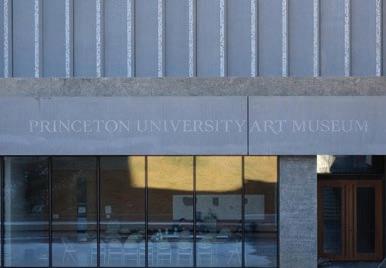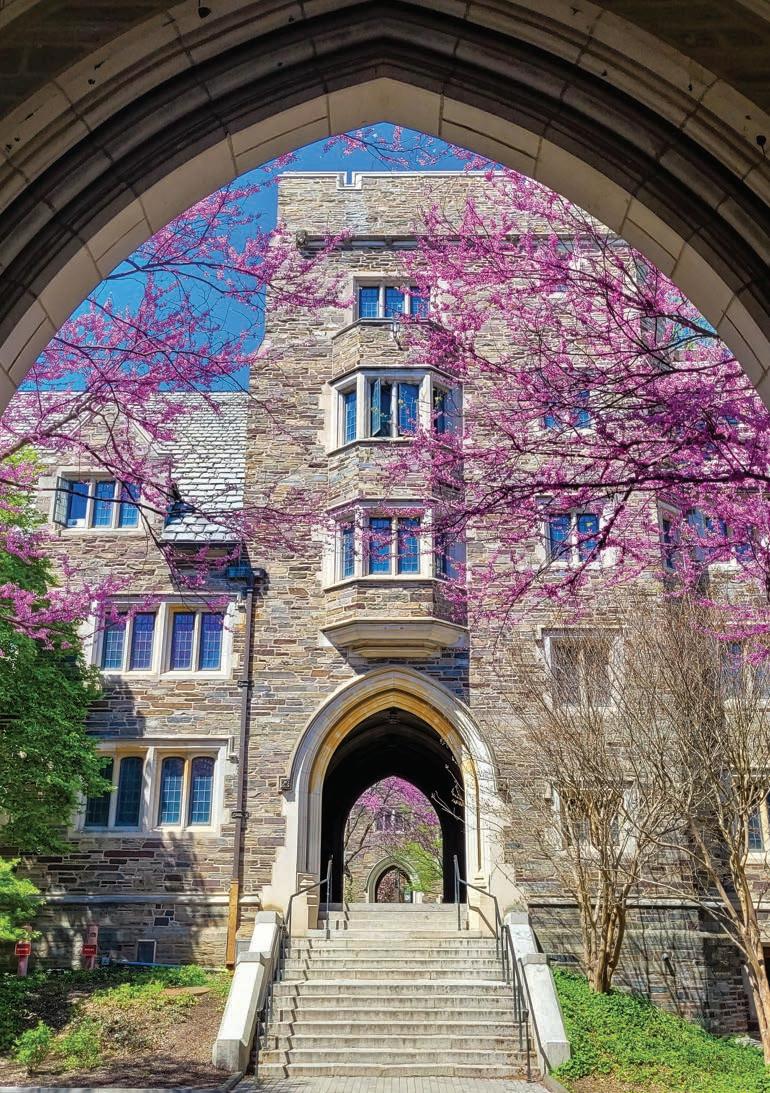

Letter from the Editor

Miriam WaldvogelEditor-In-Chief
Dear frosh,
When I first came to campus for Princeton Preview, I asked current students: “What’s the worst thing about Princeton?” I had some deep suspicion that there was something that the smiling adults and bespectacled faculty weren’t admitting — that there was something imperfect about this place.
Students offered their various answers: There’s minimal school pride in our sports teams. Our 12-week semester is a crazy time crunch. Princeton has a mental health crisis that has far too often resulted in tragedy.
Those are all true. I’ll add my own to the mix: Princeton students struggle to have enough fun.
But wait, you say! I will have fun working hard for classes that are intellectually stimulating, and for professors that will broaden my world horizons. I will have fun pushing myself every day, every practice, in the sport that I love. I will have fun immersing myself in clubs and extracurriculars (perhaps The Daily Princetonian?) that introduce me to cool people and allow me to do cool things.
That’s all true. I have all of those kinds of fun every single day, and the vast majority of Princeton students do too. So perhaps that’s the first thing here — perhaps unlike your high school, Princeton has endless awesome and difficult and fulfilling opportunities to revel in, and you will be surrounded by others who revel in them too.
But there’s something else, too: you need to have non-work fun. Fun for fun’s sake. You need to watch awful movies with your friends, accidentally set fire to your dorm by making pizza, or dance to average beats by a DJ your age in a basement somewhere.
For this second type of fun, it’s important to relax. That means not worrying about the problem set you’re miles behind on, the internship application you haven’t started, or the impending grade on a paper you just turned in. Those things are no fun.
It might sound obvious to say, but Princeton is, for many students, a deeply stressful place that moves at about a million miles an hour. You’re so immersed in a campus full of opportunity and expectations — a library with basically any book ever, subsidized international travel, current and future CEOs, generals, and judges — that taking any time off from your goals can seem like a selfish and stupid choice.
I’m here to tell you that choosing to go for a walk instead of studying, or to zip off to New York City for a day, or to drink wine and eat cheese all night is not going to sink your grades, auditions, tryouts, or job prospects (and you should dispense with the aspiration for a 4.0 anyway). In fact, it will probably be better for you and your goals in the long run — you are young and resilient, but not invincible.
Because, in the grand scheme of things, one of America’s oldest institutions of education has decided that it will put the full force of its faculty and $36 billion endowment into making you successful. They are pretty damn good at it, as audacious as their bet on you may seem. As long as you don’t spend all four years skipping class and evading your responsibilities — which I know you won’t — you will be just fine in the long run.
Paradoxically, living life at Princeton to its fullest means taking a break from it every once in a while.
Miriam Waldvogel is the 149 Editor-in-Chief of the ‘Prince.’ She can be reached at eic@dailyprincetonian.com.
Inside The Paper
FROSH DICTIONARY PAGE 4
EATING CLUBS PAGE 10
ARTS & CULTURE AT PRINCETON PAGE 14
IN THE EYE OF THE TRUMP ADMINISTRATION PAGE 16
THE AI DEBATE PAGE 23
CAMPUS PROTEST PAGE 27
WHO’S IN THE STUDENT BODY? PAGE 34
OUTSIDE THE UNDERGRAD BUBBLE PAGE 36
PRINCETON EATS PAGE 40
ALL ABOUT THE ‘PRINCE’ PAGE 42
A CHANGING CAMPUS PAGE 44
PRINCETON’S MENTAL HEALTH SYSTEM PAGE 46
IN MEMORIAM PAGE 48
RISE AND FALL OF PRINCETON BASKETBALL PAGE 50
PRINCETON PLAYERS GO PRO PAGE 52
TIGERS DOMINATING THE IVY LEAGUE, PLAYOFFS PAGE 54
BUCKET LIST PAGE 56
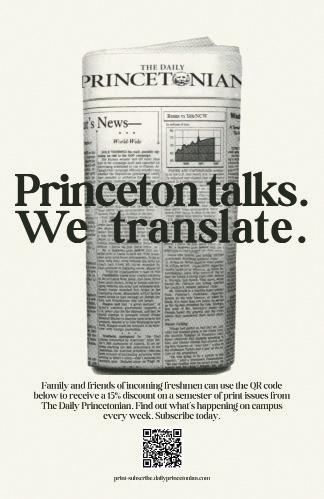

A.B., abbrev. Artium Baccalaureus, or Bachelor of Arts. Though called B.A. at most other schools, you’re still receiving your typical liberal arts degree. Unless you’re an engineer, of course. See “B.S.E.” Academic mediocrity, n. The subject of a 2022 quote by Eisgruber on mental health. Divisive topic on campus.
Acaprez, n. Name of the group that represents Princeton’s eight most prestigious acapella groups. You can only hold membership in one group — they host auditions together. There are acapella groups on campus that are not recognized by Acaprez. Yes, there is a hierarchy within the acapella scene… welcome to the Ivy League.
Adviser, n. 1. Faculty member assigned to first-years to assist in course selection. Usually a specialist in a field totally unrelated to yours. 2. Faculty member assigned to sophomores with an unclear role. 3. Faculty member assigned to juniors and seniors to provide guidance in writing junior papers and theses. All vary widely in quality of advising and level of engagement. Alcohol Initiative, n. A University-sponsored attempt to reduce alcohol consumption by throwing huge sums of money at undergraduates for alternative activities.
Alexander Beach, n. Princeton’s version of a beach. Lacks sand and water but used to be filled with lots of bodies in bathing suits on sunny spring days. Is now the location of the freshman BBQ and, for much of the year, a gigantic tent. See “tents.” All-nighter, n. 1. Grim, dusk-to-dawn studying or writing marathon in which sleep is postponed indefinitely. Often procrastination-induced and caffeine-fueled. Usually followed by prolonged periods of hibernation. 2. Comedy show co-hosted by two members of the senior class and performed at Frist Theater. Finishes around midnight. See “Frist.” Alumni, n. pl. Those who came before. Gosh, they sure do love the place. Prone to wearing abominable combinations of orange and black. See “Reunions.” Arch sing, n. Event where a cappella singing groups perform a few of their favorite tunes in campus archways. Good singing and great acoustics, but the novelty can wear off quickly. A large percentage of the audience is made up of group members’ significant others (or situationships) and roommates. See “jam,” “Blair Arch.”
enade the hapless on Valentine’s Day. Barstool Princeton, n. A popular Instagram account. Posts Princeton-oriented memes that are pretty hit or miss — some upperclass students will say it’s “gone down in quality” recently. Also the home of Barstool Confessions, a pale imitation of Tiger Confessions. See “Tiger Confessions.”
Beer, n. Beverage of choice on Prospect Avenue. Some clubs try to impress potential members by serving such brew-house delicacies as Killian’s or Yuengling, but four times out of five it’s watered-down Natty Light.
Bicker, n. Princeton’s multi-day equivalent of fraternity or sorority rush for the six selective eating clubs. During Bicker, club members meet sophomores and other upperclass students to determine whether they are worthy of membership. “Worthiness” is determined in a variety of ways. See “sign-in club,” “street week,” “double Bicker.”
Blair Arch, n. That large, pretty arch across from Richardson Auditorium. Campus landmark and frequent site of a cappella jams. Saving grace of Matheyites. See “Mathey College.”
Blair Tower, n. Former home of despised sophomores who lucked out during residential college room draw and got amazing rooms with amazing views. Now used as classrooms and housing for resident graduate students and a few faculty members in residence.
Bomb, v. To do miserably on an exam. Translates to a range between A-minus to actually failing. See “Orgo,” “grade deflation.”
Bonfire, n. Tradition of lighting an enormous bonfire on Cannon Green to celebrate the football team’s victories over both Harvard and Yale in a season. Involves singing praises to Old Nassau as effigies of John Harvard and the Yale bulldog are burned in a fiery inferno. Pretty much as cultish as it sounds. Last occurred in 2021. Keep your fingers crossed for the next one.
Bridges (nickname), CEE 102: Engineering in the Modern World. CEE 102: Engineering in the Modern World. Counts as an HA for science kids and an SEL for humanities kids. In past years, the final has involved literally memorizing pictures of bridges. See “P/D/F.”
B.S.E., abbrev. Bachelor’s of Science in Engineering. Though called “B.S.” at some other schools, there’s no b.s. in Princeton’s engineering degree.
Bubble, the, n. The metaphorical orange bubble that surrounds campus, keeping us in and the real world out. Also called “The Orange Bubble.” Usage: “Back in the bubble!”, “Welcome to the bubble.” To be used sparingly.
tive,” “Coffee Club.”
Campus fox, n. The fox that resides on campus, most often spotted up-campus. Although multiple foxes have been spotted at once, campus legend says there is only one campus fox. See: “up-campus.”
Cannon Dial Elm Club, n. Bicker club known for its three taprooms. The club plays host to a large proportion of athletes, especially field sports. Home of legions of e-bikes parked outside.
Canvas, n. You’re not free yet — it’s still the software to check your coursework. If your high school did not use it, welcome to Princeton’s very late step into the modern world of college education. Successor of Blackboard and notes that you should “deliver problem sets to my mailbox.”
Cap & Gown Club, n. Consistently the most bickered club, Cap has a self-proclaimed reputation for being “chill and diverse,” and a non-self-proclaimed reputation for some of the worst food on the Street. Some of its classic night out themes include Capmandu and Boxers and Blazers. Once the club of U.S. Secretary of Defense Pete Hegseth ’03.
Carl A. Fields Center, n. Properly called the Carl A. Fields Center for Equality and Cultural Understanding, but colloquially known as CAF. A building located on Prospect Avenue that hosts events and programming aimed at celebrating diversity. Once called the “Third World Center.”
Carnegie, Lake, n. Five minutes from campus, five miles long. Scenic venue for crew but too slimy for swimming. Gift of Andrew Carnegie so that Princeton could have a crew team, after then-University President Woodrow Wilson, Class of 1879, asked him for money for University construction. Wilson’s reported comment: “We asked for bread, and he gave us cake.”
Carrel, n. For better or for worse, you will know only a handful of the four-by-six-byeight-foot metal study closets in Firestone Library, and only as a museum-like display. In the olden days, seniors locked themselves in these boxes around February to emerge in April with 30,000-word theses. Don’t worry, you’ll get study spaces that aren’t fire hazards. See “thesis.”
CD, abbrev. Culture and Difference. A distribution requirement that began with the Class of 2024, and the only requirement that can be satisfied concurrently with another. Interdisciplinary requirement whose applicable courses are in many fields.
Certificate, n. The now-defunct Princeton term for minors. In years prior, students contended with a weird combination of both. Source of impossibly niche thesis topics. See “thesis.”
Jewish activity at all hours of the day, located off-campus. Known for its daily coffee hours and packed Friday night Shabbat dinners.
ChatGPT, n. Depending on who you ask, the oracle of all truth or the destruction of the humanities as we know it. What no student has ever used to complete a take-home exam. Someone in your lecture’s girlfriend. See “Committee on Discipline,” “Honor Code.”
Choi Dining Hall, n. Not that anyone calls it that. Also known as the Yeh/NCW dining hall. Home of pretty nice food, an Asian station, and insane lines during the lunch rush.
CJL, abbrev. Center for Jewish Life. Selfexplanatory building on Washington Road. Popular lunch spot regardless of religious affiliation due to its central location, now with a shiny new dining hall.
Clapper, n. Part of the Nassau Hall bell that the incoming class tried to steal each year. The logic behind the age-old tradition is that if the clapper is stolen, the bell signifying the start of classes won’t ring, so classes can’t be held. After Geoffrey MacArthur ’95 fell from the tower in 1992, the administration decided to remove the clapper permanently.
Cloister Inn, n. Sign-in club known for hosting a high percentage of water-based athletes, a frequent landing spot for people who are hosed by two bicker clubs. Home of Frosh Week’s “Moist Cloist,” where legend has it they pee in the beer. Currently closed for “renovations.” See “hosed.”
Cluster, n. Where a whole bunch of computers congregate. Features printers which are often jammed, toner-less, or otherwise malfunctioning; staplers that are often broken or empty; and people scowling at the movies they have to watch for class. Scattered throughout campus.
Coffee Club, n. Student-run coffee shop in the taproom of Campus Club and the lobby of New College West. Closer alternative to coffee shops on Nassau Street.
Colonial Club, n. Sign-in club that at one point claimed Friday nights from Charter. Currently predominantly east Asian, once the club of Ted Cruz ’92.
Committee on Discipline, n. The University body responsible for investigating academic integrity and other disciplinary offenses.
CA, abbrev. Community Action. Weeklong pre-orientation activity built around service trips in the Princeton, Trenton and Philadelphia areas. Like Outdoor Action, but with showers and beds. Will you do anything? Who knows.
Baker Rink, n. Ice rink located downcampus where the hockey teams practice. USG sometimes holds free Skate Nights where you can take dates. Band, n. The University scramble band. Football halftime shows are occasionally funny and always tasteless. Often uses unconventional percussion (termed “garbushin”), including a plastic Santa Claus and a stop sign. Hard to miss in their extremely plaid orange blazers as they parade through libraries on Dean’s Date or ser-
Butler College, n. Residential college with new-ish buildings and a relentless obsession with its bee mascot. Located what used to be far down-campus and now is the center of campus. See “Studio 34.”
Campus Club, n. Defunct eating club purchased by the University to hold events. Home to Coffee Club. See “Alcohol Initia-
Chapel, n. Site of religious services and opening exercises at the start of every year until the class sizes got too large. Thirdlargest university chapel in the world. Contrary to Orange Key legend, it wasn’t built by a Yalie.
Chancellor Green, n. Gorgeous library attached to East Pyne featuring stainedglass windows and amazingly comfortable couches. Naps happen here.
Charter Club, n. Club located extremely far down Prospect Avenue, near the EQuad. After a rebrand, one of the most coveted clubs on the street with lots of competition for selective sign-in spots. Site of Friday debauchery. Chabad, n. Recently renovated hub of
Community Living Advisor, n. Like an RCA but for sophomores and upperclass students, with half the pay and 1/100th of the responsibilities. See “RCA.” Consulting, n. What many of your classmates will go on to do. No one actually knows what consulting means, but they do know it brings in the bucks. See “SPIA.” Co-op, n. Upperclass dining alternative in which members share cooking responsibilities. Vegetarians, try 2 Dickinson St.; omnivores, stick to Brown, Real Food, or the International Food Co-ops.
COS, n. Campus abbreviation for computer science, rather than ‘comp sci.’ From the three-letter course code for computer science classes. Cottage Club, n. Officially called “Uni-
versity Cottage Club.” Bicker club populated by athletes, Southerners, and the wealthy. Known for its spring Sunday Fundays, darties with various themes that can always be counted on to feature beer and American flags.
CPS, abbrev. Counseling and Psychological Services. Office of therapists located on floors one and two of the Frist Health Center, available to you free of charge. See “McCosh.”
Daily Princetonian, The, n. What you’re reading now. Your one true source of information on life, the universe, and everything, as well as the only daily newspaper on campus and one of the oldest college dailies in the country (and older than The Washington Post). Available for free everywhere. Completely independent from the University. Also known as the ‘Prince.’ Dinky Bar, n. Where seniors and graduate students who are too mature for the Street go for expensive cocktails.
Dead Week, n. Week between the end of finals and graduation, when seniors and students employed for Reunions hang out and try to do as little as possible. This can take the form of group vacations to Myrtle Beach, S.C.. See “Reunions.”
Dean’s Date, n. 5 p.m. on the last day of reading period. It used to be the day all course papers were due. Now, it’s the start of an amorphous exam period where papers are due at staggered times. Over time, students have created many traditions to combat the stress, including the Band playing in Firestone and a midnight meal in the res colleges. See “all-nighter,” “reading period”
Dei Sub Numine Viget, phrase. Latin motto on Princeton’s seal. Translation: “Under God’s Power She Flourishes.” Unofficial version: “God Went to Princeton.”
Dillon Gymnasium, n. Recreational center in the middle of campus open to non-athletes. Contains a pool, squash courts, multipurpose rooms, a large gym, and a fitness center. Site of loud Zumba and spin cycle classes. Officially known as the Class of 1986 Fitness and Wellness Center, following a renovation in 2024.
Dinky, n. Mini-train that takes you to Princeton Junction for connections to the real world. Flashpoint of battle between town and University. The station used to end at Blair Hall and has been moved back several times to accommodate new buildings.
Distribution requirements, n. Princeton’s plan for a true liberal arts education. Ensures STEM students take copious humanities classes, and humanities students take a few STEM classes. See “P/D/F.” Double Bicker, n. Initiative begun somewhat recently in which bicker clubs allow sophomores to bicker two clubs at once. See “Bicker.”
Down-campus, adj. n. Located on the part of campus closer to the lake, down the hill. Begins roughly at Dillon, ends at the lake. Synonyms: “South.” Usage: “It’s a little further down-campus than Edwards.”
E-Quad, abbrev. Engineering Quad-
tion. Distribution requirement with no discernible meaning. Filled most frequently by philosophy and psychology classes.
See “P/D/F.”
Eisgruber, Christopher, n. Your fearless leader. Eisgruber ’83 ascended to the University presidency from the position of provost in 2013. Seems to have forgotten that this isn’t high school and assigned you summer reading. Well-respected in academic circles, including for defending the principles of the university against the Trump administration’s attacks.
EM, abbrev. Ethical Thought and Moral Values. Distribution requirement once filled with Peter Singer’s “Practical Ethics,” in which one of the most prominent philosophers of our time tries to convince you to stop eating meat. He’s since left the University, so good luck figuring out your “values” now.
Entryway, n. Self-contained section of a dorm or classroom building. Most frequently found in older buildings, which were said to be built to be riot-proof. Only way to get from one entry to another is to go outside and back in again or go through the basement or up to the top floor. Partly because of this system, you may never meet
center. The old health center was called McCosh; when one was sent for alcohol overconsumption it was called being “McCoshed.” So now, perhaps students will be Fristed?
Fraternities, n. pl. First-years, avert your eyes. Groups of males that gather to drink and make lots of grunting noises. Firstyears are not allowed to rush Greek organizations. Those who do face suspension. Not a big presence on campus, but they may be your ticket into a bicker club.
Frosh, n. What you are. More colloquial use than “first-year.”
Frosh Week, n. The week before classes, when sophomores and upperclass students reacquaint themselves with campus life and “meet” the first-years, who are kept busy by an array of University-sponsored activities. Prime time to drink copious amounts of alcohol amid nighttime mosh pits in the eating clubs’ backyards. In recent years, actual frosh have been banned. You can thank the Class of 2022 (and the pandemic, if you’ve heard of it). See “McCosh.”
FYRE, abbrev. First-Year Residential Experience. A group of “required” assemblies and zee group meetings that begin during orientation, and end sometime during first semester. Cover important topics such as diversity and inclusion.
Garden Theatre, Princeton, n.
Community theater. Shows mostly artsy films as well as a few big-budget flicks. Good first date. Often offers free movies for students sponsored by USG, usually on Fridays. Graduate College, the, n. Commonly called the “Grad College.” A mythical castle across the golf course behind Forbes rumored to be inhabited by those they call “graduate students.” Undergrads like to climb its tower to take pictures of the view and eat in its dining hall on Thursday nights, when dinner features specialty food stations with made-to-order sesame noodles, quesadillas, etc. See “D-bar.”
Grade deflation, n. Former university policy to limit A’s in courses to 35 percent of grades per department. Although the official policy ended, its residual effects are still around. A source of many a dining hall debate and Princeton’s second unofficial motto, “It would’ve been an A at Harvard.” Graduate student, n. An individual smart enough to translate Kierkegaard into 14 languages but mostly isolated from campus life. Many are forced to live roughly one mile from central campus.
GSRC, abbrev. Gender and Sexuality Resource Center. Name is self-explanatory. Located in Frist. Replaced centers formerly known as the Women*s Center and LGBT Center.
rangle. A collection of academic buildings where engineers spend all their time. Very, very far east from central campus. Soon to be supplanted by a new building running behind Prospect Avenue — perhaps the ESnake?
East Pyne, n. Pretty building up-campus near Firestone Library that houses language departments, the Department of Comparative Literature, and the Department of Classics.
Eating clubs, n. Eleven large mansions on Prospect Avenue that serve as the hub of upperclass student life. What you would get if a fancy dining hall had a baby with a sorority/fraternity house. Biggest reason that Princeton is still considered elitist by the outside world.
EC, abbrev. Epistemology and Cogni-
the person who lives on the other side of your bedroom wall.
Fall break, n. Week-long vacation immediately following fall midterms. Implemented in the 1970s when campus activists demanded time off before Election Day to campaign for their favorite bleeding-heart liberal congressional candidates. A prime road-trip week.
Fine Hall, n. The name of that extremely ugly brown building rising high above the earth down-campus behind Lewis Library. Contains the math department.
Fire inspection, n. Once-a-semester unannounced visit to your dorm room, before which you should (1) put on clothes, (2) frantically hide illegal appliances under your blankets, and (3) un-tape your door. Otherwise, they’ll fine you. Not for the nudity. For the other stuff.
Firestone Library, n. The mothership. Books on books on books (on shelves). Large behemoth of a library containing books on every subject imaginable, as well as asbestos. Popular study spot. Deathly quiet. See “carrel.”
First College, n. Once Princeton’s oldest residential college and named for Woodrow Wilson. Now primarily a shallow hole in the ground. On the site of the future Hobson College.
First-year, n. What you are. Princeton has spurned the word “freshman.” See “frosh.”
FitzRandolph Gate, n. Gate in front of Nassau Hall. If you walk out the center gate while an undergraduate, you will not graduate. Of course, that’s just a legend. Try it and let us know.
Fizz, n. A social media app popular with campus youngsters which has replaced TigerConfessions as the hub of campus gossip.
Forbes brunch, n. The concession Princeton had to make to Forbesians to ensure they wouldn’t drop out. In exchange for living in The Land Far Far Away, Forbesians get a chocolate fountain on Sundays. Is it a fair trade? That’s for you to decide.
Forbes College, n. The res college rumored to exist just west of the Lewis Center for the Arts and Wawa. Only visited by nonForbesians on weekends due to its fancy brunch spreads. See “Forbes brunch.”
Franzia, n. Brand of boxed (read: dirt cheap and sickeningly sweet) wine. Goes down easy, comes back up more painfully. See “Tower Club.”
Frist. n. 1. The campus center. Home of the student government, mailboxes, and chicken tenders. Also one of the campus theaters. A fun and relaxing place to socialize and study as long as you don’t take introductory Chinese. Not to be confused with First. See “Late meal.” 2. n. The last name of a big donor family who also recently funded the new health center. Also not to be confused — “Frist,” alone, usually refers to the campus center.
Frist Health Center, n. The new health
HA, abbrev. Historical Analysis.
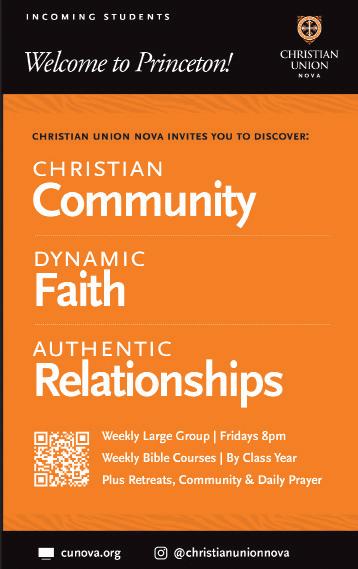
Distribution requirement that can be fulfilled by, you guessed it, a history class.
Head, n. Faculty member who acts as den mother or father for the first-years and sophomores in the residential colleges.
Hoagie Haven, n. A Princeton institution, once known for catering to the late night wishes of drunken eating club goers. Now with earlier closing times, the small hoagie shop on Nassau Street still serves up sandwiches filled with things like french fries, chicken tenders, multiple burger patties, and buffalo sauce, often in combination.
Hobson College, n. Currently, the construction site in the center of campus. Starting in 2027, the newest residential college, named for investing CEO and serial corporate board member Mellody Hobson ’91.
Holder Howl, n. A moment of collective campus catharsis at midnight each Dean’s Date when students gather in Holder Courtyard in Rocky to release a primal scream of fear and frustration. There are now copycat events held across campus. See “Dean’s Date.”
Honor Code, n. Institution through which University exams are policed. Students sign pledges agreeing not to cheat on exams and to turn in those who do. Taken very seriously. See “Committee on Discipline.”
Hookup culture, n. A semi-significant feature of the social scene which is the topic of significant online debate.
Hose, v. To reject; to render helpless. Most often done to rejected Bicker prospects, who are hosed at their doorstep. Fraternities, sororities, and a cappella groups hose, but don’t worry — a literal hose is typically not involved. See “Bicker.”
Hotspot. n. 1. A place to revalidate your prox after fall, winter, and spring break, conveniently located by the Dinky or inconveniently in a random basement. 2. An app used for list spots for several eating clubs, including Tiger Inn and Ivy.
Houseparties, n. Pseudo-bacchanal scheduled for the weekend after the end of spring semester classes. With theses complete and exams two weeks distant, eating clubs host wine-filled formal and semiformal dinners.
IB, nickname, investment banking.
athletes and sports located far, far downcampus, informally called “Jadwin.” Site of varsity basketball games. Not Jadwin Hall. Jadwin Hall, n. An academic building south of Fine Hall that contains the physics department. Covered in brown tile. Not Jadwin Gymnasium.
Jam, n. An event at which one or more a cappella groups sing, commonly under an arch.
JP, abbrev. Junior paper. Lengthy independent work for A.B. juniors meant to prepare them for the senior thesis. Some departments require one; many require two. Tragic reminder of impending mortality.
Keller Center, n. Center located near the
lecture classes will be held. Also features smaller seminar rooms mainly used by the English and history departments. Desks are small, cramped, and wooden; bathrooms are difficult to find.
McCosh, abbrev. 1. n. McCosh Hall. 2. n, archaic. The old health center, replaced by Frist Health Center in spirit but not in body. 3. v. Sending your too-drunk friend to the infirmary, or getting sent yourself. Usage: “We had no choice but to McCosh him,” or “Frosh week was so messy, I got McCoshed.” Unclear whether this will fall out of use in favor of a Frist-inspired verb. See: “Frist Health Center.”
McCosh Walk, n. Walkway extending from University Place on the west to Washington Road on the east. Has been under construction for most of the past year as collateral damage from the art museum construction site.
from the doctors.
PAA, abbrev. Peer Academic Adviser. Student available to give first-years academic advice. Shows up sparingly at zee group study breaks.
Pace Center, n. Civic engagement center on campus that runs Community House, the Student Volunteers Council, and a program pairing interns-to-be with summers in nonprofits and government. Distributes large amounts of money for service projects.
What many of your classmates are striving for a job in. Among the most prestigious of the banking jobs. Shocking in its remuneration, hours, and culture.
ICC, abbrev. Interclub Council. Group made up of the 11 eating club presidents. Coordinates relations between Prospect Avenue, the municipality, and the University.
Independent, n. adj. Upperclass student who neither joins an eating club nor purchases a University dining plan. By graduation, they’re either a great connoisseur of Princeton’s restaurants, a great cook, or a great mooch. Many live in Spelman Hall. IW, abbrev. independent work. B.S.E. equivalent of the Junior Paper for A.B. juniors. See “JP.”
Interactor, n. Upperclass B.S.E. student who helps advise B.S.E. first-years, especially at the beginning of the year. Periodically checks in and hosts study breaks.
Ivy Club, n. Bicker club with a reputation for elitism, mahogany, and international students. Its women’s bathroom may be the most photographed part of Princeton, after Blair Arch.
Ivy Inn, n. One of three “bars” in Princeton. Right near Hoagie Haven. Definitely “end of the night” vibes.
Jadwin Gymnasium, n. Gym for varsity
E-quad that sponsors events, classes, and programming related to entrepreneurship and innovation. Stop by before you drop out to work on your start-up full-time. Even if you don’t, you’ll get dozens of emails from them every day.
Kiddie lit, nickname, ENG 385: Children’s Literature. Over-enrolled course that people think will be an easy LA. Beware — it’s quite large and grades are heavily deflated. See “LA.”
LA, abbrev. Literature and Arts, a cat-
McGraw, abbrev. McGraw Center for Teaching and Learning. Academic support center that offers one-on-one and group tutoring for many introductory courses, as well as other resources for students. Located in Frist. Also a good study spot.
Murray Dodge, n. Free cookies and tea, but be prepared to hand over your prox as collateral. Also don’t forget to wash your own mug once you’re done. Try the matcha tea cookies if you dare. Extremely popular study spot, so go at off-peak times if you want to get a seat.
NARP, abbrev. Non-athletic regular per-
Palmer Square, n. Town square located just across Nassau Street from the University. Home to preppy stores, specialty boutiques, and townies.
Patton, Susan, n. An alumna of the Class of 1977 who wrote an infamous Letter to the Editor to this paper discussing advice she would give to her daughter, namely her belief that Princetonian women should “find a husband on campus before [they] graduate.” Draw your own conclusions.
PAW, abbrev. Princeton Alumni Weekly. The nation’s fourth-oldest weekly magazine, published by the Alumni Association. Tagline “editorially independent since 1900,” but funded by the University. Doth protest too much?
egory of your distribution requirements. See “kiddie lit.”
Late meal, n. The only thing that makes upperclass students jealous of first-years. In theory, an option for students who miss dining hall meal times. In practice, free noms and mixers sold in the basement floor of Frist Campus Center. See “Frist.”
Lawnparties, n. Afternoon drink-athon and dance-a-thon on the lawn of each eating club, held in early fall and at the end of spring Houseparties. Known for importing bands ranging from so-so to great and creating a massive influx of sundresses on Prospect Avenue. Traditionally, an explosion of preppy clothing. See “Houseparties.”
LCA, abbrev. Lewis Center for the Arts. Modern building complex that serves as Princeton’s home for the arts. Safe haven for many theater kids.
Lectures, n. pl. Oft-missed speeches by professors that constitute the foundation of the Princeton education. Try to attend a couple so you can tell your parents that you are making the most of their tuition dollars.
Lewis Library, n. Large, modern science library located down-campus across Washington Road. Its treehouse floor is an especially popular study spot that features many windows.
List, n. Method that clubs use to determine who can enter for a night out. What first-years and sophomores agonize about getting onto. Why juniors and seniors in these clubs get texts from younger students they barely know.
Listserv, n. Where life at Princeton happens, and the reason your Gmail app continuously gives you notifications. A main line of communication between campus groups and their members. Most common iterations include your res college listserv, filled with messages ranging from dance group ticket sales to political manifestos, and the free food listserv, which is exactly what it sounds like. Can be accessed at https://lists.princeton.edu/.
Mathey College, n. Residential college
son. We are here and we are proud. Nassau Herald, n. Princeton yearbook containing only the senior photos.
Nassau Weekly, n. Also “the Nass.” A weekly tabloid co-founded in the early 80s by David Remnick, who now runs The New Yorker. Known for humorous “Verbatim” section, which is filled with random overheard quotes from around campus, and for printing other random musings. See “WPRB,” “St. A’s.”
netID, n. The part of your email address preceding “@princeton.edu” and your username for most campus websites.
New York City, n. Just an hour-and-ahalf train ride away. Sometimes certain classes take you there for free.
NCW, abbrev. New College West. One of Princeton’s newest pair of residential colleges. Located at the far-southern end of campus. Not yet named for a donor. Has a Coffee Club and a ceramics studio. See “Yeh College.”
Nude Olympics, n. Sophomore rite of passage banned in 1999. Celebrated by running naked through Holder Courtyard at midnight on the night of each year’s first snowfall.
OA, abbrev. Outdoor Action. Week-long
Pay with Points, n. A new-ish USG initiative that gives underclass students $150 a semester to spend at an ever-growing list of restaurants in town. Frequently (and incorrectly) referred to as Paw Points. See “Paw Points.”
Paw Points, n. Dollars that you load onto your prox card. Worse than a dollar in your wallet because now you can only spend it at certain campus locations. Critically, your own money. See “prox.” P/D/F, abbrev. Pass/D/fail. Grading option developed to facilitate a true liberal arts education. Designed to allow students to take a class that expands their horizons with the guarantee that their GPA won’t tank. Unless you get a D. Or fail. You can choose this option once per semester, for up to four semesters. See “distribution requirements.”
PEV, abbrev. Personal electric vehicle. Come in two types: Scooters, a thing of the past, and e-bikes, one of which will run you over tomorrow. Electric scooters were banned in December 2023, and if you bring one to campus, it will likely be confiscated while you’re in lecture. Beware!
Pequod, n. 1. Fictional ship in Herman Melville’s “Moby Dick.” 2. Outrageously expensive photocopied packets of required reading that often resemble the aforementioned whale. Mostly supplanted by readings posted on Canvas, but alums will tell you about them.
Physics for Future Leaders, n. The actual name of PHY 115A, a physics course designed to introduce non-scientists to just enough science to ostensibly be able to make decisions. Future leaders who are also scientists should seek an actual education elsewhere. See “P/D/F.”
located just south of Rocky. A collection of loosely associated buildings with no central quad. Shares a large, picturesque dining hall with Rocky.
McCosh Hall, n. A large, sprawling series of lecture halls up-campus in which many of your introductory-level large
pre-orientation program that sends half of the incoming class into the woods to get dirty and make friends. There’s (mostly) no action on Outdoor Action, but there’s always frosh week to get to know a new friend even better.
ODUS, abbrev. Office of the Dean of Undergraduate Students. Oversees campus organizations, undergraduate student government, and various student centers. A source of funding for your student group.
OIT, abbrev. Office of Information Technology. Controls the University’s computer and Internet systems. Runs a tech clinic in Frist.
Old Nassau, 1. phrase. Nickname for Princeton University, derived from Nassau Hall. 2. n. School song.
Orange Key, n. Campus tour-guide group. Don’t believe everything they told you on your tour.
Orange and Black Ball, n. Campus-wide ball resurrected after a decades-long absence. Run by the Undergraduate Student Government. Held in Dillon Gym; mostly completely empty. Lots of finger food. See “USG.”
Orgo, abbrev. CHM 301/302: Organic Chemistry. Soul-killer. Separates the kids
Pickups, n. pl. A tradition among Princeton’s many, many selective clubs and organizations where they greet new members by showering them with champagne, Silly String, etc. in their dorm rooms and then take them elsewhere for revelry.
PMC, abbrev. 1. Princeton Medical Center. The destination you absolutely don’t want to end up at after a night out. Getting PMCed is a much more expensive alternative to getting McCoshed. See “McCosh,” “Frist.” 2. Princeton Model Congress. Event for high schoolers, staffed by students who get to stay in D.C. for free. Not to be confused with the former.
PMT, abbrev. Princeton Mock Trial. A very competitive traveling competition team; somewhat cultish. If your friend joins, you may never see them again. See “Cap & Gown Club.”
Poe Field, n. Large oval field at the far southern end of campus where club and intramural sports teams hold practices, sunbathing frequently occurs, and barbecues are sometimes held. Recently reopened after construction.
P-Rade, n. Annual procession of ridiculously spirited, multi-generational alumni sporting black-and-orange costumes.
Takes place on the final day of Reunions. See “alumni,” “Reunions.”
Pre-med, n. A student hoping to go to medical school. Generalized anxiety and cutthroat behavior varies by person.
Precept, n. Discussion between a small group of students and a preceptor (a grad student or faculty member) to supplement lectures. A unique feature of Princeton’s education system inaugurated by Woodrow Wilson. Vary widely in quality. Truly mandatory for only a handful of classes.
Prefrosh, n. What you are until you arrive on campus.
Pregame, 1. n. Name for any gathering held prior to a night out on the Street. Usually a source of hard liquor. Usage: “birthday pregame,” “frat pregame.” 2. v. To consume drinks at a party held on campus prior to a night out on the Street. Usage: “Let’s pregame at John’s birthday party before heading to T.I.”
Princeton, n. 1. The University to which you have committed the rest of your life (including your future earnings). 2. The affluent suburban town in which your blissful Orange Bubble is located.
Princetoween, n. The night on which all of campus collectively celebrates Halloween, irrespective of the actual date.
Prospect, abbrev. 1. Prospect House. Formerly the University president’s home in the middle of campus. Now a faculty dining hall and the site of end-of-semester fancy dinners for various organizations. 2. Prospect Garden. The gardens surrounding Prospect House; popular venue for Houseparties photos. 3. Prospect Avenue, a.k.a the Street. 4. The Prospect, the ‘Prince’ section for arts, culture, and student life.
Prospect 12, n. The ultimate drinking challenge: one beer at every eating club in one night. A favored item on senior bucket lists. Most commonly conquered on Princetoween or Dranksgiving. Although only 11 clubs are operational, the 12th is Campus Club.
Prox, 1. n. Common name for PUID, or the Princeton University TigerCard. 2. v. To unlock a door by holding your PUID close to an electronic sensor. Usage: “Could you prox me in?” See “PUID.”
P-Safe, abbrev. Public Safety. University cops responsible for regulating parking, ignoring room parties, and opening doors for locked-out students.
PTL, abbrev. Post-Thesis Life. The time of year after seniors have turned in their thesis, but before graduation, where they have no responsibilities in life. A time wellspent but poorly remembered.
PUID, n. 1. Your University ID. Your key to admission at the library, sporting events, and eating clubs. Can be used to charge food purchases to your student account. Eating club members sport special stickers on theirs. 2. Method sign-in clubs use to determine who can enter during nights out — if you have a PUID, you’re good. See “prox.” QCR, abbrev. Quantitative and Compu-
at the end.
Residential college, n. Your home at Princeton for at least your first two years of college. There are now seven residential colleges on campus: Rocky, Mathey, Butler, First, Whitman, Forbes, Yeh, and New College West. Each college varies greatly in amenities, types of rooms, and location, but they all provide a sense of community, and more importantly, a source of free gear.
Residential College Facebook, n. Database containing (almost) every Princeton student and information such as their class year, major, and most importantly, a photo. The single-most useful tool you will encounter in your time at Princeton. Easiest way to stalk your peers.
Residential college staff, n. Wellmeaning faculty members who work for your residential college but have varying degrees of helpfulness. Skilled at clogging your email inbox. Includes the Head of College, Dean of College, Assistant Dean for Studies, and Assistant Dean for Student Life. Source of federal governmentesque alphabet soup.
Reunions, n. Beer-saturated gathering of alumni during the weekend before Commencement for drinking, fellowship, and the P-Rade. Good excuse for students to delay returning home for a week at the end of the year. Reportedly the event with the second-highest level of alcohol consumption, after the Indy 500. See “P-Rade.”
Richardson Auditorium, n. Enormous performance hall located up-campus across from Blair Arch.
Rival, n. What Princeton lacks as the third wheel in HYP. What Penn thinks we are.
Rocky College, abbrev. Rockefeller College. Northernmost residential college known for gorgeous Gothic architecture and the occasional dorm bat.
Rocks for Jocks, nickname. GEO 103: Natural Disasters. See “P/D/F.”
RoMa, nickname. Rockefeller/Mathey College dining hall. Source of curly fries, weird quesadillas, and the occasional duck pasta.
Room draw, n. Computerized process by which students select rooms for the upcoming year. Conspiracy theories abound about the supposed randomness of the process: People with high social security numbers, third letters of their last names near the end of the alphabet, and Minnesota addresses may receive better times.
Route 1, n. A large, divided road about a five-minute drive from campus along which real-world institutions like movie theaters, malls, Walmarts, discount liquor stores, and chain restaurants can be found. Proof that you are, in fact, in New Jersey. Rush, v. To move very quickly toward something. n. 1. An aquatic plant. 2. A process you are forbidden to know anything about. Shhh.
SA, abbrev. Social Analysis. Distribu-
when scurrying around campus. Scary when rabid. Not scared of people. Comes in brown, gray, and black varieties.
Sororities, n. pl. Groups of women who gather together to take pictures in dresses and “network.” There are only three at this school: Kappa Kappa Gamma (“Kappa”), Pi Beta Phi (“Pi Phi”), and Kappa Alpha Theta (“Theta”). First-years are not allowed to rush Greek organizations. It may be your ticket into a bicker club.
SPIA, abbrev. School of Public and International Affairs. Formerly applicationonly concentration for students interested in becoming bankers or consultants and learning the language of bureaucracy, as well as those rare folk who actually do want to save the world through government (but will probably end up in consulting).
SPIA fountain, n. Idyllic fountain and pool located in Scudder Plaza, north of Robertson Hall. The entire student body can be found taking photos here pre-Lawnparties. Popular wading spot in the spring, especially after SPIA theses are submitted. Beware of skateboarders.
Stars for Stoners, nickname. AST 203: The Universe. Purported to actually be a somewhat difficult class involving equations. See “P/D/F.”
St. A’s, n. “Secret” literary society with unclear purpose and unknown meaning. See “Ivy Club,” “the Nass.”
Street, the, nickname. Prospect Avenue, home of the eating clubs and center of University nightlife.
Street Week, n. Week of conversations and social events at the eating clubs in early February. At the end, sophomores choose the eating clubs they want to join, and clubs choose which sophomores they will admit.
Studio 34, n. Late-night convenience store in the basement of Butler College known for its French bread pizzas.
Study break, n. Code for free food. At any given time, there is a high chance some study break is happening around campus. Most common benefactors of study breaks include res colleges, RCAs, and clubs.
Terrace Club, n. Sign-in club known for
Triangle Club, n. Undergraduate musical theater group that writes and stages an annual extravaganza of song, slapstick and dance. Famous for the drag kickline and alumnus Jimmy Stewart ’32.
Twenty-One (21) Club, n. Secret drinking organization founded in 1881, composed of 42 male juniors and seniors who consume 21 beers in 42 minutes at an annual contest. Members are culled from bicker clubs, fraternities, and sports teams. USG, abbrev. n. Undergraduate Student Government. A group of aspiring politicians who are responsible for the multiple free orange t-shirts shoved into the back of your dresser.
Up-campus, adj. n. Located on the part of campus closer to Nassau Street, up the hill. Begins around Dillon Gym and extends through Rocky. Synonym: “north.” Usage: “From here, go up-campus to find Brown.”
U-Store, n. Officially, the Princeton University Store. Located at 36 University Place, across from Blair Arch. Sells food, dorm items, and school supplies. Overpriced, but unbeatable location.
Ww
Wa, The, n. Campus colloquialism for the Wawa convenience store. The only fast food in Princeton, located between the Dinky and Forbes. Popular late night meal spot, but prepare to wait an egregious amount of time on nights out.
tational Reasoning, a distribution requirement that forces humanities students to do math again.
Quadrangle Club, n. Sign-in club commonly known as “Quad.” It has the best drinks because it has a license to serve hard liquor. The eating club to which Jeff Bezos ’86 belonged.
RCA, abbrev. Residential College Ad-
Qq Rr Ss Tt
viser. An upperclass student who lives in your hall and provides free food (see “study break”), condoms, and answers to questions like what to do when your roommate hasn’t showered in five weeks. See “Zee group.”
Reading period, n. Week and a half after classes end and before exams begin. Originally intended as time to do independent research, students now sleep in until 2 p.m. and read and write everything they haven’t in the past semester. Dean’s Date happens
tion requirement that can be fulfilled by a large variety of courses in the realm of humanities and social science.
Safety school, 1. n. Yale, Harvard, Penn, etc. 2. phrase. Popular chant at basketball games regardless of opponent.
SEL, abbrev. Science and Engineering with Lab, a self-explanatory distributional requirement. See “Bridges.”
Selective sign-in, n. A process to sign in to Charter that gives you better odds the more interest (attendance at random cookie decorating events) you demonstrate. Not bicker, although still the source of handwringing among sophomores.
SEN, abbrev. Science and Engineering, Nonlaboratory, a self-explanatory distribution requirement. See “Physics for Future Leaders.”
Sexile, v. To render your roommate homeless after a successful date or night out. Etiquette in case of sexile should be discussed with your roommate ASAP.
Sign-in club, n. Eating club that takes members through a lottery system rather than Bicker. Also has convoluted variants. See “Charter,” “selective sign-in.” Squirrel, n. A furry friend and foe. Cute
artsy types, vegans, and stoners. Popular end-of-night stop for all of campus. The only eating club not actually located on Prospect Avenue.
Thesis, n. The T word. Major senior pastime, required of every A.B. student and some B.S.E. students. Most are close to 100 pages. Often replaces socialization, exercise, happiness, etc. in the spring.
Tents, n. Gigantic abominations that appear on nearly every quad in April, and in select quads nearly constantly. See “Reunions.”
T.I., abbrev. Tiger Inn. Bicker club known for raucous, beer-soaked parties and heavy preponderance of bros. No backyard for … reasons.
Tiger, n. 1 . Princeton student or athlete. 2. Mascot dressed in tiger-skin suit who capers and cavorts at football games while trying to avoid attacks by the opponent’s band. 3. Striped predatory jungle cat.
Tiger Confessions, n. Old Facebook page run by an anonymous student where students can submit any thoughts, questions, ideas, etc. they have. Now supplanted by Fizz and a confessions page run by Barstool.
TigerHub, n. Poorly named and poorly designed software to fulfill administrative duties such as enrolling in courses and checking grades. Have to reload the page at least twice before it works.
TigerTransit, n. Free University-run bus system mostly used by grad students. Occasionally useful for shuttling up Washington Road. Also runs the Weekend Shopper, which slowly tours the various grocery stores on Route 1.
Tower Club, n. Bicker club known for its first-year-friendly dance floor and taproom, as well as heavy preponderance of theater types, a cappella groups, and SPIA majors.
Whig-Clio, abbrev. The American Whig-Cliosophic Society. Centuriesold debate society that hosts such topical events as the Annual Latke versus Hamantaschen Debate.
Whitman College, n. Residential college that bears a striking resemblance to the castle in Shrek. Built in 2007, it has air conditioning and very nice rooms.
WPRB, n. Student-run, communitysupported independent radio station located in the basement of Bloomberg Hall. See “Terrace Club.”
Writing Center, n. Single-handedly responsible for helping many firstyears survive writing sem. Offers individual appointments to help at any point in the writing process.
Writing sem, abbrev. Writing seminar. If you are a STEM major, likely your least favorite first-year class; if you are a humanities major, responsible for your first A minus.
Yy Zz
Yeh College, n. One of Princeton’s newest pair of residential colleges. Located on the far-southern end of campus. Hybrid Dr. Seuss-Soviet architecture. See “New College West.”
Zee group, abbrev. Group of advisees. The 20 or so first-years frequently found under the wing of a residential college adviser. May or may not become close friends over the course of the year. Statistically, at least one permutation within the group will hook up.
SHIFTING ACADEMIC WATERS
Dean’s Date,
By Luke Grippo Staff News Writer
This semester will mark the beginning of a new system for final paper submission for University students.
In an email sent to students on Oct. 31, 2024, Dean of the College Michael Gordin and Registrar Emily Shandley announced that the second phase of the Dean’s Date reformation will begin this semester.
Dean’s Date has been a longstanding tradition at the University since 1999, serving as the final submission deadline for all final papers and non-exam work. This past Dean’s Date marked both its 25th anniversary and the end of this longstanding practice in its previous form.
There are two parts to the Dean’s Date reform.
The first change began last spring, which limited each student to no more than two assessments per day during the finals period.
Gordin told The Daily Princetonian in an interview that, starting this semester, the Office of the Registrar has set aside an exam period for all classes, even if there is no sit-down exam for that class. Final papers will be due by the end of those exam blocks.
“They’re all scheduled by the Registrar,” he explained.
Students can view this list of
as you don’t know it, is here
exam periods on TigerHub.
Gordin stated that the goal of these changes is to “try and level what goes on between the exam classes and the paper classes to make all final assessments sort of equal.”
“The assessments and the final papers are now due during the assessment period and not all clumped together, which for … English majors, juniors and seniors, history majors got to be a lot, so they’re now all spread out,” he continued.
Tal Naider ’28 told the ‘Prince’ she believed that “the new Dean’s Date will alleviate stress for a lot of students.”
Nabeel Shad ’25 shared similar feelings.
“It seems like it’ll probably help more people than it hurts,” he told the ‘Prince.’
“It gives people more of an opportunity to manage their course load in a way that they want, rather than have an arbitrary deadline for written assignments,” he continued.
Meanwhile, SPIA major Mariem Elgendy ’26 sees both positive and negative aspects of the new reforms.
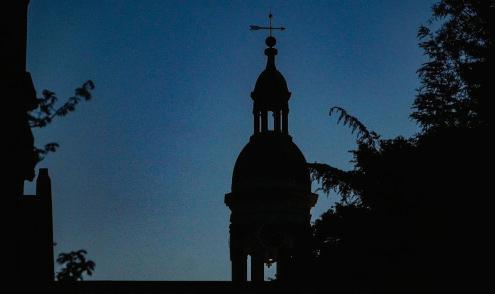
“I don’t think it’ll necessarily be an answer to alleviating stress,” Elgendy expressed. “For people who are all papers or all exams, it’s gonna make more of a difference, but for people taking a mix of classes, it’s gonna maybe create even more stress.”
However, Dean’s Date won’t disappear entirely. Instead, it will now be the last date for any work assigned during the term, excluding the final submission for the class. Gordin explained, “Dean’s Date still exists. We haven’t given it up entirely, but it’s the last date for any term-time work.”
There has been some confusion among students and faculty about adopting these new changes. Con-
Faculty approve four new minors, including Native American and
Princeton’s faculty approved the introduction of a new minor in Native American and Indigenous studies (NAIS) at the faculty meeting on April 7 along with three other minors in American Studies, Entrepreneurship, and Quantitative and Computational Biology. The NAIS minor comes after years of student advocacy for Indigenous scholarship.
A dedicated faculty committee within the Effron Center for the Study of America has been actively developing the NAIS minor program for several years. Last semester, the University hired its first Professor of Indigenous Studies in Anthropology J. Kēhaulani Kauanui, who began teaching this spring. In an interview with The Daily Princetonian in April 2024, Kauanui also expressed wishes to establish a minor program for NAIS.
“I’ve only had informal involvement, but I’ve been watching and paying attention to the development of the minor for the last several years … I’m really excited to see it finally happening,” Suzanne Conklin Akbari, a professor of Medieval Studies at the Institute for Advanced Study, told the ‘Prince.’ Akbari works with Indigenous language support and local community engagement with the Lenape, which includes initiatives such as the Unami Language and History Symposium at Princeton held last week.
“The new minor would be grounded in a Native American and Indigenous studies framework that highlights Indigenous governance, histories, and cultural continuity while examining
the lasting impacts of historical structures and the ongoing efforts toward self-determination,” the Effron Center’s proposal reads.
The proposal also highlights “significant student interest” in NAIS, citing consistent overenrollment in NAIS courses and an expansion in course offerings over the past five years. Akbari commended the role of Natives at Princeton (NAP) and their alumni counterparts in calling for the establishment of the minor and “bringing about this accomplishment.”
“I see the approval of the Native American and Indigenous Studies minor as a positive and long overdue step, one that reflects the tireless advocacy of many Indigenous and non-Indigenous students over the past years who have consistently voiced the need for this academic recognition,” Gustavo Andre Blanco-Quiroga ’25, a former co-president of NAP, who has Aymara Indigenous roots, wrote in a statement to the ‘Prince.’
However, Blanco-Quiroga noted that the introduction of the minor remains “a relatively minor step” in comparison to what peer institutions have done to elevate Indigenous studies.
Until the introduction of this new minor, Princeton was among only three Ivy League institutions that did not offer a formal academic program focused on NAIS. A 2020 opinion piece in the ‘Prince’ also found that Princeton provided the least amount of academic, institutional, and social support for Indigenous students compared to peer institutions.
“Overall, I believe this is an important move Princeton is making toward being recognized as
a ‘world-class institution,’ but there is still a long way to go for Princeton to meaningfully engage with and uplift global Indigenous studies as part of its academic vision,” Blanco-Quiroga wrote.
Three certificate programs were also approved to become minors: American Studies, Entrepreneurship, and Quantitative and Computational Biology. In the past few years, the University has shifted away from certificate programs and has replaced them with new minors.
The two terms are largely synonymous, and a shift towards using the word “minors” is an effort to move away from Princetonspecific terminology. During the transition, students will be able to pursue up to two minors, or a mix of minors and certificates.
Princeton’s efforts in expanding Indigenous scholarship dates back to 1970, when historians, artists, and scholars were invited by the University to its First Convocation of American Indian Scholars. “One of the things that’s really striking about Princeton, I think, is that in some ways, there’s a deep history of Indigenous Studies here,” Akbari said.
“Institutionally, it’s a very particular place, and it will be wonderful to see how [the minor] takes shape.”
Nikki Han is an assistant News editor and a contributing Features writer. She runs the Faculty, Graduate Students, and Alumni coverage area.
Sena Chang is a senior News writer for the ‘Prince.’ She typically covers campus and community activism, the state of higher education, and alumni news.
cerning final papers, Gordin said, “Your faculty member cannot say it’s due on the Dean’s Date.”
“We are working with the faculty to remind them of the policy,” he said.
Students will be able to look to their residential colleges for advice. Gordin shared that “there’s communications to the residential college deans and so on to try and make sure that everybody knows what’s going on.”
University students also have other resources to assist them with understanding and adapting to these changes. “Residential college deans and McGraw learning consultants are available to help with this planning,” Wei wrote. “So students should not hesitate to reach out. We are here to help!”
Luke Grippo is a staff News writer for the ‘Prince.’

LOUISA GHEORGHITA / THE DAILY PRINCETONIAN
By Sena Chang Senior News Writer
Analyzing ‘Tiger Snatched’ courses for Spring 2025
By Griffin Hon Staff Data Writer
Many students hoping to get into SML 201: Introduction to Data Science this semester were left disappointed. By the middle of the last week of the add/drop period, 244 people were waiting to grab a spot on TigerSnatch for a class with fewer than 160 enrollees.
The Daily Princetonian analyzed the 15 most-requested courses of the semester as reported by TigerSnatch subscription analytics.
The most ‘snatched’ courses are fairly evenly spread across distributional requirements. Literature and the Arts (LA) stands out, with the Creative Writing courses dominating. CWR 204: Creative Writing (Fiction) had 219 snatches, and CWR 202: Creating Writing (Poetry) had 172 snatches. Historical Analysis (HA) is the only distribution requirement without representation in the top 15.
Lecturer Day Yi, who teaches SML 201, attributes the course’s high demand to growing industry interest in AI.
“The demand might indicate students are favorably adopting the course content, the industry trends especially in the AI space, and the teaching efforts of our instructors,” Yi wrote. “We have a great group of core faculty at CSML who have laid the foundation for this demand long before I arrived here.”
The demand for these courses, however, has spelled difficulty for both professors and students, often exceeding the maximum roster size of the class.
Physics professor Jason Puchalla, who teaches PHY 108: Physics for the Life Sciences, wrote in an email to the ‘Prince’ that there are two sides to teaching a course with more interest than can be satisfied. PHY 108 had 177 people awaiting openings on TigerSnatch. “I’m delighted the class has been well received by students, but the enrollment stress means I have mixed feelings,” Puchalla wrote. “I’m thankful I’ve been able to have a positive impact on so many exceptional students since our department first offered the class. That said, PHY 108 has grown into a complicated element of the curriculum.”
As such, one of the most challenging aspects of teaching these courses is choosing which students to accept from their extensive waitlists. Professors must carefully balance class function with satisfaction, and, in certain cases, consider students who need the courses to graduate.
Puchalla spoke about the complex and difficult process involved in selecting students off of the waitlist.
“Many students hope to use the class to help prepare for the MCAT, others are potentially away the following year, and some reveal last minute that they are seniors who won’t graduate unless they get in,” Puchalla said. “Seniors who need the class to graduate are considered first. Then come students who have been locked out several times (I keep a lot of emails) and complicated cases I’m informed of by deans and departments.”
Puchalla claimed that, after that, he used a lottery to fill remaining spots.
“Telling so many students this year that there are no more seats in the class was disheartening and incredibly frustrating,” he added.
Professor and Director of Graduate Studies in Musicology Elizabeth Margulis teaches MUS 248: Music Cognition, which had 136 TigerSnatch subscriptions. Speaking about the student selection process, Margulis wrote, “We try to add people as fairly as we’re able, based on how the class fits into their goals and plans and how long they’ve been on the list.”
While seniority is generally the primary factor considered when selecting students off of the waitlist, there are exceptions.
With 111 students on the waitlist and only 15 spots available, ANT 232: Love — Anthropological Explorations has the highest waitlist-to-class-size. Aina Marzia ’28 was accepted into the class after contacting the course instructor, Professor Thalia Gigerenzer.
“I didn’t initially get the class because it was taken by seniors, but I emailed the professor as a freshman about my earnest interest for the class’s content and she gave me permission to enroll,” Marzia said. “The ethnographic aspect of the class really interested me. I knew I wanted to take it as someone who wants to major in Anthropology; plus who doesn’t want talk about love, even if it’s academically. It teaches you a lot.”
Yi acknowledged the challenges the relatively young Center for Statistics and Machine Learning faces in managing the unprecedented demand, often requiring faculty members to juggle multiple responsibilities.
“We are not a large department — in fact, we aren’t even a department — and so our thin resources create challenges in managing the enrollment at the start of the semester. Many of us wear several hats in keeping this course from falling apart,” Yi wrote. “This creates much extra work for us — the instructors and administrators. The quality to quantity ratio can suffer as a result. I’m a movie buff, so I refer to a quote from Hyman Roth (The Godfather, Part II) — ‘this is the business we’ve chosen.’” These challenges come despite general increases in maximum enrollment sizes for these courses since the Spring 2022 semester.
The highest percent maximum enrollment size increase occurred in POL 396: International Organizations, in which enrollment increased by 230 students: a 135 percent jump. The course had 127 students subscribed on TigerSnatch, waiting for a course opening. The add/drop period officially ended on Friday, Feb. 7 at 11:59 p.m. Many courses on the top 15 list in Tiger Snatch are still overenrolled.
Griffin Hon is a staff Data writer for the ‘Prince.’
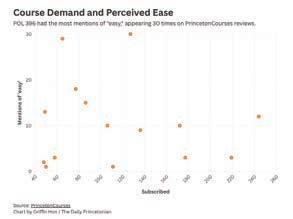
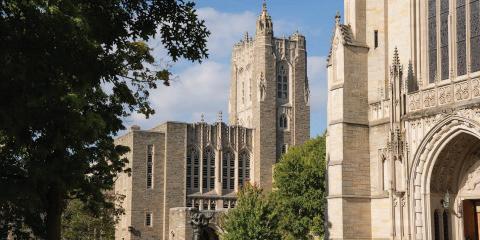
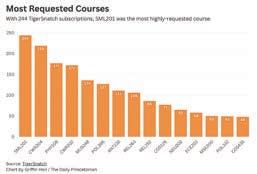
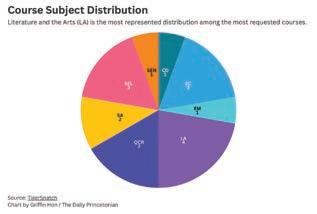
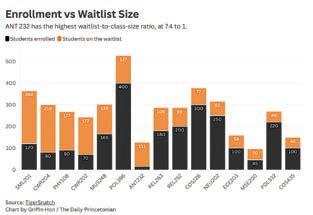
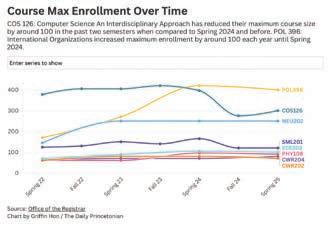
LOUISA GHEORGHITA / THE DAILY PRINCETONIAN
EATING CLUBS
Cloister Inn to pause operations for the next 2–3
years,
citing “hefty renovations”
By Justus Wilhoit Senior News Writer
Cloister Inn, one of Princeton’s eating clubs, will pause operations for the next two to three years, citing “hefty renovations” to the club’s house as the reason for the abrupt change. The move, which was announced to undergraduate members on Friday, came as a shock to officers and members alike and follows just 18 months after the club had to resort to an aggressive alumni fundraising campaign to keep its doors open.
An official statement from the club’s Board of Trustees to alumni said that upgrading the facility is necessary to remain competitive on Prospect Street, especially as more students express interest in taking part in Street Week.
“As Board members, we have heard consistent feedback from alumni and students — Cloister must upgrade its facilities and image to provide an experience that is attractive to today’s Princeton students,” the statement read.
In the email to current members, the club’s undergraduate officers expressed disappointment.
“We understand (and are just as shocked as you all are) that this will cause considerable chaos as you sort out your dining plan for next year,” they wrote, hinting that the decision may have come as suddenly to them as it did to the wider membership. They added that they themselves were still figuring out where to live for the coming year.
“I really didn’t see it coming, and I thought it was a really extreme measure,” said Cloister member Aidan Wang ’27.
Wang hopes to join another club in the fall, and while he is optimistic about how the other clubs will accommodate Cloister members, he wished the club had given members more advanced warning.
“If a shutdown was indeed necessary, give us at least a semester’s warning first before shutting down, so we could have time to figure out and plan what our next move is going to be,” Wang said.
Quadrangle Club and Colonial Club have officially pledged to accept any Cloister member who wishes to join, according to a separate statement sent out by the board to student members Friday night. Apart from Cloister, these were the only clubs without a waitlist to join at the end of Street Week in the spring.
Mike Jackman ’92, Chairman of the Board of Trustees told The Daily Princetonian in an interview that there are ongoing conversations with other clubs to make space for Cloister members, but he did not explicitly mention which additional clubs.
When asked why the club chose to pause operations entirely, unlike Charter Club and Cannon Dial Elm, which have undergone or are undergoing renovations while remaining open, Jackman explained that the club has not had a major renovation since the 1980s. He noted that major infrastructure work, especially in the kitchen, library, and dining spaces, would be too disruptive to continue normal activities.
Jackman said that the renovations would include changes to the kitchen, library, and dining spaces, but it appears
that many details still need to be sorted out. In a message to the club’s alumni on Friday, Jackman said a team of alums would “develop the vision as well as the execution plan and investment required” over the next six months.
Still, Jackman said that the temporary closure is necessary due to the disruptions it would bring to members.
“The resulting disruption to undergraduate activity would be too severe to be able to provide student members the experience they deserve if we were to operate during the renovation,” Jackman said.
“Once that construction starts, the only alternative would have been to spread it out over multiple summers, and we didn’t want to wait that long,” he added.
In addition to the call for renovations, Jackman also cited the club’s low membership in recent years.
“Since COVID, the annual membership of the club has been under 50 students, and we expect this trend to continue,” the Board of Trustees said in a statement to alumni.
“[Low membership is] a sign, at least to me, that what we’re offering at Cloister is not meeting the needs of enough kids on the campus,” Jackman added in an interview.
During the 2023–24 school year, Cloister’s membership was split between the Classes of 2024 and 2025, with 20 members in the former and 21 members in the latter. Three members were graduate students or associate research scholars.
Cloister has a long history of nearclosures. In 1972, Cloister temporarily
closed due to lack of membership and became an alternate dining facility for undergraduates and an alumni center until 1977. In 1985, Cloister recruited only 11 new members during its signin period, causing it to nearly close. In 1994, Cloister undertook a “takeover” by sophomores which helped rescue its declining membership. In 2023, Cloister asked alumni to raise $250,000 in order to avoid closure. Club leadership hoped to pursue another “takeover” that ultimately did not take place.
In the absence of member dues, Cloister has secured baseline funding for the renovations from an “entity friendly to the club” that Jackman was unwilling to disclose. Alumni have also been called upon to help fundraise.
Jackman confirmed to the ‘Prince’ that this decision was made at the club’s Board of Trustees meeting on June 4 and student members and alumni were all
notified on Friday. While Jackman acknowledged the disappointment felt by students, he expressed optimism about the opportunity to rebuild from the ground up. With no returning members when the club reopens, he sees a chance to reimagine the club’s identity.
“I think we’ll see some other members of other clubs probably get involved, because a strong club system helps all the clubs, and helps Princeton students, and really helps Princeton,” he said.
“We have to think about how students want to join a club, what kind of environment they’re looking for, and how to create that vibe. This is a very exciting project, and one that’s going to pay off for future Cloister members,” Jackman added.
Justus Wilhoit is a head Audience editor and senior News writer for the ‘Prince.’ He
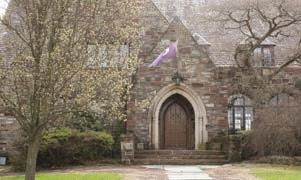
Charter Club changed guest policy after conservative professor’s
lunch. After
By Bridget O’Neill Head News Editor
The guest policy changed at Princeton’s sole selective sign-in eating club. Days later, it changed again.
On March 26, Charter Club’s President announced a new guest policy in a clubwide group chat. Under the new policy, club members were required to inform the Club Manager and a student officer of guests they invite during meal hours who were not friends or family “for review.”
By April 2, the policy was reversed after an intervention from the club’s Graduate Board. In the seven days in between, debate over the policy rose from the club’s private GroupMe to the headlines of national right-wing publications. Club leadership maintains that the reversal was not due to national media scrutiny.
The controversy, and the specific demographic to which the policy applied — visitors other than friends or family — traces back to a lunch in February.
Charter member, and member of Princetonians for Free Speech, Matthew Wilson ’24 brought his thesis advisor, McCormick Professor of Jurisprudence Robert P. George, to lunch at the club on Feb. 14. George was named an honorary member of the Charter Club in 2012 — a status that enables him to dine and bring guests to Charter. In a column published in The Daily Princetonian on April 1 criticizing the ensuing policy change, Wilson described the lunch as “pleasant and uneventful” and says he followed the club’s procedure for bringing guests to meals.
Wilson is a columnist for the ‘Prince.’
More than a month later, Charter Club President Anna Johns ’25 announced the new policy.
headlines, the policy was reversed.
In her message, Johns called the club a “sanctuary” for student membership and their friends and family. She requested that members “limit the use of [the] clubhouse space to this core group” and announced the new review procedure.
Johns did not reply to request for comment by publication time.
Immediately after, speculation stirred about what triggered this policy change. In his column, Wilson said that he heard from friends that the policy was a reaction to his February lunch. In a comment to the ‘Prince’, Chairman of the Board of Governors of Princeton Charter Club, Rodrigo Menezes ’13 confirmed that the policy was in response to members’ discomfort at the presence of Professor George, which they expressed to club officers.
“Some members wanted the choice to be absent from the Club around certain guests. The proposed procedure intended to give members that freedom by requiring a short pre-registration,” Menezes wrote.
The announcement immediately caused confusion among members and alumni who were unclear on the reasoning behind the change. After Wilson circulated a petition to the club’s alumni board calling on them to revoke the policy, Johns sent another message in the group chat clarifying that “Charter is an inclusive private club that will never deny a member’s request to bring a guest to our sanctuary,” but maintained that prior review would still be required.
George is a well-known campus figure, partially due to his leadership of the James Madison Program. Vocally prolife, George was referred to in a New York Magazine article from a decade ago as the “reigning brain of the Christian right.” In his scholarship, George has repeatedly argued against same-sex marriage.
“It was a grave error for Charter’s leadership to bend to the demands of a few students who couldn’t stomach the possibility of being within shouting distance of someone whose views challenge their own,” Wilson argued in his April 1 column.
On April 2, conservative national news organizations caught wind of the story.
A Fox News headline read, “Conservative Princeton professor makes members of exclusive campus social club uncomfortable, student says.”
A National Review piece by Abigail Anthony ’23 was titled “Princeton’s Nurseries.” She argued that justifying the policy with the virtue of inclusivity is hypocritical given that “they want a carefully constructed community, presumably one insulated from people who hold different views.”
“I seriously doubt the new policy will be neutrally enforced with respect to political ideology; after all, it was precisely because of George’s conservative views that complaints were raised, since he wasn’t engaging in any disturbing conduct,” Anthony wrote.
Solveig Gold ’17, a former Postdoctoral Research Associate at the James Madison Program and former Princeton undergraduate wrote on X, “One of Princeton’s eating clubs (co-ed frats) has instituted a new visitors policy after a student brought @McCormickProf to lunch— because his very presence at the club made members feel unsafe!”
Professor George responded to the post, writing “So ... Students have to give notice to bring me as a guest for lunch at a club ... that I myself belong to? And, as a member, am entitled to use whenever I like, and bring guests of my own? (By the way, Solveig, when are you available to be my guest for lunch at Charter Club?).”
He later posted “I’m a member of Charter Club. I was made an honorary member in 2012 pursuant to Art. III, Pt. 3 of the Club’s constitution. I’m entitled to use the Club when I like and bring guests.” George is also an honorary member of Ivy Club.
While a national debate ensued, internal debate about whether to keep the policy continued within the Club. In an unusual step, members asked the Graduate Board to “arbitrate the situation and make a decision for the Club,” according to Menezes.
On April 2, at 11:05 p.m. Menezes wrote in an email to members that the Board “is leery of any process that could reduce the culture of civil discourse and camaraderie at the Club” and decided to reverse the policy.
Menezes clarified in his comment to the ‘Prince’ that the board’s decision
was based on “civil discourse within the community, not pressure from national coverage” and “The Board would have reached the exact same conclusion without national coverage.”
“Our members and alumni reached out, telling us that this procedure could discourage members from bringing potentially controversial guests, limiting the club’s capacity to act as a forum for civil discourse on campus,” he added. Menezes also noted to the ‘Prince’ that he hopes Professor George or Wilson are not discouraged from coming to the club.
“They are still welcome at the Club, and we aspire to be among the most inclusive clubs on the street.”
Bridget O’Neill is a head News editor for the ‘Prince.’
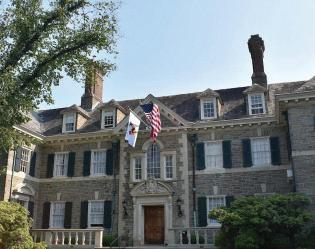
ANNIE RUPERTUS / THE DAILY PRINCETONIAN
vol. cxlviii
editor-in-chief Miriam Waldvogel ’26
business manager Jessica Funk ’26
149TH MANAGING BOARD
upper management
Eleanor Clemans-Cope ’26
Isabella Dail ’26
director of outreach
Oliva Sanchez ’26
Accessibility
Bridget O’Neill ’26
Bryan Zhang ’26
creative director Malia Gaviola ’26
strategic initiative directors
Suthi Navaratnam-Tomayko ’26
editors at large Research Andrew Bosworth ’26
Education Hayk Yengibaryan ’26
Sections listed in alphabetical
head archives editor
Lianne Chapin ’26
associate archives editor
Jillian Ascher ’28
head audience editors
Paige Walworth ’26
Justus Wilhoit ’26 (Reels)
associate audience editors
Catherine Ross ’27
Amparo Sofia Sanchez ’27
associate reels editors
Natalia Diaz ’27
Loreta Quarmine ’27
head cartoon editor
Eliana Du ’28
head copy editors
Lindsay Pagaduan ’26
James Thompson ’27
associate head copy editors
Coco Xu ’27
Song Ting Tang ’27
head data editors
Vincent Etherton ’26
Alexa Wingate ’27
head features editors
Raphaela Gold ’26
Coco Gong ’27
associate features editors
Mira Eashwaran ’26
Valentina Moreno ’26
head humor editor
Sophia Varughese ’26
associate humor editors
Tarun Iyengar ’28
Francesca Volkema ’28
head news editors
Hayk Yengibaryan ’27
Victoria Davies ’27
associate news editors
Thomas Catalan0 ’27
Devon Rudolph ’28
Hayk Yengibaryan ’26
head newsletter editor Caleb Bello ’27
Chair
associate newsletter editor Corbin Mortimer ’27
head opinion editor Frances Brogan ’27
community opinion editor Jerry Zhu ’27
associate opinion editors Preston Ferraiuolo ’26
Siyeon Lee ’27
head photo editors
Calvin Grover ’27
Jean Shin ’26
head podcast editor Maya Mukherjee ’27
associate podcast editors Twyla Colburn ’27
Sheryl Xue ’28
head print design editors Kriste An ’28 Juan Fajardo ’28
head prospect editors Russell Fan ’26
Mackenzie Hollingsworth ’26
associate prospect editors Natalia Diaz ’27
Gavin McLoughlin ’28
head puzzles editors Wade Bednar ’26 Luke Schreiber ’28
associate puzzle editors Jasin Cekinmez ’27
Lindsay McBride ’27
Peter Stover ’28
head sports editors Alex Beverton-Smith ’27
Harrison Blank ’26
associate sports editors Lily Pampolina ’27 Doug Schwarz ’28
head web design and development editors Lauren Pak ’27 Cole Ramer ’28
149TH EDITORIAL BOARD
Christofer Robles ’26
Members
Isaac Barsoum ’28
Frances Brogan ’27
Eleanor Clemans-Cope ’26
Preston Ferraiuolo ’26
Anna Ferris ’26
Ava Johnson ’27
Jorge Reyes ’28
Bryan Zhang ’26
149TH BUSINESS BOARD
assistant business manager
Alistair Wright ’27
directors
Andrew He ’26
Tejas Iyer ’26
William Li ’27
Stephanie Ma ’27
Jordan Manela ’26
James Swinehart ’27
Adelle Xiao ’27
Chloe Zhu ’27
business manager emeritus Aidan Phillips ’25
149TH TECHNOLOGY BOARD
chief technology officer
Yacoub Kahkajian ’26
software engineers
Abu Ahmed ’28
Jaehee Ashley ’25
Brian Chen ’26
Nipuna Ginige ’26
Angelina Ji ’27
Allen Liu ’27
Rodrigo Porto ’27
Stephanie Sugandi ’27 ui/ux engineer Joe Rupertus ’26
THIS PRINT ISSUE WAS DESIGNED BY
Kriste An ’28
Juan Fajardo ’28
Marley Hartnett-Cody ’28 Chengyu Fu ’28 AND COPIED BY
BOARD OF TRUSTEES
president Thomas E. Weber ’89
vice president David Baumgarten ’06
secretary Chanakya A. Sethi ’07
treasurer Douglas Widmann ’90
assistant treasurer Kavita Saini ’09
trustees Francesca Barber
Kathleen Crown
Suzanne Dance ’96
Gabriel Debenedetti ’12
Stephen Fuzesi ’00
Zachary A. Goldfarb ’05
Michael Grabell ’03
Danielle Ivory ’05
Rick Klein ’98
James T. MacGregor ’66
Julianne Escobedo Shepherd
Abigail Williams ’14
Tyler Woulfe ’07
trustees ex officio
Miriam Waldvogel ’26
Jessica Funk ’26
There’s an existential threat
to
the eating clubs that you need
to know about
IVincent Jiang Guest Contributor
am writing in my personal capacity as the former President of the Interclub Council to give the University some feedback on an important matter they are currently reviewing. From late 2023 to early 2024, the University hired an outside consulting firm, Huron Consulting Group, to examine the housing and dining undergraduate experience. Last summer, the Huron Group quietly released a 25-page report detailing their findings. The report is as opaque with its methodology as it is sweeping in the scope of its recommendations, the most extreme of which is a proposal on the last page to require all students who reside on campus to purchase a campus dining meal plan — including juniors and seniors currently on an eating club contract.
This course of action would be harmful to the undergraduate experience and poses an existential threat to the eating clubs, potentially forcing many into financial ruin. If implemented, the report’s recommendation would sever past and present generations of Princetonians from their unique and tight-knit communities, reverse decades of progress towards diversity in the clubs, and throw the undergraduate dining system into disarray. I respectfully call on the administration to disavow this course of action, since the relationship between the University and the eating clubs is ultimately one of mutual benefit.
The eating clubs play a vital role in nurturing Princeton’s undergraduate and alumni communities. The Huron Report itself emphasized that “students who are a part of [an] eating club are more satisfied than those who identify as Independent or have selected a meal plan.” The eating clubs provide a convenient location to eat, as well as a vibrant campus social scene with robust safety measures, including hiring professional bouncers, running SHARE training for members, partnering with PSafe, and defining policies around afterdark events. The rich and longstanding history of the eating clubs also helps members feel a
sense of investment in a beloved campus tradition. There’s a reason Princeton has the most loyal alumni in the Ivy League — long after graduation, students who were in eating clubs have a lifelong home on campus to come back to.
However, requiring all juniors and seniors to purchase a campus dining meal plan would threaten these benefits. Few Princetonians would be able to afford both their eating club fees and a campus meal plan, so requiring such a plan is tantamount to forcing most students to give up their eating club memberships. Notably, the Huron Report does not recommend that the University readjust their increased food budget for juniors and seniors to be higher, which could shield students on financial aid from the worst of the effects. With a decimated pool of potential members, most if not all eating clubs would simply not be able to continue operation — especially in the face of sky-high property taxes, multiple forms of insurance, and rising inflation in the food industry.
The report is, at the moment, a recommendation. But the stakes are high. Every time in the past a club has closed on the Street has been a heartbreaking experience for its undergraduate and alumni members. In particular, stripping alumni of their “home away from home” at Princeton would lessen their connection to campus and the University. According to the Huron Report itself, “Alumni eating club members expressed a high degree of affinity for their club, describing it as a defining element of the residential experience. The eating clubs were cited as motivators for alumni to return to campus.”
This is due in no small part to the fiercely proud and tight-knit communities we are able to form at the eating clubs, which remain near and dear to alumni hearts even decades after they graduate.
Furthermore, following the Huron Report’s recommendation would reverse decades of painstaking and fruitful progress on eating club diversity. The eating clubs today are more diverse in terms of race, gender, and socioeconomic background than they have ever been before. But if all students were required to purchase a campus dining plan, only
the most wealthy and privileged Princetonians would be able to afford an eating club membership on top of it. Instead of being able to serve large majorities of Princeton’s student population, the clubs would only be able to cater to the “one percent,” turning into regressive and anachronistic versions of themselves that nobody, especially the current and increasingly diverse membership of the clubs, wants them to be.
Lastly, requiring all juniors and seniors to purchase campus dining plans would negatively impact the general undergraduate dining experience, including first-years and sophomores, as well as the students who choose to remain on a dining hall plan in their upperclass years. The current dining hall options are already crowded, with long lines winding through the serveries and teeming with unfamiliar faces. Jamming several thousand additional juniors and seniors into an already overburdened and crowded campus dining system would exacerbate these issues, no matter how many gleaming new dining halls rise at Hobson or other farther locations.
Both of us, the University and the eating clubs, ultimately share the same goal: making the undergraduate experience as enriching and rewarding as possible and fostering an enthusiastic and involved alumni community. Adopting the Huron Report’s recommendation to force every student to purchase a campus dining meal plan, even if they have another full meal plan, would be counterproductive to that mutual goal. It would take away one of the most beloved Princeton traditions, reversing decades of progress and worsening the Princeton experience for all students, regardless of whether they participate in an eating club. I am, respectfully, offering my advice to the University to reject this ill-conceived recommendation.
Vincent Jiang ’25 is the President Emeritus of the Interclub Council, the organization composed of the eleven undergraduate eating club presidents at Princeton University. He can be reached at vincentjiang[at] princeton.edu.
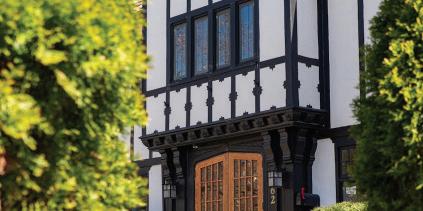
Bryan Zhang ’26
Who joins Princeton’s eating clubs? Breaking down eating club trends.
By Danna Duarte Staff Data Writer
All eleven eating clubs on Prospect Ave. are known for their distinctive communities. As sophomores find their fit in terms of the eating and social community they choose to join for their final two years on campus, they must weigh out different aspects of each club that give them their identity. Interested in diversity? Look no further than Cap and Gown, where seniors report the most racial diversity of all the clubs. If your main concern is booze, Tiger Inn is the place.
These clubs have historically been a large part of Princeton’s social scene, with approximately three-quarters of Princeton seniors reporting they have paid dues to at least one eating club during their undergraduate career. With bicker season concluded and hundreds of sophomores settling into their new clubs, the Daily Princetonian broke down the senior respondents aggregated from the 2022, 2023, and 2024 senior surveys, looking at the most interesting trends on the Street. Every club had a sample size of at least 45 students, with five clubs having a sample size of at least 150 over the three years.
According to the past three senior surveys, 76.7 percent of seniors reported having paid dues to at least one eating club during their time at Princeton.
Across all 3 years, sixteen percent of respondents report being first-generation college students. Cloister Inn and non-club students had the highest percentage of first-generation college students, at 22.92 percent and 26.43 percent, respectively.
In contrast, Cannon Dial Elm Club and Tiger Inn had the lowest percentages, with 7.94 percent and 7.69 percent, respectively. Overall, sign-in clubs — Colonial, Cloister, Quadrangle, Terrace, and Charter — had slightly higher percentages of first-generation students compared to bicker clubs, including Cannon, Cap and Gown, Cottage, Ivy, Tiger Inn, and Tower.
Cottage and Ivy Clubs had the highest percentage of members who reported a household income above $500k, with 29.17 percent and 26.92 percent, respectively.
Overall, 18.6 percent of students who never joined an eating club reported having a household income below $40k, the highest percentage of any category analyzed. Among the eating clubs, Terrace and Quadrangle had the highest percentages of members who reported having a household income below $40K, with 16.56 percent and 16.15 percent, respectively.
71.32 percent of respondents who have been members of Colonial Club identified themselves as Asian. Cottage Club and Tiger Inn had the highest percentage of members who identified as white, with 77.36 percent and 74.44 percent, respectively.
Politically, 43.36 percent of Terrace members identified as leftists/socialists, closely followed by Quadrangle Club, with 32.43 percent of members. Cottage Club and Cloister Inn had the highest percentages of members identifying as very conservative, with 11.11 percent and 7.41 percent, respectively. Out of the respondents from Cap and Gown Club that reported leaning towards one specific side, around 96 percent leaned left.
Terrace and Quadrangle clubs had the highest percentage of LGTBQIA+ identifying members. In comparison, Cannon, Cottage, and Tiger Inn had the lowest percentages. 44.9 percent of students who never joined an eating club had not had sex. Among eating clubs, Colonial (33.8 percent) and Quadrangle (33.3 percent) had the lowest percentage of respondent members who haven’t had sex. In contrast, Cap and Gown (93.4 percent) and Ivy Club (93.5 percent) had the highest percentage of members who reported having had sex.
Students who did not join an eating club reported the lowest average drinking frequency (2.42 on a 7-point scale), with approximately 27.6 percent reporting they have never consumed alcohol in a non-religious context, significantly lower than any club-affiliated group, suggesting that club membership may correlate with higher alcohol consumption.
Terrace and Ivy Club members reported the highest levels of marijuana use, with average scores of 2.99 and 2.67 on a 7-point scale, where a score of 3 corresponds to using marijuana “once a month.” In contrast, Colonial Club members reported the lowest frequency of marijuana use.
It is commonly said that there is a club for everyone on the Street. As class sizes expand and new classes join the eating club system, will Princeton’s eating club communities continue to evolve, or will their identities remain?
Danna Duarte is a staff Data writer for the ‘Prince.’
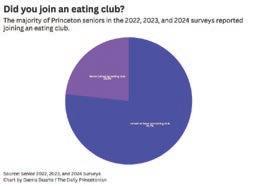
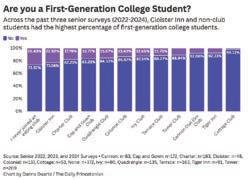

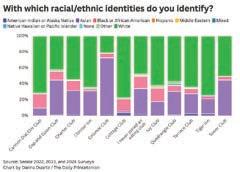
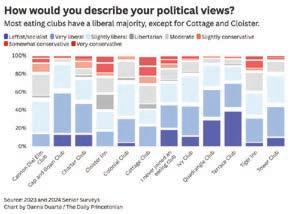
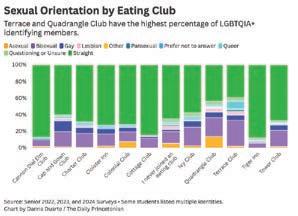
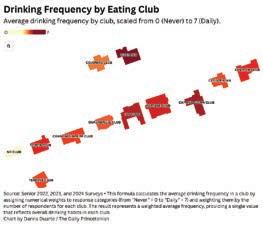
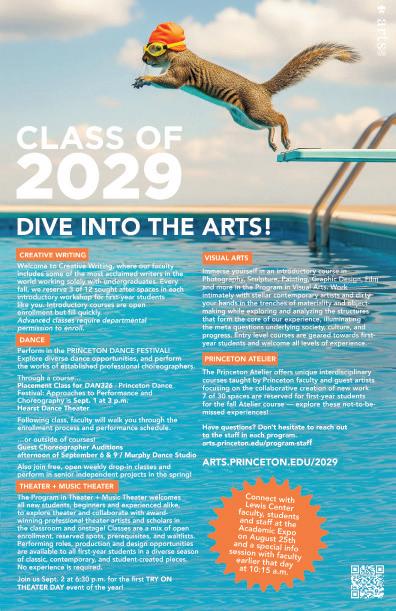
ARTS & CULTURE AT PRINCETON
Sankofa’s latest fashion show, NTU, is the essence of the runway
By Amanda Hugas | Prospect Staff Writer
Scudder Plaza had a new look this past month, trading its usual treatment as a tourist splash pad for a runway. At Sankofa, an annual African fashion show, the cool mist from the Fountain of Freedom lightly doused the rows of invested onlookers, letting the small chatter and club music fill the air.
This year’s show, titled “NTU,” was unique and captivating, a blend of elements sourced from a wide range of designers. ‘Ntu’ is a Bantu term referring to “the essence.” The show was split into four segments, each named after a different Bantu word.
“NTU reflects enduring cosmologies, resilience, and the powerful presence of Afro-mysticism throughout African and diasporic spiritual traditions. The show aimed to honor and embody those themes through every element, from fashion to performance,” Head Artistic Director Arrey Enow ’26 told The Daily Princetonian.
Organized by the student-run Sankofa Committee, preparations began in late December and continued until showtime in April. Designers hailed from Princeton to Parsons, and even abroad from countries such as Ethiopia.
The first models made their elegant entrance along the fountain’s border, flowing in with the gentle breeze. The first collection was presented as an artistic interpretation of ‘muntu,’ a Bantu word representing the abstract and ethereal. These pieces were an ensemble of harsh,
dramatic jackets ranging from cream with black detail work to full monochromatic looks in all black.
From this first phase, a favorite piece of mine was sourced from Fashion Institute of Technology student Kassia Engelmann’s original work. Decked in sheer tulle fabric with a honeycomb gathering in the front, the dress’s layered train flowed calmly in the wind, letting the elements influence its shape.
Following Engelmann’s designs, the show featured a collection of jackets defined by sharp silhouettes around the necklines and exaggerated sleeves from HΛWII, a Parisianbased fashion with Ethiopian roots. Among the models adorned in these distinctive jackets, returning model Avery Fuller ’26 walked the runway wearing an oversized blazer.
“Being in Sankofa means not only getting to showcase the work of talented artists within the Black diaspora but also engaging with other members of the Black/African community here at Princeton,” Fuller said in an interview with the ‘Prince.’ “It’s the show that I credit for giving me the confidence I have today, and I wouldn’t be able to move in the way I do without it.”
The next segment was centered around ‘kuntu,’ a Bantu word reflecting the rich and vibrant earthly elements of the world. With a more colorful range, this collection went from deep earth tones to muted reds and blues across all fabrics. Many of the pieces were sourced from Parsons School of Design student designer Alameer Rosenje.
Building her portfolio in Sankofa as a returning model, Eva-Labelle Kenmoe ’27 was a standout during this segment. Kenmoe wore a metallic, dusty sage two-piece set that was paired with a matching bag and arm sleeves. To Kenmoe, this set was a personal favorite among all her looks during the show. In an interview with the ‘Prince,’ she said, “I thought it beautifully embodied the spirit [of earth].”
Moving on, the third phase, “KINTU,” focused on the more rhythmic flow of water. This collection played heavily into patterns and detailed beaded and embroidered work. With many of these works coming from Cute-Saint, a sustainable African fashion brand, a standout was the Nuer Shirt, which was made of a dyed canvas fabric with embroidered details.
“One piece I was absolutely obsessed with was the first outfit,” said model Chloe Riche ’27 on the dark, blue and green, coral-inspired outfit from the “KINTU” phase. “The blues meshed together very well here and I fell in love with it,” she said.
The final phase, “HANTU,” aimed to disrupt the peace of the previous collection with a fiery entrance. Models broke into an erratic sprint to the sound of sirens, a single blur of caution tape fashion-wear dashes around the fountain. ‘Hantu,’ another Bantu word, represents the fashion constantly burning to a new era. Throughout this collection, the majority of pieces originated from the sustainable brand OSHOBOR. The unique element that brought
special attention to this collection was the use of tassels.. Shaking and bouncing with each model’s step, they captured the essence of a finicky flame. Transitioning from a consistent ruby red to an ashy grey and black as the models walked by, the colors were a vibrant contrast to the marble background of the SPIA Building.
A highlight of this final selection was the Ekpen Set from OSHOBOR: a combination of velvet, lace, and wool. The velvet skirt’s weight rippled with each step, and the wool accented blazer defined a sharp frame, adding texture to this otherwise sea of red.
Overall this final phase brought a satisfying conclusion to the show. I witnessed what I felt was the representation of the elements that govern the very life force within our cosmos. As Enow told the ‘Prince,’ “Princeton can feel so distant from the fashion world, and there were moments when it felt like we were building something from nothing… [but] watching the campus show up to celebrate Black art and creativity made all the stress completely worth it.”
This year’s Sankofa show brought a new “essence” to the relationship between fashion and the Black arts, all on the refreshing runway of Scudder Plaza.
Amanda Hugas is a member of the Class of 2027 and a staff writer for The Prospect. She can be reached by her email at ah0942[at]princeton.edu.
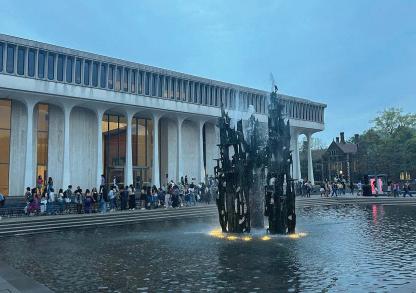
A colorful evening with Princeton University Ballet’s ‘chroma’
From Nov. 8 to 9, Princeton University Ballet filled Frist Theater with color in their show “chroma.” The program describes the performance as the “purity of color” and “freedom from white or gray,” with dance styles inspired by the renowned choreographer Wayne McGregor. The show was a compilation of choreographies that were inspired by different centuries and styles, from classical ballet and beyond. Each piece’s theme “showcas[ed] the vibrancy of [PUB] and the dynamism of ballet.”
The show opened with a spirited duet titled “Neapolitan” performed by An Phan ’26 and Seiya Saneyoshi ’27. Set to the iconic compositions of Tchaikovsky, the piece burst forth with energy, instantly captivating the audience. The choreography was bright and celebratory, blending classical ballet techniques with modern inflections, creating a fresh twist on Tchaikovsky’s timeless score. This jubilant opening set an uplifting tone for the evening, making it the perfect opener for the show.
In contrast, the following piece, “In Vivo”, introduced a modern and experimental aesthetic, departing from the light-hearted elegance of Neapolitan. Choreographed to an alternate version of Chicha Nola by Gitkin, the music provided an edgy soundscape that intensified the piece’s atmosphere. The dancers’ sharp movements and distinct costumes enhanced the otherworldly effect.
The beautiful, floral, light imagery in the third piece came as a surprise after reading its title, “Queen of the Night.” The dancers gracefully entered the stage in long flowy pink skirts — referencing to the Epiphyllum oxypetalum,
THE PROSPECT | APRIL 2024
‘It’s
a flower known as the “queen or princess of the night” in its nocturnal blooming patterns. The floral motif was apparent in the performance, as the seven dancers on stage created the image of the flower through their graceful movements and positioning. As the piece closed, the lights dimmed and the dancers gathered around PUB’s co-social chair, Paige Sherman ’25, creating a circle with their arms moving out gracefully, evoking the image of a flower blooming.
The night continued with other vibrantly memorable pieces including “Tetra Viva,” “Pink Ladies,” “In Retrograde,” “Viridis,” and “Joy” — all of which were excellent performances with each dancer that graced the stage. Before intermission, six dancers dressed in hot pink entered the stage for their piece “Pink Ladies,” accompanied by “My One and Only” & “Fascinating’ Rhythm” by George Gershwin. The performance was joyful and classy, with multiple notable moments, including the feature of a high-spirited kickline and elegant solo moments from each dancer.
While two pieces alluded to the white imagery of clouds, the dancers brought a vibrant colorful energy to the auditorium through their movement. While dancers in “Cumulus” were dressed in white billowy dresses which created the soft image of a cloud, the choreography brought the piece to life chromatically. “Cloud9” accompanied by “I’ll Haunt You” & “One Night with the Valet” by Tennis offered a significant shift from previous themes and costumery. “Is this the piece with the jorts?” “Rock the jorts!” audience members shouted as the dancers took the stage. Dressed in baggy band T-shirts and long denim shorts, the dancers brought contemporary elements to the stage, complete with their impeccable ballet
skills. The unique combinations stayed true to the idea of freedom that the show’s theme hoped to convey, highlighted by the piece’s spontaneity.
The final piece of the evening — “What Would You Cast Into Existence?” — was a radiant expression of pure joy and community. From the moment the dancers took the stage, their typical casual summer attire — T-shirts, tank tops, denim shorts, and tennis shoes — confirmed a shift from formality to a more relaxed and relatable vibe. This choice of costume lent the performance a playful feeling, inviting the audience to experience dance as an extension of everyday life. The choreography was infused with a light-
hearted spirit, featuring energetic leaps, spins, and spontaneous group formations that echoed the carefree atmosphere of summer gatherings with friends. The piece felt like a celebration of the beautiful community of PUB and the unique approach made it easier for viewers to imagine themselves dancing alongside the performers, sharing in PUB’s beautiful sense of togetherness and boundless energy, wishing only they had the dance skills to join in.
Natalia Diaz is a member of the Class of 2027 and a staff writer for The Prospect at the ‘Prince.’ She can be reached at nd6595[at]princeton.edu.
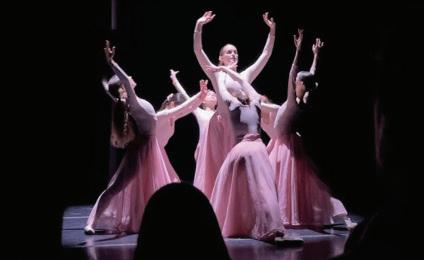
Like Dragons’: Inside Princeton Students’ Hidden
Musical Haven
While Saturday mornings may be a quiet time around most of Princeton’s campus, the Lewis Center of the Arts is bustling with activity — and performers’ instruments. Every Saturday, buses congregate in front of the arts complex, dropping off Trenton middle and high school students for a morning of performances.
The weekly program, Saturday Morning Arts (SMArts), is a part of a larger organization called Trenton Arts at Princeton (TAP), a collaboration between the Department of Music, Lewis Center for the Arts, and Pace Center for Civic Engagement. SMArts, one of TAP’s most notable programs, brings together Princetonians and Trenton students through a shared love of the arts. On rehearsal days, the middle and high school students arrive in the morning, where they are provided with a quick breakfast to fuel hours of rehearsals. From then until the early afternoon, the students divide into one of four categories: dance, orchestra, choir, or theater. Princeton students involved in TAP assist in teaching the students and guiding their rehearsals.
Each week, a Princeton performance group also provides a demonstration. Previous performers have included the a cappella group the Nassoons, the chamber music group Opus, and the dance group eXpressions.
“I especially enjoy seeing the Trenton students interact because really special relationships are being built with the private teachers. Sometimes, I’ll have students there for four more years, and it becomes really special,” Princeton alum Lou Chen ’19, the current coordinator of TAP and director of the group’s orchestra, told the ‘Prince.’
As a sophomore, Chen founded the Trenton Youth Orchestra with Joseph Pucciatti, who directed the Trenton Central High School orchestra and bridged a connection between the high school and Princeton. The program began as a fledgling organization stationed in a small house in Trenton for at-risk youth. As it grew into Trenton Arts at Princeton, fund-
ing from the Department of Music, Lewis Center for the Arts, Pace Center for Civic Engagement, and Office of the Provost provided the opportunity to bus the highschoolers to campus and increase the staff. Chen acts in an administrative role in organizing TAP’s programs, both fostering connections across campus and Trenton and training Princeton students. For Chen, these relationships are an essential part of his work.
“Seeing people interact, who otherwise maybe wouldn’t be interacting, because of the barriers that exist to getting people to Trenton or to Princeton, is very rewarding,” he said.
Princeton students have several opportunities to become involved in TAP. For students seeking a slightly less demanding commitment, there are options to meaningfully assist with SMArts that require less time. Students can volunteer to teach a group of students or, for a more personalized experience, students can lead individual workshops, where they work weekly with one student and build a personal rapport between musicians.
Students interested in taking a larger role within the organization can apply for a Trenton Arts fellowship, a paid student position within the organization. Fellows lead one of the four arts groups and participate in weekly meetings with their cohort. However, TAP is also flexible in engaging Princeton students who do not see a current role that suits their interests.
“If there is a need that you think you can fill, join our team. That’s how we’ve gotten some of our best students engaged. It’s because they were nontraditional fits for the program but found someplace where they could give help. And we’re always open to innovation,” Chen noted.
TAP is an opt-in program for both the college and high school participants, so all students involved have a passion for the arts and a commitment to the program. For Trenton Central High School students, TAP exists as
a way to expand the skills that students already learn in school. Trenton Central High School students join Small Learning Communities that provide a focus to their studies. One of these communities is the Visual and Performing Arts (VPA) community. For students in the VPA, TAP acts both as a supplement and an expansion of their primary education.
Andy Seabert, a teacher leader of the Visual and Performing Arts program, has seen the increased opportunities that his students have found through TAP.
“There’s room for multiple arts. TAP allows students who are maybe focused on one art a chance to experiment with another art outside of their high school schedule. When they’ve got core classes, and sports and other things going on, they don’t always have the room for that second experience. I think it helps them become more well-rounded as artists and creators,” Seabert said.
While support from student leaders is a way for Trenton students to hone their performance skills, TAP is also a creative outlet for Princetonians themselves. Fellow Charlotte Defriez ’26 became involved when she wanted to continue practicing the violin while engaging with a new community. Since then, SMArts has become a highlight of her work, interacting with both Princeton and Trenton high school students.
“I just love the community. I want to be doing this on my weekends. It’s just amazing,” said Defriez.
TAP’s upcoming 5th anniversary showcase will be held in Richardson Auditorium on Apr. 6. Tickets can be found on the Princeton Ticketing website.
Isabella Dail is a member of the Class of 2026 and head editor for The Prospect at the ‘Prince.’ She can be reached at id7289[at]princeton.edu.
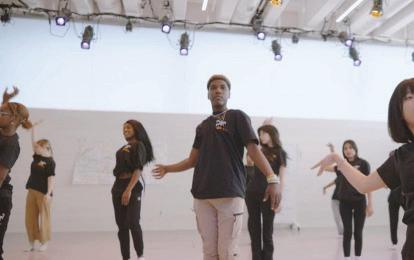
By Isabella Dail | Prospect Head Editor
By Natalia Diaz | Prospect Staff Writer
NATALIA DIAZ / THE DAILY PRINCETONIAN
The “Queen of the Night” piece in PUB’s recent show “chroma.”
COURTESY OF NICK DONNOLI Trenton Youth Dancers rehearsal.
Universities are scared of Trump. Princeton spoke out — and others should join us.
an attack on the principles of knowledge-seeking and First Amendment-protected free expression on every university campus.
In an alarming grab of executive power, President Donald Trump and his administration have targeted education, including universities.
The administration has frozen billions of dollars in research funding. It has revoked millions more. It has gutted the Department of Education. This is an assault on knowledge and on the ability to produce research that betters the nation and the world.
In the past two weeks, the federal government has turned its attacks on education to two of our peer institutions. On March 7, Trump cut $400 million in Columbia’s federal funding. On Wednesday morning, Trump froze $175 million in the University of Pennsylvania’s federal funding.
Last week, the Department of State unprecedentedly revoked a Columbia doctoral student’s visa because she allegedly participated in pro-Palestine protests on campus. Just a few hours later, Columbia graduate and activist Mahmoud Khalil, a lawful permanent resident, was detained by Immigration and Customs Enforcement — an agency without precedent to act in cases like these. These actions reflect the weaponization of federal force against university students,
These actions did not stop in Morningside Heights, just as they will not stop in University City.
Some institutions have been cowed by threats from the federal government. This acquiescence is dangerous. Complying with constitutionally contested directives before judges rule on their legality normalizes them. As Columbia’s example has taught us, even repeated concessions to the Trump administration won’t protect you. As an institution relatively insulated from financial shocks from the federal government, we have a unique responsibility to speak out. Even among the Ivy League, Princeton’s wealth, prestige, and historical reputation as the most conservative Ivy give the University unique influence.
Princeton has rightly stood behind its values by refusing to comply in advance. And, Wednesday morning, President Christopher Eisgruber ’83 stepped up to embody these values by speaking out in defense of higher education publicly in The Atlantic.
We commend President Eisgruber for finally stepping up in this way — doing so will encourage others to join us. But it is imperative that he follows through with the commitments he outlined. We will be wait-
The last time an alum was appointed to head the Pentagon, our community was all too happy to sing his praises. The alum, of course, was neocon darling Donald Rumsfeld ’54. Two months after 9/11, Princeton Alumni Weekly (PAW) peddled the mythos that Rumsfeld had come to command: a “wrestler, pilot, and organizer extraordinaire,” he would “lead the U.S. defense department into perhaps its toughest fight ever.”
Earlier this week, President-elect Donald Trump nominated Pete Hegseth ’03 to be Secretary of Defense. Hegseth, a combat veteran and Fox News host, is manifestly unfit to lead the U.S. military, often called the world’s most powerful. Hegseth’s threadbare résumé, his decorated service notwithstanding, is least among the mountain of reasons that should disqualify him.
Hegseth is part and parcel of the bone-chilling tide that triumphed at the ballot box last week. He has showered praise on Jan. 6 insurrectionists and lobbed racist insults against the nation’s highest-ranking officer, whom he promises to fire. He has demanded that the Pentagon bar women from combat and declared,
ing for the University to implement plans to defend academic research, pursue litigation against policies that jeopardize its vital functioning, and protect its other core values, like free inquiry, the well-being of all community members, and supporting individuals from diverse backgrounds. We hope to see these steps taken, and will proudly support the University when they are.
“Universities are independent centers of ideas and often prominent centers of dissent,” professors Ryan Enos and Steven Levitsky wrote last week in The Harvard Crimson. “Autocrats are allergic to sources of dissent, so they almost invariably seek to silence, weaken, or control them.”
The Trump administration has targeted some universities — and will continue doing so to others — not for their individual policies,
but because the free pursuit of knowledge threatens its power.
So individual efforts from any one institution will not be enough. Universities need to stand together. In response to anti-democratic action, working collectively is the only way to protect democratic principles. If the Trump administration uses its Columbia playbook with other universities, one at a time, each school will have to fight the federal government alone.
But as Princeton stands up first, it can invite others to stand with it. Through coordinated action and litigation, universities can show that they will never again fight the Trump administration’s attacks alone.
The Editorial Board disagrees about whether Eisgruber’s piece on Wednesday sufficiently established that commitment and when it is appropriate for students to
prescribe policy solutions to their university administration. But we agree with Eisgruber that universities must defend themselves, and we look forward to the public use of existing alliances with other universities to defend all of higher education.
We will stand behind President Eisgruber and his colleagues when they implement plans to protect their students, faculty, and independence.
Each school may fall when targeted alone, but we can endure when we stand united.
149th Editorial Board
Isaac Barsoum ’28
Raf Basas ’28
Frances Brogan ’27
Eleanor Clemans-Cope ’26
Preston Ferraiuolo ’26
Anna Ferris ’26
Ava Johnson ’27
Christofer Robles ’26
Bryan Zhang ’26
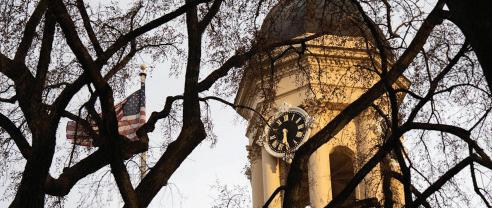
“the rules of war are for winners.”
During Trump’s first term in office, Hegseth successfully pressed him to pardon U.S. soldiers charged with war crimes.
No wonder Trump has demanded that the Senate forego hearings to vet his cabinet nominees. Hegseth exemplifies the fascistic cabal that will soon control the White House and Congress. It is hard to interpret his outrageous nomination as anything but the keystone in Trump’s drive to compel loyalty from his underlings — and to wield the military against his foes.
Presuming Hegseth glides to the Pentagon’s helm, what will we say about this member of our ranks? If history is any teacher, the answer does not inspire confidence.
Princeton had burnished Rumsfeld’s reputation long before he entered the Pentagon triumphant. I have argued that Nassau Hall tracked Rumsfeld’s rise — and he reciprocated in kind. As Rumsfeld made waves in Washington, Princeton gave him the Woodrow Wilson Award, its highest alumni honor, in 1985.
In his acceptance speech, Rumsfeld likened his start in politics to a Princeton reunion. Princeton dutifully recognized its ascendant son — who, right on cue, extolled the best damn place of all. In 2004, as he stood credibly accused of war crimes
and mere weeks after the first photos of torture at Abu Ghraib had leaked, Rumsfeld nevertheless enjoyed a “good reception” at his 50th reunion.
Princeton has likewise figured in Hegseth’s rise. As has been widely reported, Hegseth spent his undergraduate years publishing racist, misogynistic, and homophobic hate in The Princeton Tory. But for one example: he ran a Tory cover in 2002 that superimposed crosshairs over an owl, representing the Organization of Women Leaders (OWL). The table of contents shows the owl crumpled on its side — three bullet holes blown into its head and blood pouring forth.
Such provocations did not dissuade PAW from holding Hegseth in high esteem. In fact, PAW granted Hegseth — who had recently served a tour in Iraq — his own byline in 2006. He used the platform to argue, “contrary to conventional thinking inside the government and the military,” that the U.S. should deploy more troops.
In its Nov. 2007 issue, PAW included Hegseth in a feature about ROTC alumni who had served in Iraq and Afghanistan. The front cover? A photo of Hegseth, with camouflage and Princeton ballcaps arranged before him and a uniform and beer jacket draped behind. “Pete Hegseth ’03, with reminders of life as a former
soldier and alum,” the caption read.
A web exclusive accompanying the issue notes Hegseth “had just completed a year at Guantanamo Bay, doing security patrols.” Hegseth’s stint at the naval base — which houses the illegal torture camp that Rumsfeld helped create — had led him to question his service: “After the boredom of that assignment,” PAW confesses, “he thought he’d never want to put on his uniform again.” With respect to the torture of detainees and denial of due process at Guantanamo, Hegseth has claimed, “we bend over backwards as Americans to provide for the welfare of these radical Islamic terrorists.”
By PAW’s account, news of a suicide bombing in Iraq reignited Hegseth’s desire to serve. “I learned a lot of theory at Princeton,” Hegseth told PAW, apparently in reference to his Politics degree. “[N]one of it matters,” Hegseth cautioned, “if you cannot provide security. Guns and violence have the potential to override any theory, no matter how sound.” Talk about clairvoyance.
In 2018, Hegseth created a “Fox and Friends” segment about the James Madison Program (JMP), the campus hub for right-wing politics. The clip celebrates Robert George, Princeton’s conservative doyen and Hegseth’s former professor. As the segment closes, Hegseth
begins to say, “I’m proud of my—” but stops himself short. Instead of “alma mater,” he pivots: “the James Madison Program. Princeton doesn’t do everything right all the time, but Robby George does a nice job.” Despite the bonhomie, Hegseth has helped wage the right-wing assault on higher education. In a 2022 broadcast, Hegseth defaced his diploma from Harvard, where he had received an MPP. He crossed out “Harvard” and scrawled “Critical Theory” in its place. For good measure, he marred the parchment with “Return to Sender.”
Hegseth has, notably, declined to give his undergraduate diploma the same treatment. When someone on air advised, “Go grab that Princeton diploma,” Hegseth responded, “Not yet, not yet, not yet.”
Hegseth might still see utility in his alma mater. Does Princeton see the same in him? Will Hegseth get a hero’s welcome come reunions? Will he one day receive the Woodrow Wilson Award?
What is clear is that Hegseth imperils the very existence of our University — and the rule of law. Princeton must have no truck with him.
eton.edu.
Jonathan Ort ’21 served as The Daily Princetonian’s 144th Editor-in-Chief. He can be reached at jaort[at]alumni.princ-
CALVIN GROVER / THE DAILY PRINCETONIAN Nassau Hall.
Eisgruber’s empty defense of ‘academic freedom’
In response to the Trump Administration’s recent efforts to suspend $400 million in federal grants to Columbia University and $210 million to Princeton University, professors and administrators have rushed to the defense of “academic freedom.” In a recent op-ed, University President Christopher Eisgruber ’83 charged President Trump with launching “the greatest threat to American universities since the Red Scare of the 1950s.” At stake, he argues, is the notion that “people and ideas [should] be judged by scholarly standards, not according to the whims or interests of powerful trustees, donors, or political officials.”
What Eisgruber doesn’t consider, however, is that the threat to academic freedom comes not from the government but from the universities themselves. Rather than focusing on external threats, Princeton should turn the microscope inward and acknowledge the recurring problem of intellectual diversity in its ranks. Allowing faculty to write and research freely, although admirable on its face, ignores a deeper problem. Faculty might indeed be unencumbered by external threats, but they will be constrained, internally, by the ideas and methods incentivized by the academic monoculture in which they work.
Consider a few statistics. First, according to a 2020 study, Democratic registration of Princeton faculty outpaced Republican registration
by a staggering 40:1 ratio. Across the universities surveyed, the average was 8.4:1. When it came to donations, none of the surveyed Princeton faculty reported donating to Republicans. What’s more, a 2017 study found that between 1969 and 2014, the conservative-liberal ratio among American college and university faculty rose from just under 2:1 to just below 5:1.
Contrary to President Eisgruber’s assertions, there is little threat that future “left-leaning politicians may demand that universities do their bidding.” For all intents and purposes, the universities already do — and this is a problem that shows only signs of worsening.
A few years ago, then-professor Joshua Katz was ousted after a University investigation said he was not forthcoming about an inquiry into a consensual relationship with an undergraduate. But the circumstances under which the charges were brought — after he had made controversial comments about a student organization — raised doubts as to the University’s true motives. Moreover, Princeton violated the sacred tenet of professorial tenure in firing Katz, precisely meant to protect academic freedom. Elsewhere, Princeton departments have relentlessly pushed diversity, equity, and inclusion initiatives on their own faculty, with some including anti-racism or diversity statements on their websites.
This cultural problem has spread to the University administration’s decisions around the system of nocommunication orders — reserved for victims of sexual harassment and
stalking — which was allowed to be weaponized against Jewish student journalists trying to cover campus protests for my student publication, The Princeton Tory.
As long as they receive federal funding, universities cannot be as independent as they claim. James Madison, a member of the Class of 1771, warned in the Federalist Papers about worthless written demarcations of authority. The ideal of “independent academic institutions” may sound great in principle, but in a monocultural academic system tied incestuously to the federal government, such a promise is nothing but a parchment barrier. Indeed, now, universities also cannot expect to shirk public accountability for their commitment to progressive ideology. Universities should not pretend to be independent when they are not.
President Eisgruber’s response thus betrays an entitlement that only decades in academia can cultivate. The American people have little patience for institutions of higher education, especially given decades of cultural and economic preferentialism given to college graduates, years of discrimination in admissions practices, and months of destructive protests. They see their hard work being exploited to pay the debts of college graduates, watering the ivy of academia with the sweat of their brow. When institutions like Princeton betray their academic mission in pursuit of ideology, they break the social contract made with the American people, adding the insult of hypocrisy to economic injury.
HIn his article, Eisgruber exposes his own ideological bias by asserting that research universities exist to “challenge political power” and “overcome injustices.” In his 2025 State of the University letter, he writes that “diversity and inclusivity are essential to the excellence of our campus communities and the achievement of our educational mission.” Academic freedom, which exists to protect faculty in their pursuit of truth in teaching and research, has been appropriated to catechize university communities in the credos of diversity and identitarianism. Ideology threatens academic freedom because it narrows the scope of the ideas that will be entertained, disfavoring ideas not for lack of intellectual rigor but simply for ideological non-alignment.
Such a politicized conception of a university’s mission breeds disaster, especially in the sciences. During the COVID-19 pandemic, for example, the scientific establishment squashed the opinions of thinkers whose findings went outside the academic mainstream. Stanford health economist Dr. Jay Bhattacharya was ruthlessly shamed for his independent findings on the adverse effects of lockdowns, incurring the wrath of the scientific establishment and some in the Stanford faculty. Hoover Institution fellow Scott Atlas was censured by an 85 percent vote of the Stanford Faculty Senate for the crime of “promot[ing] a view of COVID-19 that contradicts medical science.”
America’s universities have an ideological problem on their hands, but their leaders refuse to admit any
wrongdoing nor propose any improvements. Rather than honestly and humbly justifying their work to the American people, administrators exploit their institutions’ successful pasts to maintain their current cultural standing. At the same time, like at Princeton, they attack the figures who contributed to the very prestige they now wield as a weapon. Until they either admit their actual intentions or reform their institutions to truly reflect the principles they claim to value, these universities should expect continued pressure from both the public and the federal government.
If President Eisgruber is right about one thing, it is that America’s universities have contributed mightily to its greatness. Many, like Princeton, were crucial to the nation’s founding, and they have proven crucial to its climb toward global leadership. But we cannot trust these institutions with prestige and public funding if they use them without regard for the people, and country, they claim to serve. If Princeton wants to regain the trust of the American people, it should start by ditching ideology and pursuing truth. Only then can true academic freedom flourish in its halls.
Zach Gardner is a junior majoring in Politics and minoring in English and History. He is the publisher of The Princeton Tory, the President of the Princeton Federalist Society, and the President of the Princeton Open Campus Coalition. He can be reached at zachgardner[at]princeton. edu.
Face it, Eisgruber is the man for the moment
Amendment scholarship, which has informed his leadership of Princeton.
Free Speech Right,” to be published in September.
igher education is in trouble. Princeton is in trouble. After Tuesday’s announcement that the federal government suspended some of Princeton’s research grants, it’s clear that we’re already in the crosshairs. At Columbia, after the university appointed an administrative official to oversee an academic department in acquiescence to Trump administration demands, it appears that the integrity of academic freedom is also under attack.
Many university presidents have chosen to remain silent in the face of this attack on academia. Others, such as Michael Roth ’84 GS of Wesleyan University, have explicitly vilified the Trump administration. Rather than taking an overtly political stance against the administration, University President Christopher Eisgruber ’83 has chosen to take a principled stand against the most troubling facet of the recent grant suspensions: their impact on academic freedom.
While support for one’s university president may not be common in the pages of a student newspaper, it’s time for Princetonians to realize that for years, Eisgruber has kept the University on the right course of free expression and academic freedom. He has arguably handled the issues of the past two years the best out of any of our peer institutions, and it’s important in this moment to stay his course.
Princeton has been a model of discourse in the Ivy League in major part because of Eisgruber’s leadership. Eisgruber, who is also the Laurance S. Rockefeller Professor of the Princeton School of Public and International Affairs and the University Center for Human Values, is one of our nation’s most esteemed constitutional scholars, with an immense repertoire of First
Under his tenure, barring a few notable critiques, Old Nassau has routinely ranked as one of the schools with the most robust protections for free speech, and overall has developed a culture of discourse respected by students and faculty alike. “Shouting down” speakers, routine at our peer institutions, is relatively rare at Princeton.
Even before the Trump administration’s recent attacks on academic freedom, there has been a crisis of discourse at America’s universities. The Foundation for Individual Rights and Expression (FIRE) which defends free speech on college campuses found that 63 percent of students are “frequently” or “sometimes” intimidated to share ideas that differ from their peers. Nowhere is this experience more pressing than our nation’s elite universities, such as at Harvard, where just this semester, a survey indicated that most students are uncomfortable sharing controversial opinions in class.
This phenomenon, however, has mostly escaped Princeton. The Daily Princetonian’s 2024 Senior Survey found that just 18 percent of graduating seniors felt very or somewhat uncomfortable sharing their political views on campus.
Eisgruber has prioritized fostering discussions on free speech, including adding programming to freshman orientation, exposing students to the importance of free expression during their very first days on campus. He has also notably championed Princeton’s policy of “institutional restraint.”
Eisgruber is one of the most senior elite university presidents, managing to retain his position while many peers have been forced out of their offices. To top it all off, he’s writing a book sharing his story of success: “Terms of Respect: How Colleges Get
And now, at the exact right moment, Eisgruber is speaking out in defense of universities, and doing it in such a way that highlights the value of academic freedom. Last week, Eisgruber published an article in The Atlantic pushing back against the government’s attempt to chip away at academic freedom, and reaffirmed his views a few days later in a PBS interview. After Tuesday’s funding freeze announcement, he also appeared on Bloomberg Business’s “Big Take” podcast to maintain his defense of academic freedom.
But some of our fellow students have expressed their discontent with Eisgruber’s approach. During a Council of the Princeton University Community meeting last week, a student demanded that Eisgruber commit to using his position as chair of the Association of American Universities to “defend all members of the University community from the recent Trump administration attacks on free speech, funding cuts and threats for deportations.”
Eisgruber deflected in response, affirming the importance of speaking about the good of universities but rejecting the idea of directly opposing administration officials. This is, again, a prudent strategy: the administration’s response would trounce the University. If Princeton were to do what the activists ask and look for a fight with the executive branch, Princeton would lose. A single university is certainly no match for the awesome power of the federal government.
In this critical moment for higher education, we implore our fellow students to unite behind President Eisgruber, instead of undermining his efforts to keep us on the right course. Eisgruber is right in saying that we must follow the law while also defending our academic freedom and due process. When Columbia faced funding freezes, little was said by their president before they announced measures implementing all of the Trump administration’s demands. Conversely, on Tuesday, Eisgruber declared that “we have to be willing to say no to funding if it’s going to constrain our ability to pursue the truth.”
We do not envy Eisgruber’s job. But the fact that he has continued to voice his commitment to academic freedom and the strength of the American university is commendable. In a time when Princeton and higher education are under fire, we ought to be uniting against the threats and supporting the academic freedom principles that Eisgruber has championed. Princeton’s commitment to truth requires discourse. Protection of these sacrosanct values have been fundamental to Eisgruber’s philosophy of the presidency. We should be supportive.
Jerry Zhu is a sophomore majoring in Economics. He serves as the community Opinion editor of The Daily Princetonian, and encourages you to submit a response to this piece or write an op-ed for the ‘Prince.’ You can reach him at jfz[at]princeton.edu.
Preston Ferraiuolo is a junior from Brooklyn, New York. He is an associate Opinion editor majoring in the School of Public and International Affairs and can be reached at prestonf[at]princeton.edu or online @NYCPreston.
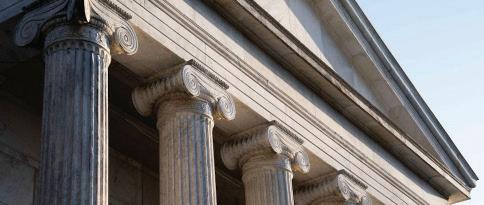
Jerry Zhu & Preston Ferraiuolo Community opinion editor
Zach Gardner Guest Contributor
Secretary of Defense Pete
Hegseth ’03 ‘plagiarized’ small portions of his senior thesis, experts say. But how serious is it?

By Sena Chang
“After Card’s whisper, Bush looked distracted and somber but continued to listen to the second-graders, joking that they ‘read like sixth-graders,’” reads the senior thesis authored by Pete Hegseth ’03, now the U.S. Secretary of Defense.
This sentence is notable for recapping the precise moment
President George W. Bush was informed of the 9/11 attacks. But it is also notable because it is nearly identical to one published by The Washington Post in 2001, two years before Hegseth wrote his thesis.
“After Card’s whisper, Bush looked distracted and somber but continued to listen to the secondgraders read and soon was smiling again. He joked that they read so well, they must be sixth-graders,” the story in The Post reads.
The article is not cited in Hegseth’s paper.
A review of Hegseth’s thesis by The Daily Princetonian, in consultation with three experts on plagiarism, found eight instances of uncredited material, sham paraphrasing, and verbatim copying. But while the three experts all said that the passages violated Princeton’s academic honesty regulations, they differed on whether the violations were serious or too minor to matter.
“There’s no silver bullet here; there’s no smoking gun in terms of a deep example of plagiarism,” James M. Lang, the author of “Cheating Lessons: Learning from Academic Dishonesty,” told the ‘Prince.’ “It’s a borderline case.”
Spokespeople from the Department of Defense did not respond to multiple requests for comment from the ‘Prince’ prior to publication. Following the publication of this article, Chief Pentagon Spokesperson Sean Parnell provided a statement to Konstantin Toropin, a reporter for military. com.
“Secretary Hegseth has written five books. He’s written hundreds of papers and op-eds. During the confirmation process, every word was reviewed by top leftwing law firms working in con-
junction with every media outlet in the country. They found no plagiarism because there was no plagiarism,” Parnell wrote. “This is a fake story designed to distract from the DoD’s historic accomplishments under President Trump and Secretary Hegseth’s leadership.”
The ‘Prince’ requested a digital copy of the 90-page thesis, submitted on April 8, 2003, from the Mudd Manuscript Library, which generally makes senior theses available to anyone with a Special Collections research account. The senior thesis represents the capstone of the Princeton undergraduate experience and is a graduation requirement for almost all students.
Entitled “Modern Presidential Rhetoric and the Cold War Context,” Hegseth’s work, submitted to the Department of Politics, analyzes the evolution of presidential speeches from the Cold War to the War on Terrorism. His paper argues that modern presidential rhetoric is largely influenced by prevailing global threats, such as the Soviet Union during the Cold War and Al-Qaeda following 9/11.
An analysis of Hegseth’s thesis through several publicly available plagiarism detection models flagged a total of 12 passages spread out throughout the paper.
To further evaluate the passages, the ‘Prince’ consulted three experts in plagiarism research and copyright who have previously analyzed prominent cases of plagiarism involving politicians or have conducted extensive research on academic integrity. All reviewers assessed the thesis without prior knowledge of the author’s identity.
That manual review found eight instances of uncredited material, sham paraphrasing, and verbatim copying, according to the three experts. The four other passages that they flagged, the experts said, were not deemed to be of significance on a standalone basis, but fit a broader pattern of some form of plagiarism.
While the three experts said that all eight passages violate Princeton’s Rights, Rules, Responsibilities, a set of policies and procedures that govern academic
nists,” Reeves writes.
Lang views the Kennedy sentence as a serious case of plagiarism. “We’re talking 10 or 12 words here … that’s the kind of thing that would raise a flag for me,” he said.
But Bailey does not view this passage, or any of the other seven passages, to be particularly egregious. “Even the ones that were more direct still typically only involve a sentence or two at a time,” Bailey said.
The three experts who reviewed the thesis passages at the request of the ‘Prince’ did, however, unanimously agree that Hegseth’s writing violated Princeton’s Rights, Rules, Responsibilities, which they all agreed contains stricter rules regarding unattributed copying.
Similarly, a New York Times article about the evolution of the State of the Union from February 2003 — more than two months before Hegseth’s thesis was submitted — reads: “The credit for that transformation goes to Mr. Reagan, who signaled the new order in 1982 when he pointed to the gallery to honor Lenny Skutnik, the man who had dived into the icy Potomac to save a woman after a plane crash.”
In his thesis, Hegseth cited the article in a footnote, but did not wrap the text in quotation marks or indent it beyond the regular margin.
integrity and other elements of undergraduate life, they agreed that not all of the instances could be defined as serious plagiarism.
In recent years, writing from public figures spanning Princeton professor Kevin Kruse, former Harvard president Claudine Gay, and Supreme Court Justice Neil Gorsuch has been accused of containing copied or improperly cited or paraphrased text. Journalists, academics, and plagiarism experts have all raised concerns about the growing use of plagiarism allegations as a political weapon in recent years.
“This is very similar to other allegations we’ve seen over the past year and a half or so,” said Jonathan Bailey, who runs the website Plagiarism Today and helped review Gay’s papers for The New York Post.
‘More gray than black and white’
Achieving a consensus on the definition of plagiarism at large is challenging. The three experts interviewed by the ‘Prince’ differed on which passages amount to serious plagiarism and which are too minor to matter.
“I definitely see more gray than black and white here,” Lang said. In his view, about half of the examples constitute a form of serious plagiarism, while the other half seem to be minor violations of Rights, Rules, Responsibilities.
A passage Lang believes constitutes serious plagiarism appears in a section discussing Kennedy’s speeches during the Cold War.
“Kennedy, who had just given a speech about the need for peace, got carried away and just adlibbed the opposite, saying there was no way to work with the Communists,” Hegseth wrote, using phrases identical to what appears in Richard Reeves’ book “President Kennedy: Profile of Power.”
While Reeves is cited in the paper, including for that particular sentence, no quotations accompany the seemingly identical text.
“In his enthusiasm, Kennedy, who had just given a peace speech and was trying to work out a test ban treaty with the Soviets, had gotten carried away and just adlibbed the opposite, saying there was no way to work with Commu-
“Under the definitions provided by Princeton’s Rights, Rules, and Responsibilities, it is plagiarism,” Guy Curtis, a researcher at the University of Western Australia who studies academic integrity, told the ‘Prince,’ referring to the body of 12 examples he reviewed. Curtis’s research has been widely cited by scholars in the United States and across the globe.
“Once you get 10 to 15 words in a row by ‘accident’ that happens to correspond with something else — it’s probably not accidental,” Curtis added.
Lang agreed: “It’s definitely a violation of Rights, Rules, and Responsibilities — there’s no question about that.”
Section 2.4.6 of Princeton’s Rights, Rules, Responsibilities stipulates that “any quotations, however small, must be placed in quotation marks or clearly indented beyond the regular margin. Any quotation must be accompanied (either within the text or in a footnote) by a precise indication of the source — identifying the author, title, place and date of publication (where relevant), and page numbers. Any sentence or phrase which is not the original work of the student must be acknowledged.”
On paraphrasing, 2.4.6 states that “any material which is paraphrased or summarized must also be specifically acknowledged in a footnote or in the text.”
Furthermore, Section 2.4.7 establishes plagiarism and false citation as academic violations under the Faculty-Student Committee on Discipline (as opposed to the Honor Committee, which covers in-person examinations).
“If even one phrase is good enough to borrow, it must be properly set off by quotation marks,” Section 2.4.9 reads. All three of these regulations for undergraduates were also present in the version of Rights, Rules, Responsibilities from when Hegseth graduated in 2003.
Hegseth’s thesis also features at least one instance where the source is cited, but the verbatim text is not enclosed in quotation marks.
In a section discussing the impact of television on political rhetoric, Hegseth wrote, “During the speech, Reagan signaled the new order when he pointed to the gallery to honor Lenny Skutnik, the man who had dived into the icy Potomac to save a woman after a plane crash.”
Though it may seem that including a citation would lessen the severity of the example, Curtis noted that the presence of a footnote may actually make the situation more troubling.
“In some of the instances in this senior thesis, there’s a footnote pointing to a reference, but no quotation marks for material that is, in fact, a verbatim quote. That suggests that the person knows what they were supposed to have done, because there’s sections in quotation marks elsewhere done correctly,” Curtis explained.
While Rights, Rules, Responsibilities does not take intent into account, Lang and Bailey noted that it would be important to distinguish whether Hegseth’s actions were purposeful or accidental.
“But the question is: Was the intent there, and is it more irresponsibility than it is a deliberate effort to engage in an act of cheating?” Lang said.
According to Lang, the examples appear to indicate a “pattern of irresponsibility” rather than a deliberate attempt to mask another’s work as one’s own, which would carry more serious implications.
“To answer the question of whether it violates Rights, Rules, and Responsibilities, it obviously does,” Bailey said. But, he added, “Plagiarism is an umbrella term covering everything from just a few sentences to wholesale copying of an entire work.”
‘The dark ages of academic plagiarism’
In recent years, a number of works from the mid-1990s to mid2000s have faced scrutiny for plagiarism. Among them, a section in Supreme Court Justice Neil Gorsuch’s 2006 book on euthanasia included alleged instances of plagiarism. Former Harvard President Claudine Gay’s Ph.D. dissertation was written in 1997 and faced immense scrutiny in January 2024.
Gorsuch’s publisher, Princeton University Press, did not retract the book. Gay, on the other hand, requested multiple corrections after allegations initially surfaced.
Bailey termed this period between the mid-to-late 1990s to the early 2000s as “the dark ages of academic plagiarism,” when the internet became publicly available and detection software was limited.
“At that time, there was a mix of cheating typically happening both with internet sources and also, [with] people going to the library and actually copying things right out of books,” Lang
GRAPHIC BY MALIA GAVIOLA / THE DAILY PRINCETONIAN. PHOTO FROM “PETE HEGSETH” BY GAGE SKIDMORE / CC BY-SA 3.0
said.
Princeton, however, maintained clear, rigorous standards for educating and enforcing proper citation and attribution practices in the early 2000s.
Hegseth’s thesis was written for the Department of Politics and supervised by Patrick Deneen, who was an assistant professor before he left Princeton in 2005. Deneen is now a professor at the University of Notre Dame. Deneen wrote in a statement to the ‘Prince’ that he had “no specific recollection” of Hegseth’s thesis, including its content, methodology, or final grade, citing the volume of advisees — usually about a dozen per year — he supervised in the early 2000s.
“There was little time that could be expended on any specific thesis,” Deneen recalled.
Deneen added that juniors in the Politics department were mandated to take a seminar that “covered various research methods and, I believe, academic ethics and standards that would include appropriate use of sources and proper methods of citation.”
Moreover, Princeton’s 2003 version of Rights, Rules, Responsibilities, which reads nearly wordfor-word in the relevant passages around academic integrity as its current version, maintained a firm definition of plagiarism, including protocol for citing electronic sources.
“The requirement to acknowledge sources is not limited to printed material such as books or journal articles,” the 2003 version reads. “At a minimum, acknowledge any information, text or image from the World Wide Web by noting the name and author of the site (if available), the internet address, and the date you accessed the site.”
“In my experience, faculty, including myself, took enforcement of academic standards with utmost seriousness,” Deneen wrote. While Deneen said that not every submission was closely examined for academic dishonesty, he wrote that “high standards were articulated as an institutional norm; suspected transgressions were seriously investigated; and, if warranted, consequential sanctions were handed down.”
“Over the course of my career, Rights, Rules, [Responsibilities] was fairly strictly interpreted, and I would say, narrowly interpreted,” Stanley Katz, a lecturer emeritus of public affairs and history who assisted students accused of violating disciplinary rules throughout the early 2000s, told the ‘Prince.’ Katz added that students caught plagiarizing during this period faced a one-year suspension and a permanent note on their transcript.
On the final page of his thesis — as required by all academic work submitted to the University — Hegseth wrote, “This paper represents my own work in accordance with University regulations” and signed his name.
Even so, in other parts of the paper, Hegseth appears to paraphrase cited texts, but the paraphrased content is identical to a different internet source.
Summarizing David Chidester’s book “Patterns of Power,” Hegseth wrote, “The first, touted by David Chidester, in his book Patterns of Power, argues that Reagan advocated a particular form of ‘American Civil Religion’ in which the state represented that transcendent, supreme power for which individuals in the modern world would be willing to make the ultimate sacrifice.”
While Chidester is cited, the majority of the text appears to match verbatim from a 1995 internet article by John R. Anderson, where
Anderson writes, “According to David Chidester, in his book, Patterns of Power, Reagan advocated a particular form of ‘American Civil Religion’ in which the state has come to represent that transcendent, supreme power for which individuals in the modern world would be willing to make the ultimate sacrifice.” Anderson is not cited in Hegseth’s thesis.
Hegseth’s thesis also contains verbatim matches of sentences from other internet sources, such as the New York Times article on the State of the Union introduced earlier.
Bailey noted that plagiarism has often been used to fuel politicallymotivated attacks, such as those involving Kruse’s 2000 dissertation at Cornell. Plagiarism allegations against Kruse were raised by conservative historian Phillip Magness.
“[Kruse] was picked because he was called ‘History’s Attack Dog,’” Bailey said. “This was a very political plagiarism scandal,” he continued, citing Kruse’s critiques and corrections of right-wing arguments and his contribution to The New York Times’ 1619 Project. According to Kruse, the University concluded that his actions “did not constitute a violation of the research misconduct policy.”
Curtis emphasized the importance of context in learning from borderline cases.
“In higher education, young people are often working under pressure, and that pressure can bring about errors of judgment or mistakes,” Curtis explained. When students first get caught, Curtis said that “systems to deal with suspected academic misconduct should provide students with due process, be educative, and give them the opportunity to learn from their mistakes.”
Deneen, Hegseth’s advisor, said that he generally relied on his students to correctly represent their work.
“I expect that I was like most professors in generally assuming that submitted papers, theses, and exams solely reflected the work of students, unless there was some warrant in the work that required further investigation,” he wrote to the ‘Prince.’
There is little to no precedent for addressing undergraduate Rights, Rules, Responsibilities violations that are discovered after graduation. In a first for Princeton, an alumnus’s Ph.D. degree was revoked following the discovery of extensive plagiarism in 1990. While the Graduate School’s regulations caution that violations could result in “revocation of the degree” for alumni, the undergraduate version of Rights, Rules, and Responsibilities makes no mention of consequences following graduation.
Whether the offending passages in Hegseth’s thesis were the result of academic sloppiness or a simple oversight, Bailey said that they likely do not merit institutional action now. These instances are “not particularly serious and probably warrant a relatively mild response,” he said.
Bailey continued, “This doesn’t fit the pattern of someone who went into this deliberately, maliciously trying to plagiarize their way to finishing it. This seems like it was just poor writing techniques and poor methodology.”
Sena Chang is a senior News writer for the ‘Prince.’ She typically covers campus and community activism, the state of higher education, and alumni news.
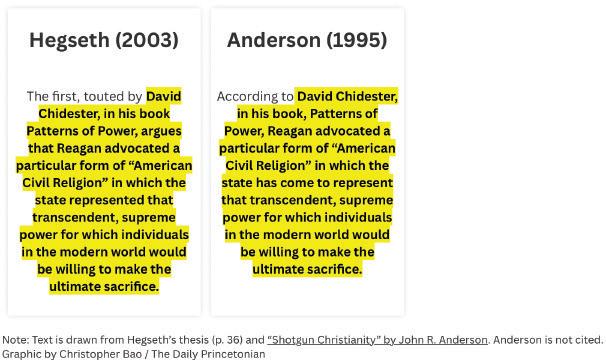
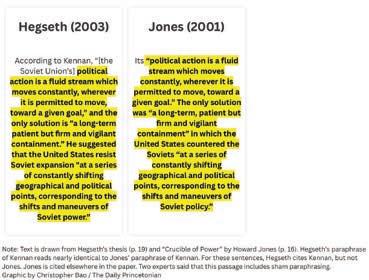
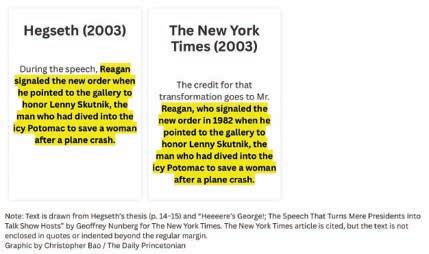
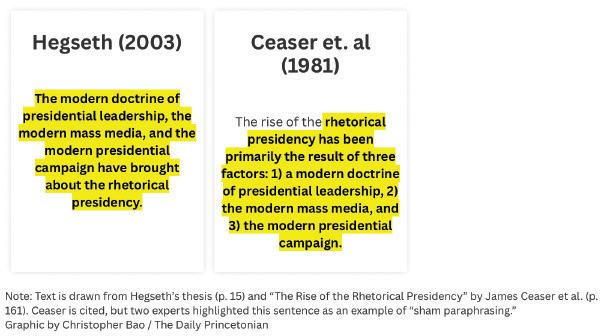
‘An existential crisis’: The faculty research stopped after research grants suspended
By Luke Grippo Senior News Writer
Professor of Civil Engineering Peter Jaffé began researching industrial cleaning chemicals 20 years ago. In 2016, he decided to focus his research on developing ways to biodegrade perfluoroalkyl and polyfluoroalkyl substances (PFAS). These chemicals are widely used in everyday consumer and industry products — although we are also exposed to them in our food, water, and air. Dubbed “forever chemicals” for their non-degradability, PFAS can weaken the immune system, increase risk of cancer, and cause other health concerns in humans.
Three years later, the Department of Defense (DOD) took an interest in Jaffé’s work and began funding his research. According to the Environmental Working Group, an American activist group focused on agricultural industry research and advocacy, there are over 723 military sites in the U.S. and U.S. territories that are contaminated by PFAS.
After six years of federal funding, Jaffé says that he and his team have found a way to biodegrade these chemicals. An almost $2 million grant for a field demonstration was the next step. However, this funding was lost on April 1, when several dozen grants awarded to University researchers from NASA, the DOD, and the Department of Energy (DOE) were suspended, reportedly worth at least $210 million.
“We have done a lot of work showing that we can biodegrade these PFAS,”
Jaffé told The Daily Princetonian in an interview. “The University has a series of patents out on it, and we need that field demonstration to get people to believe that it works and invest in them [and then] apply it.”
Now, Jaffé is unable to conduct that field demonstration. In the blink of an eye, the work Jaffé had been working on for 20 years has vanished — unless something changes soon, he remarked.
Jaffé is not the only professor who is affected by the freeze. In the wake of the grant suspensions, many professors have been thrown into disarray, worried about how they will be able to pay their researchers and continue their research — research that is changing the world, they say.
Professor of Civil and Environmental Engineering Elie Bou-Zeid, who lost a DOE grant, wrote to the ‘Prince’ that he believes professors across the country are being directly attacked.
“This is a deliberate attack to weaken and even permanently harm universities like Princeton,” Bou-Zeid said. “As academics, we should have no illusion that this is a misunderstanding or an accident. We are not ‘bystander victims.’ We are the target.”
Several professors said that the University had stepped in to cover expenses for professors and graduate students.
Chemistry professor Roberto Car had a DOE grant supporting the Computational Chemical Science Center (CCSC) suspended. The grant had partly or fully
ON CAMPUS | MAY 2025
supported five graduate students and five postdocs.
“In the end, the University will come as a helper of last resort — they will essentially guarantee that the postdocs can stay until the end of their current term, and for the PhD students, they will stay until completion of their thesis,” Car said.
“The University is saying, for the moment, ‘let’s use what resources we do have to support people, and in particular, people more at the junior level, which means often graduate students, whose stipends are coming from these grants, and postdoctoral researchers and junior faculty members,’” Michael Strauss, the Chair of the Department of Astrophysical Sciences, said.
Students, Jaffé summarized, “will be able to get through.”
Physics professor William Jones wrote in a statement to the ‘Prince’ that his group is currently developing a polarimeter — a device that measures the re-orientation of light waves — named Taurus that will “measure fluctuations in the cosmic microwave background.”
This project is directly funded by NASA and would fly on a NASA stratospheric super-pressure balloon.
The grants Jones and his student team were receiving helped the group develop highly sensitive detectors known as quantum limited superconducting transition edge sensors, which are integral to Taurus’ functions.
The award was apparently suspended with no explanation by the Department
Princeton asks departments to make plans for ‘permanent’ budget cuts
By Christopher Bao & Annie Rupertus head News Editors
Princeton asked all departments and University units to prepare “separate plans for 5 percent and 10 percent permanent budget cuts to be phased in over the next three years, with some actions to start later this summer” in an email sent to faculty and staff on Monday afternoon — the University’s most dramatic budgetary guidance yet following a tumultuous semester for higher education.
The email, sent by Provost Jennifer Rexford and Executive Vice President Katie Callow-Wright, explicitly acknowledged the potential for layoffs to be part of budget reductions. “Cuts of this magnitude to our budget cannot be achieved without changes to some operations and the associated elimination of some staff positions,” they wrote.
Rexford and Callow-Wright previously said in March that the University would pause most faculty searches until the 2025–26 school year and avoid staff growth, while asking departments and units to find ways to cut down on costs.
Now, they wrote, faculty searches will face “continued limits” next school year, and most staff hiring will be frozen. However, the University is not currently anticipating major reductions in existing staff, Rexford and Callow-Wright said.
“We are not currently planning an acrossthe-board reduction in staff, and our goal is to minimize layoffs, in part by using unfilled vacancies as a bridge to natural attrition,” they wrote. Some essential positions may be filled after new budgets are approved this summer.
“The entire U.S. higher education community is at profound risk,” Rexford and CallowWright warned, citing cuts to federally funded research and a proposed increase on an endowment tax. However, they cautioned that budget plans were still being finalized, and that “the ultimate scope of reductions depends on factors we still don’t know, such as the severity of government cuts to federal research funding and increases to the endowment tax.”
“Princeton is in some ways better positioned for a structural change to our economic model because we are less financially dependent on the federal government than are some of our peers,”
they added. “But we are also more exposed, since we rely on our charitable endowment to cover more than two-thirds of our expenses.”
Princeton previously enacted universitywide layoffs during the financial recession in 2009, eliminating 43 positions.
The memo from Rexford and Callow-Wright comes as House Republicans are reportedly mulling a substantial tax increase on large university endowments as part of a major tax bill set to be debated in Congress later this week. The Trump administration also suspended $210 million in federal research grants to Princeton in March.
In response, University President Christopher Eisgruber ’83 took to several national media outlets to advocate for the importance of federal research funding while maintaining academic freedom for researchers.
Earlier this month, Princeton launched a “Stand Up” campaign earlier this month asking alumni to advocate for higher education. An email newsletter for the campaign sent on Thursday asked alumni to call their representatives to advocate against an increased federal endowment tax.
Unlike some peer institutions, including Harvard and Columbia, Princeton has not yet received any specific demands from the federal government.
Today’s memo also outlined some items that would not be impacted by the planned changes to the budget. While merit-based salary increases are set to return to the “prepandemic norm,” Callow-Wright and Rexford wrote on Monday that approved salary merit increases would not be rescinded or reduced.
“Our priorities are to preserve Princeton’s excellence in teaching and research, defend our academic freedom, and maintain the affordability of a Princeton education to people from all socioeconomic backgrounds,” they wrote.
Christopher Bao is a head News editor for the ‘Prince.’ He is from Princeton, N.J. and typically covers town politics and life.
Annie Rupertus is a head News editor emeritus for the ‘Prince’ from Philadelphia, Penn. who often covers activism and campus governance.
of Government Efficiency (DOGE), Jones said.
“Our NASA program officers are not able to provide us any information about the reason or procedure,” Jones wrote.
Jones also explained that should his grant be reinstated, the group might have already missed their best opportunity to launch Taurus. “These launches are only offered every two years, so missing that date would devastate our students and researchers, not to mention our budget,” Jones said.
Strauss also said that there was significant funding lost from the Department of Energy intended for fusion energy development.
“There seemed to be little rhyme or reason other than it was connected to Princeton,” Strauss said.
The suspension of some grants have had a ripple effect in certain research centers.
Chemistry professor Gregory Scholes wrote to the ‘Prince’ that he lost a grant that supported BioLEC, a center whose goal is “to work out ways of producing energy-rich feedstocks that will give America an economic advantage,” according to Scholes.
“There are many impacts on researcher training, potentially losing expertise for complex experiments, or falling behind other countries at the leading edge of a fast-moving field,” Scholes added. “I’m hopeful that the situation will be resolved soon.”
Jaffé expressed his sentiment to the
‘Prince’ that he and his team will continue to fight for their research. “We have some momentum left. We have our cultures. We have done something.”
“It’s not that we abandoned overnight,” he said.
Gabriel Vecchi, a geosciences professor, had climate research impacted by the Department of Commerce’s decision last week to end $4 million in funding to climate research at Princeton.
“Our goal is to minimize any impact on the scholarly progress, education, and career development of … our team,” Vecchi, the Knox Taylor Professor of Geosciences and head of the Vecchi Research Group, wrote to the ‘Prince.’ “I know that our work is valuable to the world and the United States of America.”
While much remains uncertain, professors said they had an urgent need for assistance.
“We’ve managed to develop a full technology,” Jaffé said. “The trouble is, the longer we wait, the more we lose the expertise in the lab … then we lose the know-how.”
“This was 20 years worth of different grants and works and discovery and build-up to get finally out the door, and being this close to end, and it’s being killed. It hurts,” he said.
Luke Grippo is a senior News writer and Features contributor for the ‘Prince.’ He is from South Jersey and usually covers administrative issues, including Undergraduate Student Government, the Council of the Princeton University Community, and institutional legacy.

INTERESTED IN STUDYING ARCHITECTURE AT PRINCETON?
The first in a series of design studios offered to students, ARC 204 explores ideas about space and form through a sequence of projects and representational techniques.
ARC 206 introduces the significance of geometry in architectural design and construction. Learn by doing: participate in drawing and modeling exercises to construct and analyze forms, understanding and evaluating digital representation’s capacity for engaging with material composition.
Direct questions to soaprograms@princeton.edu

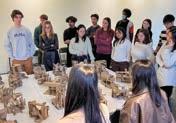

In Bloomberg interview, Eisgruber signals that Princeton will not make concessions
By Devon Rudolph & Christopher Bao Associate & Head News Editors
University President Christopher Eisgruber ’83 signaled that Princeton would not make concessions to the federal government in an interview with Bloomberg after news broke that the Trump administration had suspended dozens of the University’s research grants.
“I’ve heard you speak about efforts by powerful actors — in government and outside it — who are trying to control the research that scholars do and the classes they teach. How difficult is it to keep a firewall up, keep insulation surrounding this campus, to keep those ‘powerful actors,’ as you put it, out of the classrooms, out of the campus itself?” David Gura, the Bloomberg reporter, asked.
“I think it requires a very firm commitment to principle and a willingness to do hard things. University presidents and leaders have to understand that the commitment to allow academics — including our faculty, including our students — to pursue the truth as best they see it is fundamental to what our universities do,” Eisgruber responded. “We have to be willing to stand up for that. In principle, we have to be willing to speak up, and we have to be willing to say no to funding if it’s going to constrain our ability to pursue the truth.”
Eisgruber announced in a campus-
wide email earlier on Tuesday that the Trump administration suspended dozens of grants to the University from several agencies, including the Department of Energy, NASA, and the Department of Defense. CNN reported later in the day that, according to the White House and the Department of Education, the Princeton’s grants were suspended pending an investigation into antisemitism on campus. The exact amount paused is unclear.
During the 40-minute interview, Eisgruber acknowledged that there were “rare” manifestations of antisemitism on Princeton’s campus, and he said the University would address “legitimate concerns where they exist.” But he also strongly defended a university’s duty to foster speech.
“We have to stand steadfastly against antisemitism and other forms of hate, but we do that at Princeton through anti-discrimination principles that are broad and that do not incorporate specific definitions of particular kinds of discrimination,” Eisgruber said in the interview, which was conducted in the Mathey Common Room.
In the past few months, once-rare public statements from Eisgruber have increased in frequency as Trump turns up the heat on higher education. In an article in the Atlantic last month, Eisgruber condemned the Trump administration’s cancellation of hundreds of millions of dollars to Columbia University. He reiterated his
ON CAMPUS | MARCH 2025
thoughts during a PBS interview after Columbia announced it would meet the administration’s demands. Now, however, the crosshairs are aimed at his own university.
Eisgruber also said in the Bloomberg interview that the pauses to grants would “undermine our ability to attract talent, and it will make us weaker as a country.”
“A very constructive partnership that’s existed for about 70 years now between American universities and the American government — all that is in danger right now,” he said.
Eisgruber also came close to criticizing Columbia University’s capitulation to federal funding cuts.
“There are other people who urge, ‘Well, are there other ways that you can accommodate the government in some way, or bend to the government’s policy preferences in order to restore funding?’ I think that’s the wrong way, at least, for an academic institution, to be thinking about what its responsibilities are,” he said.
Eisgruber also addressed what the University’s next steps would be.
“If government funding were to go down, we and others would look for other sources that we could use to support the funding to the research that has to take place on our campuses,” he said. “We would look for things that we could stop doing. There would be a real cost to that, because I’m proud of what we’re doing on the campus. We would try to raise other funds.”
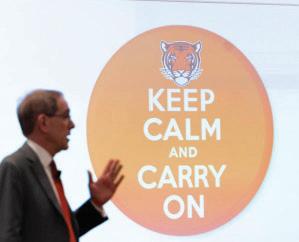
Eisgruber also broached the topic of examining the endowment, an approach to which he was previously very reticent.
“We would look at ways to potentially reallocate endowment funding, which would involve very difficult choices, but at the end of the day, what would happen here and elsewhere is that less research would get done, and that would be a bad thing,” he said.
Eisgruber also emphasized the need for universities to act together
in response to governmental funding cuts.
“I think it’s important for universities to stand shoulder to shoulder as we go forward,” he said.
Devon Rudolph is an associate News editor and staff Sports writer for the ‘Prince.’
Christopher Bao is a head News editor for the ‘Prince.’ He is from Princeton, N.J. and typically covers town politics and life.
Students in SINSI, other programs forced to pivot after federal government pulls internships
By Luke Grippo Senior News Writer
Bethany Suliguin ’27 was eating dinner before a rehearsal for the Sympoh dance show “Jailbreak” when she received an email from the National Institute of Health (NIH) that the agency would not be conducting internship interviews or extending offers.
Suliguin had already received an offer to conduct research at the NIH Clinical Center. But she learned just three weeks later that the NIH would not be able to take her as a paid summer intern, or even a volunteer. Now, Suliguin will be conducting research at a lab at Yonsei University in Korea.
In the wake of a federal hiring freeze and broader turmoil in the federal government, many students are having to rethink their summer internship plans.
Among those most affected is the Scholars in the Nation’s Service Initiative (SINSI). Each year, this competitive initiative offers an internship program to six to 10 undergraduates in the School of Public and International Affairs (SPIA), each of whom are personally advised by the SINSI director in finding a summer internship in public service. SINSI also offers a graduate program for first years in the Master of Public Administration (MPA) degree program, where accepted students go on to conduct two years of service in a federal program and return to Princeton for another year to complete their MPA.
Internship acceptances had not yet been extended, so while SINSI students did not lose already-offered positions, they were forced to pivot to different government and service internships, as many they had applied to had been cancelled.
On Jan. 20, the day of the hiring freeze, Samuel Kligman ’26 received around 10 to 15 emails from various agencies through USA Jobs, the federal government’s job application portal. He was notified that the opportunities he had applied to had either been canceled or would no longer be offered.
“That was definitely a difficult day … [I] had to adopt a glass halffull mindset,” Kligman told The Daily Princetonian. He is currently in the process of looking for another internship.
SINSI Director Gregory Jaczko has also had to pivot.
“This year, because there have not been as many opportunities in the federal government for internships, we have looked primarily to state and local governments, as well as multinational governments for internships,” Jaczko said.
Referring to organizations like the United Nations, the World Bank, and the International Monetary Fund, Jaczko said that SINSI will be “working, certainly, to establish relationships with those organizations so that students that have an interest in international development and international relations have an opportunity in some of these other organizations.”
Jaczko also shared that “the defense and national security areas don’t seem to be as strongly impacted by the hiring freeze. In fact, the original executive order excluded a lot of defense and national security apparatus, which is not atypical … We have interns who will likely go to the Department of Defense [DOD], for instance.”
Michelle Miao ’26, who initially sought to apply for a position in the Department of Housing and Urban Development (HUD) or the
Department of Justice (DOJ) Civil Rights Division, is among those looking at the DOD for internships.
Miao is a former staff News writer for the ‘Prince.’
In addition to the DOD, Miao will now also be searching for internship prospects at the Department of Homeland Security for a “valuable summer experience.”
“The agencies still functioning normally are the Departments of Defense and Homeland Security. It’s worked out nicely because I’m also interested and have experience with foreign policy and security,” Miao stated.
Thomas Emens ’25, who will be a graduate fellow for SINSI, shared with the ‘Prince’ that the internship he did last year at the Department of Energy no longer exists.
“I’ve been in touch with people I used to work with in the Department of Energy. My supervisor is still there, but [for] people within the Community Jobs and Justice team, two have left under Trump, and the others were reassigned,” Emens said. “An opportunity to do an internship again with that particular team in that particular office won’t be available.”
Emens expressed that he believes this event may allow SINSI to “grow and broaden its focus.”
“There’s a real need across the country for people that have invested all of themselves in service that want to make a genuine difference, and there’s a big need for that at the sub-national level, at the state level, and the local level,” he explained. “Hopefully, the silver lining in all this could be: SINSI [fellows] are going to be making a difference in places where they otherwise wouldn’t go.”
Jaczko shared a similar optimistic outlook. “It’s given SINSI a stronger motivation to reach out
and establish relationships with some of these other organizations that we have not traditionally had interns or fellows serve in, in order to give them new opportunities, and then potentially to provide a new pathway for students in the SINSI program.”
Olin Zimmet ’26, a SINSI scholar who will be working with the Alaska state government, believes that students who want to work in service will adapt, regardless of where they work.
“I think that I will get so much out of this state-level stuff. And I think the same of my six colleagues — whatever they’re doing, they’re going to do some wonderful things,” he said. “And at the end of the day, service is service. You can attach the name, federal, state, whatever, to it. But people that want to serve in some form of government will serve, and folks that want to serve will.”
Princeton Internships in Civic Service (PICS), housed in the Pace
Center for Civic Engagement, also had to cancel a large number of internships and job postings. In a statement to the ‘Prince,’ University spokesperson Jennifer Morrill, on behalf of PICS, wrote that 10 positions across six federal agencies offered through PICS have been canceled.
“PICS hopes to work with these agencies for summer 2026, and our office will remain in communication with our contacts,” she wrote. “Students who applied to any positions that are no longer available are eligible and have been encouraged to apply for an internship during the second round of Pace Center Summer Service Internship applications.”
Luke Grippo is a senior News writer for the ‘Prince.’ He is from South Jersey and usually covers administrative issues, including Undergraduate Student Government, the Council of the Princeton University Community, and institutional legacy.
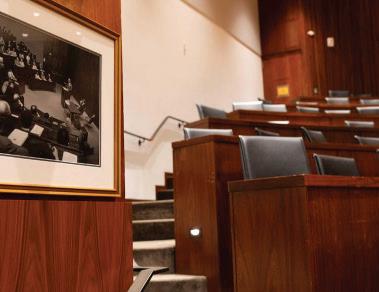
CALVIN K. GROVER / THE DAILY PRINCETONIAN
President Eisgruber spoke at CPUC meeting on Feb. 10, encouraging participants to “Keep Calm and Carry on” during start of Trump administration.
Hands Off! Princeton, In Pictures
On a drizzly Saturday, over a thousand community members gathered in Hind’s Plaza in downtown Princeton, N.J., spilling out into the street, to protest various aspects of the Trump administration. As part of “Hands Off!” protests across the nation that
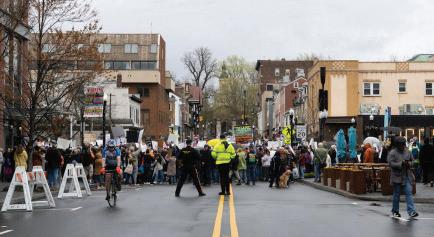
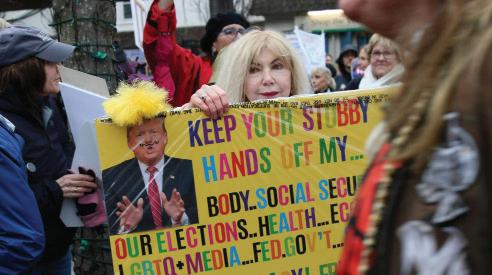
day, the demonstration attracted a broad base of support, ranging from retirees with experience in the student movements of the 60s to young children protesting for their first time.
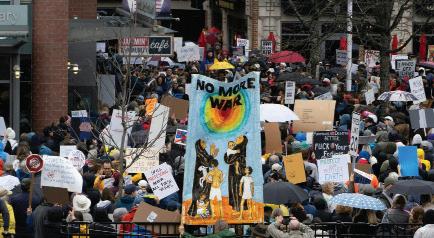
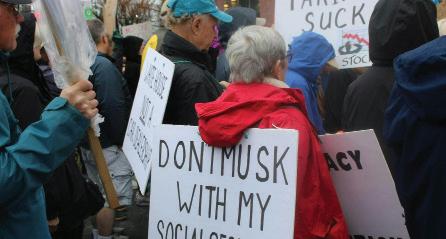

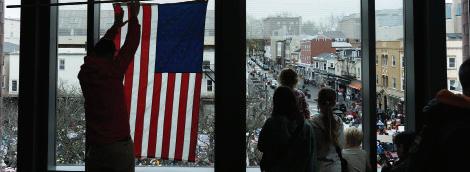
LOUISA GHEORGHITA / THE DAILY PRINCETONIAN
Police managed the orderly crowd, blocking off the intersection of Witherspoon and Hulfish streets.
LOUISA GHEORGHITA / THE DAILY PRINCETONIAN
A religious anti-war banner is raised over a crowd of various political signs, ranging from environmental messaging, to denunciations of Elon Musk.
GABY GUTIERREZ / THE DAILY PRINCETONIAN
An eye-catching sign from the crowd.
GABY GUTIERREZ / THE DAILY PRINCETONIAN
Despite taking place very close to campus, student presence was far outweighed by the older demonstrators, many of whom touted signs referencing their social security status or their protesting pedigree from
CALVIN KENJIRO GROVER / THE DAILY PRINCETONIAN
Inside the Princeton Public Library, young children observing the crowd through the glass asked, “is the President visiting?”
CALVIN KENJIRO
THE AI DEBATE
For Princeton, the New Jersey AI Hub promises innovation and opportunity
By Luke Grippo Features Contributor
Nearly 18 months after its conception, the physical location of the New Jersey AI Hub is almost complete near Route 1.
The AI Hub began as a collaboration between Princeton and the New Jersey Economic Development Association. Microsoft, a leader in AI, and CoreWeave, a Livingston-based startup aiming to deploy AI at scale, joined Princeton and New Jersey as founding partners in January 2025. These four partners will serve to advance the AI Hub’s three pillars: promoting AI research, commercializing and accelerating innovation, and strengthening and scaling AI education.
The AI hub is now looking for its leader. After more than a year and a half, the University and the founders of the AI Hub are currently searching for an executive director.
“There’s such alignment across what all of us want to do with the AI hub that really the Executive Director will come on board … to bring the vision to life,” said Princeton Vice President and Secretary Hilary Parker.
The position opened on Feb. 25. According to Parker, the executive director of the AI Hub will be a University employee who works closely with the governing board of the AI Hub, which will include members from each of those founding organizations.
For Princeton’s part, Provost Jennifer Rexford ’91 noted that many administrators are involved, including Vice Dean for Innovation Craig Arnold, outgoing Dean of Engineering Andrea Goldsmith, and Office of State Affairs Assistant Vice President David Reiner. Senior Strategic AI Hub Project Manager Jeffrey Oakman GS ’03 was “brought on specifically to focus on driving a lot of this work,” Rexford noted.
Hiring of staff will continue once the corporate partners move into the physical space. CoreWeave currently has a team of three people working on this project.
The new hub will be located in West Windsor along Route 1, an eight-minute drive from Nassau Hall. Despite the 40-minute walk from campus, University leaders involved in the project promise that faculty and students will receive benefits as well.
According to Rexford, the AI Hub will allow students and faculty to transfer their ideas to local industries, for example, by providing guidance for ideas that students may not realize could solve problems for “pharma companies or a telecom company.”
Corey Sanders ’04 is CoreWeave Senior Vice President of Strategy and a Visiting Lecturer in the Department of Computer Science. Sanders described plans to launch a set of summer internships at the AI Hub for students. He said that
he hopes that the internships will “strengthen the AI education component” and “enable growth and development of the workforce” in the state.
When asked when the internships would begin, Sanders said, “The goal would be as soon as possible.” He continued, “We need to move quickly with the launch of the AI Hub.”
“What we gain to benefit is the tide that lifts all boats,” Sanders said. He explained, “The opportunity to improve the workforce, the opportunity to develop and culture early-stage startups, the opportunity to take research from the top universities of the state and turn them into much more applicable technologies for the next generation of advancement.”
Sanders worked for Microsoft until January 2025. Each partner is focusing on a pillar of the AI hub — research, commercialization and accelerating innovation, education and training.
Mike Egan, Senior Director of TechSpark, a Microsoft program that assists startup ventures aimed at community improvement across the country, explained how the partners will be tackling these pillars.
Egan shared that the first pillar will be aimed at asking, “How do we take local companies, startups, small businesses and others, bring them into the lab, and have them think about AI? What can AI bring their company? How can they become more efficient? How can they integrate with AI?”
The second pillar will be the primary focus of CoreWeave, which Egan said will be aimed at asking, “Can we accelerate new companies, new startups, new businesses?”
The third pillar of the AI Hub will promote “workforce development and skilling (training),” which is something that TechSpark and Microsoft will primarily handle, Egan said.
Egan explained that this pillar is particularly focused on training students in community colleges across New Jersey. “We’ve already had some inroads with the New Jersey Community College Association, so we don’t want to limit it just to Princeton,” Egan said. He also shared that he expects Rutgers University to become a partner in the future. Rutgers currently has an Art and Artificial Intelligence Laboratory housed under their department of computer science and 11 faculty associated with AI.
Egan shared that once the Executive Director is chosen, TechSpark will also be hiring a manager who will help advance the third pillar of the AI Hub: workforce development.
“The TechSpark manager will serve both as a technology kind of liaison to Microsoft and all its resources, but also a real local community manager driving skilling across the state,” Egan said.
New Jersey Governor Phil Murphy has bigger hopes for the AI Hub, hoping that it will revitalize the New Jersey in -
dustry standards.
“New Jersey, through thick and thin … largely held on to the big corporate players,” Murphy said. “Where we lost our way, and we lost our way badly, was in the startup community.”
The AI hub is one of 10 Strategic Innovation Centers that the NJEDA has invested money into, hoping to catalyze industry in the Garden state by helping startup companies get off the ground with statelevel assistance. According to Murphy, it is cheaper to “birth a new company” rather than try to incentivize companies to come to New Jersey “after they’ve already grown up.”
Microsoft President and University Trustee Brad Smith ’81 shared with the ‘Prince’ his understanding of the AI Hub as constantly evolving and adapting to meet current needs. “This has, in my view, the potential to have a very long and dynamic life,” said Smith. “It [the AI Hub], just like Princeton University, is never finished.”
Smith is also hopeful that the growing startup ecosystem of New Jersey will encourage startups to develop in the state.
According to a Feb. 2 press release from the NJEDA, the founding equity partners will collectively invest “over $72 million to support the longterm success of the AI Hub, including up to $25 million of non-binding commitment from the NJEDA.”
In an interview with ‘Prince,’ Murphy shared that, should other partners decide to invest, the N.J. Government “will match other partners’ financial commitments,” dollar for dollar, up to $25 million.
Though no exact date has been announced, according to Parker, the AI Hub will be up and running “within weeks.” There will be an official ribbon-cutting ceremony to commemorate the completion of the AI Hub’s physical location on Thursday, March 27, at 10 a.m.
“With the space ready, and events ready to plan, I think that there’s going to be a lot of activity that will kick off this Spring and then continue,” Parker said.
Egan shared that future sponsorship and alumni opportunities will arise once the AI Hub is up and running.
He explained, “I could see other sponsorship opportunities, where [other companies] could come in and run their own kind of clinic — their own kind of deep dive in a particular region … other kinds of engagements that they help sponsor with students and faculty at Princeton.”
Luke Grippo is a senior News writer and Features contributor for the ‘Prince.’ He is from South Jersey and usually covers administrative issues, including Undergraduate Student Government, the Council of the Princeton University Community, and institutional legacy.

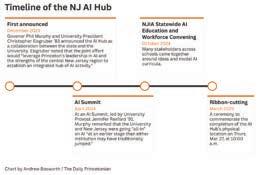
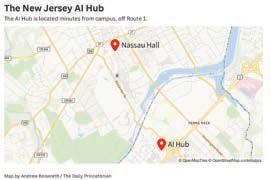

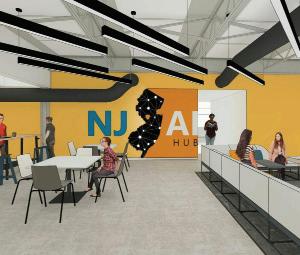
ANDREW BOSWORTH / THE DAILY PRINCETONIAN
619 Alexander Road in West Windsor will be the new home to the AI Hub.
In her recent op-ed titled “Princeton, stop using ChatGPT,” Ava Johnson ’27 criticizes the use of generative AI at Princeton, especially in the context of schoolwork, writing that “generative AI is bad for the environment, bad for our brains, and often incorrect.” Her piece concludes that “using ChatGPT all the time makes you look stupid, because it is stupid. We’re smarter than that.” While I agree with Johnson’s overarching critique of our overreliance on generative AI in place of actual human creativity, her portrayal of the relationship between generative AI and schoolwork is misleading and one-dimensional.
Complete avoidance of AI is not a solution to the issue Johnson rightfully points out. Avoidance merely leaves us ignorant, standing still in a moving world. On the contrary, Princeton students should discuss the use of AI tools in education with honesty and open-mindedness and consider it a novel tool as opposed to a morally objectionable scourge.
In any discussion about novel, quickly developing technology, it’s important to be precise when discussing the current landscape. One of Johnson’s main points is that ChatGPT is often incorrect and unreliable, a claim she supports with a 2024 study, which “found that 52 percent of answers provided by ChatGPT are false.” However, Johnson does not mention that the study only looks at
In defense of ChatGPT
programming questions. The study also suggests that ChatGPT is only making small errors (as opposed to providing completely false answers), stating that “52% of ChatGPT answers contain incorrect information.” Indeed, ChatGPT isn’t very reliable. Nonetheless, when Johnson frames ChatGPT’s errors as an unequivocal reason to avoid the tool, she misrepresents the truth. While ChatGPT isn’t perfect, it’s still useful, and it does outperform humans on many tasks, both academic and non-academic. And it’s is improving quickly.
In addition, Johnson portrays ChatGPT as directly substituting existing technologies, when this is not the case. She repeatedly compares ChatGPT queries with Google searches, arguing that the former is rendered unnecessary by the latter.
But Johnson overlooks the reality that ChatGPT has different capabilities than pre-existing technologies. ChatGPT has digested vast amounts of information as input and can reference this breadth of information in a way that no human can — an individual parsing through a Google search will assimilate nowhere near as much information as the AI model. Moreover, ChatGPT can use previous queries as data, generate answers tailored to a specific question and algorithmically improve the accuracy of their responses — things Google cannot do.
And omitting nuance in conversations about AI leads us to unproductive discussions. When Johnson argues that students shouldn’t use AI because it uses more energy than
I“a simple Google search would,” she flattens the discussion. She does not take into account other factors that should inform this characterization, such as the possibility that AI could help us further environmental research, as it already has.
For all that I’ve highlighted about the capabilities of generative AI, let me be clear: I strongly agree with Johnson’s concern over our reliance on AI tools. I think the use of ChatGPT for academically dishonest purposes is symptomatic of wider cultural issues in higher education, where students prioritize the appearance of competence (i.e., grades) over actual competence. When we use ChatGPT to do our work for us, we deprive ourselves of the chance to actually learn. We erode our integrity. Johnson also makes great points about the perpetuation of misinformation by AI tools, especially in our time of political polarization, and about the antisocial nature of talking to chatbots.
However, the answer to these issues is not in indiscriminately avoiding ChatGPT or in calling people “stupid.” The answer is in thoughtful, open conversation about the role of AI in our classrooms and larger lives and in recognizing that while its use is morally complicated, we mustn’t deprive ourselves of understanding a key technological development of our changing world. Is it unethical to ask ChatGPT for a more in-depth explanation of an example question in the textbook? Is it unethical to ask Claude to prompt me with questions as I brainstorm ideas for an essay? Is it unethical for my professor to ask
Gemini to help them structure a lesson plan?
Maybe. Maybe not. Regardless, these questions can’t be addressed if condemnation of AI use is the centerpiece of our cultural discussions. We will not find answers to difficult questions about AI through out-ofcontext facts or by focusing on condemning those who are actively integrating this technology into their lives.
So, let us not stop using ChatGPT. Instead, let’s use it honestly and discuss it purposefully. Be an open and conscientious citizen of our world, even and especially in all its technological change. Talk openly with professors about their policies on generative AI and what’s motivating those policies. Play around with an LLM to
understand what these systems are good at and what they can improve on. Think — really, I encourage you to take two minutes to sit in silence and think — about what you feel the trajectory of our rapidly changing future will be, and read some radically different forecasts about what the future of AI will mean for us. Like Johnson articulates so passionately, we must think for ourselves. This can’t happen if we have our heads buried in the sand, ignoring a powerful technological tool at the forefront of our cultural, political, and academic spheres. After all, we’re smarter than that.
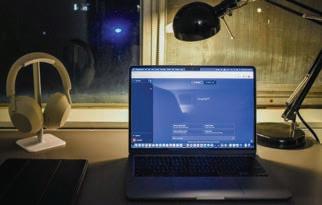
Keep academic authority in human hands
n an otherwise insightful, hopeful, and at times even beautiful, piece in the New Yorker in April, Princeton Professor of History D. Graham Burnett makes one critical error: Compared to the rise of AI, he remarks, the Trump administration’s frightening invasions into university affairs seems like a “sideshow.”
But these are not two separate problems on two parallel tracks. The rise of AI in research and higher education and the administration’s actions are born from the same cultural trends: the devaluing of authentic human curiosity in favor of a single voice of authority, maximizing efficiency and usefulness in the generation and curation of knowledge. It’s no coincidence that the same administration pushing for increased AI usage in education is also pursuing government takeover of universities. These problems lead to the same end: Academics will cease to make the decisions about what sort of questions to ask, research to do, and concepts to teach.
To respond to these twin threats, we, as people with a great stake in free academic thought, must recommit to and appreciate the power of human-centered inquiry. Academic freedom, and its capacity to help us better understand ourselves and one another, will remain in danger as long as we do not confront this displacement of intellectual power away from human scholars.
Dr. Burnett suggests AI’s potential to support rather than endanger the humanities, describing a myriad of nuanced student research from his class which probed the depths of AI’s capabilities in order to highlight the untouchable power of authentic humanness. He also rightly highlights the ineffectuality of universities’ attempts to sweep AI under the rug and turn a blind eye to a revolution in both the production and synthesis of knowledge. And Burnett
suggests, profoundly, that better understanding AI may return us to ourselves by reminding us of our humanness, of the ways in which our intellects surpass mechanized or formulaic responses.
Yet simply getting better at using AI, and trusting in the public’s universal epiphany that mechanisms like ChatGPT will never compare to nor threaten true humanness, is not sufficient action amid a surge of governmental efforts to undermine the authority of individual scholars and university leadership devoted to the pursuit of truth.
That’s because the Trump administration’s attacks on research and higher education as well as a more general blind reliance on AI chatbots are reflective of a societal backslide: a commodification of knowledge that prioritizes “efficiency” over the messy process of getting to an answer, where nuances are flattened and the truth is fungible.
It’s the same whether you’re a student plugging your essay prompt into ChatGPT or an administration cutting a research grant because it is perceived to be “waste, fraud, and abuse.” Both processes involve a presumption that everything worth knowing is already known and that there is an objective answer to every question.
When we let someone — or something — without true curiosity for an area of inquiry have control not only over what questions are asked, but what answers are produced, knowledge becomes a formulaic commodity. Rather than represent the inquiry and perspective of the people — a tenet of democracy itself— the voice of intellectual authority is concentrated in isolated figures of authority.
This means that discourse is not only less meaningful, but easier to control: another advantage for the power vacuum pursued by the current administration.
Thus, finding better ways to use AI does not ultimately address the collective attack on free human thought
posed by the combination of excessive AI usage and the Trump administration. While there appears great eagerness to get better at living with the machines we have created, this is not a substitute for greater attention and dedication to human-centered scholarship: we have to get better at living not just with AI, but with our fellow humans.
We must be wary of the awe, the kind of magical quality and “stupefaction” that Burnett finds may emerge from engaging with AI, because it’s the first sign that human knowledge is becoming estranged from humans themselves. We must not grow so fascinated with experimentation into how closely the inhuman can impersonate the human that we devalue the actual human.
Academia is at its best when it can explore the human condition and thus improve and make more meaningful the lives of all people. That often looks
like embracing change and extending boundaries, which includes learning to use AI. However, it does not include shunning authentic, imperfect human processes of discovery in favor of efficiency-optimizing shortcuts which devalue curiosity as well as discourse and dissent, whether technological or governmental. In an age when the integrity of intellectualism is at great risk, AI advancement must not be treated as a separate issue from our present government, but rather as another player in the larger, dangerous rearrangement of intellectual authority.
As students today, we must understand the power of our own intellectual work and the discourse in which we participate with our peers on our campus. In present times, opportunities to generate our own research and value our own processes of expression and exploration — even if it’s messier than an AI gen-
eration — is an act of resistance against an administration presently seeking to bury academic freedom for good. There is undoubtedly a place for awe in academia, but it doesn’t have to belong exclusively to machines, just as it certainly must not be granted to governmental bodies threatening universities with performances of strongman power. We can instead find awe in ourselves, in human inquiry and discourse. We can and will live with AI. But every now and then, we should remember to turn away from the stupefying power of the machine and towards the intellectual power and fortitude of our own, human academic communities, for the sake of our freedom and humanity.
Lily Halbert-Alexander is an assistant Opinion editor and prospective English major from San Francisco. She can be reached by email at lh1157[at]princeton.edu.
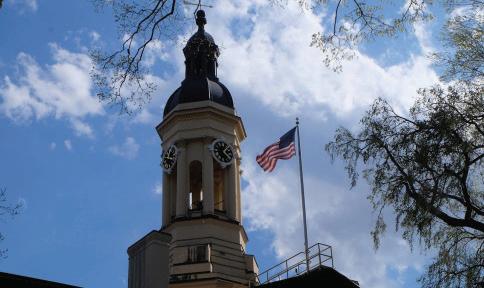
Eliana Du ’28 is the head Cartoon editor for the ‘Prince.’ She may be reached at elianadu[at]princeton.edu.
CALVIN GROVER / THE DAILY PRINCETONIAN Clio Hall.
Lily Halbert-Alexander A ssistA nt opinion editor
Eliana Du Guest Contributor
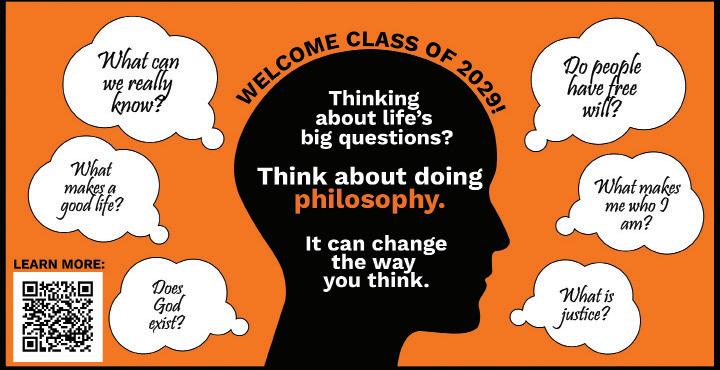
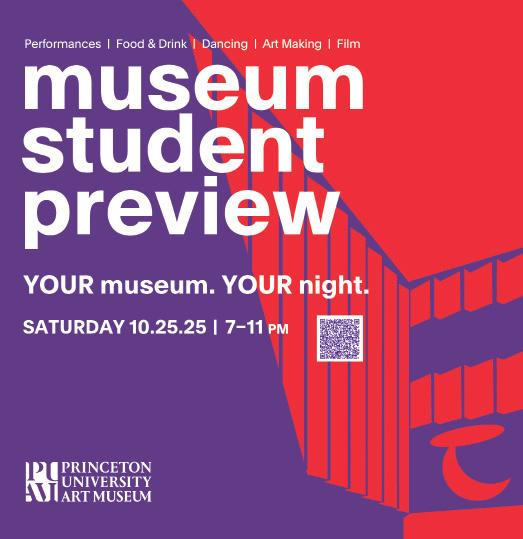

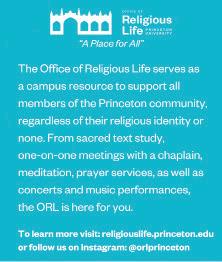
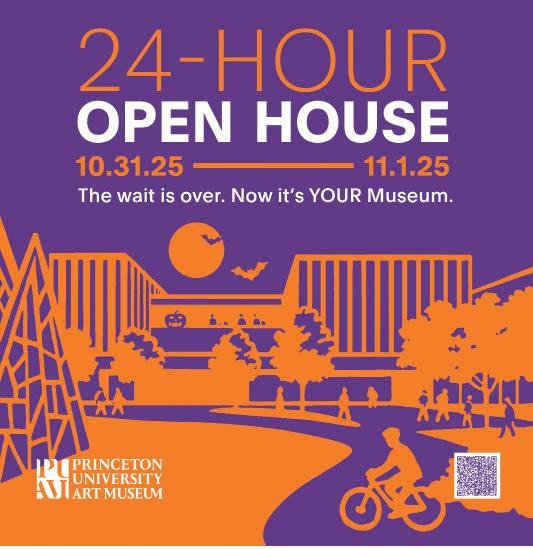
CAMPUS PROTEST
‘I
don’t feel represented by Princeton’: Students react to reinstated fossil fuel research funding
By Michelle Miao & Miriam Waldvogel
News Contributor & associate News Editor
Two years after announcing that it would cut financial ties with certain segments of the fossil fuel industry, the University re-opened the door to research funded by those companies in an Oct. 3 letter to the faculty.
“It’s not right for Princeton to promote sustainability initiatives when their research is being funded by the culprits [of the climate crisis],” said Raquel Rodriguez ’28, a member of Sunrise Princeton, at an Oct. 4 rally protesting the decision.
In 2022, the University announced it would dissociate from — meaning “refraining, to the greatest extent possible, from any relationships that involve a financial component” with — 90 fossil fuel companies. The companies, including ExxonMobil, all met a list of criteria that included involvement with highly-polluting segments of the industry.
The University also pledged to eliminate all endowment holdings in publicly traded fossil fuel companies and established a fund to support energy research that would be otherwise impacted by dissociation. The move was heralded as “historic” at the time and came after nearly a decade of student activism.
In its October announcement, however, the University wrote that dissociation “adversely and inequitably affected scholars whose research programs are addressing pressing environmental problems.” It claimed that scholars had lost out on funding for “research to combat the harms of climate change,” as well as collaborative partnerships.
As a result, the University will now allow researchers to accept funding from companies otherwise meeting the disso-
ciation criteria, with the caveat that researchers use the funds with the “aim to produce environmental benefits.”
While the Board of Trustees issued the 2022 decision to cut ties with some fossil fuel companies, University spokesperson Jennifer Morrill said in a statement to The Daily Princetonian that the most recent rollback was made by the University administration, “which has the responsibility for determining how to implement the Board of Trustees’ fossil fuel dissociation decision.”
Several students, including some involved in Sunrise, said the move undermined their trust in the University.
“Without dissociation, Princeton will continue to be implicated in the exploitative and racialized capitalist system that contributes to the climate crisis,” wrote Connie Gong ’25, vice president of the Princeton Conservation Society. “It erodes my (already limited) trust in the University administration’s ability to act on student calls for change.”
The Sunrise rally, planned weeks in advance, was originally intended to introduce Sunrise’s “Finish the Job” campaign to pressure the University to divest the rest of its endowment from fossil fuels and to implement other climate-friendly measures. However, it turned into a call for the University to “do the job” in the wake of the announcement. About 60 students attended the rally.
“Princeton dismantled dissociation and we demand that the University put the pieces back together,” said Alex Norbrook ’26 at the rally. “The University has taken over a decade of work from students, faculty, and staff, and they’ve shredded it all.”
Norbrook is an Opinion columnist for ‘Prince.’
Rally co-coordinator Mira Eashwaran ’26 noted that climate is a very personal issue for many students, noting that “just
a week after Hurricane Helene, the University decided, ‘We’re going to work with the fossil fuels that have caused that climate disaster. We’re going to let them back into our community.’”
Eashwaran is a staff Features writer for the ‘Prince.’
Others questioned whether fossil fuel funding would influence the outcomes of research.
Cameron Farid ’26, president of the Princeton University Energy Association, said that he had “no evidence of funding from a fossil fuel company impacting the direction of research in any way,” citing his internship with the Andlinger Center for the Environment last summer.
James Daniels ’26, who criticized the 2022 dissociation decision as “ineffective” and harmful to the health of the endowment in an article in The Princeton Tory, welcomed the reversal but critiqued the abruptness of the move.
“The sudden reversal showcases the University’s lack of foresight and continued climate hysteria that paralyzes innovation to existing technologies,” Daniels wrote to the ‘Prince.’
Daniels also challenged the current University criteria for “purposely exclud[ing] projects that acknowledge the continued short-term importance of fossil fuels.”
In September — prior to the University’s policy announcement — Sunrise released a report arguing that Princeton continues to “to invest in, profit from, and produce research that serves the interests of fossil fuel companies.”
This included criticism of fossil fuel funding that the University receives for climate research, which allegedly allows companies to promote their image and protect their business models. One main focus was the BP-funded Carbon Mitigation Initiative, which Sunrise stated was
used by BP to “advance its communications campaign to promote natural gas, boost its credibility as a supposed climate leader, and influence policy at the highest level.”
The report also criticized the University’s stakes in Petrotiger, an oil and gas company from which the University has reported earning nearly $140 million in investment income and direct financial contributions, or cash transactions, over the last 10 years. Though Princeton’s current ownership stake in Petrotiger is unclear, Vice President for Finance Jim Matteo confirmed at the Sept. 30 Council of the Princeton University Community (CPUC) meeting that University investment in Petrotiger began in the 1980s.
“We believe research will have a more significant positive impact than any choices the University makes about its investments or management of resources,” Morrill wrote to the ‘Prince.’ She argued that the recent change in dissociation was consistent with the University’s guidelines on divestment and dissociation, which encourage responses that “offer at least some possibility of constructive
impact” and are “consistent with the fundamental character of the University as an academic institution.”
The guidelines also encourage the University to respond in ways that “can merit broad support through the University.”
Speaking to the ‘Prince’ after the rally, Sunrise co-coordinator Liz Kunz ’27 said, “It’s more important now than ever to reaffirm the importance of activism on the Princeton campus in demanding that the University listen to student voices.”
“We’re going to continue to raise awareness and build our movement so that Princeton takes us seriously and actually prioritizes their students’ future. Because right now, I don’t feel represented by Princeton,” said Sunrise co-coordinator Anna Buretta ’27.
Michelle Miao is a News contributor for the ‘Prince’ from Oxford, Ohio.
Miriam Waldvogel is an associate News editor and the investigations editor for the ‘Prince.’ She is from Stockton, Calif. and often covers campus activism and University accountability.
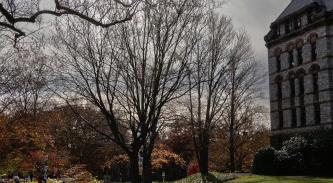
U. walks back protest ban on Nassau Hall lawn
By Olivia Sanchez Associate News Editor
On Sept. 5, the University retracted its decision to ban protests on the front lawn of Nassau Hall. Cannon Green and the Prospect House grounds remain off-limits locations to protest.
According to University spokesperson Jennifer Morrill, the change was made because the walkways in front of Nassau Hall “have long been an approved protest site.”
“Historically, we have recognized — and we continue to recognize — that protests legitimately spill onto the lawn. We have changed our language to reflect that,” she wrote in a statement to The Daily Princetonian.
Since the launch of the University’s new protest site a week ago, University officials have asserted that no policy changes occurred since the end of the last semester, which was marked by turmoil between the administration and protesters following the “Gaza Solidarity Encampment.”
“You may be wondering whether Princeton’s policies relating to protests and demonstrations will change in light of last year’s activity. The short answer is: no,” a letter from top administrators — including Vice President for Campus Life W. Rochelle Calhoun, Dean of the College Michael Gordin, and Dean of the Faculty Gene Jarrett — stated.
The University’s reversal of the Nassau Hall lawn ban has effectively removed the most significant update made to University policy.
The FAQ page of the Protests and
Free Expression website, which launched on Aug. 27, has been updated to reflect this change. Previously, the site read, “Are Nassau Hall’s front lawn, Cannon Green, or Prospect House grounds available for events, protests or demonstrations? No. Front campus (the lawn in front of Nassau Hall), Cannon Green, and Prospect House lawn and garden are reserved for officially sanctioned University events, and are not available for any other organized activities.”
A question regarding Nassau Hall is now separate from the section on Cannon Green and Prospect House.
“Is the Nassau Hall front lawn available for protests or demonstrations?” a new FAQ tab reads. “Yes. The walkways in front of Nassau Hall are expressly recognized as legitimate protest sites, and the University has historically recognized and continues to recognize that protests may legitimately spill over onto the lawn.”
The first pro-Palestine protest of the semester — held on Sept. 3 — targeted attacks towards the ban of protest activity on campus spaces.
“If somebody from the administration comes over and says, ‘here’s a little sheet of paper; you’re walking on the grass,’ I want you to go find [a protest marshal] and tell them, tell this guy to f--- off,” Aditi Rao GS, an organizer with Princeton Israeli Apartheid Divest (PIAD) told the crowd.
Although the protesters avoided stepping onto Cannon Green during their campus tour of protest sites from the Spring semester, during their stop at Nassau Hall, some
stepped onto the lawn.
“We have tried to follow the University’s process, and they’ve shifted the goalposts … Today we played by the rules … [but] I would say we’re not deterred,” Urvi Kumbhat GS, another organizer, said.
A Sept. 3 email to the University community from Vice President for Student Life W. Rochelle Calhoun denied that the policies changed “in light of last year’s activity.”
Princeton University Postdocs and Scholars (PUPS), the union for postdoctoral researchers on campus who have frequently held protests in front
of Nassau Hall, wrote a statement to the ‘Prince’ in reaction to the rule reversal.
“The University’s ability to change these and other policies on a whim is why we’re fighting for a strong contract to protect workers’ rights to protest among many other things,” they said.
“We are glad that the University loosened this one restriction — but what this shows is not their reasonableness, but the untenability of their rules overall,” Anna Buretta ’27 and Liz Kunz ’27, co-coordinators of Sunrise Princeton, said. Sunrise is
a protest-oriented student organization dedicated to climate activism.
“We believe that it is important to continue pushing against the remaining draconian restrictions on protests. Princeton prides itself on free speech, and we must ensure that they do not enshrine protest as a lesser form of expression than speech in their official codes,” Buretta added.
Olivia Sanchez is an associate News editor for the ‘Prince.’ She is from New Jersey and often covers the graduate school and academic departments.
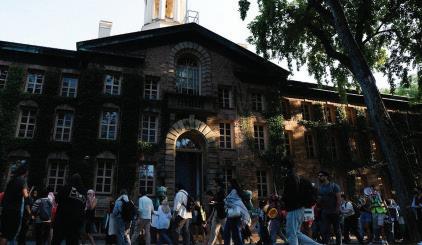
LOUISA GHEORGHITA / THE DAILY PRINCETONIAN Some students have criticized the University’s decision to allow fossil fuel
CALVIN K. GROVER / THE DAILY PRINCETONIAN
Protesters congregated outside of Nassau Hall at the first Princeton Israeli Apartheid Divest (PIAD) rally of the semes-
A timeline of the ‘Gaza Solidarity Encampment’
By Daily Princetonian Staff
Wednesday, April 24
Plans leak
Unlike other universities where encampments began unexpectedly, planning documents for the Princeton encampment were leaked to conservative outlet National Review. They published a story on Wednesday morning, before the sit-in began.
The documents, independently verified by the ‘Prince,’ outlined a plan for at least 20 people to camp overnight. A leaked press release — similar but not identical to demand sheets circulated at the sit-in the next day — noted protesters would call for the University to “divest and disassociate from Israel” and publicly endorse a ceasefire.
Thursday, April 25
Sit-in begins, two students arrested Protesters established Princeton’s “Gaza Solidarity Encampment” at 7 a.m. Thursday morning in McCosh courtyard. Initially, they erected tents on the grass. After a warning at 7:03 a.m., two graduate students — Achinthya Sivalingam GS and Hassan Sayed GS — were arrested at 7:06 a.m. Both students were immediately barred from campus.
Soon after the arrests, the other protesters packed the tents up but remained in the courtyard on tarps and blankets. Building on about 40 initial participants, attendance ballooned to about 250 by noon as news spread.
Flyers circulated throughout the day demanded that the University divest from Israel, call for a ceasefire in Gaza, dissociate from Israeli academic institutions, cultivate relationships with Palestinian institutions, end TigerTrek Israel and Birthright Israel trips sponsored by the Center for Jewish Life (CJL), and dissociate from the Tikvah Fund, a politically Zionist nonprofit that has funded campus events in the past.
Protestors stay awake in shifts
To avoid running afoul of Office of the Dean of Undergraduate Students (ODUS) regulations that forbid sleeping “in outdoor spaces of any kind,” organizers decided to stay awake in shifts in the courtyard. Despite freezing temperatures that night, approximately 60 protesters remained.
Friday, April 26
CJL, Chabad comment
Later that afternoon, Executive Director of Princeton’s Center for Jewish Life (CJL) Rabbi Gil Steinlauf ’91 issued a statement on the sit-in. While he said that some rhetoric and activities were “hateful toward Israel and disturbing for many to experience,” he added that “it’s also important to say that despite these concerns, the majority of students are not living in fear.”
Rabbi Eitan Webb, the co-director of Princeton Chabad, had counterprotested at the sit-in and wrote in an email to the Chabad listserv that he “came away inspired.”
“I’ve probably had more than 50 conversations with students over the last day and they care too,” he wrote. “The Jewish people are alive.”
Around 30 students held Shabbat dinner at the sit-in later that night, including kosher-for-Passover food.
Sunday, April 28
Lawnparties held mostly uninterrupted.
On Sunday, April 28, the “Gaza Solidarity Encampment” reminded students of their presence during spring Lawnparties, as many protesters left McCosh courtyard at noon, moving to the Fountain of Freedom in Scudder Plaza, a hotspot for Lawnparties photos.
Monday, April 29
Protesters stage sit-in at Clio Hall On the late afternoon on April 29, a group of students and faculty entered Clio Hall to begin a sit-in at the office of Dean of the Graduate School Rodney Priestley. After approximately 45 minutes, PSAFE officers warned that anyone remaining in the building after 5:30 p.m. would be arrested. Several people, including two student journalists and professors Ruha Benjamin, Dan-El Padilla Peralta, Naomi Murakawa, and Divya Cherian exited Clio shortly after.
The crowd grew to around 200 people who gathered in front and behind Clio, chanting and banging on buckets in support of the 13 people inside. According to an Instagram post from Princeton Israeli Apartheid Divest (PIAD), protesters occupied Priestley’s office to force the University to negotiate.
Several dozen protesters blocked the front and back doors of Clio, but made a path as staff were escorted out by PSAFE.
Around 6 p.m., officers emerged with Ariel Munczek Edelman GS and Sam Nastase, a researcher in the Princeton Neuroscience Institute, and escorted them
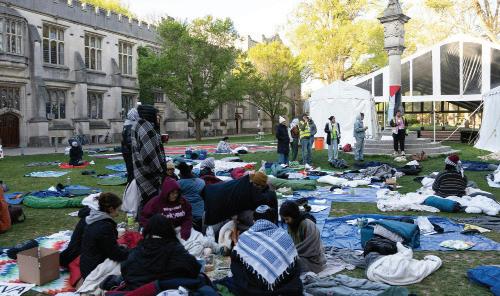
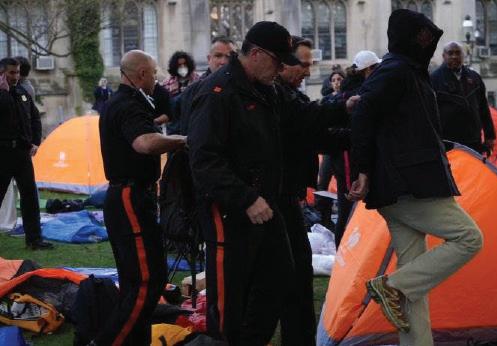
to a TigerTransit bus parked beside Clio.
In one of the most intense moments of the protest, a large group of people gathered around the bus, banging on the windows and shouting, “Let them go.” Others wedged green safety cones in the back left wheel of the bus and blocked it from moving up Elm Drive.
After 30 minutes of chaos and failed requests to clear the road, history professor Max Weiss and senior research scholar Zia Mian stepped onto the bus to discuss with PSAFE before Edelman and Nastase were released three minutes later to cheers from the crowd.
All of the protesters inside Clio were then periodically released through the front to shouts and cheers from the outside crowd, and given a 7:30 p.m. deadline to turn themselves in to PSAFE Headquarters. PSAFE escorted them to their dorms, where they were given ten minutes to gather their belongings. They were then barred from campus.
Protesters gradually dispersed onto Cannon Green, and organizers began to move supplies from the original McCosh courtyard site.
An email from Eisgruber later that night — his first comment on the protests — called the demonstration at Clio “completely unacceptable,” and detailed that the arrested students would also face University disciplinary action.
Friday, May 3
Undergrads begin hunger strike
At least 17 undergraduates began a hunger strike on Friday to urge a meeting between the University and protesters about divestment from Israel. The strikers also called for the criminal and disciplinary charges against the 13 students arrested at Clio Hall to be dropped.
One hunger striker was later hospitalized.
Monday, May 6
Sit-in meets with Eisgruber
As day four of the hunger strike dawned, a group of students, faculty, alumni, and postdocs met with Eisgruber, Priestley, and Dean of the School of Public and International Affairs Amaney Jamal in the first formal interaction between protesters and administrators regarding divestment from Israel since the beginning of the sit-in.
Tuesday, May 7
Hundreds rally on Dean’s Date
More than 350 people rallied outside Nassau Hall in the hours after Dean’s Date, the deadline for undergraduate students to submit all written work. Several students arrested at Clio Hall — at the time still banned from campus — gave speeches through FitzRandolph Gate.
Wednesday, May 8
Late night arrest warnings issued, no arrests made
After multiple brief interactions with protesters over the past several days, PSAFE officers issued three paper handouts titled “Warning and No Trespass Notice” late Tuesday night. The cards threatened immediate arrest in response to the attempted construction of a tarp structure to shelter some of the students participating in the hunger strike.
While no arrests were made that night, the interactions with PSAFE over structures marked a relatively tense moment for the sit-in, now nearing a week on Cannon Green.
Monday, May 13
After nearly three weeks of the “Gaza Solidarity Encampment,” Eisgruber sent an email announcing that all protesters must clear Cannon Green ahead of preparations for Reunions and Class Day.
Eisgruber wrote that the issues could not be resolved “through negotiations with a single interest group” and noted that the University was exploring the possibility of a restorative justice process for arrested students, as well as new “academic affiliations with Palestinian scholars, student, and institutions.” Additionally, he reported that administrators had offered to “convene a working group on the experience of Palestinian students, staff, and faculty at Princeton.”
Wednesday, May 15
After three weeks, sit-in closes
Around 5 p.m. on May 15, organizers declared that the sit-in would disband that day. A PIAD spokesperson also confirmed to the ‘Prince’ that the hunger strike had concluded.
Around 9 p.m. on May 15, protesters began to clear the “Gaza Solidarity Encampment,” Princeton’s longest sit-in in history. They began removing signs, food, and tarps from the site on Cannon Green, finishing most of the work by midnight.
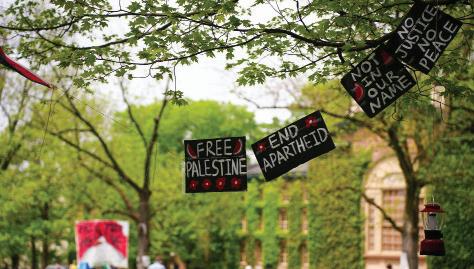
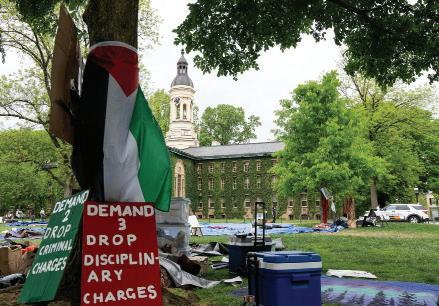
Protesters, fire alarm disrupt former prime minister of Israel
By Devon Rudolph & Kian Petlin Associate News Editor & contributor
A walkout, a fire alarm, and a group singing the Israeli national anthem.
A speaker event with former Israeli Prime Minister Naftali Bennett on Monday was interrupted at various points, with approximately 20 protesters walking out of the event, an extended disruption by an individual who does not appear to have an affiliation with Princeton in the middle, a subsequent fire alarm interruption, singing by the event’s attendees at the end, and yelling between protesters and event attendees in the courtyard after.
The off-the-record event, which was hosted by the Center of Jewish Life (CJL) and co-sponsored by the School of Public and International Affairs, the Program in Judaic Studies, Scharf Family Chabad House of Princeton, and the Mamdouha S. Bobst Center for Peace and Justice, was held in McCosh 10. Rabbi Gil Steinlauf ’91, the director of the CJL, moderated the discussion. Approximately 200 students, faculty, and other community members were in attendance.
Outside the building, about 200 proPalestine protesters chanted, screamed and banged on drums in a display of their dissatisfaction at the decision to host the former Israeli prime minister. The chants of protestors outside were audible inside the lecture hall throughout the talk, and reached as far as Firestone Library and the Architecture Building.
Steinlauf welcomed former Prime Minister of Israel Naftali Bennett to the stage shortly after 7:30 p.m. Before declaring that the event was off-the-record, Steinlauf briefly read through Princeton’s regulations on free speech and warned that disrupters would be removed from the event and may face sanctions.
After 20 minutes, about 20 demonstrators stood up and began chanting “Naftali Bennett, you can’t hide, we charge you with genocide.” They promptly walked out of the room to join the protest outside, followed out of the lecture hall by a free speech coordinator, a University staff member charged with enforcing regulations around protests. Outside, they were greeted with cheers from the demonstrators gathered in the courtyard.
A few minutes after, Sayel Kayed, a man sitting near the front, stood and began shouting at Bennett, quoting civilian death tolls in Gaza: “15,000 children killed,
what do you say to that?” Kayed does not appear to have any connection to Princeton, and posted about the disruption on his Instagram.
Kayed — accompanied by a second individual videoing the disruption — continued shouting at Bennett for two minutes before he walked out, followed by Public Safety (PSafe) officers, a free speech coordinator, and Dean Jarrett Fisher, who often handles free speech-related events. Much of the audience applauded as Bennett delivered a rebuttal to Kayed.
“Instead of whining for the past 80 years and building your own future, you have focused on killing the Jews. It’s time the Palestinians stopped whining,” Bennett said, according to a video of the exchange posted on social media.
Alexandra Orbuch ’25, who was in attendance, expressed frustration that free speech facilitators had not intervened quickly enough in the incident. “They informed him that he was violating policy, but again, didn’t really lay a hand on him, didn’t do anything, and then escorted him out after he had disrupted the event for quite a while,” she told the ‘Prince.’
At 8:06 p.m., the fire alarm went off in McCosh and Dickinson Halls. Students and community members looked around in confusion before turning their attention to PSafe officers in the back of the hall for guidance. Minutes of confusion passed before it became clear that event attendees would not be evacuated from the building.
The University was unable to provide comment on the circumstances of the fire alarm before publication, although some attendees speculated it had been pulled by a protester.
Rabbi Eitan Webb then began singing “Kol Ha’olam Kulo Gesher Tzar Me’od” (The whole world is a very narrow bridge) and was joined by many of the event’s attendees, many of whom stood up from their seats and gathered around the stage. After the fire alarm was shut off at 8:17 p.m., attendees then sung Hatikvah — the national anthem of Israel — before the event concluded.
Steinlauf reacted to the disruptions that took place in a written statement to the ‘Prince,’ reiterating the Center for Jewish Life’s commitment to open dialogue and civil discourse in the face of differing viewpoints.
“The conversation with Prime Minister Bennett proceeded meaningfully, and the final disruption was met not with chaos,
but with spontaneous singing, dancing, and a sense of unity in the room,” he wrote.
Also in attendance was Judah Guggenheim ’25, who led the opposition to last fall’s Undergraduate Student Government (USG) referendum calling for the University to divest from companies involved in weapons manufacturing. He provided The Daily Princetonian with a written statement of his reaction to the disruption.
“[W]hile I certainly don’t always agree with him, it saddens me that the disrupters showed no sense of nuance. They shouted and pulled the fire alarm rather than listening to [Bennett] be asked and respond to difficult questions,” he wrote.
Other attendees also speculated that a protester had intentionally pulled the fire alarm.
Maddy Denker ’27, a member of J Street U, expressed disappointment over what she characterized as Bennett’s misappropriation of Jewish liturgy. “The statements made by Bennett do not represent the beliefs of all Jewish students and they do not represent J Street U’s pro-peace mission,” she wrote. About five J Street U members donned anti-occupation t-shirts and brought signage to the event.
PSafe presence in the area surrounding McCosh hall was notable, with officers guarding every entrance of McCosh and Dickinson Halls and additional officers stationed throughout the area around the event. Two fences spanning the length of McCosh courtyard were set up with a few feet between then, creating a “buffer zone” between the north side of McCosh courtyard and McCosh 10.
After rallying at Nassau Hall around 7 p.m., the protesters marched across campus to the location of the event. Positioning themselves facing a large window that looks into McCosh 10, protesters chanted continuously from 7:10 through the end of the event. Among their chants were cries of “shame,” directed at event attendees. At points during the event, a protester directed a bright flashlight into the window of McCosh 10.
The protest promotion highlighted a 2013 quote from Bennett that “I already killed lots of Arabs in my life, and there is absolutely no problem with that,” a comment a Bennett spokesperson said at the time was misinterpreted. Bennett, a rightwing figure in Israel, recently announced his return to politics.
When attendees left the event, the protesters again broke out into calls of
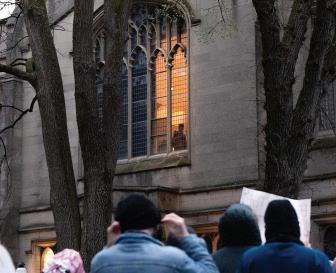
Around 20 people coming out of the event then gathered along the McCosh 10 side of the buffer zone fence, and some protesters and attendees got into verbal confrontations, with individuals on both sides of the fence hurling charged insults and accusations. The environment was notably more tense than previous protests, with arguments between protesters and attendees lasting for over 30 minutes following the event.
A few protesters breached the fence and entered the buffer zone, prompting security personnel and PSafe officers to instruct the protesters to back up. When protesters did not comply, one officer entered into the crowd and pushed them back. That officer was then pulled back by another after the crowd erupted in angry shouts. Protesters remained in the buffer zone for some time before moving back behind the fence.
The University was unable to provide comment on the circumstances of the PSafe incident before publication.
While many of the protesters were students and community members, some were from outside groups. Several members of Neturei Karta International, an anti-zionist Haredi Jewish organization, marched alongside protesters with signs decrying the ongoing conflict in Gaza.
Rabbi Dovid Feldman, part of Neturei Karta, spoke with the ‘Prince’ to explain
why they were there.
“If we truly want to see a better future, we must address the root cause. We have to address the occupation. We have to stop the occupation in its entirety, for the sake of the oppressed Palestinian people who deserve freedom, and for the sake of the Jewish people who deserve safety and security, all of us deserve a better future,” he said.
Also in attendance was Mahmoud Desouky, who spoke over the megaphone. Desouky is a graduate from Rutgers University and is running for N.J. State Assembly in the 16th District, which he discussed in his speech to the crowd.
“This is the time for change,” Desouky said.
The protest dissipated around 9 p.m., around half an hour after the event ended.
Vitus Larrieu is a senior News writer for the ‘Prince.’ He is from Pensacola, Fla. and typically covers community activism, the state of higher education, and construction and architecture.
Devon Rudolph is an associate News editor and staff Sports writer for the ‘Prince.’ She is from northern Virginia and typically covers student life and USG.
Kian Petlin is a News contributor for the ‘Prince.’
Princeton will not pursue dissociation from Israel, Resources Committee says
By Christopher Bao & Luke Grippo Head News Editor & Staff News Writer
A proposal for the University to cut financial ties with entities implicated in “Israel’s illegal occupations, apartheid practices, and plausible acts of genocide” will not move forward following months of deliberation from the Resources Committee, a body of faculty, students, and staff that makes dissociation recommendations to Princeton’s Board of Trustees.
The Resources Committee’s criteria to recommend dissociation includes a need for sustained campus interest, a central University value at stake, and campus consensus. This criteria is meant to serve as a “high bar” for determining whether the recommended stance will be consistent with the University’s core mission. Such recommendations, however, are not binding for the Board of Trustees, who have the final say on dissociation decisions.
In an Opinion piece in The Daily Princetonian announcing the decision on Wednesday morning, Resources Committee Chair John Groves wrote that there was no campus consensus.
“Without the possibility of consensus, there can be no divestment and dissociation at Princeton, and the feedback we received made it plain that our community is sharply and inexorably divided on this topic,” he wrote. “Indeed, our process revealed that a lack of consensus is a defining quality of the Princeton conversation about the Israeli-Palestinian conflict.”
The proposal, first submitted in June by the group Princeton Israeli Apartheid Divest (PIAD), contained specific standards and steps for divestment — the sale of investments held by the University’s endowment — from Israel. Dissociation is a related but broader action that includes research funding and other financial relationships. The proposal included seven criteria for divestment and the creation of a new position: a “Divestment Manager.” The focus on divestment represented a narrowing of demands from the “Gaza Solidarity Encampment,” which had called for dissociation from Israeli academic institutions, among other demands.
In the months following the initial submission of the divestment request,
the Committee received over 2,000 emails and other correspondence on the issue, as well as over 2,300 distinct responses in a community input process started in September. This input process was offered via a digital form on the Resources Committee’s website, which was available to all members of the campus community from Sep. 30 to Oct. 11. Grove wrote that consensus was not measured by “counting methods” such as tabulating polls, signatures, and messages. However, he wrote that it was “plainly evident from the comments and materials submitted to our committee that there are multiple, divergent, and strongly held views in our community about the topics raised in the dissociation petition.”
On May 13, 2024, President Eisgruber sent a campus-wide email announcing that the Resources Committee would be taking up proposals to divest from Israel. Ten days later, the Committee met with PIAD for the first time, marking the start of a lengthy deliberation process.
The Resources Committee initially met to assess the divestment request on May 14 before convening with PIAD representatives ten days later. It
also met with PIAD again in the fall, as well as a group of faculty, according to the report.
Princeton’s decision comes many months after peer institutions declined to divest. In October, Brown University Corporation voted to not divest from companies with Israeli military ties. At the University of Pennsylvania, the university’s steering committee declined a divestment proposal in October. Earlier this year,
Johns Hopkins also rejected calls for divestment.
Christopher Bao is a head News editor for the ‘Prince.’ He is from Princeton, N.J. and typically covers town politics and life.
Luke Grippo is a staff News writer for the ‘Prince.’ He is from South Jersey and usually covers administrative issues, including USG, the CPUC, and institutional legacy.
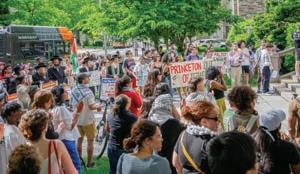
“shame.”
CALVIN K. GROVER / THE DAILY PRINCETONIAN
Divestment from Israel was a core demand of pro-Palestine protesters last year.
CALVIN K. GROVER / THE DAILY PRINCETONIAN Figure looks out onto protesters in McCosh courtyard.
Princetonians struggle to come faceto-face on Israel-Palestine
By Sena Chang & Nikki Han News Contributors
At 4:30 p.m. on Thursday, Nov. 21, Mosab Hassan Yousef, the son of one of the founders of Hamas, addressed a crowd of 350 in McCosh 10.
Yousef, a brash, outspoken supporter of Israel, rejected the idea of Palestinian ethnicity, stating that the notion was “psychological” and rooted in “a narrative of victimhood.” Yousef was greeted with raucous applause.
“Many people mix between Arab and Palestinian, and within the Palestinian is indoctrination. It’s not an ethnicity, it’s not a race, it’s not a religion, it’s just indoctrination, a political ideology,” he said.
Hosted by Chabad House at Princeton, B’Artzeinu, and Tigers for Israel (TFI), the room of 350 was overwhelmingly filled by members of the public.
At the same time, approximately 980 feet away, an event constructing a case for the legal recognition of Palestinians was underway. Rabea Eghbariah, a human rights scholar and legal expert, was introduced by an applauding audience in Robertson 002 as part of the Princeton Palestinian Studies Colloquium. The event, sponsored by multiple departments on campus including Near Eastern Studies and African American Studies, packed the room of about 120.
Neither event saw protests or any other form of disruption inside or outside the venues, and both proceeded without incident, merely a few hundred feet apart.
Even so, opposition to the “Son of Hamas” event circulated quietly. Days prior to the “Son of Hamas” event, leaders of the Alliance of Jewish Progressives (AJP) had called on community members to boycott the event in an open letter with over 170 signatories. “By allowing speakers like Yousef on campus, Princeton is serving nothing but the perpetuation of hateful rhetoric,” the letter read. “Free speech is important, but so are its limitations.” The group presented the colloquium event as counter-programming to Yousef’s event.
The Center for Jewish Life reportedly declined to sponsor the Son of Hamas event, although the talk was sponsored partly by CJL-affiliated organizations B’Artzeinu and TFI.
These parallel events, isolated and sparking brief controversy without chaos, reflect a broader campus climate on Israel and Palestine that students engaged on multiple sides of the issue described as relatively civil, yet ideologically siloed.
For Associate Professor of Politics and Public Affairs Andy Guess, who studies polarization, dialogue between conflicting perspectives is essential for a thriving University campus, and on a larger scale, for a thriving democracy.
“You’re likely to be able to collectively come to a fuller understanding of something by sharing knowledge and per -
spectives,” he said. “We learn from each other and we can help each other get past our own blind spots and flaws in each other’s reasoning.”
In an interview on C-SPAN on Wednesday, University president Christopher Eisgruber ’83 touted what he views as the University’s success in effectively providing opportunities for dialogue for students.
“We had a number of different events that allowed people to explore these issues in more detailed ways,” he said, citing speaker events held by Amaney Jamal, the Dean of the School of Public and International Affairs (SPIA).
“We’ve got to take those conversations on tough issues that are happening on our campuses and elevate them,” he added. “I think we’re doing a good job with that.”
Yet, students across the aisle on the issue reported to The Daily Princetonian that conversation over this one issue is nonexistent among the undergraduate body.
“I don’t really believe there is much opportunity for opposing sides to engage in conversation,” said Mariam Elawady ’26, the former president of the Princeton Arab Society.
A siloed campus climate
To students on both sides of the issue, the weight of the conflict makes such dialogue deeply challenging, and even unbreachable.
For TFI President Maximillian Meyer ’27, the question of whether or not to engage with pro-Palestine groups reflects deeper fundamental differences in perspective. In a statement to the ‘Prince,’ he expressed that it is “difficult to have true conversations with those who refuse to condemn Hamas terrorists.”
At the same time, Meyer is not necessarily opposed to en -
gaging with pro-Palestine activists, but he is not optimistic that they will engage back.
“Siloization has a simple solution. End it. I am ready to talk and am waiting for anyone who is pro-Palestinian to take my offer.”
When asked if he or TFI has made attempts at dialogue with pro-Palestine groups, Meyer said that the “anti-Israel groups on campus have a proven history of being anti-intellectual and anti-engagement. It’s a shame, really.”
Hiba Siddiki ’25, a pro-Palestine supporter, argued that dialogue across different ideological communities is insurmountable, considering the scale and stakes of the current war, invoking the loss of life.
“There are people on one side whose family members, whose people that look like them, are dying by the hundreds of thousands, and you have another side, saying that they feel very apathetic to this, or that they have been supportive of this,” Siddiki said.
“I think that many times when people are very strongwilled in their beliefs and their views, it can be difficult to come to a point where dialogue can exist,” she added.
“You don’t go around asking oppressed people why they don’t have conversations with their oppressors,” Siddiki said.
For students advocating for action from the University, dialogue may be necessary.
The inquiry to divest from Israel currently before the Resources Committee of the Council of the Princeton University Community (CPUC) requires broad campus “consensus on how the University should respond” to the issue at hand for any divestment proposals to be taken into consideration.
But not everyone agrees that discourse is productive. For the
pro-Palestine cause, discussion validates the other viewpoint, which they view as a fundamental wrong.
For Princeton Israeli Apartheid Divest (PIAD) organizer Aditi Rao GS, a year’s worth of discourse has “to some extent, naturalized genocide as an activity.” While students are more aware, Rao believes that this awareness has produced normalization, not outrage.
Elawady believes the student body, more broadly, has become increasingly “complacent,” despite activists on both sides continuing to pursue dialogue. In a statement to the ‘Prince,’ she described how, this semester, “There was an uptick [in discussion] after the invasion of Lebanon … but it quickly died down for many.”
Guess said that this type of divided atmosphere “is not necessarily an unusual dynamic.”
He explained that with any contentious issue, activists will employ “rhetorical strategies … designed to mobilize and energize their members,” but these very same strategies may also “alienate people.”
Opportunities for dialogue
Even during past periods of political upheaval abroad, the campus climate was similarly tense and charged, but discussions were not always so isolated.
In 2014, a 50-day-long conflict erupted after Israel launched an offensive into Gaza, citing Hamas rocket fire and threat of attacks. According to a UN Human Rights Council report, 2,251 Palestinians (including 1,462 civilians) and 67 Israeli soldiers (and six civilians) were killed.
The afternoon following the collapse of an October ceasefire between Israel and Palestine in the Gaza Strip in 2014, over 500 community members marched down Nassau Street, chanting
slogans of “Not another nickel, not another dime, no more for Israel’s crimes” and “Killing each other is a crime, free, free Palestine.”
Community members also called for direct negotiations between pro-Israel and pro-Palestine groups. “Peace cannot be imposed. It can only be reached through dialogue, negotiation and compromise,” a 2014 op-ed reads.
In response, Jamal and SPIA professor (and former US ambassador to Israel) Daniel Kurtzer together created “conversations about peace,” a term they coined, Kurtzer said in a recent interview with the ‘Prince.’ This was intended for student activists on conflicting sides to engage in constructive dialogue and “open their minds to ideas that they had not thought about.” Kurtzer recalled an hours-long dinner at his home that Jamal and about 12 student leaders attended, and how, “it worked to a certain degree.”
“If I had one wish now, after October 7, is that we would have done, or could have done, the same thing,” he said. “There haven’t been that many opportunities to translate October 7 and the protests and so forth into a learning opportunity,” he added, although he did note events that Jamal has hosted. Jamal, who is Palestinian, did not respond to requests for an interview. She and Keren Yarhi-Milo, her counterpart dean at Columbia University, held an event last November to discuss the conflict and its implications for college campuses — repeatedly held up by Eisgruber as an example of model discourse. Yarhi-Milo is Israeli and served in the Israeli Defense Forces during mandatory military service.
“If you care about this conflict, we need to be dialoguing with one another,” Jamal said
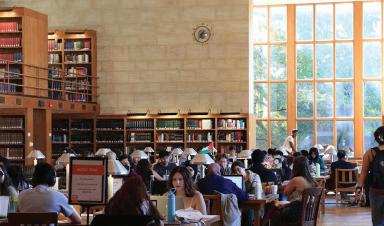
at a similar event held virtually over the summer. “At the end of the day, university campuses shouldn’t be social media algorithmic outcomes where you only are in your echo chamber.”
University administrators, including Jamal, also discussed student dialogue at a panel in November, highlighting initiatives such as the Rose Castle Society and a mandatory discussion prior to the election about conversations on difficult topics as part of the First Year Residential Experience (FYRE) program. The discussion took place at a meeting of the Council of the Princeton University Community (CPUC) — a gathering of top administrations often sparsely attended by undergraduate students.
“ I resonate with the sentiment that things are siloed,” Emanuelle Sippy ’25, the president of the Alliance of Jewish Progressives (AJP), said. “And I do think that is a negative thing, in large part because there’s a lot of misinterpretation that happens.”
However, Sippy noted that progressive Jews — especially those who are practicing — “may be a bit outside the paradigm of things just being siloed.” Though Sippy does not identify as a Zionist, she noted that her identity as a practicing Jew “necessitates engaging with the wider... Jewish community, which often means engaging with Zionist institutions and individuals.”
Other Jewish student leaders agreed.
“I would pretty passionately reject the notion that any kind of conversation around Israel or Palestine within the Jewish community has stagnated, or that it’s reverted into echo chambers,” Center for Jewish Life (CJL) student president Stephen Bartell ’25 said.
For Bartell, the event held commemorating the one-year anniversary of Oct. 7 is an example of healthy discourse between Jewish groups. In the lead-up to the memorial event, Bartell described how representatives from J Street, B’Artzeinu, Chabad House, and TFI held weekly meetings with
the CJL that sometimes became contentious.
“What kind of things would we choose to recognize or not emphasize?” Bartell recalled discussing with the event’s organizers. As a result, these weekly meetings often ended in “aggravating frustration for some of us,” Bartell recalled.
Despite this, Bartell said that organizers were able to hold a memorial that was “really meaningful for our community.” This sentiment was echoed by Meyer, who acknowledged that there were disagreements in the meeting, but still wrote to the ‘Prince’ that he was ultimately “proud of the event that we produced and of the many voices who took part.”
At the memorial, an emotional Bartell shared memories of his friend, 22-year-old Omer Neutra, who was taken hostage by Hamas. “All human beings deserve the kind of safety, dignity, and hope for a better future that Omer and so many others have been tragically denied this past year,” he stated.
The Israeli military said on Dec. 2 that Neutra, previously believed to have been alive and held in Gaza, was killed in fighting on Oct. 7.
Sippy, alongside those from Muslim, Jewish, Christian, and Hindu groups, spoke at an interfaith vigil the following day to grieve “all those killed in the last year in the Middle East.” Sippy remembers the vigil she organized in a similar fashion to Meyer: “We were able to engage people across differences in that event, because we had hard conversations and were honest with each other about what it was that we were trying to do,” she said.
“It’s important that universities serve as a safe space to discuss controversial topics. This should include controversies on both sides of the political spectrum,” SPIA professor Udi Ofer said, reiterating a sentiment shared by University administrators, as well.
“If dialogue didn’t happen on a regular basis, then universities wouldn’t function,” Guess said. “And I think the knowledge production function
of universities would break down.”
The silent majority Students who are heavily involved in either pro-Palestine or pro-Israel activism, however, do not actually constitute the majority of the student body. Additionally, the number of students attending pro-Palestine protests has noticeably abated over the past semester, especially compared to the “Gaza Solidarity Encampment.”
After 150 attended a protest on the first day of classes this semester, only about 60 showed at a protest on Community Care Day. 30 people at a die-in on Oct. 5, part of an International Day of Action campaign. 15 people at a protest on the anniversary of Oct. 7.
On the pro-Israel side, only a few dozen students attended a recent pro-Israel protest against United Nations Special Rapporteur Francesca Albanese, who was giving a Dean’s Leadership Series talk.
Princeton has long been documented to be a more apathetic campus than most.
In a 2001 piece penned by David Brooks, he argues that such apathy is archetypal to Princeton students: while students are industrious, intelligent, and morally conscientious, they have no compelling reason to rebel against the status quo through protests or social movements.
Activists on campus, however, reject the notion that students are not engaged because they are inherently apathetic.
“[T]here are a lot more nuances and a lot more reasons why the student body might be nervous to show up,” Siddiki said.
According to Siddiki, part of students’ reluctance to engage can be attributed to the “active suppression and repression of one side’s view through a variety of channels” in the University community, including doxxing and blacklisting from jobs.
Sippy and others concurred with the risk of outside backlash.
“Students who are most mar -
ginalized and most visibly Muslim and BIPOC are the most frequently the victims of doxxing efforts,” Sippy said.
Others say that a charged campus environment has led them to be wary of political expression. “Though I have the right to wear my keffiyeh wherever I want, I know the way that the University has behaved, the way that certain students at this University have behaved, [and] the way that students and faculty at this University have behaved,” Rao said. “That’s no longer a safe activity for me to pursue.”
Last semester, Rao was one of 13 students arrested for participating in the Clio Hall occupation.
Faculty members involved in the “Gaza Solidarity Encampment” last semester have expressed similar concerns. History professor Max Weiss, who walked his students out to the GSE last spring, was placed on probation this October for the remainder of the 2024–2025 academic year. Gyan Prakash, the Dayton-Stockton Professor of History who taught a class at the sit-in, was issued a written warning “in spite of the fact that none of my students complained.” Prakash said that he has since submitted an appeal, which is currently under consideration by the University.
“It’s fair to say that the administration of the University is meting out discipline to both students and faculty in a manner that both seeks to establish its new rules and procedures — whether or not they were enforced in the spring — and would like to see some kind of chilling effect,” Weiss told the ‘Prince.’
University spokesperson Jennifer Morrill wrote in a statement to the ‘Prince’ that “the purpose of regulation and discipline at Princeton is to protect the well-being of the community and to advance its educational mission.”
“Princeton’s rules include an expansive and unwavering commitment to free speech — which includes peaceful dissent, protest, and demonstration. We held fast to that
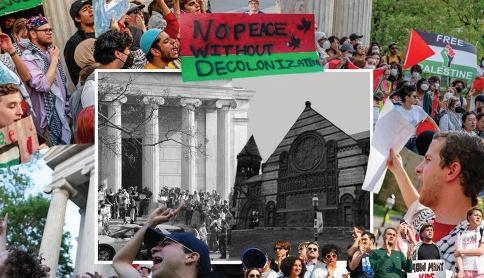
commitment last year and will continue to do so,” Morrill added.
For Meyer, pro-Israel students also face a hazardous campus environment.
“I know that there are definitely students, at least on the pro-Israel side of the issue, who just feel deeply uncomfortable, sometimes intimidated, to share their opinions in the face of a hostile and loud minority,” he said.
Ofer pointed to coming government-level threats to student safety. “I worry that organizations and students who are involved in protest movements on campus will start being the subject of unwarranted federal investigations, whether by the Trump administration or by Congress,” Ofer wrote to the ‘Prince.’ “Such investigations could have a serious impact on the willingness of students to express their views on campuses across the nation.”
“I worry that the incoming administration will begin to punish speech that is critical of Israel’s policies and practices, which will then have a chilling effect on speech and other expressive activities,” he added.
Sippy also pointed out that while students may be informed about the war, they could be choosing to simply prioritize other responsibilities.
“There’s a difference between having a critical analysis and learning about an issue — which is great, and which a lot of Princeton students are open to doing — and publicly taking action,” Sippy noted. Alongside the risk of doxxing, “people are pressed for time and juggling a lot of different priorities,” she said.
Indeed, the number of students who have publicly signed on to various petitions on the matter remains limited. While more than 30 affinity or activist student groups endorsed PIAD’s proposal to the Resources Committee, only 226 current undergraduate students had signed an open letter supporting divestment as of the end of last semester. A petition circulated by Meyer in September opposing divestment garnered nearly 1,300 signatures, only 106 of which were from current students.
Additionally, many students, Guess says, “might not feel that any of the most vocal voices are fully representing them.”
“This is not an issue where there’s literally two positions, right?” He added. “I think there are many, many, many different ideas and perspectives, and certainly more than two.”
By 6:15 p.m. on Nov. 21, both Yousef and Eghbariah concluded their remarks, each receiving thunderous applause. While some attendees lingered behind to discuss the talks with other peers, most donned their coats, filed out of McCosh and Robertson, and carried on with their evening.
“People are thinking critically, but that doesn’t always translate into action,” Sippy believes. “Saying that people are apathetic is a short change.”
Sena Chang is a News contributor for the ‘Prince.’
Nikki Han is a News contributor for the ‘Prince.’
Malia Gaviola / Daily Princetonian
The ‘process’: How change happens under Eisgruber
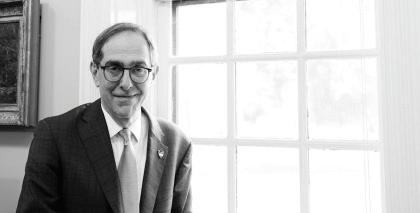
By Bridget O’Neill Head News Editor
In November 2015, student protesters from the Black Justice League (BJL) occupied the office of University President Christopher Eisgruber ’83 during his office hours, commencing a 33-hour sit-in. The students came prepared with a list of demands, which included mandated cultural competency training for faculty and staff, an ethnicity and diversity distribution requirement, and the removal of the name of Woodrow Wilson Class of 1879 from the then-named Wilson School and College.
The protesters had ensured — through hand delivery — that their agenda came across Eisgruber’s desk. From the vantage of this desk, the University president then considered the unexpected visitors sitting in 1 Nassau Hall, their demands, and his next course of action.
After the protesters walked out of Nassau Hall nearly two days later, Eisgruber had agreed to a list of revised demands.
Reflecting on the moment, President Eisgruber told The Daily Princetonian this fall that it was “a bad idea” to have discussions with protesters while they occupied his office.
Following prolonged proPalestine activism in the spring, this scene of the BJL sit-in takes on new relevance — not for its impact on the University’s history of racial reckoning, but for how the sitin permanently altered Eisgruber’s understanding of his own role in responding to student demands.
“It’s not the particular conclusions that I think we could have done better with, but that the process felt unfair to a lot of the other parts of the community,” Eisgruber said. He observed that community members felt “some people
were getting a greater say” in decision-making and that “moreover, they were getting a greater say in them by virtue of having done something that broke the rules in some way.”
He cited two particular lessons that he has carried with him since the BJL sit-in: “the importance of being clear about notice around the rules,” and “the importance of respecting our community-wide open processes.” In the decade since, Eisgruber has been stricter with the rules, guarding his office door by referring the demands of protesters to formal administrative processes.
“Whether students protest or not, I encourage them to engage with the community-wide processes through which policy is made at the University. That is how change happens at Princeton,” Eisgruber later clarified in a written comment to the ‘Prince.’
In interviews with the ‘Prince,’ student protesters who participated in activist movements at various points across Eisgruber’s 11-year tenure expressed the same frustration. They view his steadfast commitment to procedure as a roadblock in the path to progress, making change feel problematically slow-moving and impersonal.
Others in the University community see things differently. Some faculty members stand with Eisgruber’s by-the-book approach, lauding official processes as a fair and measured way to handle ideological disputes. For some, this support is caveated by the belief that more can be done to engage critically with students.
While Princeton’s processes to assess contentious issues have been tested time and time again over Eisgruber’s tenure, they’ve come under heightened scrutiny in the past year after a “Gaza Solidarity Encampment” arose on Cannon Green at the
tail end of the spring semester.
The sit-in was driven by a perfect storm — a divisive and controversial conflict in the Middle East, steadfast commitment to protests throughout the fall and spring semesters, and a wave of similar encampments on college campuses across the country. As a result, protesters actively sought disruption and pushed the boundaries of what protests could look like on Princeton’s campus — employing tactics ranging from vandalism and occupying a building to peaceful marching and hunger strikes. In this new culture of protest, rigid, distant procedure no longer seemed to meet the moment
When the protesters attempted to cooperate with formal channels early in the spring — submitting a petition to the Council of the Princeton University Community (CPUC) in February demanding divestment from Israel — their efforts were initially rejected without the promise of a formal process. It was not until the prolonged sit-in took hold on north campus, 15 students were arrested, and 17 students resorted to a hunger strike that pro-Palestine activists were offered a formal channel. Their divestment petition is now being considered by the CPUC Resources Committee.
Emanuelle Sippy ’25, a student organizer who participated in negotiations with administrators in May, told the ‘Prince’ she trusts the Resources Committee’s evaluation process. But when asked if she has faith in the processes to follow, governed by Nassau Hall and the Board of Trustees, she responded, “No.”
With a University president who has tightened his grip on procedures, and activists who claim that they stall change and lack clear direction, students are left to wonder: does
procedure lead to change, or beckon students to disrupt it?
The ‘promise’ of a process There is no monolithic process — and in some cases, no formally outlined process at all — to bring about policy change at the University.
Advocates backing demands that do not explicitly target the endowment — like the BJL’s call for a University-wide racial reckoning — are left without formalized guidelines to affect change. Without a clear process, their demands simply faced Eisgruber — or rather, sat at his feet.
Following the 2015 sit-in, some community members expressed dismay at Eisgruber’s approval of the BJL’s demands. Students created petitions condemning the demands, with one calling “for increased dialogue and the creation of a process that properly considers the input of all students and faculty, not merely those who are the loudest.” Prominent alumni, including Ted Cruz ’92, weighed in with their own op-eds and petitions.
Retrospectively, Eisgruber shared that the changes that came out of the 2015 sit-in “were regarded with suspicion or with greater opposition than they might otherwise have been,” because they were not evaluated through community-wide processes.
For advocates specifically seeking changes in the management of the University’s endowment, such as the 2020 fossil fuel divestment petition and this fall’s Israeli divestment proposal, there is a clearer path.
First, a proposal must be introduced and considered by the CPUC Resources Committee, which considers policy questions about the University’s financial resources. Once the committee agrees to take up the proposal, they formulate
a method to collect community feedback and determine whether there is “consensus” — a process which concluded four weeks ago for the Israel divestment proposal. The committee then deliberates and decides if it will issue a recommendation, which is delivered to Eisgruber and the Board of Trustees.
Eisgruber’s emphasis on procedure, in part, moves the focus off of him and onto the undefined threshold of community consensus.
“The discussions actually have to take place as part of a community-wide process. It can’t be that the University talks to some people who have an interest in an issue, but not to others on the basis of a protest,” Eisgruber said.
While the feedback process engages the community, the final decision belongs to Nassau Hall.
“At Princeton, power lies in Nassau Hall alone, and ultimately President Eisgruber himself,” longtime public policy professor Stanley Katz argued in an interview.
“Princeton has become an unusually hierarchical, topdown institution,” he noted. “And I think everyone is really aware that on matters like this, the only opinion that really matters is that of the President.”
Eisgruber concedes that community-engaged processes still ultimately come down to him and the board. When asked if he would advocate for a recommendation from the Resources Committee in good faith to the board, Eisgruber said, “Depends what the proposal is, right? That is, in other words, I don’t regard it as my role in that process to simply be an advocate for a committee.”
“I do think I need to be an advocate for a process and a protector of that process, but
CALVIN GROVER / THE DAILY PRINCETONIAN President Eisgruber in his office at 1 Nassau Hall.
it’s really important that our process involves independent judgments, both by the committee and by the Board of Trustees,” he continued.
Daniel Kurtzer, professor of Middle East policy studies at SPIA and former ambassador to Israel and Egypt, judges Eisgruber’s approach as diplomatically sensible.
“What we try to do in diplomacy is think very carefully about what the national interest is before we even get started,” Kurtzer said, likening Eisgruber to a statesman. “It sounds terribly boring when you want something to happen yesterday, but it can lead to better decisions and better outcomes.”
When do we want it? Now. Student activists, no matter the movement, almost always feel a sense of urgency and importance for their cause. This sentiment echoes in a popular call and response chant used in protests by many activist groups: “What do we want? CHANGE. When do we want it? NOW.”
“The processes really don’t act fast enough to deal [with] issues — whether climate change, whether it’s genocide, whether it’s other issues that are really timely and don’t have years,” Hannah Reynolds ’22, a coordinator of Divest Princeton, said in an interview with the ‘Prince.’
But at Princeton, change can’t happen “yesterday.”
Since 2015, several student movements have attempted to follow procedure, using protests as a way to get their demands heard by the proper committees. Often, access to the processes Eisgruber promotes has required escalation.
In 2019, students staged a sitin on the lawn in front of Nassau Hall protesting the Title IX office’s handling of sexual misconduct complaints. Nine days into the demonstration, Eisgruber walked past chanting protesters and into Prospect House to meet with student organizers from Princeton Students for Title IX Reform (PIXR).
The meeting came amid national media coverage of the sit-in, alumni withholding donations from the University, and impending preparations for large end-of-year events widely attended by alumni, like Reunions and Commencement.
In an audio recording of the 75 minute meeting, Eisgruber consistently reiterated the importance of procedure.
“I think it’s really important that those changes go through University governance processes. There are a lot of reasons for that. One reason is that those processes allow people with different interests and different viewpoints to participate fully, and that enables us to produce better policies that really have the support of the community,” Eisgruber told protesters.
Throughout Divest Princeton’s campaign for divestment from fossil fuel companies, organizers felt a degree of escalation — like the sit-in — was necessary to have their demands considered.
Reynolds specifically identified the campaign to withhold alumni donations as a moment that seemed to give them “more leverage than the process itself,” Reynolds said. Reynolds claimed that in
private meetings with administrators, the University was not engaging in “good spirited debate,” but rather placing emphasis on the integrity of University processes.
“They were trying to push us to give up or just trust in the professors who are making these decisions or trust in the board. It wasn’t something where students and faculty and alumni all have this equal input into the process,” Reynolds said.
Reynolds said she felt like Eisgruber in particular attempted to discourage further protests in these discussions. In one such instance, she claims President Eisgruber called her to his office to get a better sense of where protesters were coming from after students reportedly heckled and chased him and his wife. He reportedly specified that the meeting would not be about divestment, yet shared his own perspective on the issue during the interaction.
“It is the kind of thing that we’ve seen time and time again — the administration trying to, in some ways, turn student activists against their own work by trying to convince them that they’re just not seeing the whole picture,” Reynolds shared.
In a comment to the ‘Prince,’ Eisgruber disputed this claim, emphasizing the University’s vigorous protection of the free speech rights of students and faculty.
“Activism has a long and important tradition on this campus and in this country, a tradition I honor and respect,” he wrote.
In his view, he invited Reynolds to his office to better understand her views and “identify opportunities for constructive dialogue.”
“As far as I could tell from the meeting and the emails we exchanged afterward, we both thought that the conversation served those purposes,” Eisgruber stated.
Both the Title IX meeting and Divest Princeton meetings left students feeling frustrated over the purpose of the meeting, which seldom deviated from previous University statements emphasizing procedure.
A day into the Title IX sitin, the University responded by sharing that they referred students’ input to the appropriate committees, namely the Faculty-Student Committee on Sexual Misconduct and the University Life Committee. A few days into the protest, Eisgruber also approved an internal and external investigation of Title IX procedures.
Most frustrating to organizers, however, was the slowmoving nature of the procedures Eisgruber advocated in meetings. Throughout the meeting with PIXR organizers, protesters became more and more agitated about the sluggish nature of the University committees evaluating their demands.
Eisgruber clarified to the protesters in 2019 that he had no say over the schedule of meetings within the committees and had to respect the committees’ “responsibility and authority to set its own agenda.”
Despite going through the official channels, organizers told the ‘Prince’ they feel there has been minimal consideration of the 11 demands
first presented on the lawn of Nassau Hall in the four years after the protests. In an oped published in 2023, PIXR co-founder Tori Gorton ’21 expressed her grievances over the little change that occurred after the creation of the CPUC Ad Hoc Committee on Sexual Climate, Culture and Conduct, which was formed to consider the group’s demands.
Changes have occurred since 2019. Reports outline changes like one new SHARE clinician, a new four-year curriculum being developed by SHARE, a new Global Safety and Security unit, and new websites with more information about Title IX procedures and emergency funds available.
Divest Princeton organizers say they also faced a long and confusing path to change through these procedures.
After several years of protests, the passage of an Undergraduate Student Government referendum on divestment from fossil fuels, and a recommendation from the CPUC Resources Committee for divestment, the Board of Trustees announced their decision for selective dissociation in 2021.
Slow action has led to distrust with these processes.
In an interview with the ‘Prince,’ Gorton said that PIXR leaders were in communication with students from the Black Justice League sit-in who warned them not to put their faith in the University’s committees.
“The Black Justice League was saying, ‘This is what the University does. They’ll slap a working group or a committee on anything that students bring up to make it look like they’re doing something,’” Gorton said. “But really, it’s a way to dilute what the problem is into lots of different buckets … it’s a very, very, very slow path to any change.”
Necessary escalation
When asked if they felt escalations were necessary to have their demands considered by the University, both postdoctoral research scholar Jessica Ng and Urvi Kumbhat GS, organizers for Princeton Israeli Apartheid Divest (PIAD), answered yes.
Nine days into this year’s encampment, PIAD announced students would be participating in a hunger strike until administrators met a list of demands. The first demand, a meeting with administrators, was fulfilled soon after the strike began.
Sippy, who was present at the meeting, said that organizers were again deferred to institutional processes.
“I think that they wanted the hunger strike to end, and they wanted the encampment to end, because it is in their interest for things to appear pristine for alumni-facing, end-of-school events,” Sippy explained in an interview.
Prior to the encampment, student protesters attempted to have their demands for divestment from Israel considered by the Resources Committee as far back as February. Yet, the process was not activated until the encampment.
Describing the group’s strategy going forward, Ng shared that they will be using the existing channels despite feeling they are insufficient while “applying pressure at every point to actually move [demands] through the existing chan -
nels,” signaling the continued use of protest.
“It’s also important to question, really, the utility of these processes in the first place and their ability to respond to protest,” Kumbhat said.
These organizers cited concerns that echoed organizers of past protests; namely, the slowmoving actions of the committees and confusion over what it meant to reach consensus.
Although pro-Palestine protesters submitted a formal proposal to the Resources Committee in June, they had to wait over summer recess for the first step of the community consensus evaluation process to begin at the October CPUC meeting. It is unclear when the Resources Committee will conclude deliberations.
When the feedback system was introduced, Chair of the Resource Committee and Professor of Chemistry John Groves explained that the Resources Committee operates by considering three criteria. The item must “have a sustained interest on campus,” there must be a “direct contradiction with the simple value of the University,” and there must be a “strong consensus regarding what to do,” he told the CPUC.
“This whole idea of consensus is quite unclear. What defines consensus?” Ng asked. “It was unclear if they were seeking consensus on whether these violations of international law and human rights were actually occurring … or whether those violations are contrary to Princeton’s core values of humanity and scholarship,” Ng told the ‘Prince.’
At the Nov. 11 CPUC meeting, Ng posed the same question.
University Chief Financial Officer Jim Matteo responded, “the University is seeking consensus on the actions the community believes we should take in relation to the proposal it receives.”
During the same meeting, Matteo shared that there is “no prescribed timeline” for when the committee might submit a report.
In a comment to the ‘Prince,’ Groves wrote that the Resources Committee will use “its judgment, informed by community input” to determine whether there is consensus around divestment. He further defined consensus as “widespread deliberative agreement.”
University Spokesperson
Jennifer Morrill explained in a statement to the ‘Prince’ that “the trustee guidelines on dissociation ask the Resources Committee to determine whether ‘consensus is possible’” on “both the general issues and the specifics of the proposed action.”
“The trustees noted that the guidelines are ‘not automatic or definitive,’ but rather are intended to serve as a ‘practical and useful tool,’” Morrill added. “In establishing them, the trustees recognized that it will be necessary to make caseby-case judgments.”
Capacity for a new ‘process’
Several members of the faculty told the ‘Prince’ that administrators need to balance procedure with more informal responses, like face-to-face time with students.
“I understand you have zillion and other things to do, but at the same time, I think it should be viewed as part of what administration is — its
responsibility to have faced our students, formally and informally,” Lecturer of Public Policy and former Prime Minister of the Palestinian Authority Salaam Fayyad shared in an interview with the ‘Prince.’ Katz said he would advocate for a middle ground in which there is ongoing communication between students and administrators. “The University has to protect itself, but students have to be heard, and these are students who are there because they think important principles and interests are at stake,” he said.
Katz criticized the deferral of demands to the CPUC committees, many of which evaluate the demands of student protests.
“I don’t think it would be a meaningful way for students to express discontent, and that there ought to be more informal and more direct modes,” he said. “I think that’s too lawyerly a response.”
Katz noted that the CPUC was founded in 1969 in response to student activism, saying, “The University was trying to figure out how to bail itself out of the Vietnam protest mess, [when] a very smart faculty member … was asked by the President to figure out a way of calming the community down. That way was to create the CPUC.” Now, minimal communication between students and administrators leads activists to escalate protests in hopes of securing face time with the president.
Eisgruber’s sparse interaction with students has been a point of scrutiny throughout his presidency, especially following the BJL sit-in. In a 2023 interview with the ‘Prince,’ Katz shared that he felt President Eisgruber was “notably isolated.”
“I think he can be more effective if he could manage to spend more time with more people,” Katz added. Eisgruber holds scheduled conversations with students at residential colleges.
Eisgruber’s approach has mostly kept Princeton out of the national spotlight, even as elite universities have increasingly served as battlegrounds for culture war issues and media frenzy. A 325-page October report by House Republicans criticizing universities’ handling of pro-Palestinian protests made no mention of Princeton, despite calling out peer institutions such as Columbia, Harvard, the University of Pennsylvania, and the Massachusetts Institute of Technology (MIT).
But while University procedures are seemingly successful in placating outside observers, on the inside, community members are walking away from them unsatisfied.
“Telling someone to go to the ‘committee on policy’ or something is telling them to forget about it until next term, right?” Katz reflected.
“That’s not an answer — that’s not a satisfactory answer.”
Bridget O’Neill is a head News editor for the ‘Prince’ from Palm Beach Gardens, Fla. who typically covers the University administration.
The Class of 2025, by the numbers: Our annual senior survey
Scan for the full survey

By The Daily Princetonian Staff
Welcome to The Daily Princetonian’s fourth annual survey of the senior class. The data within this writeup — compiled and verified through months of planning, outreach, and analysis — tell a bit of the story of the Great Class of 2025, the last graduating cohort to experience an academic year at Princeton during the COVID-19 pandemic.
Demographics
We asked the Class of 2025 questions about their identity, background, and geographic origins. Sixty-five percent of Princeton seniors are white, around 20 percent higher than the national enrollment average of white students of 41 percent. Around 90 percent of Princeton seniors report owning at least one home or property compared to the national average of home ownership of 65 percent. Read on to learn more about the fundamental demographics of the Class of 2025.
Identity
Among the Class of 2025, 68.7 percent are straight. The majority of respondents are white, comprising 65 percent of respondents, and 12.7 percent are Hispanic or Latine. 47.3 percent of the Class of 2025 had one or more parents or guardians receive a master’s or professional degree.
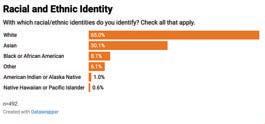
Background
The vast majority of members of the Class of 2025 don’t have any other family members who attended Princeton. However, legacies are overrepresented in certain eating clubs — in Ivy, Charter, and Cottage, 40, 36, and 35 percent of members have some form of legacy, respectively. Those three clubs also have the highest percentage of members who come from families that make over $500K per year. 16.8 percent of students reported having an annual total household income above $500K, a three percent decrease from last year’s graduating class.
Geography
A relatively large proportion of the Class of 2025 comes from
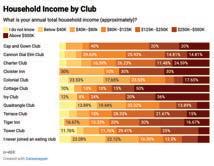
Princeton’s native New Jersey — over 18 percent. New York state is home to the next largest percentage of Class of 2025 Princetonians with 13.17 percent, and at 11.38 percent of the graduating class, California follows closely behind. Meanwhile, none of the 501 respondents to this year’s survey hailed from Alaska, New Mexico, Kansas, South Dakota, Delaware, or Iowa. Most of the other states range from having 0.22 to five percent of students, with larger states and states closer to Princeton’s campus having more seniors.
College Life
Sports, eating clubs, parties, substances, and mental health:
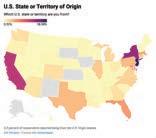
The Class of 2025 has lived through the many ups and downs of college life at Princeton, whether going to therapy, exercising at the Class of 1986 Fitness and Wellness Center, or partying at Terrace Club, the Class of 2025’s favorite nightlife destination.
Daily Life
First-year fall is a chaotic time for many, as students face a multitude of new college experiences; still, it’s when 40.6 percent of seniors met their closest friends. Even more seniors still have friends from orientation activities like Outdoor Action, Community Action, and Dialogue and Difference in Action. For some, residential college ties extend through senior year, as just over a quarter of seniors never lived in upperclass housing. That being said, seniors who are currently on the partial or unlimited University meal plan are the least likely to be satisfied with their dining experience. Among dining halls, Yeh/NCW is once again the favorite among seniors, winning over half of the votes.
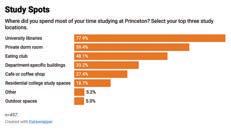
Mental Health
28.7 percent of seniors received mental health counseling or therapy in college — a stark contrast to the 65 percent of Class of 2023 seniors who sought mental health support. The 36 percent decrease coincides with 44 percent of seniors reporting dissatisfaction with the mental health resources that Princeton offers, with another 30.6 percent stating they felt neutral. Those who joined an eating club were very slightly more likely to seek counseling: 27 percent of eating club members sought mental health services both on campus, particularly through Counseling and Psychological Services (CPS), and off campus. Moreover, 25.2 percent of A.B. students utilized counseling services compared to 18.9 percent of B.S.E. students, a 6.3 percent disparity.
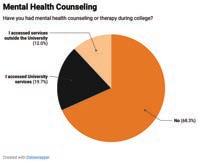
Drugs and Alcohol
With 24 percent of the club’s respondents, seniors in Ivy were the most likely to have been McCoshed — a rate twice as high as the class’s overall average of approximately 11 percent. In contrast, just over one percent of the Class of 2025 has been brought to the new Frist Health Center for alcohol consumption. Overall, just over a third of the class reported drinking alcohol once or twice a week, slightly less than previous class years. In contrast, the percentage of seniors who reported smoking marijuana once or twice a week is roughly in line with the Class of 2024 at 6.3 percent, slightly higher than the Classes of 2023 and 2022.
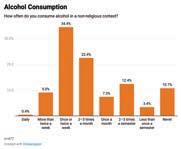
Around 77 percent of seniors have had sex, consistent with the past three graduating classes within one percent. However, the Class of 2025 has had sex less frequently than last year’s graduating class, with over 40 percent of the Class of 2025 responding that they have sex once or more per week compared to 36 percent of the Class of 2024. The Class of 2025 did have sex for the first time earlier, however, with 10 percent more respondents reporting having sex for the first time in high school or their first year of college than their Class of 2024 counterparts. Finally, more people will walk through FitzRandolph Gate in a relationship or situationship than single. Almost 40 percent of respondents reported
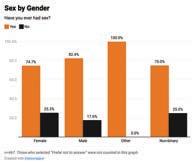
being in a relationship with someone they had met at Princeton. Activities
In light of the multi-phase restoration of Dillon Gym, nearly 70 percent of seniors exercised at least once a week. Nearly a third of the class reported participating in an affinity group on campus. Meanwhile, participation in community service activities saw a six percent decrease relative to the Class of 2024. Only 13 percent of seniors attended a varsity sport event at least once a month, with 9.3 percent of respondents being varsity athletes themselves. Employment rates have remained the same, as almost 85 percent
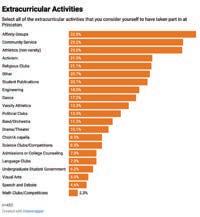
of seniors reported holding a job during their time at Princeton. Social Life
Seniors most enjoy partying at Terrace Club. Tiger Inn is the second most popular party locale among the Class of 2025, yet was bickered by fewer respondents than Tower and Cap and Gown. In Spring 2023, when members of the Class of 2025 were first allowed to bicker, Cap and Gown had its first year with a sub-30 percent acceptance rate, while both Cannon and Tower increased their rates.
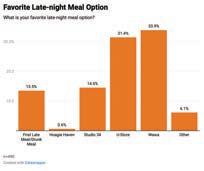
up studying Computer Science than the number who thought they would when entering Princeton, and slightly more seniors studied American Sign Language and Japanese compared to last year. Nearly 50 percent of seniors never earned an A+ grade — probably worse than their performance in high school. Did ChatGPT change how the Class of 2025 approached their Princeton education?
Grades
This year, more B.S.E. students have reported earning a 4.0 GPA than A.B. students, similar to the Class of 2024. The overall distribution of cumulative GPAs has remained broadly consistent with what was reported in the Class of 2024 senior survey. Similar to the Class of 2024 respondents, students in the Class of 2025 who have never played for a varsity sports team generally reported higher GPAs than those who have. About 66 percent of Class of 2025 respondents reported having a GPA higher than 3.7— six percentage points higher than their Class of 2024 counterparts.
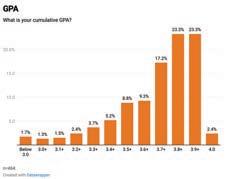
Studies
When the Class of 2025 first entered Princeton, the two most popular majors were Computer Science, with nine percent interested, and SPIA, with 8.3 percent interested. Four years later, 13 percent of the Class of 2025 ended up studying Computer Science, combining both A.B. and B.S.E. degrees, and 8.2 percent studied SPIA — almost identical to the proportion interested in their first year. Electrical and Computer Engineering more than doubled from last year to 6.2 percent of Class of 2025 seniors in the department, replacing Civil and Environmental Engineering as the second largest B.S.E. major. French and Italian made it on the list this year with 0.8 percent seniors, surpassing all other foreign language majors. The majority of the Class of 2025 studied Spanish, French, Chinese, or no language at all. The number of seniors who studied American Sign Language (ASL) rose to 5.1 percent, which is 3.4 percentage points higher than the Class of 2024. ASL now occupies the fifth most popular studied language for the Class of 2025.
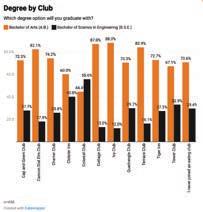
Honor Code
The number of seniors who admitted to cheating rose to approximately 30 percent, around one percentage point higher than the Class of 2024. The number who used ChatGPT on an assignment when it was not allowed rose to 27.7 percent, up by 12.5 percent from the Class of 2024. The Class of 2025, of course, had access to GPT-4o for an additional academic year compared to the Class of 2024. The number of students who knew of a peer violating the Honor Code and chose not to report it increased slightly, and the number of people who reported someone for cheating also rose, though in 2024, zero respondents selected the latter option. Despite the apparent rise in Honor Code violations, however, there was no significant increase in instances where individuals were called before the Honor Committee.
Pre-Princeton
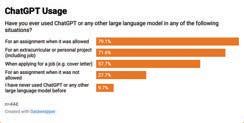
which was designed to counteract the long-term effects of the COVID-19 pandemic and its effects on secondary schooling. Back when they were applying in 2020, only around 14 percent of seniors chose not to submit their SAT/ACT scores. Twelve percent of seniors reported that more than eight people from their high school also attended Princeton, while a majority report only 1–2 Princetonian peers from their same high school, around 65 percent of respondents.
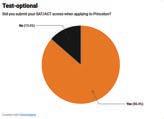
After Princeton
When the Class of 2025 step through FitzRandolph Gate to begin their post-Princeton life, two-thirds self-reported that they will serve the nation or humanity, and over one-third expect to earn $90K or more per year, putting them at approximately the 75th percentile of all Americans.
Career Aspirations
Graduate school or academia is the most common post-graduate plan for the Class of 2025. Still, the proportion of seniors planning to pursue this field has dropped dramatically this year: between 17 to 19 percent of survey respondents indicated that they were pursuing graduate school or academia in the Classes of 2022 to 2024, while this year, as colleges and universities have shrunk or cut entirely graduate school admissions in the face of federal funding cuts, just 12.6 percent of seniors indicated that they were pursuing graduate school or academia. Similarly to the Class of 2024, though, about 65 percent of graduating seniors characterized their post-graduate plans as “in the nation’s service and in the service of humanity.”
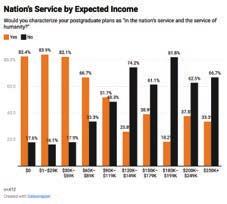
Finances
As other institutions of higher education see a rise in alumni donations, 66 percent of Princeton’s Class of 2025 said they would not donate to Princeton at any point in their lifetime, even though around 45 percent of undergraduate alumni donate every year. Still, over 15 percent reported they would donate directly to the University, while the rest reported they would donate to a specific program at Princeton. Only 12.3 percent of graduating seniors reported that they raised over $20K in one summer, down from 2024 when 17.4 percent reported they made over $20K. Around 47 percent of students planning to get into software engineering made over $20K in a single summer, seven percent higher than finance, the next highest field. Across the board, the most common expected income bracket for graduating Princetonians was still $30K to $59K, consistent with the Class of 2024. The percentage of respondents who said their post-graduation income would be $0, however, rose from 6.3 percent to 8.9 percent.
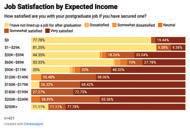
Views
With the conclusion of the 2024 election, we asked the Class of 2025 questions about their political leanings, their vote back in November, and whether or not they regretted voting for their candidate. We also asked them to rate various aspects of campus life, administration, and construction on campus. We also asked seniors how they felt about the state of campus architecture, as Princeton continues to leave the collegiate-gothic style behind for a more modern style.
Political Seventy-five percent of respondents reported voting in the 2024 election, with 75.8 percent of respondents preferring Kamala Harris and nine percent of respondents preferring Donald Trump. After the election results, four percent of respondents recorded that they would vote differently if they knew what they know now. Nearly all of these students were ones who did not vote in the 2024 election to begin with. Though the minority in all eating clubs, the most conservative eating club is Cottage Club,
where 18.2 percent of their members reported very conservative views — in contrast with Terrace, where 44.3 percent of members identified as very liberal. Political views were also reflected in last spring’s “Gaza Solidarity Encampment,” with 47.9 percent of “Encampment” participants identifying as leftist/socialist.
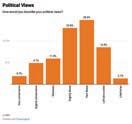
Academic
Princeton academics are hard: 65.7 percent of seniors believe Princeton should not prioritize academic rigor more heavily, and 69.3 percent believe grade inflation is not an issue. However, 50.6 percent of seniors are in favor of grading theses on a pass/D/fail basis, a decrease from the 58 percent of the Class of 2024. With regards to the Honor Code, just 15.5 percent of seniors believe AI usage policies should be made more strict, and 48.4 percent view the Honor Code at least somewhat unfavorably — a decrease from 55 percent of respondents from the Class of 2024.
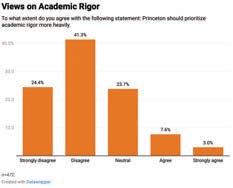
Social
A significant portion of students are dissatisfied with Princeton’s mental health resources, with 30.8 percent disagreeing and 13.2 percent strongly disagreeing that they are adequate. Only 25.5 percent of students expressed a positive view of the mental health resources. Nevertheless, a majority of Class of 2025 students at Princeton report being happy, with 46.3 percent agreeing and 29.4 percent strongly agreeing with the statement “I have been happy at Princeton.”
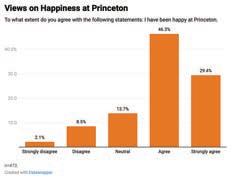
Campus
On a scale of one to five, the architectural style of the Class of 1986 Fitness and Wellness Center received the highest average approval rating of 4.13 among the new buildings on campus. In contrast, the architectural style of the new Princeton Art Museum received the lowest average rating, at 2.55. 57.7 percent of students reported that they felt strongly unfavorable towards on-campus construction, although this represents a slight decrease from 63.7 percent in the Class of 2024 senior survey. 10.2 percent of students rated on-campus housing as strongly unfavorable, slightly higher than the 8.7 percent who viewed it as strongly favorable.
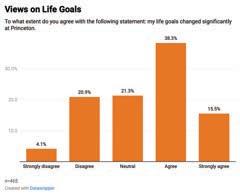
OUTSIDE THE UNDERGRAD BUBBLE
The morning shift: Construction works on campus
By Angela Li, Faith Ho, & Rory Rusnak
Campus is dark. In the distance a bird chirps, and leaves rustle as a squirrel darts into the bushes. Hardtoed boots clank towards the gate.
It is 5:30 a.m., and supervisor Sul Crawford is about to open the Princeton University Art Museum construction site for a long day of work.
Soon workers arrive on the site, and Elm Drive rumbles with trucks and buses carrying materials and workers between the two main construction sites: the art museum and Hobson College. The sound of drilling permeates the air intermittently. During the 15-minute break at 9:30 a.m., strains of a Britney Spears song can be heard on the site. Only later, closer to 10 a.m., does the crowd of students emerge and make their way to class, crossing in front of the trucks and past the sites.
The Daily Princetonian interviewed four construction workers around campus to learn more about the people hard at work in the morning before most students even dream of leaving their beds.
At the start of the day, it’s just one person waiting, and the impassive concrete tucked away behind the construction barriers. Crawford exhaled. “Quiet. Nice and quiet.”
Sul Crawford
On a late October Monday, Crawford took a breather just outside Murray-Dodge Hall in a yellow vest and a white hard hat with his name emblazoned on it. He wore an easy smile and a beard. Crawford is the first person to open the construction site every morning. He lives in Philadelphia, so he wakes up at 3 a.m. to get ready for the hour-long commute to work. As a supervisor, some of his tasks involve giving other construction workers access to the site, keeping the site clean, and managing deliveries of project materials.
“The hardest part of this job is showing up. Once you show up, the rest is easy,” he said. Later, he would have a half-hour lunch break at noon — he likes to go to Frist Campus Center. His day ends at 2 p.m.
As a seasoned construction worker, Crawford has done all kinds of work. He has built dorms, a new hospital, and a Presbyterian Church. When asked how work at
Princeton compares to other projects, he said, “Princeton is real strict, but it’s not a bad thing.”
When asked his favorite part of the job, Crawford said, “Keep it honest, getting paid,” adding, “We got a tight knit crew here, like a family.”
Although Crawford doesn’t interact with students much — mainly being in the job sites other than when he’s at the gates — he has advice for them: “Stay in school and do whatever you’re going to school for.”
Brandon Wesby
Brandon Wesby has been working at the Hobson College site for a month.
“So I’m kind of like a Princeton freshman,” he joked. ”We’re in the same boat.”
On site, he directs the traffic of construction trucks, letting them in and out of the gates. Wesby initially had a career in landscaping at a retirement home, but decided a year ago to follow in his brother’s footsteps after seeing the opportunities heavy highway construction opened up for him.
The 42-year-old native of Lakewood, N.J. currently lives in Jackson Township. His day begins at 5:30 a.m., with the hour-long commute across the state to a parking lot near the University. He then rides a University-provided bus to campus. His work officially begins at 7 a.m., although deliveries do not usually arrive until 7:30 a.m.
Summarizing his experience at Princeton, Wesby — like Crawford — noted a preference for procedure.
“Everything is by the book, by the rules,” he observed. “Safety is first for everybody, and I like the structure they have here.”
Around noon, a cement truck arrived, so Wesby stood up to open the gate for it while parsing out the difference between Class B and Class C construction vehicles to the ‘Prince’ — not included in fear of issuing a less eloquent explanation.
“Look, I’m right back on my butt sitting again,” Wesby said after shutting the gate.
For lunch break, Wesby alternated shifts with his colleague Kenneth. He regularly goes to the RockyMathey Dining Hall either at 12 p.m. or 12:45 p.m. “I love to go to that cafeteria,” Wesby said. “You get a break from here and get to see all the kids.”
Despite seeing students pass by every day, he said he has never had a proper conversation with a student until speaking with the ‘Prince.’
“Everybody is just in their own worlds, so I don’t really stop and ask, ‘Hey, how are you doing?’ he reflected. “But if you come up to me, I’ll talk back.”
Nevertheless, he has found enjoyment in observing the campus from his seat. “Since I never went to college, it’s so cool seeing them look happy, living their lives, and interact with each other,” he said.
Describing his favorite part of his job, Wesby said, “Thursday payday. That’s the goal, we want to make it to Thursday.”
Looking ahead, Wesby said he hopes to become a journeyman, the top-ranked position in construction where an increased payrate reflects their abundant on-site experience.
“For me, I just went to school,” Wesby explained noting it was run by a construction union. “I don’t have any special certificates, so I kind of started at the bottom of the totem pole and worked my way up. As I’m coming up on 1000 hours, I plan to go back to school for a couple of weeks to learn something else that’ll help me in the field.”
At 2:30 p.m., the construction companies started packing up, taking the shuttles back to the parking lot. From 3 p.m. onwards, Wesby begins his second job: fatherhood. With two daughters and three sons, Wesby spent the remainder of his day helping them with homework and spending quality time with his loved ones.
Donald
Donald has been working at Princeton for three years as part of Local 172, the construction union representing heavy and highway laborers in South Jersey. He has been based at the Art Museum site since April 2023 and lives 30 minutes away from the University.
Donald declined to disclose his last name for privacy reasons.
Describing the nature of his daily tasks, Donald remarked, “Everyday is different.”
He and two of his colleagues, at the time, were working on pulling up the concrete pavers behind Dod Hall and jackhammering the blacktop road to install new bike racks. The next day, their focus would shift to digging trenches for electricians to set up the light systems near the building.
However, some parts of his routine remain constant. After arriving at 7 a.m. everyday to work — their usual 6 a.m. starting time, he explained, has become impractical
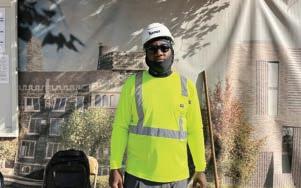
due to the later sunrise — Donald stretches for 10 to 15 minutes.
“Now that the building is up, it is quiet,” he noted.
From 12 to 12:30 p.m., he broke for lunch before returning to work until 4 p.m.
For Donald, this job is a lucrative choice.
“With no college education, you ain’t going nowhere else and make the money we make. Depending on your first job, we make more money than you make,” he said, directed to Princeton’s future graduates.
Donald also said he appreciates the safety guaranteed by his job at the University.
“I love working at Princeton. This is site work,”he explained. “You could end up on a highway, [with] a drunk driver on that highway, and you may not ever go back to work again.”
He recounted how his colleague’s foreman was hit four years ago on Route 42 by a drunk driver.
“It happens. Being on the highway is dangerous,” he added. “Here, what’s going to happen to you? Nothing.”
“All you have to do is pay attention. On the highway, you can’t pay attention,” he concluded.
To Donald, construction work entails much more than physical labor.
“No matter what the trade is, if you don’t band together, you are not going to get anything done,” he reflected. “If someone sat out here arguing day in and day out, this building would not be standing up.”
Mike Cisrow
When the ‘Prince’ met Mike Cisrow, his voice boomed over the whir of construction equipment behind him.
“I’ve been in this industry about
nine years and at Princeton about 14 months,” he said through the construction site’s metal fence.
Cisrow is a seasoned Princeton worker: Prior to his work at the Art Museum, he was on the team for the Dillon Gym site, a position that had him wake up at 4 a.m. every morning for his one-hour commute from Gloucester Township in South Jersey. Now he gets up at 5 a.m., which he said is the “only downside” to what is otherwise “a perfect job.”
Unlike the more “secluded” construction sites he’s worked on, Cisrow said he appreciates the scenery of Princeton’s campus. It checks two main boxes for him: safety and cleanliness. Here, too, he has found community amongst his fellow workers.
“Everyone works together,” Cisrow said. “Everyone plays a part in making everything happen.”
Cisrow’s interactions with students, on the other hand, are mostly peripheral observations he makes in his position as gate guard, guiding trucks safe entry and exit from the job site.
He noted that he sees students getting ready to go to class, playfully adding that they regularly look at their phones, not paying attention as they walk near the construction sites.
The rarity of in-person interactions makes them all the more special, Cisrow said.
“Somebody can make your day just by smiling or laughing. Something like this is making my day,” he told the ‘Prince.’
“Like, wow, I’m really being interviewed!”
Angela Li, Faith Ho, and Rory Rusnak are contributing Features writers at the ‘Prince.’
Parenthood and Princeton: Four transfer students on balancing kids and classes
By Hannah Gabelnick Senior News Writer
Joseph Gonzalez ’28 assumed that having a 10-year-old daughter would exempt him from having to attend Princeton University’s mandatory “Safer Sexpo” sexual education program for new students. But when the 40-year-old father texted his residential college advisor to ask if he was required to attend, he did not receive a reply. To “not give transfer students a bad rap,” Gonzalez entered the Butler College basement, which was filled with upperclass students wielding wooden dildos and condoms, ready to teach first-year students how to have safe sex.
“You can make the argument that nobody needs a safer sex discussion more than people who have chil-
dren because they’ve done it wrong. It’s provable,” Gonzalez said. Gonzalez decided to bring his wife, Angel Capriles, with him, stopping by on their way home from a Student Veterans Association event. “When they saw me with my wife, they were like, ‘You know what? You don’t have to be here,’” Gonzalez said.
Gonzalez is one of 36 transfer students welcomed to Princeton this past August. Many transfer students are the first in their families to attend college. Some come from the military. And 13, including Gonzalez, have partners and children alongside being a full-time student.
In interviews with The Daily Princetonian, four transfer students with children described a delicate balance in their Princeton experi-
ence: taking challenging courses and working with professors not that much older than them — all while being home for bedtime.
“They want to play Barbie”: Balancing Kids and Class
Two years ago, Ridge Jaco ’26 and his wife were planning to sell their house, buy and renovate a school bus, and travel around the country with their two daughters. Then, Jaco got into Princeton. For Jaco, the feeling of being accepted to Princeton was unbelievable. He thought it would be a great opportunity for himself academically and for his children — Paxton, 10 and Aspen, four — to see a new place.
Having kids has shaped how Jaco approaches his Princeton experience. Rather than as a first-year,
Jaco entered Princeton as a sophomore to minimize the time that his family will spend at Princeton.
“I think having kids changes things. I’ve already moved a lot, and I just want to get the moves over with so that we can finally plant roots,” he said.
While many undergraduates spend long and lonely nights in Firestone, for the 31-year-old father, being home for bedtime is a must.
“It’s like a job; it’s your closing hours of the day, where you’re wrapping everything up,” Jaco said. “Every night, we read my youngest daughter stories.”
A man, his wife, his two daughters, and their family dog pose in front of two bronze tigers and an ivy-covered building. Students with families are provid-
ed with several resources to support them and their families, including housing, academic advising, weekly coffee chat check-ins, and childcare stipends, according to Dr. Queenie Reda, an Outreach Program associate for the Transfer Program. For Shaquana Darden ’28, these resources, as well as the public schools in Princeton, were a draw. Her daughter Tamia, 12, has been adjusting well to life at Princeton Middle School, making friends and joining clubs. Her son Zaiden, five, has had a tougher time, transferring between multiple schools due to his autism.
Still, when asked how she balances parenting with school, Darden, who is 37, said, “It’s not as hard as you would think it is, because my kids are old. I just come home and
ANGELA LI / THE DAILY PRINCETONIAN
Brandon Wesby started working at the Hobson College site a month ago.
cook and let them snuggle up [with] me and tell me about their day.”
Meanwhile, Paxton and Aspen are both being homeschooled by Megan, Jaco’s wife. The girls have adjusted well, but because families with children are split between two separate apartment complexes — Lakeside and Lawrence — it can be difficult for them to find community.
“We would love to have all of the families living together, and I think as the size of the families that come in grows, [this] will [become] more and more apparent. It’s something we’re conscious of. There’s just not a perfect solution to it with our current housing stock,” Dr. Jordan Reed, now the director of transfer and veteran initiatives, said.
But the kids still make friends, as kids do.
“I think all the kids in the neighborhood seek each other out,” Jaco said. During orientation, Paxton met Gonzalez’s daughter, Cataleia, and they became fast friends. The two girls hang out often, watching YouTube videos, playing games, and talking together.
Last year, Paxton was close with a boy from India, but once the boy’s father graduated, they moved back home. “He needed Paxton just as much as Paxton needed him,” Jaco said. “They really clung to each other, and they were little besties. The bittersweet part about it is that families are here just temporarily.”
Gonzalez and Jaco have balanced parenthood and school with the help of their wives, who stay at home full-time to homeschool their daughters.
Nathalia Allenza ’25, finds parenting at Princeton much more challenging. Her husband works from home and takes care of their four-year-old daughter, Julieta, during the school day, and takes her to karate and taekwondo classes when Allenza studies in the evening. But she still wakes up at 6:30 a.m. every day to make Julieta breakfast and get her ready for school before heading to class herself.
“I think being a parent is such a heavy weight because sometimes, honestly, I don’t have time to do my assignments,” Allenza said. “I really appreciate that my husband helps me; otherwise, I wouldn’t have allowed myself to do what I’m doing. I would say that support is the key for Princeton,” she said.
The 31-year-old mother said she’s found professors don’t know how to support students who are also parents.
“I’m treated as if I’m younger and don’t have children,” she said. In contrast, when Julieta was born during her second year at Middlesex Community College, Allenza said that “My professors understood that I was a mom and that I had a different background … Community colleges are trained and structured to help adult learning, while universities like Princeton are not prepared to support non-traditional students.”
Parenting can often run up against academics. It has been difficult for Allenza to participate in group projects, as many younger students are only available to meet at night. “I had to meet twice at 9 p.m. because it was the only time [my group] could do it. So, I had to come to campus. To me, that was my time with my daughter,” Allenza said.
Jaco tries not to worry about his grades and says his kids are his highest priority. “Kids don’t care if you make an A or B — they want to play Barbie,” he said.
Gonzalez, however, has been trying to take full advantage of his education. He decided to take six classes during his first semester, instead of a typical four. “It’s atonement for my sins,” he said, referring to the shame he still harbors for dropping out of high school.
He holds himself to a high standard: “I’m an A-minus student across the board, so I’d like to get those grades up,” he said. Now in his second semester, Gonzalez is taking seven classes. After this semester, he will have already completed all the requirements for a minor in Humanistic Studies.
“I can start over”: The Road to Princeton
Growing up, Gonzalez never dreamed of attending college. His childhood in Long Island was tumultuous: His parents, both taxi drivers, were separated. After his mother died of an opioid overdose, Gonzalez dropped out of high school and got a job collecting shopping carts at Best Yet Market. He soon obtained a general education diploma and felt that joining the military was the easiest route to the middle class.
Gonzalez served in the Marine Corps from 2003 to 2008, doing three tours in Iraq before he left the military and began looking for jobs. During the 2008 recession, Gonzalez was rejected from every minimum-wage job he applied for, including Walmart.
Desperate to find a source of income, Gonzalez decided to re-enter the military and join the army. He and his partner, Capriles, sustained a long-distance relationship and were married in Hawaii in 2012. In 2014, their daughter, Cataleia, was born.
At the time, Gonzalez was deployed in Iraq. While running border patrols in the Al Anbar province near the Syrian border, he was struck by a bomb blast, sustaining a traumatic brain injury and severe nerve damage. He returned to Long Island to recover, officially retiring from the military. Higher education did not cross his mind until an offhand comment from his daughter.
During the pandemic, Gonzalez and his family visited the Marine Corps base where he had been stationed. When Gonzalez identified himself as a Marine, Cataleia — who was six at the time — shouted, “He’s lying! He was never a Marine!”
At that moment, Gonzalez realized that his daughter was unaware of a significant portion of his life. She was only aware of her parents staying at home, living off military retirement benefits.
“It was highly embarrassing,” Gonzalez recalled. “I was telling my daughter to go to school, and I was worried she’d say, ‘Since I was a kid, my dad hasn’t done anything.’”
This made Gonzalez consider going back to school. Capriles was supportive, but she had very high standards.
“You are only allowed to go to an Ivy League school. I know I’m not getting into an Ivy League, so you’re gonna live my dream for me,” Capriles told him. She accepted community college as a stepping stone of her master plan. In 2021, Gonzalez used the GI Bill, which helps veterans pay for college, and enrolled in Suffolk County Community College in Long Island.
There, Gonzalez won several awards and became a tutor for other students, but his lack of a high school diploma still haunted him. One day, a student who came in for tutoring refused to work with Gonzalez because he did not graduate from high school. “High school dropouts are not known for their achievements. Neither are infantrymen, so it’s a double strike against me,” Gonzalez said.
However, Gonzalez’s professors saw his potential and encouraged him to apply for bachelor’s programs. “[Gonzalez] is the greatest student I’ve ever had,” said Daniel Wishnoff, his community college history professor. “There was no doubt to me that he could transition from community college to an Ivy League University.”
Gonzalez realized that at Princeton transfer students could enter as first-years, allowing them to experience the four-year college experience. “I could start over,” Gonzalez said at the time.
When Gonzalez and his family visited, they were quickly sold. Gonzalez, who was also weighing Columbia, met with transfer program staff members who explained that Princeton would provide full financial support and housing for his family. “They treated me like a full student,” Gonzalez said.
“I was sold,” Capriles said. “If Columbia was one of the guys I was dating and Princeton was the other guy I was dating, Columbia would be sent packing and Princeton would win,” Capriles said. “I’d be like, ‘Yes, you can have my hand in marriage.’ That’s how you woo someone.”
The allure of starting over has been a common theme among transfer students.
Like Gonzalez, Jaco also served in the military. After five years as an avionics technician, Jaco moved back home to Tennessee and continued working in aviation, but he didn’t love it. “I was sort of in it for the money, and I was realizing the money wasn’t worth it,” he said. He also used the GI Bill for a Tennessee program that allowed him to attend community college, where he studied philosophy and psychology.
Once Jaco graduated with an associate’s degree, he enrolled at a state university, hoping to eventually obtain a master’s or doctorate in psychology. One day, he received an email from Princeton with application information. “I thought it was fake,” he said. “I’d never heard from an Ivy League school in my life.”
Some other transfer students hail from outside of the United States. Allenza grew up in a working-class family in Costa Rica and could not afford to continue her education after high school. She came to the United States when she was 24 and decided to stay after meeting her husband. After the two married in 2018, Allenza enrolled in Middlesex College in Edison, N.J. to study psychology. There, she excelled in her classes, and her professors encouraged her to apply to Princeton.
Darden, meanwhile, dropped out of college twice. Growing up in New York City, she was the only girl in her family to graduate high school without becoming a teenage mother. Her mother had her at age 16, and her father was in and out of prison for drug charges throughout her childhood.
“I had all this focus on me to be the first in my family to go to school and do everything right,” she recalled. When it came time to apply to college, her mom forced her to apply to Virginia Union, a historically Black, Baptist university. “They accepted me, so I had no choice but to go,” she said.
She went, and she was miserable. She didn’t go to class or join any clubs, and she was robbed one day walking home after getting school supplies. After one semester, she dropped out. She returned home, but her mother again forced her to enroll in community college. “I went to class one day and never returned,” Darden said, adding, “I wasn’t ready. It was forced on me.”
Darden worked job to job, sometimes struggling with housing insecurity. She and her partner, Paul, were repeatedly denied from the New York shelter system because they didn’t have a domestic violence or child protective services case. Her daughter Tamia was born in 2012 and her son Zaiden in 2019. Finally, in 2021, a life coach suggested that she go back to school — this time on her own terms.
In 2022, she enrolled at Bronx Community College, the same college she dropped out of in 2007.
This time, Darden was accepted into the honor society and invited to join a leadership program that
helped her apply to four-year colleges for social work. Her advisor suggested Princeton.
“Why would you put Princeton on here?” Darden asked.
“Why wouldn’t I?” her advisor said. “You can do that.”
“I look like a trespasser”: Navigating Belonging Landing at Princeton, however, was just the beginning of these students’ journeys toward belonging.
Since moving to Princeton last August, Gonzalez’s life has been a whirlwind of classes, readings, papers, and spending time with his family. Still, Gonzalez continues to experience bouts of imposter syndrome. At orientation events, he was mistaken for a non-student and considered buying a lanyard so he could wear his ID around his neck — but he ultimately decided that he should not need to prove to others that he belongs.
Though he has now found friendships in the transfer community and student veteran clubs, Gonzalez still sometimes feels out of place. “I look like a trespasser,” he said.
Meanwhile, Capriles spends her days with Cataleia as she completes online school, taking care of household chores, and going to lectures with Gonzalez. “I can sit there, knowing I couldn’t go to these schools, and can have these conversations I’ve always dreamt of having. This is a dream for me,” Capriles said.
At Princeton, Capriles feels that she can finally relax. “It’s so laid back, so it’s perfect for me, because I’m sick,” she said, referring to her life-long struggles with lupus. She has worked hard to find a community, befriending both students and non-students and hosting watch parties for wrestling matches.
Each year, the partners of current students host a dinner for the partners of the incoming students to help them get to know each other and form their own community. Capriles has been able to take advantage of these opportunities and forge her own Princeton experience, despite not being a student herself.
But the fact that Gonzalez, Darden, and other students can be married is a bit of a historical anomaly for Princeton. Until 1970, Princeton students were not allowed to be married. “We were all told that if you got married before you graduated, you were out,” Knox Little, a Princeton student who graduated in 1950, told the Princeton Alumni Weekly nine years ago. “Of course, there were some who never told the University they were married, and kept their wives hidden.”
After Pearl Harbor, many Princeton students dropped out and joined the military. Facing a recordlow budget and enrollment levels, Princeton decided to host several military training schools. In 1943, nearly 20,000 people were trained for the military on campus.
After the war, Princeton promised to educate students who entered the military before graduating. The newly instated GI Bill provided educational benefits to World War II veterans, encouraging thousands of veterans to return to campus, oftentimes bringing their wives and children with granted permission.
“Chaos reigned for some weeks while the University tried to settle in us ‘regular freshmen’ along with a huge number of returning military veterans of all classes,” Little reflected. With a lack of housing, Princeton converted Baker Rink into housing for students.
In the 1970s, Princeton began to allow married students to enroll. A handful of these students had children, though the University would not provide them with housing.
Records of Princeton’s transfer program date back to the 1920s, but in 1990, due to a housing shortage and large class size of incoming
first-year class, the University decided to stop accepting transfer applications, according to the ‘Prince.’ In 2016, the University began to consider reinstating the transfer program to help diversify the student population by including perspectives not present on campus. In 2018, Princeton admitted 13 transfer students. Over the past seven years, the number of transfer students has continued to increase, bringing more students with partners and children to campus.
Today, programs for the families of the students are growing, according to Reda. “As a mom, one of my focuses is these little ones, and how we can make their experience on campus equally as positive as their parents,” Reda said.
Now, the apartments south of campus are the center of a small but thriving transfer family.
On a crisp fall day in late October, around 20 transfer students and family members gathered on the patio at Lakeside Apartments for the Transfer and Veteran Fall Festival, painting pumpkins and enjoying pizza, pie, and apple cider. Jaco helped plan the festival as part of his role as a transfer student mentor. He wanted to create an event that would inspire the children to interact with each other.
Jaco’s daughter, Paxton, rode around on a scooter with Darden’s daughter, Tamia. Jaco’s younger daughter, Aspen, ran around playing tag with two younger boys. Tamia ran up to the patio, which was decorated with fake leaves and orange tablecloths, complementing the red and yellow leaves on the trees above. She grabbed two slices of pumpkin pie, and Darden shouted, “Save one for grandma!” — who was visiting Princeton for the weekend. Because Tamia will be in high school when Darden graduates, they are planning to stay in Princeton until Tamia graduates. “The education system has been so good out here, I do not want to take her back to New York,” Darden said. “I haven’t had one bout of anxiety since we got here. I’m stressed, but I’m not anxious, and there’s a total difference.”
Still, Princeton is still just one step on the path of these transfer students. They have dreams that extend beyond the Orange Bubble.
Darden is planning on majoring in either Sociology or African American Studies. She wants to get a master’s degree in social work and eventually open a holistic shelter that includes therapy and resources for entering schools, including trade schools. She is inspired by her mother, who is the director of social services at a shelter in the Bronx.
Now a senior, Allenza is a Sociology major and plans to obtain a master’s degree. While in community college, she conducted research on the challenges that students with children face. “I think there are a lot of misconceptions about students who have children. It is interesting to me that there is such a small space for us,” she said. Jaco plans to work in education one day, in a job like Reed’s, to help first-generation and low-income students obtain an education.
Gonzalez hopes to one day become a history professor at a community college to give back to students with similar backgrounds to him. “My plan is to take full advantage of the education I can get here and turn that into community college success for others,” he said. Capriles is on board, as long as Gonzalez teaches in Hawaii. “I already looked at the apartments that they have for the teachers. I loved it,” she said. “I take such pride in him. I don’t need the spotlight. You take it all.”
Hannah Gabelnick is a senior News writer for the ‘Prince.’ She is from Buffalo, N.Y. and typically covers academic policy, institutional legacy, and health.
OUT ON THE TOWN
A broke college student goes undercover: Inside the new Hermès store
By Amanda Hugas Contributing Prospect Writer
Tucked in a corner on Palmer Square, a new addition to the fashion scene of Nassau’s collection of boutiques, thrifts, and mainstream stores has a unique unveiling to Princetonians. A once ominous store corner waiting to reveal its secrets has finally opened its elite doors in a colorful display of luxury goods ranging from furniture to clothes; and yes, I said furniture. Regarded as the king of high luxury, Hermès is known for their incredible handmade craftsmanship with their bags such as the Kelly and Birkin bags. While I wasn’t expecting a Birkin offer anytime soon, that didn’t stop me from exploring the seemingly hidden products behind the door. Entering the store, I was promptly greeted by a guard. Making quick eye contact and quicker small talk, I could tell my entire being was judged from head to toe. Though I attempted to blend in with the ideal customer, hiding my true intentions behind well-layered clothes and decorated gold accessories, something in his gaze could tell I wasn’t all I claimed to be. Given a curt nod and encouragement to voice any concerns as I wandered the store, I kept my distance from the suspicious guard. As I took in the layout of the store, I was struck by how much it stuck out from what I was used to in my previous shopping experiences. No signs made attempt to convince my wallet to open, but my empty bank account wasn’t going to complain — yet.
To my right, a makeup line I never knew existed was displayed neatly and plainly. Continuing the business model of an absence of flashy signs or fast deals, it didn’t draw my attention as much as the scene to my right. Following a more museumbased approach, scarves were tied
or draped on matching expensive racks. The surrounding decor was designed to highlight the variety of scarves, some a soft silk and others a more hessian-type fabric containing embroidered detailing. The more common silk variant had abstract designs and vivid imagery ranging from clouds to watches, all in shades of beige or in the Hermès signature orange. To me the store felt like what my friends envisioned when I described the Princeton Merch Store with the abundance of the color orange. Laughing to myself at the thought, I instinctively snapped a picture to remember for later: my first red flag to the luxury code of conduct.
As if he had been waiting for me to reveal my true malicious intentions, the guard quickly approached me and asked me to respect their no-photo policy. Quietly tucking my phone away, the snapshot remained preserved within the digital realm of my phone. In that moment I was tempted to play into whatever cartoonish evil rivalry was forming between myself and the guard, but instead, I nodded and moved along. Following the intended flow of the store, I went up a short set of stairs into the next exhibit. In the new space to my left, walls were decorated with ornate plates that probably could cover my semester’s tuition. In colors of whites, beiges, blues, and oranges, the loyalty to this color scheme continued as well with their furniture. From nightstands to small tables, due to the lack of price tags, it was hard to tell what was the decor and what was an intended product. This lack of labeling only enforced the gallery feeling I felt as I walked along the shelves. As I scanned the serveware, it felt weird consuming the delicate dishes as a prospective buyer instead of the more observant onlooker. This line of thinking however was halted
the moment I was confronted with a “Touch with your eyes” sign. Taking that convenient timing as my sign to move on, I left the exhibit before the guard had more evidence against me.
In the neighboring room, the walls changed in color as they sparkled with jewels. A glass island in the center definitely could cover my year’s tuition, maybe a full ride if I played my cards right. Necklaces and rings taunted me behind their glass cage, substitutes for my good friend the guard. Maybe it’s because my wallet is looking empty currently, but nothing of the sort really kept my interest for long. It all sparkled the same, and I was looking for the quiet luxury that the Hermès brand holds as a signature. Determined to find it, I left the loud luxury behind me. Retracing my previous footsteps and passing the guard on the way back, I crossed to the other side of the store.
Reaching a more familiar element, I gravitated towards the small racks of clothing. Arranged distinctly by two colors, orange and blue, the room’s elements contrasted their products in an attempt to make them stand out more. Upon further inspection, the clothes were divided by style. Athletic and leisure wear were hung across the room from the more elegant pieces. Gleefully immersing myself in the handmade work of each piece, I relished in the fact they were all individually unique. As any critic of clothing quality would tell you, one of the first telltale signs of high versus low fashion comes down to the stitching. Carefully flipping the sleeves inside out, I studied the intricate stitchwork. Similarly to a blanket or cross stitch, the spacing between each mark was perfectly even. Running my fingers along the work, the fabric lacked any friction. No signs of pilling showed on the work I looked at which was nothing less than expected for a store so expensive and
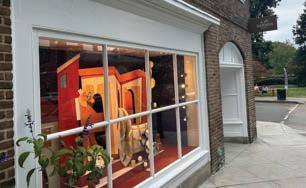
praised. I wasn’t surprised to find perfect lines and high-quality fabric, but my expectation was soon broken.
Rummaging further in the deep blues of elegant coats and sweaters, I checked the hems and stitches. It seems that not even high quality can buy you perfection. Located inside a beige shirt with brown elements and blue highlights, on a flipped sleeve, there lies one imperfection. A loose thread that hung out from its proper place stuck out to my careful eye. If this was found in a T.J. Maxx or a Target, it would’ve been an ignored detail in my critical opinion. However, with each piece being handmade and handselected, the question of how it made it to the floor lingered in my mind.
Now, truth be told, the shirt was one minor mistake amongst a large group of nearly perfect products, but if I had the means to purchase such a product, I would expect not a single mistake. Satisfied with my little tour and nitpicking, I took a small peek into the last room I had yet to explore. In the small fraction of it I could admire, I saw bag parts such as the body, straps, and types of hardware add-ons. In the center of the room, talking with a worker,
there was a couple already being offered their bag as they talked about price points and discussed possible options over the range of bag straps that were laid out in a rainbow of variations. It seemed that if one wanted to purchase the highly famed Birkin, this was the spot. Alas when I tried to book a bag viewing appointment — and failed during the chaos of midterms week — I took that as my sign to not press further until I had the wallet to back it up. The store presents a very mysterious front and guarded reputation, and their quality — for the majority of it — is held to the standards they claim to have. Even though an intimidating security guard dutifully greets you at the door, there is really nothing else that would stop and capture the interest of a shopper. Whether you appreciate the high luxury of their clothing, or are just an avid fashion enthusiast such as myself, the Hermès storefront on Palmer Square is an intriguing new addition to the Nassau scene.
Amanda Hugas is a member of the Class of 2027 and a contributing writer for The Prospect. She can be reached by her email at ah0942@princeton.edu.
84 acts, 15 porches, and 30-mile-an-hour winds: students and community enjoy Porchfest
By Isabella Roberts News Contributor
This past weekend, members of the Princeton community gathered across town for the fourth annual Porchfest, a music festival hosted by the Arts Council of Princeton where local musicians perform on porches around Princeton. This year’s Porchfest, held on Saturday, Apr. 26, spanned 15 porches in addition to Hinds Plaza and Palmer Square, which featured specially scheduled performances. Despite light rain and clouds during the day, Porchfest continued without interruption. Each of the 15 main porches held find performances lasting 45 minutes each, from the event’s start at noon until its end at 5 p.m. Hinds Plaza featured an open mic as well as a reading by poet, activist, and artist Roberto Lugo, while Palmer Square Green featured three performances as well as the event’s afterparty festivities. In total, 84 acts were performed across town. Porchfest was sponsored by a wide variety of institutions and businesses from the town of Princeton, including the Municipality, the Graduate Hotel, and Palmer Square. “I just love music, and I really love nothing more than a live band, and also being engaged in the community … [Porchfest] mixes those
two things together perfectly,”
Events Director for Porchfest Olivia Porter ’28 told the ‘Prince.’
While the porches around town were shared by Princeton residents, Maclean House, located on the University’s campus, was reserved specifically for Princeton student performers. The Maclean House performances kicked off with the Princeton University Band at 11:45 am before moving into other acts. Students performing ranged from Strawberry Milk, a rock/ metal band, to acoustic singer-songwriter Jonah and the Will.
Maclean House was consistently crowded throughout Porchfest, with the building’s front lawn covered by Princeton students, young children, and older community members. Students who checked in with the Porchfest organizers at Maclean House received a bingo card printout. To win “bingo,” students had to attend three different Porchfest performances and received a custom Porchfest tote bag in exchange.
Three performances at Palmer Square Green concluded Porchfest. Instant Bingo Family Band’s folk tunes were followed by R&B group Charles Laurita & The Mischief, and the day’s activities came to a close amid the sounds of classic rock band The Shaxe. Winberie’s Restaurant and Bar, an eatery
in Palmer Square, sold snacks and drinks to the attendees for the final acts and the afterparty.
Students in attendance emphasized the community aspect of Porchfest and the energetic atmosphere.
“It’s really nice, getting an opportunity to walk around and have separate events, to get off campus a little more,”
Kayla Toohey ’28 told the ‘Prince.’
When asked about why she attended, she added, “My friends and I have just been feeling a little stressed lately with finals, so it’s a nice opportunity for us to go out, walk around, see peo-
ple we know, and enjoy a warm day.”
“I love how the community has all come out together on this beautiful day. It reminds me a lot of home —neverything is musical and artsy, and it makes me happy to see everyone together,” Ella Anderton ’28 said.
Porter agreed, saying, “It’s been some pretty iffy weather, it’s kind of been raining a little bit … but people are coming out, they’re supporting their friends. There are people from the community [who] are here, of all different ages, so it’s really been wholesome and a really great event.”
Porchfest came to a close around 6:30 p.m. While a date has yet to be set for next year’s Porchfest, the Arts Council’s website notes it as an annual “Signature Event,” likely to occur again in Apr. 2026. It generally occurs around spring Lawnparties.
“If you didn’t come this year, definitely come back for Porchfest 2026 … it’s really just a great way to listen to some music, be with your friends, and see new things,” Porter said.
Isabella Roberts is a News Contributor for the ‘Prince’ from Ellicott City, Md.
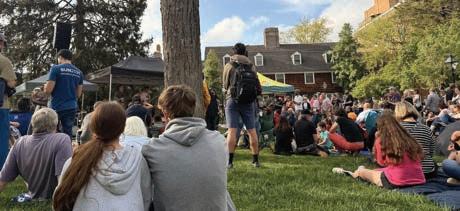
AMANDA HUGAS / THE DAILY PRINCETONIAN Storefront window of the new Hermès store in Palmer Square.

PRINCETON EATS
The Little Chef Pastry Shop: a Princeton town staple ‘hidden away in plain sight’
By Mira Eashwaran Associate Features Editor
Strolling down Nassau Street, students pass by the well-known Labyrinth Books and Garden Theater, taking a moment to peruse the books on sale and make plans for their next movie night. But do they ever wonder what lies down the quiet and sleepy Tulane Street?
Rounding the corner, they would discover, tucked between the Princeton Barbershop and the Princeton Record Exchange, an understated pastry shop with rave reviews: The Little Chef Pastry Shop.
Its unassuming storefront is only marked as an active pastry shop by the framed magazine articles propped against the window from the inside and the logo embellished into the glass. Inside, cakes covered with glossy ganaches and jellies await customers from inside a large glass display case. Unless someone decisively peered into the shop, they likely would not know it to be as famous as it is.
The owner and pastry chef, Edwige Fils-Aime, was the star of a 2004 New York Times review affectionately titled “The Little Pastry Shop That Could,” the subject of a 2008 profile in a New Jersey Monthly issue titled “Princeton’s Little Chef Comes Up Big,” and was even awarded the title of ‘best croissant in Princeton’ by The Daily Princetonian in 2015.
Before arriving in the U.S., Chef Fils-Aime — or ‘Pouchan’ as he is known to friends and regulars — lived in Haiti. He immigrated to New York in 1986, where he started as a busboy. He then learned to bake pastries in a French bakery, where he was drawn to this speciality and turned his attention to learning more from the chef.
He moved to Princeton and spent six years as a chef at the Chez Alice pastry shop in Palmer Square, which at the time was located on Nassau Street. In 2003, he started his own venture.
“I want to do what I want to do,” he explained, adding, “I don’t have any pressure. No one telling me what to do, when things need to be
done.” As a small business owner, Fils-Aime takes pride in being able to set his own schedule, menu, and hours.
Despite the unforeseen challenges of the 2008 recession and COVID-19 pandemic, Fils-Aime said he has kept his business going by focusing on his work and trying his best. “You don’t really know exactly what’s gonna happen, but you have to be prepared for it,” he noted, shrugging.
“That place is obviously very important to him,” noted Princeton alumnus Sam Harshbarger ’24, who grew up in nearby Cranbury and has frequented the shop since he was young. He described Fils-Aime as “somebody who really appreciates the independence of his work and enjoys being a small business owner.”
Fils-Aime enjoys the “production” of his pastries the most in his day. Most weekends, he rises before 5 a.m. to make his famous fresh croissants, which he never freezes and always makes from scratch. He has been using the same method and recipe ever since he opened his doors 20 years ago.
“I’m really enjoying what I’m doing to serve [customers], to give them exactly the product they’re looking for — do it differently than other places. I’m really doing my best to continue the same product, the same quality for them to enjoy,” Fils-Aime shared.
At opening, trays on trays of scones and croissants clatter onto the counter of the shop. Right on cue, customers stream into the establishment at 9:30 a.m., their presence announced by a tiny bell above the door.
Since opening in 2003, The Little Chef has accumulated a set of loyal regulars, from those that live and work in the Princeton area to a small handful of student regulars.
Navani Rachumallu ’26 started visiting The Little Chef Pastry Shop in spring of 2024, mainly with the goal of visiting her friends from West Windsor who work at the shop. Since then, she has become more acquainted with Fils-Aime and comes nearly every weekend to the shop.
“He’s pretty reserved at first, but he’s really, really funny,” she said of the chef.
Rachumallu’s friend, Sophie Salgian, a student at The College of New Jersey (TCNJ) who has worked at The Little Chef for two years, spoke about their experiences with customers and the regulars they speak with every week.
“In terms of regulars, it’s kind of all over the place. People who live around here, families; we get a lot of cute little kids in strollers who are really excited about chocolate croissants at ten in the morning on a Saturday,” they said.
“People like to open up when they’re buying pastries,” added Salgian, reflecting on the relationships they have built with the shop’s regulars.
On one cloudy and chilly Sunday morning, regulars wait patiently for the shop to open, hands stuffed in pockets. A customer stands in the corner of the shop, hands full with paper bags of almond croissants.
Some customers even travel in from New York City for the pastries, noted Salgian, remarking on these dedicated customers.
“There’s a fan base for this,” added Rachumallu.
When asked about his loyal regulars, Fils-Aime chuckled, taking stock and adjusting his wellworn and trademark Princeton cap. Some, he says, he has known for ten to fifteen years.
Despite The Little Chef’s relative proximity to Firestone Library — where many Princeton students study — this Princeton establishment finds its customer base to be made up of mainly Princeton townies, with only a handful of student regulars like Rachumallu.
“I’m surprised a lot of [students] don’t know about it,” noted Rachumallu.
The shop is cash-only and opens at 9:30 a.m. on the weekends. Salgian finds that most students are likely sleeping and don’t carry cash, two factors that may result in their lower level of student regulars.
The Little Chef’s unassuming facade and location on Tulane Street may also be a factor in its relative
CJL dining hall officially opens
By Devon Rudolph Associate News Editor
After seven months of renovations, the new Center for Jewish Life (CJL) dining hall officially reopened for full meal service on Sunday, March 16.
“I worked at Stanford, I have worked at Cornell and University of Chicago, so I worked in all these places, and I can guarantee you this is the best,” Nadeem Siddiqui, Assistant Vice President of Campus Dining told The Daily Princetonian.
The CJL was closed before the start of the Fall 2024 semester to renovate the facility. During the renovation, kosher meat and vegetarian dishes were prepared in an off-campus kitchen and delivered to the CJL, while dairy meals were not provided. Jewish food laws prohibit the mixing of meat and dairy.
“It has been [challenging] for the last nine months for our students and our community, but having this open and the way it
looks and feels and flows, it really is incredible,” Siddiqui said.
For some, the CJL dining hall drew them to Princeton even before the renovation.
Asher Liss ’28 described coming to Princeton with his family on a Princeton Preview visit and seeing the CJL dining hall. “Because I keep kosher, seeing a good kosher dining hall really boosted Princeton for me,” Liss said.
Students and staff members alike commented that the natural light provided by the newly installed windows creates a more welcoming environment.
“[Before the renovation], it was kind of like walking into Halloween … very dark and gloomy. There were no windows inside the servery at all, just very dark,” Chad Rovner, Chef de Cuisine at the CJL, told the ‘Prince.’
“This is completely different, and everyone was just blown away.”
“The other one seemed a little more compact — this one’s open, has the dual kitchens, … and the
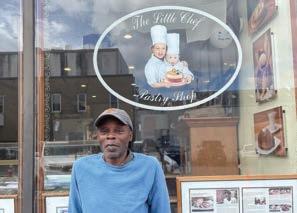
mystery to the student body.
“I don’t think people come down here unless they’re going to the record store,” said Salgian, adding, “We’re kind of tucked away.” The Little Chef also doesn’t find it necessary to advertise directly to students, given word-of-mouth and its steady stream of regulars.
“It’s a small street,” mused FilsAime. “Sometimes it’s difficult for people to notice.”
When asked if he would ever consider moving his pastry shop to a more heavily-trafficked part of Princeton, like Nassau or Witherspoon Street, Fils-Aime responded with a definite no.
“I like where I am right now,” he explained. “It’s a small place, and quiet.”
Harshbarger commented on the serenity of the shop as well. He described his nearly ritualistic pilgrimages to the Little Chef on the weekends as “an escape from campus,” to a place that was “hidden away in plain sight” from students.
Gil Joseph ’25, an international student from Haiti, learned of the shop from a professor and has visited the establishment a few times. He sees the location of the shop as a benefit as well, but for different reasons.
“There’s something about this being inconvenient that is actually
good,” he said, “Because it forces us to be more intentional about certain things and take time out of our days to wander into town.”
For Joseph, interaction with these small businesses in the Princeton area serves a larger purpose than just renowned croissants.
“I wish there was a lot more intentionality for us to engage with the town,” he said. “Get to know it because we are here for four years.”
Joseph noted how student involvement with the town has often been with the closer, more easily accessible places on campus and highlighted the importance of engaging further with Princeton’s establishments and history.
He added, “I would love to be able to support a business like this that has been around for a while, that’s run by one guy … a small, minority owned bakery.”
For Rachumallu, who continues to frequent the shop, The Little Chef has become a large part of her life at Princeton.
“It’s just an unexpected place of gathering that has just popped up in my life. And I’m very grateful for it,” Rachumallu added, laughing before finishing, “And I’m also grateful for the croissants!”
Mira Eashwaran is an associtate Features editor.
lighting is a great atmosphere,” Liss said.
The renovated dining space now offers more options than the previous smaller serving station, with a salad bar, stir fry station, dairy kitchen, vegan station, and meat kitchen that will be opening after Passover.
“It feels amazing to be able to have people come eat and not worry,” Alex LaFontant, a food service worker at the CJL told the ‘Prince.’ “I really love this building.”
Students and faculty also expressed hopes that the new CJL dining hall could bring together students of different backgrounds and communities.
“I think that students who aren’t keeping strictly kosher will now see this dining hall, see it’s similar to [other] dining halls, and be more open to coming here, which is better also for Jews who get to interact with non-Jews,” Liss told the ‘Prince.’
“I think the food has such a glue
to bring people together from all different backgrounds,” Siddiqui said.
According to Siddiqui, the CJL will host a special dinner on March 19 and an inaugural event on March 31 in honor of the Mandelbaum
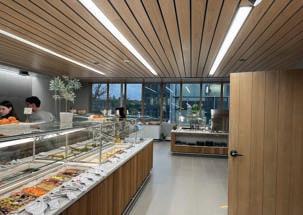
family, who donated to the CJL and made the renovation possible.
Devon Rudolph is an associate News editor and staff Sports writer for the ‘Prince.’
DEVON RUDOLPH / THE DAILY PRINCETONIAN The newly-renovated CJL dining hall.
MIRA EASHWARAN / THE DAILY PRINCETONIAN
Chef Edwige Fils-Aime, standing outside the Little Chef Pastry Shop on Tulane Street.
Reviewing Coffee Club’s spring drink specials
By Lulu Pettit Senior Prospect Writer
As the sun defrosts our campus and Princeton students begin to lie on Cannon Green and Poe Field, Coffee Club has released their spring drinks to power us through the final weeks of the school year. During the week of March 24, Coffee Club announced a new spring drink each day, offering 50% off on Friday, April 28, at both locations. As a true warm-weather enthusiast, I decided to try out all of the newly offered spring-themed drinks.
Honey Bee Cortado Served hot only, the menu describes this cortado as “lightly sweetened with honey and spiced with cinnamon.” I was surprised by this drink — the honey was an under-
tone and let the coffee flavor shine, adding a subtle sweetness to cut the espresso’s bitterness. I opted for oat milk instead of regular milk, and even though it was only a four-ounce drink and oat milk has a strong flavor, the oat milk didn’t overpower the honey-espresso flavor of the cortado. I would recommend this drink for a cold and rainy spring day when you want the joy of spring but the coziness of a warmer drink.
Seaside Shaken Espresso
Served iced only, this drink is a shaken espresso with sea salt and caramel sauce, with extra caramel drizzled on the sides of the cup. As a sweetened latte lover, this was probably my favorite of the drinks. It was sweeter than the cortado but not so sweet that it felt like a dessert. As the caramel on the side of the cup slowly
dissolved into the drink, the caramel flavor increased, resulting in a drink that gets more delicious the longer you sip. This drink tastes like the glimmer of summer sunshine on a warm spring day.
Springtime Spritz
Described as “spring in a cup” by the advertisement from Coffee Club, this is an espresso seltzer with notes of lemon and lavender. I’m not the biggest fan of fizzy espresso drinks, such as the past espresso tonics. Although this one wasn’t for me, I could see how the balance of sweet and citrus flavors could be bright and pleasant for a fan of this type of drink. The floral note of the lavender syrup reminded me of going to a flower shop, but I would have enjoyed the drink more without the sparkling water
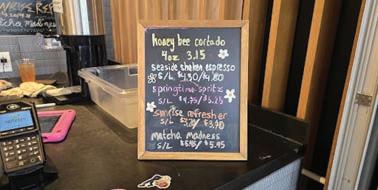
and perhaps as a latte instead.
Sunrise Refresher
This drink is the epitome of springtime and warm weather. I’m torn between the Seaside Shaken Espresso and this one for my favorite of the new drop — a mix of green tea, lemonade, and strawberry, it was fresh and sweet and spring in a cup. The green tea keeps the drink from being too sweet, while the strawberry and lemonade add freshness. I can see myself sitting on Poe Field on a Saturday afternoon enjoying this drink.
Matcha Madness
Served iced or hot, this raspberry matcha is perfect for the matcha lovers on campus. As someone who usually has issues with the grassy, earthy aftertaste of mat-
cha, I loved the raspberry addition to this drink. The sweet fruitiness replaced the usual aftertaste, but it wasn’t so strong that it overpowered the matcha flavor itself. Even though I’m not much of a matcha drinker, I thoroughly enjoyed this drink and would order it again. Available at both locations, any of the new Coffee Club spring drinks would be the perfect way to brighten any student’s day as we move into spring. While any of the drinks can bring a little sunshine to your day, I highly recommend the Sunshine Refresher and the Seaside Shaken Espresso.
Lulu Pettit is a member of the Class of 2027 and a senior writer for The Prospect from the suburbs of Philadelphia. She can be reached at lp3153[at]princeton. edu or her Instagram @itslulupettit.

Fresh flavors meet Chinese food at new restaurant XiBei Cuisine
By
A row of waving cats along the wall, the salty-umami smell of mushrooms and pork, and the clattering sounds of a busy kitchen — these are the greetings of Princeton’s newest restaurant on Witherspoon, XiBei Cuisine.
Offering Northwest Chinese dishes like roast lamb leg and mutton on the bone, as well as more familiar Chinese offerings like pork soup dumplings and mapo tofu, XiBei’s wide menu has something for everyone. To see if the food and atmosphere were worth a trip to Nassau, I stopped by for lunch last Thursday afternoon.
I was surprised that the restaurant was so busy on a weekday at lunchtime. I arrived around noon and was seated right away, but within 10 minutes, every table in the small space was taken. The
entire space was themed red-andgold, with about six or seven tables and a pick up desk.
Despite the lunch rush demanding the attention of the wait staff, we received menus and lemon water upon sitting down. The tables have scan codes to order, so once we were ready, we didn’t have to wait for a waiter to be available to take our order.
I absolutely loved the Xian cold noodles. The sauce was super salty, a little nutty, and just oily enough that the noodles and veggies slid smoothly into my mouth when eating them. When I received the dish, most of the sauce was on the veggies, so I had to mix everything together thoroughly before eating. The chicken, although pre-cooked and chilled, was moist, and the noodles were the perfect chewy vessel for everything to come together. However, after my entree arrived, there were some issues with the order of arrival. Less than 10 minutes after the cold noodles came, the dessert,
Chinese rice pudding, and my drink, a canned sweetened milk drink, arrived, but the appetizer and the other entree were still missing. Another five minutes later, we finally received our appetizer: pork soup dumplings.
The soup dumplings arrived fresh and steaming hot. The filling was an unembellished combination of broth and seasoned pork. It was full of savory flavors that were enhanced even more when dipped in the sauce that accompanied the pork dumplings. The sauce, similar to a slightly sweeter soy sauce, added a saltiness and an umami taste. We had six soup dumplings total, perfect for splitting between two people as an appetizer. There was also a chili oil bottle available at the table for anyone looking to add an extra kick.
At last, 20 minutes after the first entree arrived, we received our second entree: beef noodle soup. For this dish, we ordered the pulled noodles to compare. They were definitely much thicker and denser
than the regular noodles, a heartier option if you’re looking for a cozy meal. The flavor profile was simple but delicious: rich and meaty beef combined with the salty broth.
At the end of the meal, we tried the milk drink and rice pudding. Rather than creamy, the rice pudding was solidified into a cube and topped with pepitas, peanuts, dried fruit, and sesame seeds. If you have allergies, I would recommend asking if the dishes you order contain the allergens, as the ingredients list on the menu for the rice pudding did not mention the peanuts. The rice pudding was potentially my favorite dish of the meal. It was chewy in a way slightly similar to mochi, but with a more varied texture from the rice grains and the toppings. It contained a sweet but earthy red bean filling that tied all of the toppings together.
The milk drink, which consisted of whole milk, sweetened condensed milk, and sugar, was extremely sweet. It was a bit too sweet for my
palate to drink straight from the can, although a kid might enjoy it. However, adding a little to the rice pudding created a nice balance of flavors. At the end of the meal, we were given a small bowl of Chinese sesame cookies in small cone shapes. They tasted a lot like fortune cookies, but they had a chewier texture, making a nice surprise at the end of the meal. Overall, despite still adjusting to a full restaurant of diners and the timing of dishes, I highly recommend trying out XiBei Cuisine. Just a block off Nassau on Witherspoon Street, XiBei is very accessible for students. While it offers many classic dishes, students can challenge themselves and go for one of the more unusual items on the menu to get a taste of Northwest China.
Lulu Pettit is a member of the Class of 2027 and a senior writer for The Prospect from the suburbs of Philadelphia. She can be reached at lp3153[at]princeton.edu or her Instagram @itslulupettit.

LULU PETTIT / THE DAILY PRINCETONIAN Coffee Club’s Spring menu.
LULU PETTIT / THE DAILY PRINCETONIAN Honey bee cortado.
Lulu Pettit Senior Prospect writer
THE PROSPECT | MARCH 2025
David Zielenziger ’74, former ‘Prince’ chairman and lifelong journalist, passes away at 72
By Kian Petlin News Contributor
David Zielenziger ’74, who was chairman of The Daily Princetonian starting in 1973 and a lifelong journalist, died peacefully on Tuesday, May 20, at his home in Great Neck, N.Y. He was 72.
Zielenziger believed that the ‘Prince’ played an important role in investigative journalism, an opinion shaped by the era of Watergate and reflected in his determined reporting. Described as “a really dogged reporter” by Diana Savit ’73, then-senior News editor for the ‘Prince,’ Zielenziger was someone who worked his sources, traveled to unearth facts, and went where most reporters didn’t go.
“Whatever story he was on, he worked it like a terrier — no stone left unturned,” Savit told the ‘Prince.’
During his time as chairman, Zielenziger oversaw reporting of a demonstration at West College — now Morrison Hall — where students objected to the personal security detail accompanying Imelda Marcos ’77, daughter of the former President of the Philippines and a student at the University. He also focused on coverage of the beginning of the tenure of University President William Bowen GS ’58 and retrospective coverage of the eating clubs’ bicker process.
On campus, Zielenziger was also active in Jewish student life. He is
remembered by many for his firm liberal beliefs, yet he always kept them separate from his reporting.
“His sense of integrity really was, in some instances, detrimental to his career,” explained Karen Haddy ’74. “He was not one to look at his own self-interest ahead of the truth.”
Leaving the Orange Bubble after college, Zielenziger joined the metropolitan staff of The Baltimore Sun. He then served as Kuala Lumpur Bureau Chief for The Asian Wall Street Journal from 1978 to 1982, where his reporting on political corruption earned him the ire of Malaysian Prime Minister Mahathir Mohamad.
Zielenziger also spent a year as Canadian correspondent for The Dallas Morning News.
Returning to the United States, Zielenziger turned his focus to reporting on semiconductors and computer software. He spent eight years writing about chips for Electronic Engineering Times, before joining the then-two-year-old Bloomberg News in 1992 to cover technology companies including Intel, AMD, Oracle, and IBM. After leaving Bloomberg in 2002, he worked for Newsweek, Thomson Reuters, and other publications.
Zielenziger’s journalistic ability is what stood out the most to his colleagues at the ‘Prince.’ He is remembered as a “creative journalist,” even when given very little to work with. As Savit re-
called, “David could write about chicken noodle soup and make it interesting.”
Zielenziger iconically typed with two fingers.
“You could always tell David was in the newsroom because there were two fingers that were flying around like a machine-gun,” said John Horan ’74, his former Sports editor. “He always wanted to be right in the thick of it.”
Zielenziger was also the driving force behind the opening of the first kosher dining facility at Princeton in 1971. He convinced the administration to house the facility in the unused Stevenson Hall and helped raise the $10,000 dollars in funds to run the new kitchen.
Stevenson Hall also housed a non-kosher kitchen and served as a gathering space for students of different backgrounds. Zielenziger closely monitored the two menus of Stevenson Hall, making sure that the kosher menu was always comparable. Savit recalled Zielenziger’s words nearing the winter holiday: “they’re getting a Christmas dinner and we’re gonna get one too.”
Zielenziger was described by his close friend, Jeff Richards ’74, as “the moving force to make Princeton recognize institutionally the status and needs of Jewish students.” Richards explained that “to understand [Zielenziger] you had to know his passionate concern for politics and social justice.”
Zielenziger was drawn to civic
engagement and to aiding the powerless, even as a teenager. An opponent of the war in Vietnam, he worked tirelessly to organize support for the upstart candidacy of Allard K. Lowenstein, the Democrat who won a Long Island congressional seat in 1968. At age 20, Zielenziger attended the Democratic National Convention in Miami as an elected delegate pledged to Sen. George McGovern of South Dakota.
Zielenziger was succeeded by Joel Goldstein ’75 as chairman of the ‘Prince,’ who recalled “a commitment to the underdog and people less fortunate than himself.”
Goldstein remembered finding a yellow note waiting for him at the chairman’s typewriter on the second floor when he took over from Zielenziger.
“David had left me a sort of note, and what he wrote was, number one: a year is a long time. Number two: your wife and family will be taken care of. Three: you will be rehabilitated with employment when this is over,” Goldstein said.
The tongue-in-cheek note was in reference to the infamous words spoken by John Dean, White House Counsel under Nixon, to procure the silence of one of the Watergate burglars. Zielenziger held fast to the ideals of investigative journalism while at the same time, he never lost his dry wit or his deep empathy — “a truly decent, smart, and funny human being,” as ‘Prince’ peer Annalyn
Swan ’73 put it.
Zielenziger was an avid correspondent, even after his career in journalism ended, maintaining separate email lists tailored to specific areas of interest. Many of his friends would regularly receive emails ranging from welcoming the Sabbath, to sending news links, to reporting on the intricacies of Great Neck local politics.
“Last Friday was the first time in I don’t know how many years that I didn’t get my weekly email from David with news, complaints, and trenchant comments,” wrote Savit in an email to friends the week following Zielenziger’s passing.
“Every Friday, he would always send me the link to the New York Times news quiz for the week, and also on Saturdays, the flashback,” recalled Richards.
Haddy told the ‘Prince’ that “[Zielenziger was] such a loyal Princetonian, in every sense of the word.”
Zielenziger is preceded in death by his parents, Eric and Ruth Zielenziger and survived by his brother, Michael Zielenziger ’77, also a former ‘Prince’ chairman. Contributions in his memory can be made to the National Ramah Commission of the Jewish Theological Seminary, New York, or to the Center for Jewish Life at Princeton.
Kian Petlin is a News contributor for the ‘Prince.’
Want to write for the ‘Prince’? These alums did
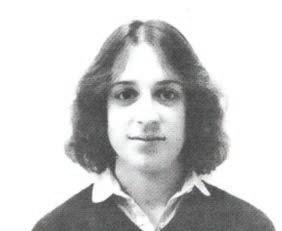
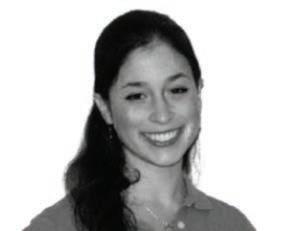
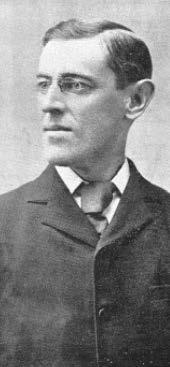
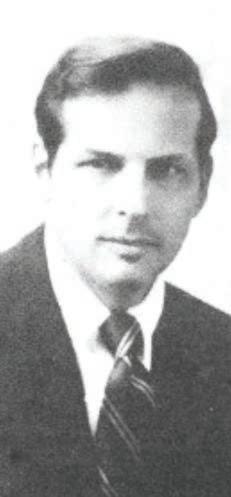
Elena Kagan
Woodrow Wilson
Robert Caro
Catherine Rampell
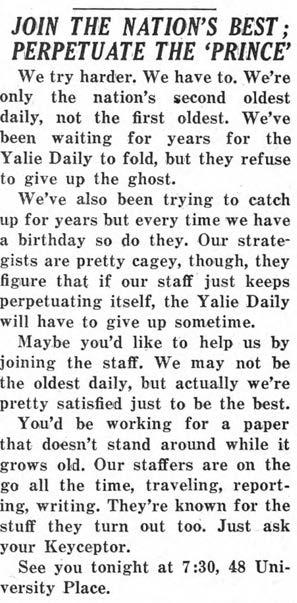
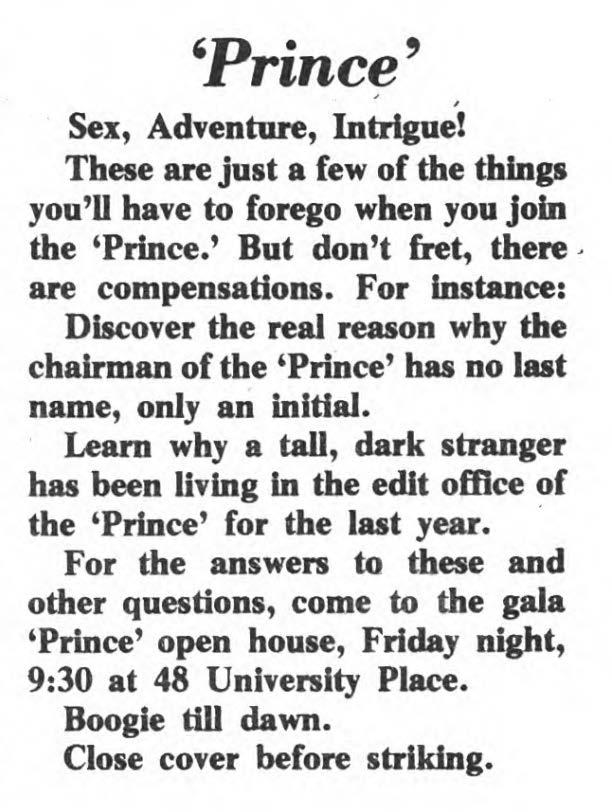
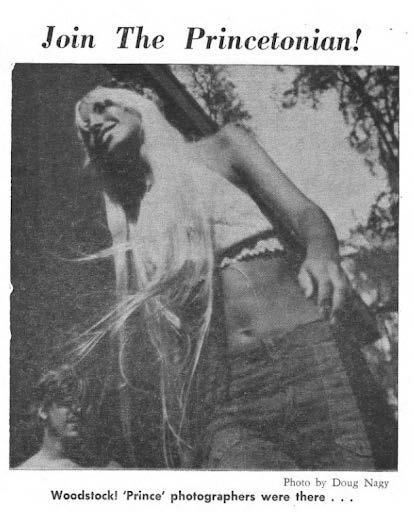
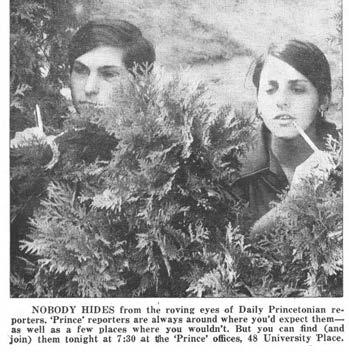
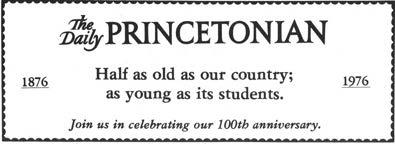
A CHANGING CAMPUS
Princeton University Health Services opens doors in new Frist Health Center
By Doug Schwartz Staff News WRiter
On Jan. 13, Princeton University Health Services (UHS) officially relocated to Frist Health Center (FHC). The new location is north of Goheen Walk, near the old McCosh Health Center.
The construction of Frist Health Center is part of the University’s efforts to bolster healthcare services for members of the Princeton community.
“McCosh Health Center was built in 1925 at a time when healthcare delivery systems were entirely different than those of today, and Princeton had many fewer students,” UHS Director Janet Finnie ’84 wrote to The Daily Princetonian. “Frist Health Center is larger, but is also redesigned to support efficient and effective healthcare delivery.”
When walking into the lobby of FHC, visitors are greeted by a large open space with tall windows. The building itself is a mix of past and present, with the more modern exterior built around some of the old brick buildings that already existed.
“I was surprised by how big it was and how much natural light there was inside,” Angie Challman
’25 told the ‘Prince’ in an interview.
“Frist Health Center was designed to create a warm, welcoming, and inviting environment for students,”
Finnie wrote to the ‘Prince.’ “No matter what entrance you use to enter the building, you will experience a soaring, light-filled atrium and the Isabella McCosh Garden, which utilizes biophilic design concepts to increase student and occupant connectivity to the natural environment.”
Finnie explained that FHC was designed with sustainability features, such as using timber to sequester carbon that would otherwise be released back into the atmosphere.
While the construction of the building was deliberate, some students were not impressed with FHC’s outward appearance.
“It looks like a dining hall,” remarked Zhuolin Xiang GS.
“I went inside yesterday, and it was really modern and pretty,”
Ladan Abdullahi ’28 said in an interview with the ‘Prince.’ “It doesn’t really fit the aesthetic of the rest of the college, but it’s pretty nice inside.”
For others, the new building brought greater convenience. FHC includes several new amenities
that McCosh Health Center did not have, such as the new intercom system that allows students to talk with a nurse after hours about any problems that may arise.
“I had to get an ice pack for a friend the other day, and it was after hours, so I just went to the intercom system, and it was really efficient,” Yiling Li ’26 told the ‘Prince.’
Li discussed the difficulty in solidifying a same-day appointment in the old McCosh Health Center, telling the ‘Prince’ that, in contrast, “[FHC] was easier.”
When discussing the improvements made for FHC, Finnie remarked that the new building is equipped with “private rooms and bathrooms for overnight patients in the infirmary, a striking student lounge, a yoga/meditation contemplative space, a new multipurpose room that will be a shared resource for campus partners, and more.”
“The number of offices for counselors was increased, as were the number of exam rooms available to serve students,” she added.
While FHC provides Princeton students and faculty on campus with an upgraded facility for health services, the center’s open-
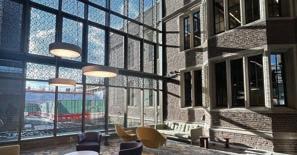
ing was not an event that all on campus were aware of.
In a campus-wide email sent on Dec. 5, Finnie and UHS Executive Director John Kolligian Jr. announced key dates related to the opening of FHC, with the relocation of UHS officially taking place on Jan. 13.
Though students and faculty returned to campus from winter recess soon after the reopening, UHS did not send out a reminder to the campus population.
“I honestly forgot the new health center was opening,” Challman explained. “I thought [the building]
was the new res[idential] college.”
“I just found out [about FHC opening] a few days ago,” Li added. For students looking to take advantage of the new and expanded services offered, the UHS website has been updated to reflect the changes.
The FHC is open Monday through Friday from 7:45 a.m. to 4:45 p.m.
Doug Schwartz is a staff News writer and an associate Sports editor for the ‘Prince.’ He is from Annapolis, Md., and typically covers town and gown, facilities and housing, and health for News.
Outside the Princeton University Art Museum
By Victoria Davies & Cynthia Torres Head News Editor & Assistant News Editor
The new Princeton University Art Museum (PUAM) will house 32 galleries, a two-story conservation studio, and an 8,800 square-foot education center — all housed in a hulking aggregate stone exterior.
Ahead of PUAM’s opening in October, The Daily Princetonian received an exterior tour of the building from Chris Newth, Senior Associate Director for Collections and Exhibitions. The tour included an overview of the museum’s architectural design and interior features.
The exterior design of the new art museum, however, has garnered some controversy among members of the campus community.
“There’s going to be a range of comments on the architecture; some people love it, some people won’t. That’s true with anything,” Newth explained. “That echoes the experiences people are going to have with the arts. Not everybody loves every piece of art that’s in the museum.”
“The style of architecture itself is very different to what we’re used to seeing on campus,” said architecture student Kayleen Gowers ’25 in an interview with the ‘Prince.’
“It’s an exciting way for students to see how contemporary architecture can fit into the more historic style of campus,” she added.
At a luncheon on Alumni Day, PUAM Director James Steward described the building as made of fundamentally classic materials: “cast in-place concrete … as well as steel, bronze, glass, and a pioneering use of heavy timber.”
The renovated museum, whose size was restricted on the east side by a dawn redwood tree and on the west by the path behind Dod Hall leading up towards Nassau Hall, is split into nine sections, referred to as “pavilions.”
The central north pavilion is home to Marquand Library of Art and Archaeology. During PUAM’s construction, its collections have been temporarily relocated to the C-floor
of Firestone Library but will be returned to the building following its completion in the coming months.
According to Newth, the central south pavilion will house a twofloor conservation studio, an area which “combines science and research and activity.” Notably, this is the only section of the building without a flat roof. Because it is on the south side of the building, and natural northern sunlight is ideal for conservation, the designers “developed this skylight that actually takes the northern light and bounces it down,” Newth explained.
The themes of the remaining seven pavilions have not yet been announced, although Newth confirmed that the northwest pavilion will be primarily European art.
“That doesn’t mean there’s just European art in there, because we don’t believe in presenting art that way,” Newth explained. “While this will primarily be European art, there are other cultures and multiple time periods in there to make sure we’re trying to present the full picture with the collections we have.”
PUAM spokesperson Morgan Gengo wrote in a statement to the ‘Prince’ that “information about the organizing principles of each area of the building, including the pavilions, will be forthcoming.”
The museum will feature 32 galleries, all but one of which will be spread on the same level throughout the second floor of the building. Newth explained that, in the early 20th century, “it was very common for museums to put their best things on the main level, and then having additional objects below.”
“All our collections will all be on the same floor, so it will be hard for somebody to argue that we put any collection lower than another,” Newth explained.
“One of our biggest objectives in [the PUAM project] was to break down the traditional hierarchies of display that have dominated in most art museums around the world,” Steward said.
The last of the 32 galleries is located in the building’s northwest corner on the first floor. Its exterior-facing windows are boarded up at time of publication — however, Newth described that this gallery may be thought of as “a project space” for year-long exhibitions.
Due to the large windows opening into the room, only certain pieces of art can be exhibited there, Newth said. “I’m excited that people can see in and out [of the gallery].”
Newth noted that the second floor would house three viewing rooms, each of which will have only a few objects in it.
“We all understand that sometimes museum-goers need a rest … or they need a space where they can actually just get immersed with an individual object,” he said of the viewing rooms.
According to Gengo, two of the 31 galleries on the second floor will be temporary exhibition spaces in addition to the individual gallery on the first floor.
“We want to keep it vibrant for all the students and non-students, [but] we also don’t want to have [the exhibits] up for such a short period of time that you can’t get to them,” Newth told the ‘Prince’ during the tour.
An additional temporary exhibition space is Art@Bainbridge, which will remain open even after PUAM opens in October.
Four percent of Princeton’s collections will be on show in PUAM at any time, equivalent to around 4,700 articles from the collections. The old art museum had around half of this volume visible at any time.
The final 29 galleries will house the collections, which will also be rotated regularly. Newth explained that certain materials need to have restricted access to light, but noted that rotation of collections might be due to other reasons.
“We might get new acquisitions, or there might be a course that needs something [from the collections],” he described.
The education center is made up of
two art studios, two seminar rooms, an auditorium, and five object study rooms, totalling 8,800 square-feet of the building. The studios, called ‘creativity labs,’ are visible from the east side of the building, and are where the “art making process can happen,” Newth said. These spaces will be available for drop-in or through PUAM’s programming.
“Somebody can come in and have an experience with art that’s not the collection art; it’s making art,” said Newth.
The five object study rooms in the education center will allow students to interact directly with pieces in the collection. Object study rooms are “where classes with art on the table will be held, and we had about 200 classes a semester in our object study rooms when we were open previously,” described Newth.
Leela DuBois ’26, an Art and Archaeology student, said that her experience with art history classes has been different with the art museum under construction. In a semesterlong assignment, DuBois described going through the museum collection catalog online to complete her project. “Often we weren’t able to see those pieces in person,” she said in an interview with the ‘Prince.’
“It’s a very different experience when you can grasp the size and scope of a piece and how it looks in a three-dimensional space versus on a screen,” said DuBois.
The new museum has been conceived as a way of connecting the University and the broader community. The new building, for instance, will feature four entrances that are lined up so students and community members can walk through the museum to cross campus. The corridors, referred to as ‘Art Walks,’ form a cross through the building and will be lined with art for those who are simply walking through.
“We wanted a location where people could really experience art in their daily life,” said Newth. “We want people to live with art.” Newth emphasized the proximity
of a museum on campus and its convenience. “Somebody can go to New York — that’s great, there are great museums there — but they don’t have to. They can come right here and they can do it at the last minute.”
Kelly Park ’25, the president of the PUAM Student Advisory Board, agreed. “Very soon, students won’t have to wander far to immerse themselves in such an extensive art collection,” she said. PUAM has sparked several controversies since the beginning of its renovation. The building was designed by Adjaye Associates, an architecture firm headed by David Adjaye, a renowned GhanaianBritish architect who was accused of sexual assault, sexual harassment, and fostering a toxic workplace in 2023. Additionally, the style of the building has sparked much debate among students.
In an interview with the ‘Prince’ in November, University architect Ron McCoy GS ’80 advised students to “stand back and put a layer of campus between yourself and the museum.”
“When you look from, say, in front of Witherspoon, down the diagonal, you see the echelon of the different pavilions linking to Brown Hall,” McCoy said. “If you look at the base of Brown Hall, you see that the gray granite of Brown Hall is picked up by the precast concrete [of PUAM].”
“I think it’s hard to appreciate it if you don’t have more [of an] architecture background,” Gowers said. “I do think they could have done the same design, the same grid, but with less concrete.”
The PUAM is set to open in October 2025, with the exact date to be announced in late March.
Victoria Davies is a head News editor for the ‘Prince.’ She is from Plymouth, England and typically covers University operations.
Cynthia Torres is an assistant News editor and an Archives contributor. She is from New Bedford, Mass. and typically covers University administration.
GABY GUTIERREZ / THE DAILY PRINCETONIAN The waiting room in the new Frist Health Center.
How construction changed campus, in photos
By Daily Princetonian Staff
For many students, the presence of construction can be felt at all hours of the day. While these projects work towards improving our future campus, presently
they prevent students from experiencing the full beauty of our school. For those reminiscing of campus before the massive mounds of dirt and rumbling construction vehicles, we have compiled before vs. after photos of various landmarks on campus.
Butler College
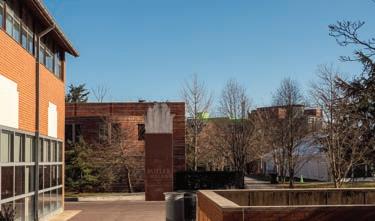
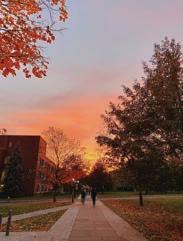
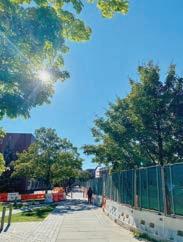
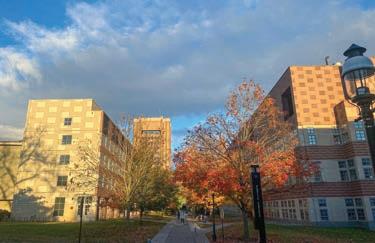
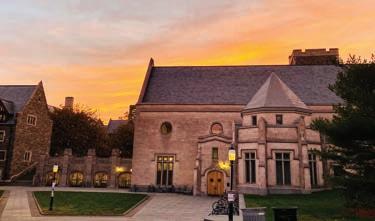
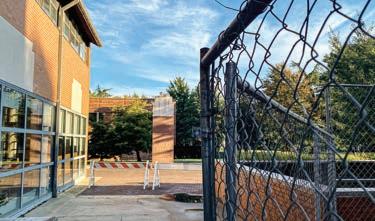

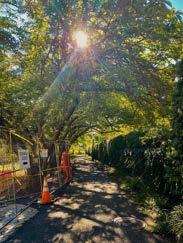
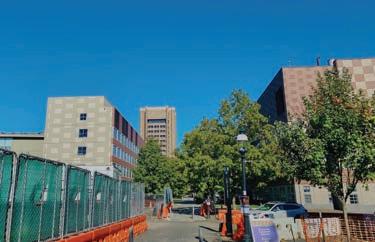
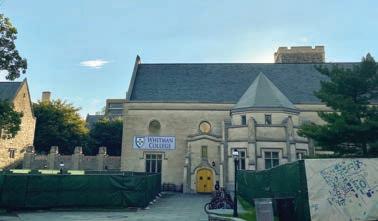
Butler Complex Walk
Walk Outside Frist Campus Center
Schultz Laboratory and Thomas Laboratory
Whitman College
Princeton says it wants to help students in mental health crises. Can it succeed?
By Raphaela Gold Head Features Editor
In December 2023, a first-year sat on a Zoom meeting with her parents, and University administrators including her deans of college, weighing a hefty decision. She was given a choice: Complete her end-of-term assignments in the remaining two days before Dean’s Date, Princeton’s deadline for all end-of-term work, or take a leave of absence from the University.
Blaire, who requested this pseudonym and, like the other students in this story, spoke under the condition of anonymity to discuss sensitive health information, had experienced a mental health emergency on campus earlier in the semester. As a result, she spent eight nights in Penn Medicine’s Princeton House Behavioral Health (not affiliated with Princeton University), sandwiched on both ends by an overnight stay in McCosh Health Center. In total, she missed 11 days of school, including the last few days of class and almost all of reading week, the period of time between the end of classes and Dean’s Date, the due date for all written work.
On the Zoom call, Blaire was still reeling from the ordeal which landed her at Princeton House, an experience that she said left her “emotionally wrecked.” She was not given the option for coursework extensions, as Dean’s Date offered limited flexibility.
“They said I had to do all of my work in the next two days if I wanted to finish the term and still be a Princeton student,” she recalled. Feeling caught between her academic and mental well-being, Blaire decided to stick it out and finish her assignments.
“I made the choice to just continue and try to finish everything up as fast as I could,” she said. And she did, submitting everything in time, despite the guidance she said she received from a Princeton House social worker to slowly reintegrate into campus and academic life. She passed her classes and returned in the spring to continue her studies. Still, the experience made her lose trust in University Health Services and question whether she belonged at Princeton.
“I felt so alienated from my community,” she explained. “It didn’t make me feel good about being a Princeton student.”
Blaire is not alone. She is one of about 30 undergraduate and graduate students each year who experience severe mental health crises that escalate to the point of inpatient hospitalization, according to Director of CPS Dr. Calvin Chin. On a campus where resources for students are remarkably abundant, and where around 35 percent of the student body seeks mental health care each year, many students expect that the University’s mental health system can and should meet every student’s needs. But in cases that challenge that system, both students and administrators are confronted with a difficult bind: how to balance the uninterrupted high achievement Princeton expects with the often disruptive mental health care some students need. Over the course of a year, in dozens of interviews with The Daily Princetonian, students, professors, mental health professionals, and administrators provided a window into the difficult decisions at the heart of that balancing act, one where each student’s case may be different and challenge the system in new ways.
And while each case is different, Princeton is not alone — it is just one institution of many navigating the nationwide mental health crisis among college-aged students.
“Adolescents in general are experiencing much more stress, anxiety, and depression across the country,” said Dr. Jerome Miller, a clinical psychologist and lecturer emeritus in psychology at the University of Michigan. “Health centers everywhere are feeling overwhelmed, [because] there are so many more students asking for resources.”
Dr. Zainab Okolo, Senior Vice President of Policy, Advocacy, and Government Relations at the Jed Foundation — which is working with Princeton to help it meet its mental health goals — echoed this. “Princeton is absolutely and unfortunately not alone. We as a nation are facing a national youth mental health crisis,” she said.
Conversations around mental health on campus invariably return to the fact that Princeton has confronted seven undergraduate student deaths due to suicide and mental health struggles in the last four years, most recently that of Lauren Blackburn ’26. It can be difficult to wrap one’s head around the fact that even a campus as well-resourced as Princeton still struggles.
University President Christopher Eisgruber ’83 nodded to this during a public forum in early 2024, days after the death of James Li ’27.
“There are tragedies that take place, even when people do all the things that they should be doing,” Eisgruber said in the meeting, while citing the University’s investments in CPS and the new Frist Health Center.
Each of these deaths has left its mark on the Princeton community, often launching new conversations around mental health on campus in their aftermath. In this regard, too, Princeton represents a microcosm of a nationwide crisis, in which suicide is now the second leading cause of death for individuals aged 10–34.
At the same time, though addressing suicide remains an open question, Princeton has made extraordinary investments in mental health resources. Students can make CPS appointments for free without a formal limit. While there is often a long wait time for these appointments, and CPS is designed to be a short-term resource, Princeton also connects students with a robust network of outside providers. And after years of student advocacy work, students on the Student Health Plan can now see those outside practitioners for only a $10 copay, less than many peer institutions.
Students have also seen an increased emphasis on wellness in daily life, especially since the COVID-19 pandemic. From community care days packed with plant-potting and yoga to emotional support puppies visiting the residential colleges during exam season, from wellness programming grants to an easily-navigable resources website, from a 24/7 emergency care line to mental health training for firstyears during orientation, Princeton has made a significant effort to address both everyday wellness and more serious mental health issues.
Yet every semester, some students are hospitalized for mental health emergencies. Some have difficulty paying the bills for their short- and long-term treatment. And some feel like CPS isn’t working for them.
With students in crisis and colleges and universities across the country seeking solutions, Princ-
eton is a resource-rich and expertladen campus that has the opportunity to lead by example. Can it?
‘The whole student’: The evolution of mental health care on American campuses
Mental health care at Princeton was first conceived with academic achievement in mind.
In 1910, Princeton became the first college in the United States to establish a mental health-specific service for students, in response to a psychiatrist’s observation that students were dropping out due to “emotional and personality issues.” The goal of the service was to help students remain at Princeton while dealing with these concerns. Other schools followed suit over the next decade — University of Wisconsin in 1914, Dartmouth in 1921, Yale in 1925.
Intense moments of national trauma have brought significant changes to the system since its inception. In the 1940s, largely driven by the psychological weight of World War II, the University started including CPS as part of its healthcare plan. After disagreements between students and administrators in the 1980s about the level of access students should have to counseling on campus, University administrators approved expansion of the student health plan to include mental health coverage in 1992.
The pandemic inundated the mental health system, forcing it to significantly transform. At Princeton, the number of students seeking care at CPS had already been steadily increasing before the pandemic — it reached an all-time high in the spring of 2021. Following a student referendum, a sweeping report from the Undergraduate Student Government (USG) recommended the University implement 24/7 on-demand CPS counseling and fund transportation to offcampus care, among other changes.
Some, but not all, of the recommendations from the report have been implemented. Still, the mental health ecosystem on campus today would be unrecognizable to a student 15 years ago. There are more resources, clearer websites, reduced copays for outside providers, and a more open administrative approach to suggesting leaves of absences. And this spring, the University will be required to start providing annual suicide prevention training for all faculty and staff by a New Jersey law passed in 2023.
Still, these changes have only gone so far in individual cases, and each student’s experience differs vastly from the next. Though Blaire got the care she needed — she was taken into CPS, received treatment at Princeton House that she later reflected positively on, and regained her footing at Princeton in the aftermath — the experience itself was wracked with anxiety and confusion.
If Blaire took a leave, her return would not be automatically guaranteed: According to Princeton’s guidelines for Academic Standing, Leaves of Absence, and Reinstatement, it might be contingent on evidence of her mental rehabilitation from a provider. For health-related leaves of absence, the guidelines state, “Careful consideration will be given to the opinions and recommendations of the student’s treating physician or mental health professional, if available.” Leaves of absence have long been a point of contention for universities in the United States. In the
2010s, reports circulated of students in mental health crises being forced to take mandatory leave from colleges, in some cases because universities feared that these students were a liability. This changed when students and their parents began filing lawsuits claiming that these forced leaves disrupted students’ studies and induced deeper depression, including a suit filed against Yale in 2022.
Such a lawsuit was filed against Princeton in 2014, when a student alleged that Princeton had discriminated against him in the wake of his suicide attempt. The student claimed that forcing him to withdraw likely exacerbated his condition and caused him emotional distress. The student and the University settled the case in 2019 after five years of litigation.
The ‘Prince’ reported in 2023 that CPS requiring a student to take a leave of absence is now incredibly rare.
According to Chin and Associate Dean of Students Mellisa Thompson, who regularly handles cases that might involve a leave of absence, administrators try to work with students to choose the best path for them when considering a leave of absence.
When she meets with students, Thompson emphasizes that Princeton is not going anywhere. “Students should not try to struggle through this place, when students are at a point when the type of treatment that they need to engage in doesn’t feel like it’s compatible with the academic rigor and the demands,” she said. “Mental and physical health — we treat both of those the same, because they’re both just as important.”
According to Chin, more than 2,000 students seek CPS care each year. In Fiscal Year 2024, CPS had contact with 2,300 students, with 1,500 total sessions. With just 14 psychologists, nine social workers, two psychiatrists, and two psychiatric nurse practitioners, that’s around 85 students per every professional on staff.
Many mental health professionals associate the spike in seeking care with the pandemic, and though numbers continued to climb in the post-COVID-19 years, the 2025 senior survey conducted by the ‘Prince’ revealed a decrease in the amount of students who sought mental health care in the Class of 2025 over their four years at Princeton. This coincides with the 44 percent of the recently graduated class who expressed dissatisfaction with the mental health resources Princeton offers.
Chin explained how CPS handles this level of demand. “We have to be thoughtful about the students we keep and the students we connect to community providers who can provide weekly treatment,” he explained. For its part, according to Chin, CPS typically meets with students every other week, though other arrangements can be made on a case-by-case basis.
“The question of resources is a challenging one,” Chin said. While Chin welcomes more resources, he said that Princeton has more therapists than is typical of peer institutions. Additionally, CPS never turns a student away, he said; if the center lacks capacity to take a student on, the student is referred to an outside provider. “The bottom line is to make sure anyone who needs mental health care has access to it,” said Chin.
In keeping with this promise, many students are referred by CPS
to outside providers or, in more severe situations, sent to Princeton House, an inpatient and outpatient mental and behavioral health facility focused on supporting recovery from mental health, substance use, or co-occurring disorders and affiliated with Penn Medicine, the hospital closest to Princeton. Princeton House declined to respond to a list of questions, instead telling the ‘Prince’ in a written statement, “We are committed to providing every patient with respectful and compassionate treatment according to their clinical needs and our professional standards of care.”
‘Everything is piling up’: Leaning on CPS during stressful times
The transition to college as a first-year can be extremely challenging for anyone, anywhere. But for students with mental health needs at Princeton, it can be a particularly vulnerable time.
Okolo, from the JED Foundation, explained that students often discover their mental health issues for the first time when they arrive on campus. Part of this is simply a matter of being in a new setting. “It’s the first time that you’re out of your safety context, and on top of that, there are the academic stressors and other challenges that come along with growing into yourself,” she explained. She added that mental health is often particularly stigmatized in high-pressure environments like Princeton. “That means competition is high. It’s the first time a lot of folks have not been the smartest person in the room.”
Former chair of the USG Mental Health Committee Meera Kochhar ’25 was inspired to take on that role after becoming a Residential College Advisor (RCA) in her junior year and being reminded of her own difficulties as a first-year.
“I just feel like it’s so difficult for anybody to go into college — throughout the whole country, the whole world,” she said. “In most cases, this is a very different environment for students than what they grew up [with] in high school.”
Blaire described the start of her first semester at Princeton as “really rough.” She was facing many pressures common to first-years: moving far away from home for the first time, friction with roommates, and adjusting to academics after coming from an underresourced public school. On top of this, she had a parent sick with a terminal illness at home.
Blaire began seeing a counselor through drop-in appointments at CPS. However, she said she could only see a counselor once every 2–3 weeks.
Another first-year, who asked to be identified by one of his initials, M, was able to see a CPS therapist more frequently. These appointments helped him contend with both past issues and his academic adjustment to Princeton, he said, “to an extent.”
But CPS’s care could only go so far during a particularly intense academic week. “I didn’t really have the opportunity to sleep. I had so much work; I was just really stressed. Everything was piling up,” M explained.
One night, fearful that he was going to hurt himself, M called the 24-hour care line. M remembers the care line provider asking him to walk to McCosh. After being promised he could spend the night there, he complied. But when he arrived, he says he was immediately told he would be sent to Princeton House.
The psychiatrist on call that night was the same person M had been seeing regularly for months. M said that he told her, “I just need one night to cool down, just one night to be in a safe environment.”
The psychiatrist cleared M to spend the night in McCosh and be released back to his dorm the next day, without being sent to Princeton House. She also told M that if he ever needed to stay overnight at McCosh again, he could email her. He ended up doing so when he faced another mental health emergency later that year, and he was able to spend the night again with no trouble.
“She’s really great,” M said of his CPS psychiatrist. “She’s going way beyond her commitments.”
Still, M believes that if any other psychiatrist had been on call that day, he would have been sent to Princeton House and would likely have missed multiple days of school.
“After that whole experience, now I trust CPS a lot less, and it’s taken a long time for many people to gain my trust back,” he said.
‘Penn Medicine was kind of like the calm before the storm of being discharged’
Of course, mental health emergencies are not limited to firstyears. After experiencing a personal tragedy her sophomore year, N, a member of the Class of 2025 who asked to be identified by her first initial, said she did not feel that CPS would be enough to meet her needs.
“By that time, there were three students who had already committed suicide on campus, and I had some pretty down thoughts at that time, but I didn’t feel like CPS was helpful enough, especially the psychiatrists,” she explained.
That year, N scheduled an appointment with her dean, who she said recommended that she take a leave of absence. The suggestion to step away from campus altogether was difficult for her to take, she said.
“It made me feel like garbage,” N said. “Initially, I felt like I needed just some encouragement, or some mentorship of some sort.” From her perspective, N had been seeking increased support at Princeton — and the suggestion that she take a break from Princeton entirely felt to her like the opposite of that.
As a senior, N reflected on how her first three years at Princeton were affected by student death. Kevin Chang ’23, Jazz Chang ’23, and Justin Lim ’25 in her first year. Misrach Ewunetie ’24 in her second. Sophia Jones ’27 and James Li ’27 in her third. N and Li were in a class together, so his death had a particularly lasting impact on her. “I wouldn’t say I was that close to James, but I saw him every single day,” she said. “When you see someone every single day, you kind of get used to seeing them. So that was Friday, and when I went to class Monday, I just looked at where he usually sits, to the left in the front, and he wasn’t there, and Tuesday, he wasn’t there. He wasn’t ever there.”
For some students, depression and suicidal thoughts require more intensive interventions.
Blaire said Jones’ death contributed to her own spiral. The day after the tragedy, Blaire felt stunned to see classes continue as normal. “At the time, walking around on campus, it was lively and bustling. Everything was moving. It just made me feel so sick,” she said. The next night, Blaire called the campus mental health hotline, Princeton Peer Nightline, sobbing. She said she found the call, which was answered by another student, unhelpful and began to feel worse. Her friend called Public Safety (PSafe) and explained the situation. Blaire was then picked up by PSafe and transported first to CPS,
then to Princeton House.
Though she felt in the dark during the process of getting to the hospital, Blaire was pleasantly surprised by the care she received there. “The actual facility was honestly helpful, to an extent,” she said. “Princeton House is a lovely place, and I think that the University using that as their facility is good because they were very nice to talk to.”
According to Thompson, Princeton House is the most common example of multiple facilities to which Princeton sends students in crisis.
According to Blaire, her Princeton House social worker was understanding and provided good assistance. “She was the first person I talked to that made me feel human,” Blaire said.
After her eight days in Princeton House, Blaire arrived back on campus to what felt like the edge of an academic cliff.
Blaire said that her professors didn’t know she was sent to Princeton House. Without access to her computer or phone, Blaire herself was not able to send them an email. And the University cannot inform professors when students miss class due to stays in Princeton House, or other medical reasons, without written permission from the student.
According to Chin, staff from CPS meet regularly with the staff at Princeton House and the staff at the Penn Medicine emergency room to ensure “clear channels of communication” between them. This is meant to help the process of sending a student to the hospital — and the process of the student’s return — to go smoothly.
However, “Penn Medicine was kind of like the calm before the storm of being discharged,” Blaire said. She said she was required by the University to spend another night in McCosh on the backend. This was followed by a formal meeting with her parents and University administrators.
After the meeting, Blaire received an email signed by her residential college deans and the assistant dean for student life outlining her options clearly, described as “action items” she would need to take.
“Consider the possibility of taking some time off to prioritize managing your health without the academic pressures of Princeton. Time away could provide you with an increased period of stability to ensure that you are stable and healthy enough to continue your studies,” read the first bullet point.
The email continued, “Should you elect not to take a voluntary leave of absence and decide to continue your enrollment this semester and in the spring term, you will be accountable for your conduct and academic requirements, as are all Princeton students.”
Thompson, who manages crisis intervention efforts and emergencies involving undergraduates, said the University views time off as a way to grow and reach a point where they can return and make use of all Princeton has to offer.
“I think sometimes students think they’re the only ones that have been in this situation, and I like to dispel that myth,” she said. “We’ll talk through all the realities, and we have conversations where it really is a choice.”
After weighing the decision, Blaire made her choice to stay, although she found it “jarring” to throw herself back into her studies so soon after being in a “very surreal and vulnerable place.”
Still, she stayed because she was scared of the possibility of no longer being a Princeton student. She stayed because her parents could not afford to pay for an extra semester, even with financial aid. And she stayed because when she finally was able to email professors and let them know what had happened, she found
that they were compassionate.
“Professors are pretty wonderful about mental health,” she said. “I ended up staying because of professors who were genuinely kind and understanding.”
Blaire said that by her sophomore year, she had better safety nets. “First year, you don’t know who your people are,” she said. Now, she describes feeling more hopeful. “I think the biggest thing was [discovering] that Princeton is a lovely campus, as long as you’re getting your support from the right places and finding external therapists and psychiatrists.”
Struggling in Princeton’s safety net
For all the swipes students take at Community Care Day and the constant list of study breaks, Princeton’s mental health resources are substantial.
The Jed Foundation, which Princeton contracted last spring to assess student mental health. produced a preliminary assessment last spring finding that the University gets a lot of things right. Most categories in the strategic plan for FY 2025 were marked as “Meets Requirements” or “In Progress.” The categories ranged from social connectedness to clinical services and included specifics like training students “to identify, reach out to, and refer their friends/ peers who may be struggling with mental health or substance issues,” and developing “proactive Action Steps to help identify disconnected/ isolated students.”
There is an extensive web of resources, for instance, to cover various expenses for mental health emergencies. The TigerLife website, launched in 2024, helps students navigate these resources and offers guided walkthroughs to determine which services will most benefit a student at the moment. These include the Dean’s Emergency Fund, which typically has a $500 cap, the University Health Services Special Needs Fund, with a $300 cap, the University Safety-Net Fund, also capped at $500, and the Aryeh Stein-Azen Memorial fund.
There is also a Mental Health Loan, in which graduate and undergraduate students “may apply for a loan of mental health expenses not covered by insurance up to $1250 per semester to cover offcampus psychological services,” as explained on a University website. The loan does not accrue interest until after a student graduates.
Even then, the financial safety net doesn’t always catch everyone.
Financial consequences weighed on Blaire’s decision to seek mental health care in the first place and continued to pose concerns for her after the fact.
She had a copay of $3,000 for the hospital visit that she described as “entirely unfeasible” for her family. Blaire was not on the University Health Plan, but rather on her own Aetna health plan, which required the copay. When she consented to be admitted to Princeton House, Blaire does not remember being informed of the cost at the time.
Blaire applied to a number of University crisis funds for help with the cost, and was initially denied from all of them. Though Blaire received partial financial aid, she was shocked to discover that she originally did not have “high enough financial need to qualify [for the funds].”
Ultimately, Blaire qualified for a $1,000 reimbursement from the Dean’s Emergency Fund, according to documents reviewed by the ‘Prince.’ Blaire said that she was reimbursed the $1,000, but did not hear back from any of the other student emergency funds to which she applied to cover the rest of the cost, leaving her with an outstanding balance of $2,000 to cover on her own.
N has also had difficulties get-
ting reimbursements for mental health expenses from University sources. When she was prescribed medication for a mental health disorder her freshman year, she was able to receive funds from the McCosh Health Services Center Fund. “But it’s only $300 per academic year, not enough if I want to get off campus health,” she said.
“That can be a really complicated and unnerving process, but we try to sort of give students advice around how to navigate that,” Chin said. “We typically advise people to never let financial concerns get in the way of getting the kind of care they need.”
Faculty and administrators seek the ‘human response’
While administrators play a crucial role in supporting students, the adults to whom students form their closest connections are often professors.
The University recently rolled out suicide prevention training which all faculty and staff are expected to complete on an annual basis as part of a new requirement for colleges in New Jersey. Still, not everyone knows what to do when a student comes to them in distress.
Nine years ago, Professor Ilya Vinitsky came to Princeton from the University of Pennsylvania, where he had participated in a round table on mental health for students. He described this as a “revelatory experience” because it helped him understand that the issues students had already been talking to him about for years were more widespread.
“The absolute majority of students experience these problems and they want to talk about this,” he said.
As Vinitsky sees it, one problem is that professors are not trained to speak about mental health issues with their students. Professors are not taught what to do when a student bursts into tears during class. They are not given a template for responding to a student who opens up about their mental health during office hours.
“There really is a moment where you want to do something as a human being, but you cannot, because you do not know how to do this,” Vinitsky said. “And it just contributes to your own psychological uncertainties. What to do?”
In 2023, New Jersey passed a law requiring all colleges in the state to provide mandatory suicide prevention training for faculty and staff. Until recently, training has mostly taken the shape of an optional Princeton Disaster Awareness Response partnership.
The new training, launched this summer, uses a software called MindWise SOS. According to its website, the program combines educational videos, discussion guides, advice, and interactive scenarios related to suicide prevention.
For Vinitsky, training faculty on protocol is significant, but it must be paired with advice for what professors can say in the moment.
“I need some kind of concrete human recommendation, suggesting what is to be done in accordance with University policy but also with normal human behavior as someone who wants to help.”
The faculty-only view also has its limitations, Head of Yeh College Yair Mintzker said.
“The residential colleges are a place where you can see much more obviously than professors [who] see students in a classroom environment,” said Mintzker, who is also a full-time professor in the Department of History. “We have a more holistic view of what happens.”
He now has a deeper understanding of certain challenges students face: competitiveness, high expectations from both outside and within, and imposter syndrome.
“People should realize they’re not alone, that it happens to everyone,”
Mintzker said, emphasizing that he and the other residential college heads want to support students. That’s why Mintzker encourages students to be open about their experiences and failures with one another. He also encourages professors to learn about what happens in the residential colleges and how many resources there are to help students.
“We’re really eager to talk,” Mintzker said. “They don’t bother us, we’re eager to see them.”
If professors and residential college staff can provide holistic support, there are also systemic practices universities can implement to help students who face severe mental health crises, experts say.
Brian Ahmedani, who authored a 2025 paper about a set of guidelines called the “Zero Suicide Approach,” said that screening was a particularly useful tool.
“The most important thing to start with is asking people if they’re at risk,” he said. “There are some screening tools that work as well as those for cholesterol do.”
The Zero Suicide Model offers a systemic approach to improving suicide prevention in healthcare systems based on the core “belief and commitment that suicide can be eliminated in a population,” via seven elements (Lead, Train, Identify, Engage, Treat, Transition, Improve).
Ahmedani’s paper, published in the journal the Jama Network, argued that implementing the model is “associated with a reduction in suicide attempt rates among patients accessing outpatient mental health care at most study sites,” that it might be able to eliminate suicide entirely in well-resourced institutional settings.
“Not turning a blind eye” on mental health
How does an administration design a mental health care system that can work for young, ambitious students facing a host of academic and social pressures? How do professors respond to students who come to their doors asking for help? And how does a campus respond to the tragedy of a student suicide?
Okolo discussed the importance of talking about mental health, including suicide, while resisting normalization. “When it comes to mental health, having these conversations and not turning a blind eye is very important,” she said.
“Sometimes we conflate the fact that it’s happening everywhere with thinking that it’s normal having several suicides on a campus or within a state,” she said. “It’s not normal.”
Chin acknowledged the tough balancing act of experiencing mental health concerns while at Princeton. “It definitely is really hard to be a Princeton student when you’re also struggling with a serious mental health issue,” Chin said.
He also emphasized that CPS’s goal is to focus on the whole student.
“You have options. You can make choices. We want to take away any kind of internal or external pressure you feel to have to do Princeton in any particular way,” he said.
But for some students, there’s still lingering resentment and distrust in the system.
“I understand that not everything happens overnight,” said M, who said he was still frustrated and disillusioned after his first experience staying overnight at McCosh.
“First, address that there’s an issue, address the problems with mental health care by making it accessible and not a financial burden. And while we’re addressing these surface issues, the long term always needs to be, how do we make Princeton’s environment better?” he said. “We need to reflect.”
Raphaela Gold is a head Features editor for the ‘Prince.’
‘A brilliant young contemporary writer and a beautiful human being’: Remembering Lauren Blackburn ’26
By Victoria Davies & Caitlyn Tablada Head News Editor & Assistant News Editor
When Kelly Kim ’26 started a poetry club at Princeton in her sophomore year, nobody went to the first study break. Nobody, that is, until “some very tall man [who] looked like an English major” knocked on the door.
From that day forward, Lauren Blackburn ’26 and Kim “bonded over this desire to become ‘real poets,’” according to writings on Kim’s Instagram, which she gave permission to The Daily Princetonian to share. In English Junior Seminar, they “did not read [the] books [they] were supposed to read and wrote poetry instead of writing essays,” becoming close friends in the process.
Blackburn was found deceased by authorities on April 25, several days after he was reported missing. He was 23 years old at the time of his death and is remembered by friends and mentors as a brilliant writer, voracious learner, and loving friend. A family obituary said he passed away after a “courageous battle with bipolar disorder.”
Blackburn was born on August 11, 2001 in Corvallis, Oregon. After moving to Indiana, he attended Corydon Central High School, where he stood out as a member of the cross-country track team, National Honors Society, and Academic Bowl.
Blackburn’s passions spanned far and wide. He loved K-Pop, Virgina Woolf, and the soccer team Tottenham Hotspur F.C. He completed a mission for The Church of Jesus Christ of Latter-day Saints in the California Santa Rosa Mission in 2020-21. Blackburn also spent last summer in South Korea as a recipient of the 2024 Sam Hutton Fund for the Arts, learning about his Korean heritage and taking language classes. Most of all, Blackburn loved writing.
“Lauren was a brilliant writer and scholar. He had so much great-
ness inside of him, and I really think he could have been the next great contemporary author,” Julia Shin ’26, one of his close friends, wrote to the ‘Prince.’ “He wanted to write a book that would turn love into form, one that would write a novel both in and out of time, that would be a transcript of thought onto the page.”
Yiyun Li, head of the Princeton Creative Writing Department, recounted Blackburn’s remarkable presence in her advanced fiction class last fall.
“Lauren was one of the most well-read students I’ve ever had in my Princeton career. He had a very good memory of books he’d read, was exceedingly thoughtful and inquisitive about writing, and was a gentle and kind presence in the classroom,” Li wrote in a statement to the ‘Prince.’ “His writing was about human hearts and human conditions, touching upon questions that might not have answers.”
Bradin Cormack, Professor of English, who had Blackburn as a student in his class on love poetry this past semester, echoed Li’s reflections on Blackburn’s talents as a writer and scholar.
“He was one of the most talented students I have taught, with an open curiosity for how others have thought about questions that interested him and with a really brilliant sense of how complex language becomes a means of discovery,” Cormack shared with the ‘Prince.’ “That made him an exceptional reader of poetry; and it was a joy to watch him, in his writing and conversation, think with the poetry that caught his attention.”
Cormack added, “[Blackburn] had a great sense of reading as something we do to make a world with and for one another.”
“I wish I still had some of his assignments/stories,” Ed Park, a lecturer in creative writing, wrote to the ‘Prince.’ “It’s hard to conjure the style from memory, but his writing was striking — intense and interior; at times too opaque;
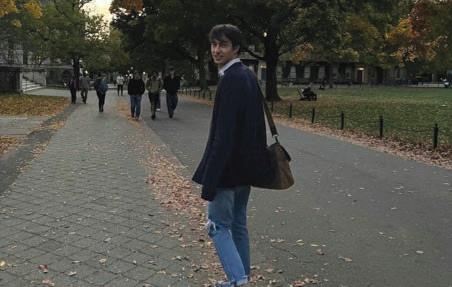
a way of combatting or understanding the flurry of thoughts in his head. I loved how the class responded to his stories, which had their unsettling side — with great care and compassion.”
Blackburn also wrote two pieces for the ‘Prince,’ including one about Park and a profile of a University program that provided protection for Ukrainian and Russian scholars.
Behind Blackburn’s brilliant writing abilities was a caring and inquisitive character that touched many that crossed his path, his mentors and friends said.
“I was Lauren’s advisor for his junior independent work, although very quickly we became something like collaborators, almost co-conspirators, bound together by our mutual love of Virginia Woolf,” Maria diBattista, Professor of English and Comparative Literature, wrote in a statement to the ‘Prince.’
“[Blackburn] was both shy and forthcoming, reluctant to assert himself and at the same time
unguarded about confiding the ideas, intuitions, and feelings that intrigued but could also baffle him,” she added. “He had the most open face, animated by a sweet, almost bashful smile … we ended up talking about books he was eager to read, so hungry was he for the company and impressions of other minds, others’ ways of seeing and being in the world.”
Kathryn Farrell ’25, one of his friends, remembered Blackburn’s inquisitive and often silly character.
“Lauren would show up to late meal with his quiet smile, a draft of some experimental piece of writing which deconstructed the fourth wall between author and reader, and a bacon cheeseburger that would be picked up and set down untouched a hundred times while he spoke enthusiastically about Kant or Rilke or Virginia Woolf,” Farrell wrote to the ‘Prince.’
“Early in our friendship, he convinced me for several months
that ‘Lauren’ was a nickname for his true legal name “Lawrence” (it is not),” she continued. “He would sit or stand on the highest possible horizontal surface in a room like a cat, and make his fingers into heart shapes at his friends.”
“As a friend, Lauren was the most sweet, silly, beautiful person,” Shin added, reflecting on their time together. “He had a way of supporting you that made you feel entirely heard. He was kind. He was so present. He loved with all his heart.” Blackburn is survived by his parents Soonhee and Martin Blackburn, and his siblings Elisabeth, Colin, Cardon, and Quincy Blackburn.
Victoria Davies is a head News editor for the ‘Prince.’ She is from Plymouth, England and typically covers University operations.
Caitlyn Tablada is an assistant News editor for the ‘Prince.’ She is from New York, N.Y. and typically covers student life.
Princeton rising junior passes away in cycling accident
By Victoria Davies Head News Editor
Kerry Grundlingh ’27 has passed away after being hit by a car while cycling near her home in Johannesburg, South Africa.
Grundlingh was a member of the Women’s Openweight Rowing team at Princeton and held a 2025 Ivy League First team gold medal. She was also selected to compete in the 2021 and 2022 Junior World Rowing Championships for South Africa.
A member of Mathey College, Grundlingh majored in economics. She worked as an undergrad-
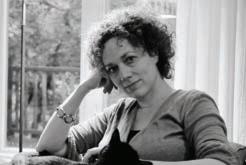

uate tutor through the McGraw Center for Teaching and Learning. Grundlingh graduated from St. Mary’s School in Johannesburg, where she lettered in netball and held a number of academic honors.
A community gathering for Grundlingh will be held on cam-
pus in the fall, Dean of Undergraduate Students Regan Crotty wrote in an email to the student body.
Crotty added that Counseling and Psychological Services, the Office of Religious Life, and the residential colleges “continue to be available” for students when they are away from campus. The TigerLife website holds additional information on resources available to students.
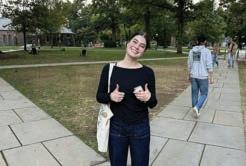

The ‘Prince’ will be writing an obituary for Grundlingh. Please contact news[at]dailyprincetonian.com if you have memories you’d like to share.
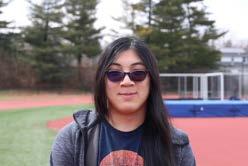

Dorothea von Moltke
Sophia James ’27
James Li ’27
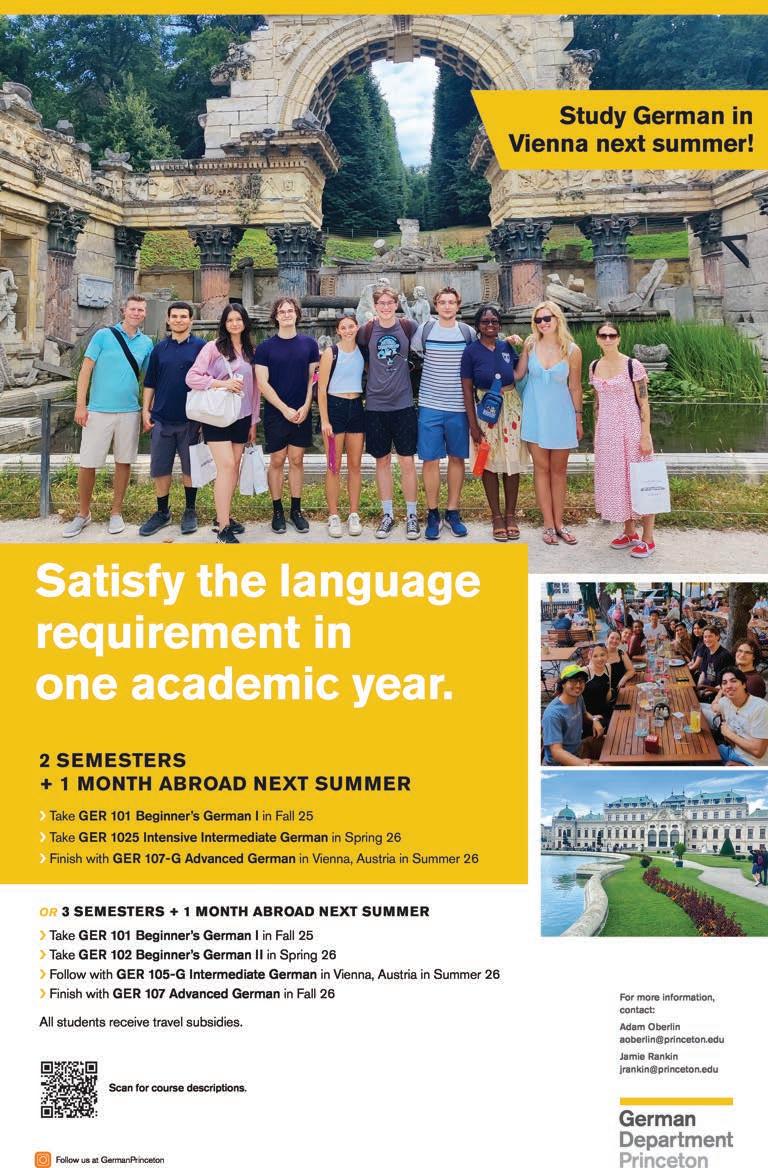
AFTER 27 YEARS: DAVID 59, GOLIATH 55
By Wilson Conn Head Sports Editor
SACRAMENTO, Calif. — The parallels are unavoidable and abundant.
A defensive battle. A Pac-12 champion. And most notably of all, Mitch Henderson ’98.
27 years after knocking off defending national champion UCLA in the first round of the NCAA Tournament, the head coach of Princeton men’s basketball — who was a sophomore guard on the 1996 Tigers team — is once again a tournament Cinderella. On Thursday afternoon, his 15th-seeded squad (22–8, 10–4 Ivy League) knocked off two-seed Arizona (28–7, 14–6 Pac-12), 59–55, giving the Princeton men their first March Madness victory in a quarter-century.
The Tigers’ last tournament triumph was in 1998, but the 1996 win — the final victory in the three-decade career of legendary Princeton head coach Pete Carril — holds a special significance in connection with Thursday’s upset, and not just because of Henderson’s involvement. Carril passed away last August, and the team has worn his signature bow-tie on their uniform this season in his memory.
“So much of what I say is [Carril’s],” Henderson said after the team won Ivy Madness last weekend. “A lot of this is honoring him.”
At the same time, though, Henderson seems intent on carving out his own path, both for himself and the teams he coaches.
“There’s gonna be some comparisons from some of you, I’m sure, to coach Carril,” Henderson told the media after the win Thursday. “But I want to be really clear that this group did this, and that was a really long time ago.”
Indeed, in the nearly threedecades since the famous upset over UCLA, Princeton’s offensive style has changed tremendously. Gone are the days of careful cutting, draining the shot clock, and lulling opposing defenses to sleep. More so than during the Carril years, Henderson’s Tigers rely on their scoring and shotmaking, especially from the three-point line,
to carry them to victory.
Yet, vestiges of the Carill era still remain. The offense, which was once run through facilitating big men like Kit Mueller ’91 and Steve Goodrich ‘98, now goes through the capable hands of senior forward Tosan Evbuomwan, who led the Ivy League this season in assists per game (5.2).
It must have been a concerning sight for Henderson, then, to see both his team’s shotmaking and Evbuomwan’s play falter early on against Arizona; the Tigers missed their first five three-point attempts, and the star forward came up empty on his first four field goal attempts, including a threepointer that sailed past the rim for an airball.
According to Henderson, it was one last remnant of the Carril era which carried the Tigers through their shaky start, and ultimately to victory: their grit.
“That’s the through-line in the program for us, toughness,” Henderson said after the game. “Things that are tough, that are really hard to do … [we take] pride in those things.”
This tenacity was required for the Tigers right from the tip, especially when facing off against Arizona’s big men, Ąžuolas Tubelis (6’11”) and Oumar Ballo (7’0”). This season, the pair had combined for 34 points and 17.8 rebounds per game, on a team that, like Princeton, led its conference in rebounding. The Tigers’ game plan seemed to be to double-team the pair as often as possible to force them into turnovers or tough shots.
While both Tubelis and Ballo started off hot — scoring Arizona’s first 11 points, and 17 of their first 20 — it was the defensive effort of Evbuomwan, senior forward Keeshawn Kellman, and junior forward Zach Martini, among others, that kept the game from getting out of hand. Despite their massive size disadvantage — Kellman is the Tigers’ tallest player in the rotation at six feet, nine inches — the Tigers managed to emerge from the first half winning the rebounding battle, 21–17.
Martini led the Tigers in re-
bounding in the first half with five, finishing with seven boards and two steals.
“Zach Martini was unbelievable,” Henderson said. “He was all over the place.”
Martini came through on the offensive end, too, scoring a threepoint shot to cut the early Arizona lead before scoring on a classic Princeton backdoor cut that sent the basketball historians (and the older alumni in attendance) into a frenzy.
The Pac-12 champions were no pushovers, though, and bounced back from Martini’s run to take a 31–22 lead. The upstart Tigers matched them, going on an 8–0 run to end the half within one point of the Wildcats.
Junior guard Matt Allocco and senior guard Ryan Langborg each had opportunities to give the Tigers the lead heading into the half, but Allocco’s buzzer-beating layup rimmed out. Even though the Tigers weren’t able to break into the lead before halftime, the mood in the locker room was extremely optimistic.
“‘You’re okay, we’re down one, get the crowd on your side, [and] have some fun,’” Henderson recalls saying to his team at the break. “It wasn’t anything earth-shattering.”
“It was loud in there; everybody had something to say, you know,” Allocco told members of the media after the game. “‘We’ve got this, stay in the moment; we’re gonna make shots; we’re gonna make big plays.’”
The numbers backed up the Tigers’ confidence, too. As mentioned, they were winning the rebounding battle, and had also managed to record just four firsthalf turnovers. The Tigers also allowed Arizona to shoot just 30 percent from three and under 45 percent from the field in the first half, while only giving up eight points to players not named Ballo or Tubelis.
“We want to win six games just like Arizona does,” Henderson said, referencing the number of victories required to capture a national championship. “And in order to do that, you’ve got to be tough defensively, because we
did not shoot the ball very well tonight.”
“They didn’t get transition baskets, for the most part,” he added. “We weren’t perfect, but they weren’t getting what they’re really good at.”
However, as the second half began, the Tigers’ advantages began to wane. In the first seven minutes of the period, the Tigers turned the ball over six times. Arizona began to speed the pace of the game offensively and built a lead, which was once as large as 12 points.
Trailing and desperately needing a spark offensively, Princeton turned to sophomore guard Blake Peters. Peters, who has shot 37.6 percent from three this season while averaging just over 13 minutes per game, suddenly played a massive role for the Tigers, knocking down two key threes down the stretch to keep Princeton within striking distance.
Outside of Peters — who shot three-for-five from deep — the Tigers continued to struggle to get their shotmaking on track as the half progressed. They would finish having shot just four-for-25 from deep, and just 40.6 percent from the floor overall.
Once again, though, it was the Tigers’ defense that came through. Kellman, Evbuomwan, and firstyear forward Caden Pierce worked hard to defend the Wildcat bigs, coming up with key blocks and rebound after rebound. In the final eight minutes of play, the Tigers gave up just four points — and zero in the last 4:45 — a nearly unfathomable result against a team that averaged over 80 points per game entering Thursday’s contest.
“It’s such a tough group,” Henderson said. “We’re imperfect, but we’re a very tough group.”
As the defense held, the Tigers continued to search for a shot that would put them in the lead. As was the case at the end of the first half, the Tigers struggled to find a way through, with both Langborg and Pierce missing open three-pointers.
“We talk confidently,” Henderson said. “We felt we could win, [and] with four minutes left, [we said] ‘we’re gonna win this game.’”
Langborg finally found the bottom of the net on a foul-line jumper to cut the Arizona lead to one at 55–54, before scoring a layup to give the Tigers their first lead of the game with just over two minutes remaining. The Californian was a hero on the defensive end, too, blocking Arizona guard Courtney Ramey with just 50 seconds remaining.
After Caden Pierce hit a pair of free throws, Arizona had one last chance to tie the game, now trailing by three. At that point, it seemed the Tigers were ready to cash in on a bit of March Madness underdog luck.
“They had three shots at the basket from 21 seconds [left],” Henderson said. “Those usually go in in a game like this ... We got lucky.”
With the win, the Tigers became just the 11th 15-seed to win an NCAA Tournament game, and the third in the last three seasons, following in the footsteps of fellow New-Jerseyans Saint Peter’s, who made it all the way to the Elite Eight as a 15-seed last season. They are the lowest-seeded Ivy League team to ever win a March Madness game.
“To beat a great team like that on this stage is a pretty special feeling, but also, I can’t say I’m surprised,” Allocco said. “This team has been so good all year.”
“On paper, it’s going to look like a big upset,” he continued. “But we believe in each other and we think we’re a really good team. When we’re at our best, I think we can beat anybody in the country.”
The Tigers will now continue their tournament journey against seventh-seeded Missouri (25–9, 11–7 Southeastern) on Saturday. Even with the short turnaround, Henderson is confident the Tigers can keep their run going.
“We played the majority of our games in our league on back-tobacks,” he said. “So the [extra] day of preparation is quite nice.”
“Missouri is really good, [and] we’re playing great,” he added. “It’ll be a fun challenge.”
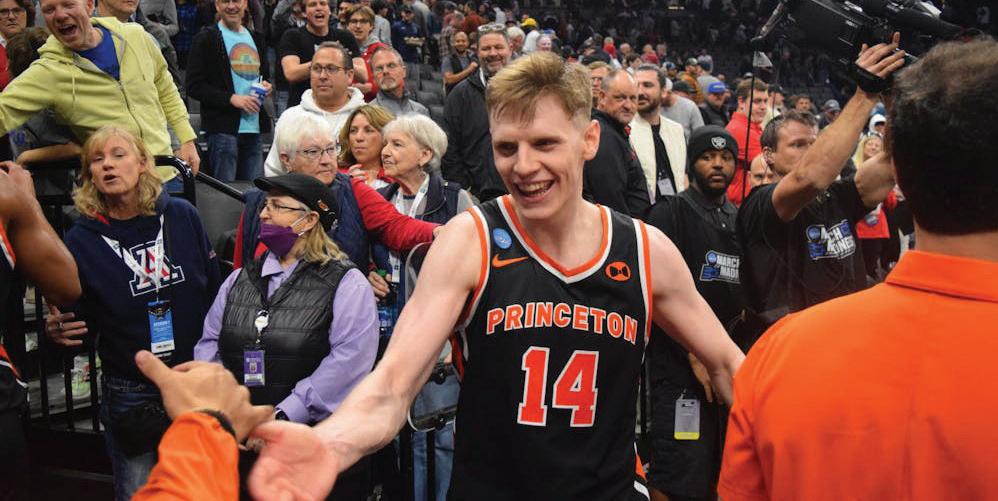
Wilson Conn is a head editor for the Sports section at the ‘Prince.’
Women’s basketball falls 68–63 in First Four round of March Madness
margin in the other two quarters of play, as their stars took control towards the end of the fourth.
SOUTH BEND, Indiana — Sophomore guard Ashley Chea walked off the court last, her head hanging down.
The unanimous first-team AllIvy point guard tried to will her team to victory, but star sophomore center Audi Crooks, sophomore forward Addy Brown, and the Iowa State Cyclones proved too much.
Chea scored seven points in the first two minutes and then just eight in the remaining 38, as the Tigers (21—8 overall, 12—2 Ivy League) fell to Iowa State (23—11, 12—6 Big 12), 68–63, on Wednesday night. For Princeton, the loss ends a season of youth, with a starting core of four sophomores leading the Tigers through high and low.
Wednesday night, the Cyclones brought no surprises. Crooks proved why she was unanimous First-Team All-Big 12, scoring 27 points, and Brown added 22 points while playing all 40 minutes.
Crooks’s performance came while primarily being defended by senior forward Parker Hill, who had a double-double with 12 rebounds and 10 points on the day.
“We don’t see players like Audi Crooks in the Ivy League, and that was definitely an adjustment,” Hill told The Daily Princetonian. “We were working on being strong and trying not to foul.”
Both sides dominated one quarter, with Princeton outscoring Iowa State 27–7 in the second and the Cyclones returning the favor with a 27–9 margin in the third.
Iowa State maintained a small
Despite the loss, this was arguably head coach Carla Berube’s most impressive season in charge of the Tigers. Princeton returned just two starters and grew throughout the season with a young core, once again asserting themselves at the top of the Ivy League.
“[This season] was a great mix of youth and senior leadership,” Berube said postgame.
Sophomore forward Fadima Tall, who did not play at all in last year’s March Madness loss to West Virginia, led the Tigers with 19 points while drawing the difficult role of defending Addy Brown.
“Fadima is tough,” Berube said. “Really proud of the work that she puts in, and I think she’s going to be a tremendous player for us [in the future].”
The Cyclones’ two stars opened up the game, combining for 13 points in the first quarter. Princeton initially struggled to adjust to the Cyclones’ scheme on both sides of the court, going 5–18 on field goals while missing a few open looks.
The tables turned in the second as the Cyclones learned what Ivy League defense is all about. Relying on Hill and junior forward Tabitha Amanze to stop Crooks inside, Princeton held Iowa State to just two points in the first five minutes of the quarter.
The momentum shifted Princeton’s way, and the Tigers took it and ran, going on a 14–0 run in the last three and a half minutes of the quarter. Led by Chea’s eight points, the team surged ahead while Tall
shined, neutralizing Brown and adding five points in the frame.
“There was definitely an emphasis on making sure we’re taking the best shot we can get in the second quarter, and then they felt a lot better,” Hill said of the offensive success.
At the half, an ecstatic Tigers squad ran into the locker room full of confidence as they seemed to have figured out the Cyclones. Outscoring Iowa State by a jawdropping 27–7 margin and forcing eight turnovers, Princeton led 38–25 at the break.
Just as quickly as the tides turned in the second for Princeton, they did in the third for Iowa State. Crooks and Brown played nearly all ten minutes, as Iowa State shot 58% in the quarter. Princeton’s shots, which all seemed to fall in the second quarter, missed their mark.
By the time Iowa State took a three-point lead on a fast-break layup, a furious Berube called timeout to calm her players down, bringing in senior forward Katie Thiers and junior forward Taylor Charles. Thiers is a contributing Features writer for the ‘Prince.’
“I think that we were a little gassed,” Berube told the ‘Prince’ postgame. “We need[ed] some help from our bench.”
Still, Princeton couldn’t right the ship. When Iowa State senior guard Emily Ryan put an exclamation point on the third quarter with a buzzer-beating layup, the Cyclones had a 52–47 lead going into the fourth. Notably, Chea was held to only four shot attempts — and no field goals — in the second half while being primarily defended by Arianna Jackson.
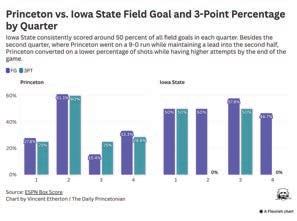
Iowa State head coach Bill Fennelly spoke about the help-defense strategy he employed on Chea, which proved to be the difference maker.
“When you play a great player, you work really hard, you help a lot, and you hope they miss a couple,” Fennelly said. “It was a player and a half on her the whole second half.”
Princeton caught their footing in the fourth, with Belker connecting on her first three of the game and following up with a layup on the ensuing possession. But Princeton could only keep pace with the Cyclones, failing to bring the game within one possession despite multiple attempts.
Princeton’s final chance came on a Belker three-point attempt with fifteen seconds left, but her shot tantalizingly rolled around the rim before falling into a defender’s hands. Berube’s disappointed face said it all.
For Princeton, yet another game that looked so promising at the half had fallen just out of reach, as Iowa State advanced to the second round with a 68–63 win.
The loss stings for the Tigers, who will lose five seniors next year.
“I’ve loved the time I’ve been here, and it always sucks to end your season and end on a loss,” an emotional Hill said. “This program means a lot to me and I couldn’t be happier where I ended up.”
The remaining Tigers will surely use this loss as fuel for next year’s fire, as a healthy will-be senior guard Madison St. Rose will rejoin the young core.
“I look forward to seeing what the rest of them do next year and the year after that,” Hill said.
Max Hines is a senior Sports writer for the ‘Prince.’
Men’s basketball falls to Yale 59-57 in Ivy Madness semi-final heartbreaker
of 12 and 13 points, respectively.
PROVIDENCE, R.I. — On Saturday afternoon, Princeton men’s basketball (19–11 overall, 8–7 Ivy League) fell to Yale (22–7, 14–1), 59–57, for the third time this season in a tightly contested battle in the Ivy League Tournament semifinals. With the loss, the Tigers lose their shot at an automatic bid for March Madness.
“I’m proud to have played in a really meaningful game — they’re a really good team,” head coach Mitch Henderson ’98 said postgame. “We weren’t competitive with them in the first two games of the season. This was as resilient as we looked all season.”
Princeton entered Ivy Madness as the fourth seed, despite having been predicted to win the Ivy League preseason, a testament to the seasonlong difficulties the team has faced on both ends of the court. The Tigers have been plagued by turnovers and difficulty getting points in the paint. On the other end, Yale was enjoying one of their most successful seasons in recent memory. With only one conference defeat, the Bulldogs dominated the Ivy League in many facets, led by the now three-time Ivy League Defensive Player of the Year and Player of the Year Bez Mbeng as well as the league’s top scorer John Poulakidas.
Sophomore forward Jacob Huggins and sophomore guard Dalen Davis led the Tigers in the +/- category against the Bulldogs, a statistic describing the relative points gained or lost against the opponent when the player is on the floor. Huggins and Davis had +/-’s
Despite these contributions, over the course of the season, both players faced troubles with time on the court.
“Gotta blame the coach on that one,” Henderson commented. “[Huggins] was really helpful all season, and you know, it was my decision at certain times to not play him but he was terrific when he did [play].”
“I always try to be prepared mentally for a game like this,” Huggins told The Daily Princetonian’. “Whenever your number gets called you got to be ready.”
“Dalen was +13,” Henderson continued. “We needed that, and it wasn’t my best year, but I thought that tonight we showed what we can be.”
The Bulldogs came onto the court with absolute intensity. Forward Nick Townsend bodied through defenders, while the Tigers simply could not make shots, taking their first timeout down 9–0.
Princeton could not muster a single point for the first five minutes, trailing a game-worst 12–0. Davis scored the first points for the Tigers with a three-pointer off the bench, before senior guard Blake Peters followed suit with a layup that cut the deficit to 12–5.
Junior standout Xavian Lee’s assist to Huggins then made history, giving Lee the Princeton single-season assist record with 162 — previously held by Tosan Evbuomwan ’23 — and bringing the Tigers to a 21–17 deficit.
Peters then energized the crowd with a triple that brought the deficit to just one point , 21–20.
But following a media timeout, the momentum once again
shifted in the Bulldogs’ favor as Mbeng’s skills led Yale to a 10–0 run, giving them an 11-point lead with two minutes in the half.
The Tigers responded with Peters’ third triple of the night and Dalen’s strength under the rim for a 5–0 run cut off by the halftime buzzer.
The Tigers entered the locker room down 31–25, with six points being their lowest halftime deficit against Yale this season.
Impressively, the Tigers’ defense held Yale to zero triples from seven attempts.The Bulldog dominance in the paint was the difference in the first.
The Tigers opened the second half with two turnovers and a missed open three-pointer, before Poulakidas drained Yale’s first two three-pointers of the night. Peters responded with another three of his own, but the Tigers continued their disastrous shooting beyond the arc, quickly trailing 39–28.
The Tigers came out of the next timeout more precise, highlighted by a Davis jumper and a third Lee-toPierce slam dunk. But Yale pushed back with their persistent offensive boards, leaving the Tigers down 45–35 at the second media timeout.
Henderson was constantly subbing players in and out as Peters and Happy each found themselves with three fouls, but Princeton regained momentum through Lee. Despite struggling to drive through Yale’s presence in the paint, he persisted into a layup, assisted Huggins, and then drilled a three-pointer to keep the Tigers in the game, down 49–42.
Peters came back onto the court and immediately sank a triple, before Davis nailed two free throws
that brought the deficit to just two points, 49–47.
A pair of Townsend free throws and an alley-oop from him to center Samson Aletan appeared to cut the Tigers’ hopes short once again, but Davis did not back down. Powering through the paint as the shortest player on the court, he managed a layup as Princeton called a timeout down 53–49.
On the other end, Pierce played excellent defense against Townsend, forcing a miss and driving to the other end for a layup, bringing the Tigers once again within two points, down 53–51.
After a Poulakidas missed free throw, the Tigers stormed down the court and found Happy for a three, sending Tiger fans into a frenzy as they took their first lead of the game, 54–53.
The remaining three minutes were crucial. Mbeng scored an and-one on Lee’s fourth foul of the game, but Lee responded with a mean crossover and a monumental triple that gave the Tigers the lead with just over a minute to go, 57–56.
Poulakidas, closely guarded by Peters, managed to nail a closelycontested three-pointer with just under a minute remaining, pulling the Bulldogs back up to 59–57.
“I was trying to influence him right, but it’s a great play.” Peters said postgame. “It’ll eat at me forever.”
On the other end, Pierce tried driving for a layup, but Yale forward Casey Simmons denied him. The Bulldogs took the ball back with 33 seconds left Now facing a three-second shot clock differential, Poulakidas took his
time. With Lee and Peters both on four fouls, there was miscommunication on the court about fouling him or not. Poulakidas calmly held onto the ball for a shot-clock violation, with Princeton quickly calling a timeout for a final shot at defying the odds.
A controversial shot-clock change did not change Henderson’s plan as the most clutch player on the team was clear. With five game winners this season, all eyes turned onto Princeton’s final hope, Xaivian Lee.
“We knew what we were doing,” Henderson said about the last play. “I was like, ‘that’s going in, no way.’”
But as the crowd held its breath, the Tigers ended their season with a heartbreaker after Lee’s shot bounced off the back rim.
“I’ve got to make that shot,” Lee reflected about the last play.
Peters was the only senior to appear on the court in Princeton’s final game of the season.
“He’s just done all he’s done to make Princeton basketball better. He personified what we are,” Henderson told the ‘Prince.’
“We’ve accomplished a lot in four years,” Peters reflected post-game. “This was my dream, my whole life,” Peters tearfully continued.
Yale will play the winner of Cornell (17–10, 9–5 Ivy League) and Dartmouth (14–13, 8–6 Ivy League) in the Ivy League Tournament final tomorrow at noon for an automatic bid to the NCAA Tournament.
Bryant Figueroa is an assistant Sports editor for the ‘Prince.’ Lily Pampolina contributed reporting.
By Bryant Figueroa Assistant Sports Editor
By Max Hines Senior Sports Writer
PRINCETON PLAYERS GO PRO
Former Tiger star Chen ’24 taken 30th overall in WNBA Draft, third Princetonian ever
By Harrison Blank & Emilia Reay Head Sports Editor & Staff Sports Writer
Former women’s basketball star point guard Kaitlyn Chen ’24 became the third former Tiger to be drafted in the WNBA on Monday night. The Golden State Valkyries selected the three-time Ivy League Player of the Year with the 30th overall pick, the sixth pick of the third round.
Chen joins Abby Myers ’22 and Bella Alarie ’20 as the only Tigers taken in the WNBA draft in the league’s 29 years. The three former stars of the Orange and Black helped drive women’s basketball’s five straight Ivy League regular season and tournament championships from 2018 to 2024.
Chen was a standout point guard during her time at Princeton. She led the Tigers to three regular season and tournament championships each, and she also
helped the team win two NCAA Tournament games. She holds the third-best assist record in Princeton program history as well. In 2023, Chen was named Ivy League Player of the Year.
Chen stood out not only in the Ivy League but brought the same energy and basketball IQ to Storrs, CT, for her fifth and final year of eligibility. Chen spent the 2024–2025 season with the University of Connecticut Huskies, who won the NCAA championship just eight days ago.
“I had a good feeling that she [Chen] might get drafted, just her career at Princeton and the season she had at UConn— I think she would add a lot of value to a WNBA team,” Head Coach Carla Berube told The Daily Princetonian. “So, yeah, I was optimistic about the chances.”
Chen followed in Coach Berube’s footsteps by playing for the Huskies. When Coach Berube played college ball at UConn, she was a
part of the 1995 team that brought the trophy to Storrs for the first time, now, 30 years later, one of her own players was an integral part of the 12th UConn national title. This shared experience has strengthened Berube and Chen’s relationship with each other.
“Of course I’m a huge UConn fan regardless of if she [Chen] were there, and it just made it even more incredible to watch them win their 12th National Championship with Kaitlyn as the starting point guard; it was pretty special,” Berube added. “It was great having some of my Princeton alums there watching it, my whole staff; we had a blast.”
At UConn, she averaged over 20 minutes, almost seven points, and nearly three and a half assists per game while appearing in all 40 games. She is one of three Huskies drafted last night, including Paige Bueckers, the number one pick overall, and Aubrey Griffin, the 37th selection of the draft.
Chen’s selection comes as a slight surprise, as ESPN’s final mock draft did not predict her being taken in any of the draft’s three 12-pick rounds. SBNation’s final mock draft also did not have Chen as a selection. But Golden State is taking a chance on Chen’s ability to run the offense as a floor general, and to win.
“With basketball, I just sort of let it take me on this journey, and I haven’t really had any expectations from the start,” Chen stated in a press conference shortly after she was drafted. “And I was lucky enough to have such a great time at Princeton and be so successful there and I was lucky enough to be given the opportunity to come to UConn. So, I think I’m just taking everything as it goes, and it’s been a pretty great ride so far.”
Chen is also not the only Ivy League player to get drafted this go-around. Harvard’s Harmoni Turner was selected by the Las Vegas Aces in the 35th pick of the
Jalen Travis ’24 selected by Indianapolis
draft. Last year, three Ivy League players were drafted to the WNBA, although none played for the Tigers.
Chen will return back to her home state of California to play for the Valkyries, one of two new expansion teams for the 2025 season. Golden State will play their first ever game in franchise history on May 16 against the Los Angeles Sparks when the WNBA kicks off.
“She [Chen] plays with a lot of joy, she finds joy in things,” Coach Berube told the ‘Prince’. “I think that she is just a really really great teammate and hopefully she continues to do that—off the court, on the court, really showing the Valkyries what a benefit she will be to their franchise.”
Emilia Reay is a staff Sports writer for the ‘Prince.’
Harrison Blank is a head Sports editor for the ‘Prince.’
Colts
in fourth round of NFL Draft
By Alex Beverton-Smith Head Sports Editor
With the 127th pick of the 2025 NFL Draft, Jalen Travis ’24 was selected by the Indianapolis Colts in an early Day Three selection. Travis becomes the highest-drafted player in program history, marking a huge achievement for the program.
At Princeton, Travis played on the offensive line as an offensive tackle. During his four years with the Tigers, he earned second-team All-Ivy honors in 2022 and 2023. He started all games in 2021 and 2022 before missing his final four with the Tigers in 2023 due to an injury. Off the field, he was one of just six recipients of the 2024 Coach Wooden Citizenship Cup and won a Truman Scholarship — a scholarship given to college juniors to pursue graduate school and professional development in public service.
NFL scouts began watching Jalen Travis as early as his junior year at Princeton, drawn by physicality. At 6-foot-7 and 339 pounds, Travis projects as a formidable presence on the offensive line, with the tools to thrive in both pass protection and run-blocking schemes.
By his senior year at Princeton, the NFL Draft was becoming a real possibility for Travis; he was selected to the 2024 Senior Bowl Watchlist and was considered a late-round prospect in the 2024 NFL Draft.
Instead of declaring for the draft, Travis opted to use his fifth year of eligibility, taking his talents outside of the Ivy League and to the Big 12 Conference as an Iowa State Cyclone. Unlike many other schools across the nation, the Ivy League does not allow athletes to use their fifth year of eligibility outside of their four years of undergraduate studies.
At Iowa State, Travis’ abilities and draft stock only grew. Coming off an injury, he played in the final 12 games of the season, making 11 starts at left tackle and dominating on the O-line.
“Each institution, respectively, is viewed by these teams as being a tremendous addition or having
tremendous influence,” Travis said to The Daily Princetonian about the role NFL teams’ perceptions of Princeton and Iowa State play in terms of his draft prospects. “The reason that they evaluated me and that the Colts, for example, ended up selecting me so high [is because] in Princeton, there is something that is completely well respected across the league.”
After his final collegiate season ended in a 42–41 win over Cam Ward’s Miami in the Pop-Tarts Bowl back in December 2024, Travis’ sights were firmly set on the draft.
The first big test for Travis came during the Senior Bowl, held in Mobile, Alabama on Feb 2, 2025. This mock game allows scouts to see players compete altogether as well as complete drills against one another to see how they stack up against the field. Travis, for his part, performed very well, already garnering attention for his athleticism.
His draft stock rose most abruptly after scoring a 9.09 out of a possible 10.00 in his Relative Athletic Score (RAS) in early March. RAS measures key physical metrics such as size, speed, and strength across several fields — Travis’ score placed him 137th out of all 1501 offensive tackles from 1987 to 2025.
“It was incredible. Every day presented a new challenge that you necessarily couldn’t prepare for in its entirety,” Travis said to the ‘Prince’ about the pre-draft process. “As someone who grew up watching guys compete on the [NFL] Combine stage, and to be there and be able to compete myself — and perform pretty well — that was super humbling.”
After the NFL Combine wrapped on March 2, 2025, Jalen Travis felt confident about his draft prospects as he continued interviewing with teams across the league. While his fourth-round selection may have caught some observers off guard, Travis and his camp expected it based on the strong interest he received throughout the process.
“We knew that [with] some of
the feedback from the teams that I was projected to be more of a midround pick, anywhere between round three to the end of round five,” Travis said.
Nevertheless, the information given by teams to Travis was only a projection. Despite confidence within his camp, he knew that on draft day anything can happen.
“The funny thing about the draft is that it’s a giant game of poker,” Travis explained to the ‘Prince.’ “Despite what you may hear from teams in the pre-draft process, the draft is so variable that you never really know how it’s going to shake out.”
After being selected by the Colts, expect Travis to be a solid backup on the offensive line for his rookie season. Many predict him to slot in at right tackle, behind Braden Smith, although there is still a long offseason ahead. Being a rookie, the Colts will be hoping to develop the Minnesota native and get him learning the playbook quickly.
Indianapolis finished the 2024 season in disappointing fashion, with a 8–9 record and a secondplace finish in the AFC South — not enough to earn them a playoff
spot. In doing so, they extended their playoff drought to four seasons, something which Travis and the entire organization is working to avoid in 2025.
“I think they have a great culture coaching staff, and they recruit the right type of people,” Travis said of the Colts. “In a lot of ways it’s a continuance from what I had at Iowa State.”
“I also think there’s a tremendous opportunity within the team to one, compete to play, but also help this team return back to playoff level football, with the goal of winning a Super Bowl, which I do believe ... we have what it takes. I’m just eager to get in the room and start competing towards that goal,” Travis continued.
Head coach Shane Steichen is going into his third season with the team and will continue to call plays on offense next year. With other exciting draft additions such as top-rated tight end Tyler Warren out of Penn State in the first round and edge rusher JT Tuimoloau out of Ohio State in the third round, the Colts’ fan base has a lot to look forward to next season.
The new draft class — given an ‘A’ rating — combined with free
agency additions safety Camryn Bynum, cornerback Charvarius Ward, and quarterback Daniel Jones help give the team a rehaul. Travis will look to find his place amongst this exciting roster as the summer begins.
“It’s been one of the biggest physical and mental challenges that I’ve been through, but one that I would for sure do again if I could,” Travis said to the ‘Prince’ of the last few months.
Travis becomes the first player drafted from Princeton since Andrei Iosivas ’23 who was selected 206th overall by the Cincinnati Bengals in the 2023 Draft and has since cemented himself as the 3rdstring wide receiver on the team — behind the likes of superstars Ja’Marr Chase and Tee Higgins.
The Colts’ first games will be in early September and Travis should have no problems making the 53-man roster. Should he be included and see game time, he will become the 38th-ever Princetonian to reach the highest echelons of the football world.
Alex Beverton-Smith is a head Sports editor for the ‘Prince.’
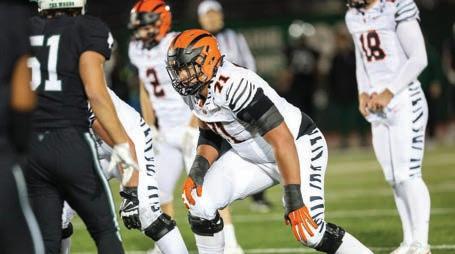
Maia Weintraub ’26 clinches gold in fencing as part of USA women’s foil team
By Alex Beverton-Smith & Max Hines Assistant Sports Editor & Senior
Writer
On a busy Thursday afternoon in Paris, the Tigers smelled gold in the women’s foil competition taking place at The Grand Palais. Team USA, with junior Maia Weintraub on the roster, cruised through their three bracket matches to take the top prize. In turn, they became the first ever American team, male or female, to claim gold in the team-based competition, with Weintraub claiming another gold medal for the Orange and Black.
“Once that final touch was made, it was just pure emotion. It was unbelievable to all of us, so many tears were shed, but happy tears,” Weintraub told The Daily Princetonian. “It just felt like all of our efforts and hard work culminated in this, and it was crazy to realize this was over.”
Fencing consists of three different blades — saber, epeé, and foil — and in the Paris Olympics, there are men’s and women’s individual and team events for all three blades. Weintraub and the gold medal-winning team competed in the team foil event.
The foil competition scores differently from the other blades — to score a point, you can only strike the torso of your opponent. This means unlike with the épée or sabre competitions, touches on the head, arms, or legs do not count.
The American team consisted of Lee Kiefer, Harvard’s Lauren
Scruggs, Columbia alumna Jacqueline Dubrovich, and Weintraub. Kiefer and Scruggs had already competed against each other in the women’s individual foil competition, claiming gold and silver respectively, setting up American hopes for a strong team competition.
Each team match consists of nine bouts, where teams of three fencers and a substitute play each member of the opposing team once. The bout ends when either three minutes run out or when the winning team reaches the maximum allowed score for the respective round.
Weintraub did not feature in the first-round matchup. Kiefer, Scruggs, and Dubrovich won a close match against China, winning 45–37 after taking a small lead to start and slowly growing it.
“The uncertainty of my role was expected, and I think that made it even more challenging,” Weintraub said to the ‘Prince’ about her position within the team. “I had to be prepared for all situations.”
Team USA, seeded second, faced Canada in the semifinals. Canada defeated France 38–36 in the first round, while fellow Princeton sophomore Sabrina Fang did not play. While neither Weintraub nor Fang played in the semifinal matchup, Team USA defeated Team Canada 45–31, advancing to a final against top overall seed Italy.
“There was obviously a danger of being too excited almost, especially after winning a semifinal and realizing we had secured a medal,”
Weintraub said to the ‘Prince.’ “We were ecstatic, but we had to reign in our emotions and get ready to focus for the finals in order to try and bring home the gold.”
Stepping up when she was needed the most, Weintraub substituted in for Jacqueline Dubrovich early in the gold medal match. Weintraub played twice more down the stretch, outscoring those two opponents by a combined 11–5 in an extraordinary performance.
Facing Arianna Errigo in her first match, Weintraub went down 3–0 before tying it at 3–3 and then 4–4 in a close matchup. She came back, however, to beat Errigo 6–4 reaching the maximum team score of 25 for the round and ending their bout, securing vital points for the team.
“I think in the beginning, I was almost trying to be too perfect with my fencing; being out there the lights are so much brighter,”
Weintraub said to the ‘Prince.’ “I realized I should be free, be creative, and just have fun while I’m on the greatest trip in fencing.”
For her second and final bout, she faced Francesca Palumbo, the Italian team’s substitute, and quickly dispatched her, based on team points, with 1:09 remaining in their three minute matchup.
Weintraub went up 2–1 before a point for her opponent was overturned, and within the next 30 seconds, she managed to secure three more hits to end the bout at 5–1. With her victory, she brought the USA team lead up to 35–26.
“Seeing how my teammates
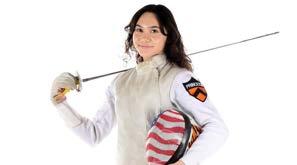
were very supportive, always cheering for each other, gave me the confidence boost I needed for the match,” Weintraub expressed to the ‘Prince.’
Weintraub’s contributions were essential. Heading into the final bout up 40–32, Scruggs crossed the finish line for Team USA, leading them to a 45–39 win, exactly Weintraub’s margin of victory in her two full bouts post-substitution, showing that the Princeton Tiger was the difference for Team USA.
For Team USA, it is a historic victory — their first ever gold in the event and only team gold medal in fencing this Olympics.
Weintraub, with both an Ivy League and NCAA foil title already under her belt, now adds an Olympic gold medal to her resume.
“First business is to go back to school,” Weintraub told the ‘Prince.’ “I’m definitely going to
continue fencing, and I’m trying to go for 2028 [Olympics], but I think next year, I want to have more time for myself and my school life.”
“I took a gap year this past year for fencing, and I want to get back and focus on my academics, being there with my friends, and things I can only do for two more years,” Weintraub continued.
The Los Angeles 2028 Olympics are far away for now, but in the meantime, Weintraub has two more years to fence for Princeton and come back to reclaim her Ivy League and NCAA titles. Regardless of her future, however, Olympic champion is a title she can never lose.
Max Hines is a senior Sports writer for the ‘Prince.’
Alex Beverton-Smith is an assistant Sports editor for the ‘Prince.’


TIGERS DOMINATING THE IVY LEAGUE, PLAYOFFS
Six for six: men’s and women’s track and field both complete triple crown
By Luke Stockless Staff Sports Writer
A year that saw the first-ever triple-double in Princeton basketball history also saw the return of the “double-triple” for the track and field program. For the first time in 14 years, both the men’s and women’s track and field teams secured “triple crown” honors — XC, indoor, and outdoor Ivy League titles — with wins at this weekend’s Ivy League Heptagonal Outdoor Track and Field Championships (Heps) in New Haven, Conn.
The men’s team ended the weekend with a score of 212.5 points to Harvard’s 128 and Penn’s 112. Host Yale finished last with 23 points. The women’s squad also eclipsed the 200-point barrier with 202.5, holding off second-place Harvard, which accrued 178.5 points. This marks the 12th time the men have won the triple crown, including three in the past four years. The women accomplished the feat for the third time ever and the first since 2011.
‘Winning never gets old’: Men continue winning ways Princeton men’s track and field and cross country have now been the foremost force in the Ivy League for over a decade. The Tigers have taken home 24 out of the last 30 Heps titles across the 10 seasons, including 10 straight indoors. The current crop of seniors has gone 11 for 12, only placing second at outdoor Heps in 2023.
The meet wasn’t all smooth for Princeton, but no hiccups would have been big enough to knock the
team off its path to victory. First-year Marcelo Parra eased up at the line in the 3000m steeplechase, costing him the win, but he and his twin brother Franco still scored 14 points in the event. The men’s 4x100m relay team dropped the baton and did not finish the race, but the sprinters made up for it by scoring 18 points in both the 100m and 200m dashes.
All told, just five of the 22 events were won by Tigers, compared to nine of 20 indoors, but Princeton’s depth proved insurmountable for the rest of the Ivy League. This depth is what allowed the Tigers to eke out their fourth-consecutive cross country title over Harvard in the fall, and with the Crimson now missing Olympic distance star Graham Blanks, the gap in the longer events continues to widen. Princeton scored 61 points in the mid-distance and distance races to Harvard’s 42. No other team posted more than 22.
Junior Greg Foster was the star of the show for the Tigers. He has won the long jump at Heps every time he’s contested it, and he retained his crown with a 7.71-meter leap. Foster also ran the 110m hurdles and cemented himself as a double champ, clocking a 13.78-second meet record.
Senior Harrison Witt in the 1500m, junior Casey Helm in the discus throw, and sophomore Jackson Clarke in the 200m also took home individual wins for the Orange and Black.
Witt didn’t stop at 1500m, however. Immediately after his win, he ran halfway around the track to go pump up his teammates. “I
kept running after I crossed the line, not as a celebration, but as a way to go high-five and fire up my teammates who were lining the whole track,” Witt told The Daily Princetonian. “I wanted to kickstart our momentum.”
“I can’t express enough gratitude for my teammates. It was very special to win one final championship with my best friends,” he added. “As they would also tell you, winning never gets old.”
Field athletes lead women back to glory
Just like indoors and XC, outdoor Heps was effectively a dual meet against Harvard for the Princeton women, and as in those two previous matchups, the Tigers reigned supreme.
The meet was a true team effort, with the Tigers scoring points in all but three events. Princeton’s jumpers, throwers, and vaulters contributed very strongly to the win, completely dominating their conference competition. Including the heptathlon, Princeton scored 129.5 points in the field events to Harvard’s 42.5.
A Tiger topped the podium in five of the nine field events. Senior Siniru Iheoma dominated the shot put, and juniors Julia Jongejeugd, Georgina Scoot, and Shea Greene all led 1–2 Princeton finishes in the heptathlon, long jump, and javelin throw, respectively. Scoot also won the triple jump, setting meet records in both the long jump at 6.51m and the triple jump at 13.36m, which earned her National Athlete of the
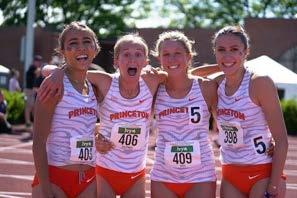
Week honors, marking the first time a Princeton student has ever won this distinction outdoors.
Each of these women defended their titles from last year’s Heps, except Scoot, who placed second in last year’s long jump final behind this year’s runner-up, junior Alex Kelly.
While some graduation-induced departures, such as Iheoma’s, are sure to deliver a tough blow to this incredible field core, many of the Tigers field-eventers will be back next year to defend their individual and team titles.
On the track, senior Mena Scatchard had one last bit of Heps heroics in store as her stellar Princeton career nears its close. The Stanford-bound senior easily defended her 1500m crown and produced the meet’s signature moment in the 4x800m relay.
Scatchard got the baton in second place, trailing Harvard’s Sophia Gorriaran, the open 800m champion, but she ran down the Crimson standout in the home stretch. Scatchard’s split of 2:02.11 stopped the clock at a meet record of 8:27.31, just 0.06 seconds ahead of Harvard’s mark.
“The last 100m of that race was probably the best and most satisfying finish of a race I’ve ever had,” Scatchard said of her winning relay leg.
The Tigers will host one last home meet, the Princeton Elite Invitational, on May 17, and select athletes will then go on to compete at NCAA regionals and nationals.
Luke Stockless is a staff Sports writer for the ‘Prince.’
No. 3 men’s lacrosse season ends in NCAA quarterfinals after 19–18 loss to No. 5 Syracuse
By Hayk Yengibaryan Senior Sports Writer
The Tigers went toe to toe with the Orange for nearly 60 minutes, but in the end, the Tigers were dealt the final blow.
On Saturday afternoon, No. 3 ranked and seeded Tiger men’s lacrosse (13–4 overall, 5–1 Ivy League) bowed out of the NCAA tournament in the quarterfinals, losing to No. 5 ranked and No. 6 seeded Syracuse (13–5, 2–2 Atlantic Coast Conference) 19–18 after an instant thriller with 11 ties and nine lead changes.
“That was one of the craziest games I’ve ever been a part of,” junior attacker Chad Palumbo told reporters postgame. “There’s a lot of trust and a lot of love in this squad.”
For the Orange, the win marks their first appearance in the Final Four since 2013 and their 27th overall. Meanwhile, the season comes to an end for a Tiger team who had national championship aspirations, but ended the season trophy-less. The rivalry between both sides is a storied one, with Princeton and Syracuse meeting in three consecutive NCAA finals from 2000–2002.
“Our goal is to always take these groups as far as we can,” Head Coach Matt Madalon said postgame. “This is a group we thought we could take really far. The buy-in from this group was truly incredible.”
Palumbo was exceptional, finishing with a career-high six
goals, tying the program record for goals in an NCAA tournament game, alongside two assists. Senior attacker Coulter Mackesy and first-year attacker Peter Buonanno each recorded a hat trick. However, it wasn’t enough to stop Syracuse attackers Joey Spallina and Owen Hiltz, who combined for seven goals and six assists.
Mackesy’s career comes to an end in Old Nassau, where he finishes first all-time in career goals with 167 and second all-time in points with 248 (167 goals, 81 assists).
“Anytime a season comes to an end and you have to say goodbye to a senior class, I think that’s the hardest part of these moments,” Madalon said.
The biggest surprise of the night came at the X. Coming into the game, Syracuse face-off specialist John Mullen ranked third in the country in success rate and won over 80 percent of his draws last weekend against Harvard. However, junior face-off specialist Andrew McMeekin had other plans, winning 20 of 36 for the Tigers. Mullen finished under 50 percent for just the third time in 18 games.
“He’s [Mullen] obviously one of the best in the country, but we think really highly of our guy [McMeekin] as well,” coach Madalon said.
Both sides exchanged goals to start the game, with Palumbo getting on the board for the Tigers. Consecutive goals by Mackesy
and sophomore midfielder Tucker Wade put Princeton up 3–1. For Mackesy, it marked his 35th straight game with a goal.
The Tigers only grew their lead as they went up 5–2, but the Orange soon responded. Mullen won three consecutive draws as Syracuse ripped away four consecutive goals to take a 6–5 lead at the end of the first quarter. All 11 first-quarter goals came from a different player.
The second quarter was all Spallina, who scored four unassisted goals on senior defender Colin Mulshine to give the Orange a 9–7 lead. Coach Madalon decided to make a change and put sophomore defender Jack Stahl on Spallina. After a near five minute drought, Mackesy showed his shot versatility to cut the Syracuse lead to one, 9–8.
Syracuse goalie Jimmy McCool came up with big play after big play for the Orange, making five key saves in the second quarter. However, consecutive goals by Palumbo and Mackesy in 15 seconds gave Princeton an 11–10 lead at the half. Junior goalie Ryan Croddick had eight saves for the Tigers compared with McCool’s nine. In the opening 30 minutes, every statistical category was nearly even.
Syracuse midfielder Sam English ’23 tied the game at 11 early in the third quarter after the Orange successfully killed off a Tiger man up opportunity. The former Princ-
eton standout was picked third in the Premier Lacrosse League draft and does it all for the Orange. In 36 career games across two seasons with the Orange, English has 46 goals and 23 assists.
From here on out, it was all Syracuse. The Orange were all over the ground balls, causing turnovers while their offense stayed hot. McMeekin stayed hot at the X, but Princeton failed to capitalize on the possessions that followed, shooting one for seven from the field.
The Orange went on a 6–0 run in the third quarter, holding Princeton scoreless for 15 minutes to take a 16–12 lead at the end of the quarter. Princeton’s lone goal came from Palumbo as time expired.
The third quarter was arguably Syracuse’s best quarter of lacrosse in 2025, turning the ball over just once, scoring six, and holding Princeton to one.
“Staying true to ourselves and holding the rope was the main message in that third quarter,” senior captain and defender Michael Bath said.
In the fourth quarter, the Tigers showed their resilience. Junior midfielder John Dunphey scored for Princeton to ignite the run.
Two consecutive wins at the X by McMeekin allowed Palumbo to score consecutive goals to cut the lead to one, 16–15.
After an Orange turnover, sophomore midfielder Cooper Mueller
tied the game at 16. It took under five minutes for Princeton to rip away four consecutive goals to give the game its eighth tie since 0–0.
The Tigers regained the lead with under five minutes to go as sophomore attacker Nate Kabiri added his name to the scoresheet with the shot clock expiring. Kabiri was quiet for most of the game after scoring five goals against Towson last weekend.
“I think [Croddick] stepping in this year and really doing a good job early in the season gave us a lot of confidence to get this team rolling,” coach Madalon said.
Unfortunately for Madalon’s squad, Syracuse scored two goals in 31 seconds and Princeton failed to score for the remainder of the game, with McCool making key stops at the end to deny Kabiri and Wade.
“It was a little bit of a chess match back and forth all game,” coach Madalon said.
Despite this game marking the end of Macksey’s career, the Tigers return several key pieces for 2026, including the attacking quadrant of Palumbo, Kabiri, Burns, and Buonanno. Other key returners include Croddick, Mueller, Wade, and especially crucial, McMeekin, who exceeded all expectations on Saturday afternoon.
Hayk Yengibaryan is an associate News editor, senior Sports writer, and education director for the
‘Prince.’
PHOTO COURTESY OF JULIA IACAMPO.
The women’s 4x800 squad of Vieth, Scatchard, Riggins, and Martin won a thriller over Harvard by six hundredths of a second.
Back on top: No. 23 men’s swim and dive wins first Ivy Championship since 2016
By Hayk Yengibaryan & Matthew Yi Senior Sports Writer & Assistant
Editor
After seven consecutive years of Crimson dominance, the Tigers have their hands back on the Bob Kiphuth Trophy.
On Saturday, the No. 23 ranked men’s swimming and diving team secured its first Ivy League Swimming and Diving Championship since 2016, Princeton’s 32nd overall, after multiple wins across the board.
The victory is the first after a tumultuous nine-year period that saw the program suspended for the back half of the 2016–17 season for vulgar and offensive posts circulated on its listserv, as well as the hiring of Crispino after the retirement of longtime head coach Rob Orr.
“Winning the championship with the team is amazing,” firstyear Patrick Dinu wrote to The Daily Princetonian. “It’s what we set out to do this year, bring home the trophy after eight long years of finishing in second place. We hope we can turn this into a new tradition.”
In addition to the team’s victory, junior Mitchell Schott was named the High Point Swimmer of the Meet after winning three individual events and being part of a gold medal relay, while sophomore Aidan Wang was named the High Point Diver of the Meet.
Before this year, Schott had not won an Ivy League title in an individual event.
‘A’ cut highlights day one for Princeton
The four-day event began with the 200 medley relay. Princeton’s quartet of senior Tyler Hong, Dinu, first-year Logan Noguchi, and senior Brett Feyerick came in sixth place with a time of 1:24.96, less than a second behind Yale’s first place finish. The result was disappointing for the Tigers, who
entered the event with the fourth fastest seed time.
Despite the slow start, the Orange and Black bounced back emphatically. In the 800-yard freestyle relay, sophomores Arthur Balva and Noah Sech joined Schott and Dinu as the Tigers finished atop the podium at 6:13.75. Dinu, out-touched Yale’s Noah Millard, setting a school, pool, and meet record that also netted them a ticket to the NCAA championships.
Disqualification derails Orange and Black
In the 500-yard freestyle, Yale’s Millard shattered the Ivy meet and pool record with a 4:07.68 finish. Balva secured second place in 4:17.22, while sophomore Parker Lenoce finished eighth in 4:23.41.
“Coming into tonight, I knew Millard would be really fast, and I didn’t want to be afraid of him at the beginning of the race,” Balva wrote to the ‘Prince.’ “I intentionally pushed myself in front of the rest of the pack the first 200. After that, I knew I was in control of the rest of the field behind me so I made sure that I had enough to close on that last 100.”
Schott highlighted the night with a victory in the 200-yard individual medley (IM), touching the wall in 1:41.44, the second-fastest time in program history.
“He may look invincible this year, that is the result of years of small, daily incremental improvements and a whole bunch of setbacks along the way. I think Mitchell represents everything that is good about Princeton and I’m just proud to be along for his journey,” Crispino said.
On the boards, all three Princeton divers advanced to the Afinals in the one-meter. Aidan Wang secured second place with a score of 363.00, while George
Princeton’s Bonfire Tradition
By Alex Beverton-Smith Head Sports Editor
When the football team bests both Harvard and Yale in the regular season, Princeton lights a bonfire on Cannon Green — a perfect opportunity to burn all of your rival-school merch. While the tradition dates well back into the 20th century, it has not happened since 2021, when the Tigers were also crowned Ivy League champions. The Orange and Black came close in 2023 but lost, 36–28, in double overtime to the Yale Bulldogs. After some struggles last year, the 2025 season presents an opportunity for redemption and hope for a bonfire with a young core at the team’s heart.
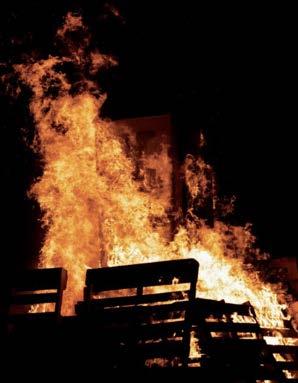
Callanan and Luca Fassi finished fourth and fifth, adding key points to Princeton’s total.
However, a major setback came in the final event — the 200-yard freestyle relay. An early takeoff from Schott resulted in a costly disqualification, and the Tigers, who had initially placed third, lost 54 points due to the ruling.
“I waited at the pool with the guys who swam the relay,” Crispino said. “When we got back to the team dinner at the hotel, they had already decided we weren’t going to let it dictate the way the rest of the meet would unfold. The leadership from our seniors and juniors really came to the forefront in that moment.”
Tigers take the lead
After Thursday night’s disqualification, Princeton had work to do ahead of Friday’s seven-event night. Despite only winning one of the seven events, the Tigers’ depth was on full display and allowed them to consistently pick up points throughout the day.
Yale’s Arshak Hambardzumyan took the 1000-yard freestyle, but Princeton had four swimmers finish in the top 13, outscoring Yale by nearly 40 points. First-year Santiago Gutierrez finished fourth.
“I do my best to just let my body do what it knows to help me finish the race as fast as possible,” Gutierrez said.
Similarly, in the 400-yard IM, five Tigers finished in the top 13, highlighted by senior Maxwell Seidel’s bronze medal finish.
The highlight of the night came in the 200-yard freestyle, with Schott inching by Millard to win the event. Dinu finished two seconds behind Schott and Millard to complete the podium and secure valuable points.
“In the last two laps I simply trusted my training and my hard work,” Schott said. “I had confidence in myself, I knew that if we were on the same ground I would take it and that’s what I did.”
In the 100-yard backstroke, four Tigers rounded out the top 12, with Hong coming in second with a time of 46:26. The night ended with the 400-yard medley relay. Despite a staggering six schools breaking the previous pool record from 2016, Princeton’s time of 3:07.90 was good for fourth place.
No. 32
On championship Saturday, the Tigers extended their lead, finishing with 1,330 points en route to their 32nd title. Harvard threatened early with strong performances in the 1,650-yard freestyle and the 200-yard backstroke, taking the lead with five events to go.
The Tigers secured a crucial victory in the 100-yard freestyle, with Dinu touching first at 42.42, following his program-record 42.16 in the prelims. After that event, the three-way race was razor-thin, with Princeton and Harvard tied at 1,038.5 points, while Yale trailed by just one point at 1,037.5.
“I knew the 100 final was going to be a dog fight from start to finish; it always is,” Dinu said. “Going into the last 25, I could not see Deniel [Nankov] as I was breathing to my left, but I could feel him being close.
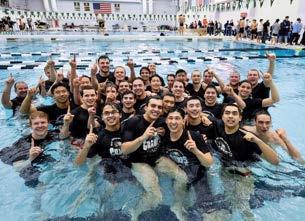
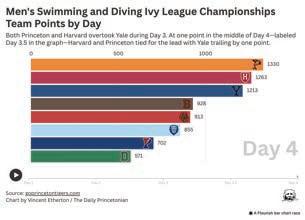
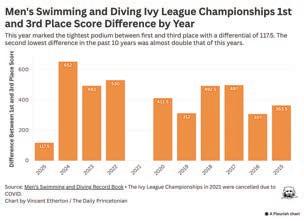
I knew I had to dig deep to win the race.”
In the final three events, Princeton’s depth proved too much to overcome. Schott continued his dominance, winning the 200-yard butterfly in a meetrecord 1:40.42, beating Harvard’s David Schmitt by one-tenth of a second. Schott broke a championship record set by former Princeton standout Raunak Khosla ’23.
“Raunak taught me a lot about being a leader by example,” Schott said. “With all of his accolades, he never once let it get to his head or put himself above anybody, he simply performed and helped those around him do the same.”
In diving, Wang successfully defended his three-meter title with a score of 360.60, while sophomore Luca Fassi took third to add to Princeton’s cushion.
“I was very proud of being able to defend the title and was excited to compete in a field with a bunch of my friends,” Wang said.
“I am always excited to compete for a team that is so supportive and always pushing me to reach my full potential.”
The final standings saw Princeton narrowly edge out Harvard (1,262.5) and Yale (1,212.5). The gap between first and third place was historically small — the closest margin between the top three teams since 1990.
“The title means so much to so many people,” Crispino said. “It’s a major step in our program’s evolution, but it’s also not the end of the journey.”
“There has been some adversity and change in our program in the last nine years, but through it all our student-athletes and coaches never stopped believing that we would get back to the top. To finally be there is very satisfying.”
The NCAA Championships will take place in Federal Way, Wash. from March 26–29. As of now, the 800-freestyle relay team has qualified.
Hayk Yengibaryan is an associate News editor, senior Sports writer, and Education Director for the ‘Prince.’
Matthew Yi is an assistant Sports editor for the ‘Prince.’
PHOTO COURTESY OF @PUCSDT/X
The Ivy League title was the Tigers’ 32nd in program history.
Frosh Bucket List
By Daily Princetonian Staff
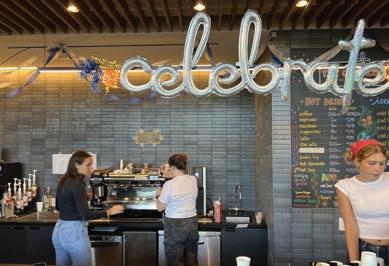
Swipe into all seven dining halls during a single lunch period.
Get food poisoning from the Whitman chicken.
Battle local high schoolers to get a hoagie at Wawa after a night out.
Go to the Triangle Club’s frosh week show.
Stand in an hour-long line for a free drink from Coffee Club. Quality may vary.
Get dinner at the Graduate College.
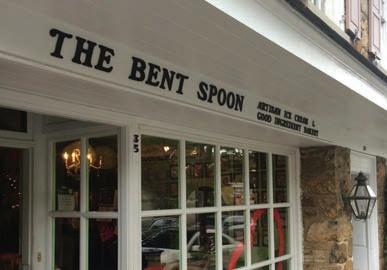
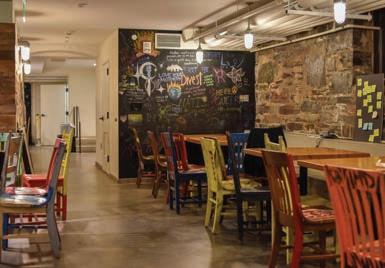
Attend a basketball game (maybe even a men’s team game).
Dip your toes into all of the five fountains on campus.
Get cookies at Murray-Dodge cafe.
Stargaze on the golf course.
Make fun of the silly jackets at Reunions.
Have dinner with a professor.
Watch the sun set from the top floor of Fine Hall.
Take a walk on the towpath while dodging the flasher.
Visit the Cotsen Children’s Library in Firestone.
Go to the Bodyhype Saturday late show and win the t-shirt auction. Price tag? $200.
Fill a Bent Spoon punch card.
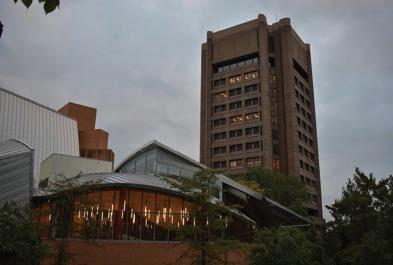

Become (Instagram) friends with Jeff Nunokawa.
Sled down the hill by Whitman after it snows.
Study in the Princeton Public Library.
Poop in the Small World bathroom.
Have a meal at Prospect House.
Wait outside of the Quadrangle Club for two hours on a night out.
Go to Lawnparties with people you’ll never speak to again.
Take a ride in a P-Safe car.
Kayak on Lake Carnegie.
Have a standoff with a raccoon at a construction site.
Help tourists take a picture.
Take a picture with tourists.
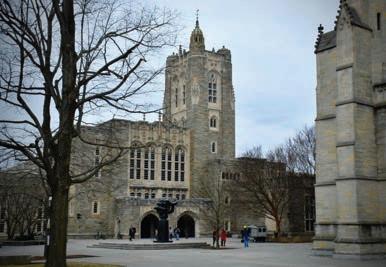
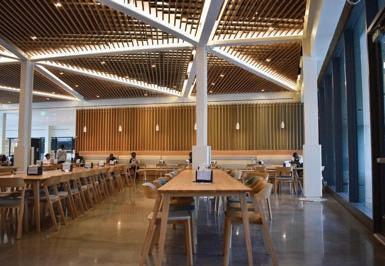
Attend the Art Museum’s grand opening on Halloween — spooky!
Look through the telescope in Peyton Hall.
Go to a USG movie.
